ZyXEL Communications EMG6765-Q10A AC2200 Gigabit Ethernet MoCA Gateway AC2200 Gigabit Ethernet Gateway User Manual Book
ZyXEL Communications Corporation AC2200 Gigabit Ethernet MoCA Gateway AC2200 Gigabit Ethernet Gateway Book
User Manual
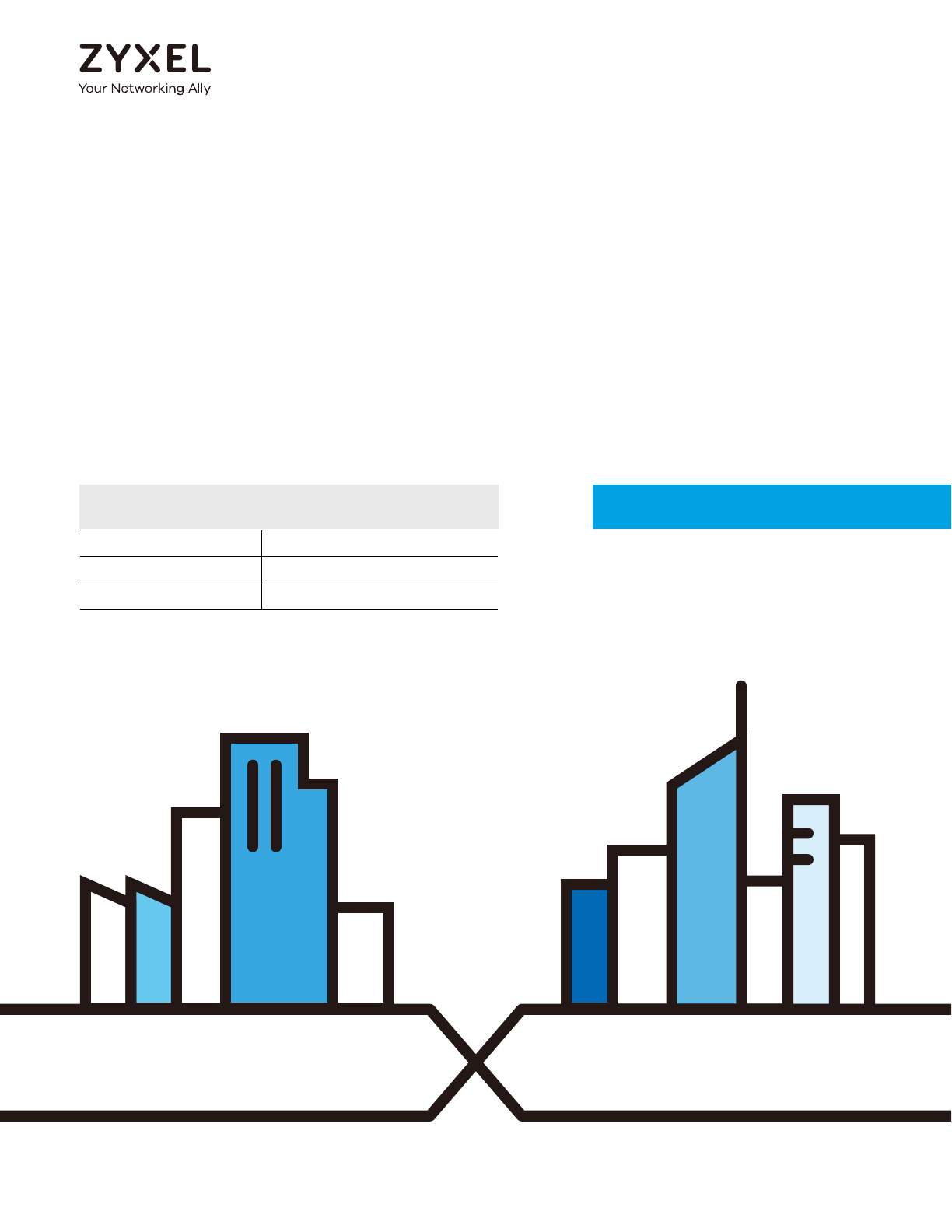
Default Login Details
User’s Guide
EMG6765-Q10A
AC2200 Gigabit Ethernet MoCA Gateway
Copyright © 2017 Zyxel Communications Corporation
LAN IP Address http://192.168.1.1
User Name admin
Password (back-label default key)
Version 1.00 Edition 1, 05/2017
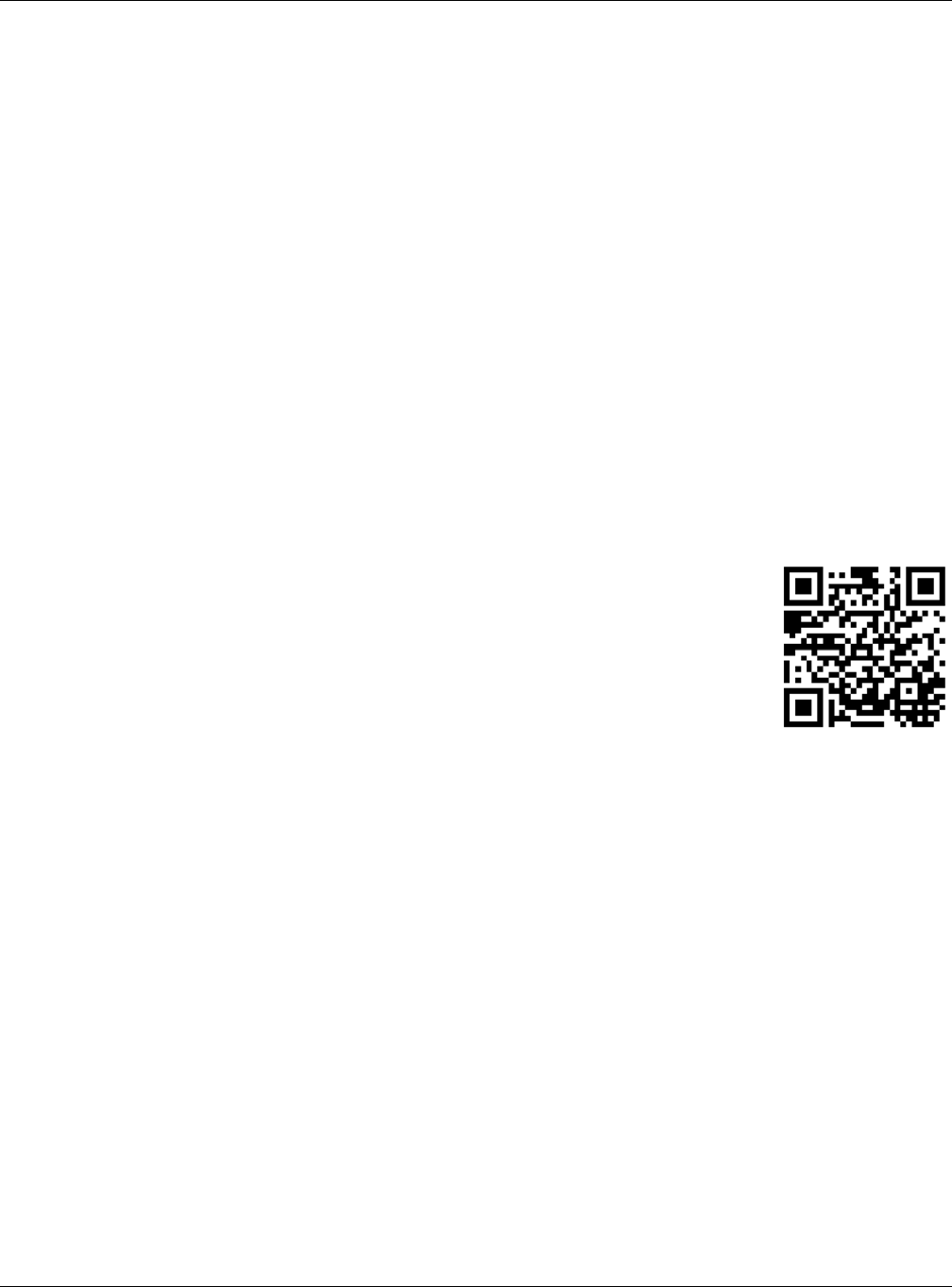
EMG6765-Q10A User’s Guide
2
IMPORTANT!
READ CAREFULLY BEFORE USE.
KEEP THIS GUIDE FOR FUTURE REFERENCE.
This is a User’s Guide for a system managing a series of products. Not all products support all features.
Menushots and graphics in this book may differ slightly from what you see due to differences in release
versions or your computer operating system. Every effort has been made to ensure that the information
in this manual is accurate.
Related Documentation
•Quick Start Guide
The Quick Start Guide shows how to connect the EMG6765-Q10A and access the Web Configurator
wizards. It contains information on setting up your network and configuring for Internet access.
•More Information
Go to support.zyxel.com to find other information on the EMG6765-Q10A.

Contents Overview
EMG6765-Q10A User’s Guide
3
Contents Overview
User’s Guide ......................................................................................................................................11
Introduction ........................................................................................................................................... 12
Introducing the Web Configurator ..................................................................................................... 18
EMG6765-Q10A Modes ........................................................................................................................ 21
Router Mode ......................................................................................................................................... 22
Access Point Mode .............................................................................................................................. 29
Tutorials .................................................................................................................................................. 36
Technical Reference ........................................................................................................................53
Monitor ................................................................................................................................................... 54
WAN ....................................................................................................................................................... 60
Wireless LAN .......................................................................................................................................... 72
LAN ......................................................................................................................................................... 94
MoCA ................................................................................................................................................... 100
DHCP Server ........................................................................................................................................ 104
NAT ....................................................................................................................................................... 109
DDNS .................................................................................................................................................... 119
Static Route ......................................................................................................................................... 121
Interface Group .................................................................................................................................. 124
Firewall ................................................................................................................................................. 127
Content Filtering ................................................................................................................................. 132
IPv6 Firewall ......................................................................................................................................... 134
Parental Control ................................................................................................................................. 137
Bandwidth Management .................................................................................................................. 142
Universal Plug-and-Play (UPnP) ......................................................................................................... 155
USB Media Sharing .............................................................................................................................. 161
Port Configuration .............................................................................................................................. 171
Maintenance ...................................................................................................................................... 173
Troubleshooting .................................................................................................................................. 184

Table of Contents
EMG6765-Q10A User’s Guide
4
Table of Contents
Contents Overview .............................................................................................................................3
Table of Contents.................................................................................................................................4
Part I: User’s Guide..........................................................................................11
Chapter 1
Introduction ........................................................................................................................................12
1.1 Overview ......................................................................................................................................... 12
1.2 Applications .................................................................................................................................... 13
1.3 Ways to Manage the EMG6765-Q10A ......................................................................................... 13
1.4 Good Habits for Managing the EMG6765-Q10A ........................................................................ 14
1.5 Resetting the EMG6765-Q10A ....................................................................................................... 14
1.5.1 RESET Button ........................................................................................................................... 14
1.5.2 The WPS Button ...................................................................................................................... 14
1.6 Front Panel ...................................................................................................................................... 15
1.7 Rear Panel ....................................................................................................................................... 16
1.8 Wall Mounting ................................................................................................................................. 17
Chapter 2
Introducing the Web Configurator ...................................................................................................18
2.1 Overview ......................................................................................................................................... 18
2.2 Login Accounts ............................................................................................................................... 18
2.3 Accessing the Web Configurator ................................................................................................. 18
2.3.1 Login Screen .......................................................................................................................... 19
2.3.2 Password Screen ................................................................................................................... 19
Chapter 3
EMG6765-Q10A Modes.....................................................................................................................21
3.1 Overview ......................................................................................................................................... 21
3.1.1 Device Modes ....................................................................................................................... 21
Chapter 4
Router Mode.......................................................................................................................................22
4.1 Overview ......................................................................................................................................... 22
4.2 Router Mode Status Screen ........................................................................................................... 22
4.2.1 Navigation Panel .................................................................................................................. 25

Table of Contents
EMG6765-Q10A User’s Guide
5
Chapter 5
Access Point Mode............................................................................................................................29
5.1 Overview ......................................................................................................................................... 29
5.2 What You Can Do .......................................................................................................................... 29
5.3 What You Need to Know ............................................................................................................... 29
5.3.1 Setting your EMG6765-Q10A to AP Mode .......................................................................... 30
5.3.2 Accessing the Web Configurator in Access Point Mode ................................................. 30
5.3.3 Configuring your WLAN and Maintenance Settings ......................................................... 31
5.4 AP Mode Status Screen ................................................................................................................. 31
5.4.1 Navigation Panel .................................................................................................................. 33
5.5 LAN Screen ...................................................................................................................................... 33
Chapter 6
Tutorials...............................................................................................................................................36
6.1 Overview ......................................................................................................................................... 36
6.2 Setting Up a Secure Wireless Network .......................................................................................... 36
6.2.1 Configuring the Wireless Network Settings ......................................................................... 36
6.3 Connecting to the EMG6765-Q10A’s Wi-Fi Network Using WPS ................................................ 37
6.3.1 Push Button Configuration (PBC) ........................................................................................ 38
6.3.2 PIN Configuration .................................................................................................................. 39
6.4 Connecting to the EMG6765-Q10A’s Wi-Fi Network Without WPS ........................................... 41
6.5 Configuring Static Route for Routing to Another Network ........................................................ 44
6.6 Access the EMG6765-Q10A Using DDNS ..................................................................................... 46
6.6.1 Registering a DDNS Account on www.dyndns.org ........................................................... 46
6.6.2 Configuring DDNS on Your EMG6765-Q10A ...................................................................... 47
6.6.3 Testing the DDNS Setting ...................................................................................................... 47
6.7 Configuring the MAC Address Filter ............................................................................................. 47
6.8 Using Multiple SSIDs on the EMG6765-Q10A ................................................................................ 48
6.8.1 Configuring Security Settings of Multiple SSIDs .................................................................. 49
Part II: Technical Reference...........................................................................53
Chapter 7
Monitor................................................................................................................................................54
7.1 Overview ......................................................................................................................................... 54
7.2 What You Can Do .......................................................................................................................... 54
7.3 The Log Screen ............................................................................................................................... 54
7.3.1 View Log ................................................................................................................................ 54
7.4 DHCP Table .................................................................................................................................. 56
7.5 Packet Statistics ........................................................................................................................... 56
7.6 WLAN Station Status ................................................................................................................... 57

Table of Contents
EMG6765-Q10A User’s Guide
6
7.7 IGMP Statistics ................................................................................................................................ 58
Chapter 8
WAN ....................................................................................................................................................60
8.1 Overview ......................................................................................................................................... 60
8.2 What You Can Do .......................................................................................................................... 60
8.3 What You Need To Know .............................................................................................................. 60
8.3.1 Configuring Your Internet Connection ............................................................................... 60
8.4 Management WAN ........................................................................................................................ 62
8.4.1 Add/Edit WAN Connection ................................................................................................. 63
Chapter 9
Wireless LAN .......................................................................................................................................72
9.1 Overview ......................................................................................................................................... 72
9.1.1 What You Can Do ................................................................................................................. 73
9.1.2 What You Should Know ........................................................................................................ 73
9.2 General Wireless LAN Screen ....................................................................................................... 76
9.3 Wireless Security .............................................................................................................................. 78
9.3.1 No Security ............................................................................................................................. 78
9.3.2 WPA2-PSK ............................................................................................................................... 79
9.3.3 WPA2 ...................................................................................................................................... 80
9.4 More AP Screen .............................................................................................................................. 81
9.4.1 More AP Edit .......................................................................................................................... 82
9.5 MAC Filter Screen .......................................................................................................................... 84
9.6 Wireless LAN Advanced Screen ................................................................................................... 86
9.7 Quality of Service (QoS) Screen ................................................................................................... 87
9.8 WPS Screen ..................................................................................................................................... 87
9.9 WPS Station Screen ........................................................................................................................ 89
9.10 Scheduling Screen ....................................................................................................................... 89
9.11 Airtime Management Screen ..................................................................................................... 90
9.11.1 Airtime Management Scenarios ....................................................................................... 92
Chapter 10
LAN......................................................................................................................................................94
10.1 Overview ....................................................................................................................................... 94
10.2 What You Can Do ........................................................................................................................ 94
10.3 What You Need To Know ............................................................................................................ 95
10.3.1 IP Pool Setup ........................................................................................................................ 95
10.3.2 LAN TCP/IP ........................................................................................................................... 95
10.3.3 IP Alias ................................................................................................................................... 95
10.4 LAN IP Screen ................................................................................................................................ 96
10.5 IP Alias Screen ............................................................................................................................... 96
10.6 IPv6 LAN Screen ............................................................................................................................ 97

Table of Contents
EMG6765-Q10A User’s Guide
7
10.7 IGMP Snooping Screen ................................................................................................................ 98
Chapter 11
MoCA................................................................................................................................................100
11.1 Overview ..................................................................................................................................... 100
11.2 What You Can Do ...................................................................................................................... 101
11.3 MoCA Screen .............................................................................................................................. 101
11.4 MoCA Monitor Screen ............................................................................................................... 103
Chapter 12
DHCP Server......................................................................................................................................104
12.1 Overview ..................................................................................................................................... 104
12.1.1 What You Can Do ............................................................................................................. 104
12.1.2 What You Need To Know ................................................................................................. 104
12.2 DHCP Server General Screen .................................................................................................... 104
12.3 DHCP Server Advanced Screen ............................................................................................105
12.4 DHCP Client List Screen ............................................................................................................. 107
Chapter 13
NAT....................................................................................................................................................109
13.1 Overview .................................................................................................................................. 109
13.1.1 What You Can Do ............................................................................................................. 109
13.1.2 What You Need To Know ................................................................................................. 110
13.2 General ........................................................................................................................................ 111
13.3 Port Forwarding Screen ............................................................................................................ 112
13.3.1 Port Forwarding Edit Screen ............................................................................................114
13.4 Port Trigger Screen ..................................................................................................................... 115
13.5 Technical Reference .................................................................................................................. 116
13.5.1 NATPort Forwarding: Services and Port Numbers .......................................................... 116
13.5.2 NAT Port Forwarding Example ......................................................................................... 116
13.5.3 Trigger Port Forwarding .................................................................................................... 117
13.5.4 Trigger Port Forwarding Example .................................................................................... 117
13.5.5 Two Points To Remember About Trigger Ports ............................................................... 118
Chapter 14
DDNS .................................................................................................................................................119
14.1 Overview .................................................................................................................................... 119
14.1.1 What You Need To Know ................................................................................................. 119
14.2 General ...................................................................................................................................... 119
Chapter 15
Static Route.......................................................................................................................................121
15.1 Overview .................................................................................................................................. 121

Table of Contents
EMG6765-Q10A User’s Guide
8
15.2 IP Static Route Screen ............................................................................................................... 121
15.2.1 Add/Edit Static Route ....................................................................................................... 122
Chapter 16
Interface Group ...............................................................................................................................124
16.1 Overview ..................................................................................................................................... 124
16.2 The Interface Group Screen ...................................................................................................... 124
16.2.1 Add Interface Group ........................................................................................................ 124
16.2.2 Add Interface Group Criteria .......................................................................................... 126
Chapter 17
Firewall..............................................................................................................................................127
17.1 Overview ................................................................................................................................... 127
17.1.1 What You Can Do ............................................................................................................. 127
17.1.2 What You Need To Know ................................................................................................. 127
17.2 General Screen .......................................................................................................................... 129
17.3 Services Screen ........................................................................................................................... 129
Chapter 18
Content Filtering...............................................................................................................................132
18.1 Overview ..................................................................................................................................... 132
18.2 Content Filter ............................................................................................................................... 132
Chapter 19
IPv6 Firewall......................................................................................................................................134
19.1 Overview ..................................................................................................................................... 134
19.2 IPv6 Firewall Screen ................................................................................................................... 134
Chapter 20
Parental Control...............................................................................................................................137
20.1 Overview ..................................................................................................................................... 137
20.1.1 What You Need To Know ................................................................................................. 137
20.2 Parental Control Screen ............................................................................................................ 137
20.2.1 Add/Edit a Parental Control Rule ................................................................................... 138
20.2.2 Add/Edit a Service ............................................................................................................ 140
20.3 Technical Reference .................................................................................................................. 141
20.3.1 Customizing Keyword Blocking URL Checking .............................................................. 141
Chapter 21
Bandwidth Management................................................................................................................142
21.1 Overview .................................................................................................................................... 142
21.1.1 What You Can Do in this Chapter ................................................................................... 142
21.2 What You Need to Know ........................................................................................................... 142

Table of Contents
EMG6765-Q10A User’s Guide
9
21.3 Bandwidth MGMT General Screen ......................................................................................... 144
21.4 The Queue Setup Screen ........................................................................................................... 145
21.4.1 Add/Edit a Queue .......................................................................................................... 146
21.5 The Class Setup Screen .............................................................................................................. 147
21.5.1 Add/Edit a Classifier ......................................................................................................... 148
21.6 Technical Reference .................................................................................................................. 150
Chapter 22
Universal Plug-and-Play (UPnP)......................................................................................................155
22.1 Overview .................................................................................................................................... 155
22.2 What You Need to Know ........................................................................................................... 155
22.2.1 NAT Traversal ..................................................................................................................... 155
22.2.2 Cautions with UPnP ........................................................................................................... 155
22.3 UPnP Screen ............................................................................................................................... 156
22.4 Technical Reference .................................................................................................................. 156
22.4.1 Using UPnP in Windows XP Example ................................................................................ 156
22.4.2 Web Configurator Easy Access ....................................................................................... 158
Chapter 23
USB Media Sharing...........................................................................................................................161
23.1 Overview ..................................................................................................................................... 161
23.2 What You Can Do ...................................................................................................................... 162
23.3 What You Need To Know .......................................................................................................... 162
23.4 Before You Begin ........................................................................................................................ 163
23.5 DLNA Screen ............................................................................................................................... 164
23.6 SAMBA Screen ............................................................................................................................ 164
23.7 FTP Screen ................................................................................................................................... 166
23.8 Example of Accessing Your Shared Files From a Computer ................................................. 167
23.8.1 Use Windows Explorer to Share Files ................................................................................ 167
23.8.2 Use FTP to Share Files ......................................................................................................... 169
Chapter 24
Port Configuration............................................................................................................................171
24.1 Overview ..................................................................................................................................... 171
24.2 Port Configuration Screen ......................................................................................................... 171
Chapter 25
Maintenance....................................................................................................................................173
25.1 Overview ..................................................................................................................................... 173
25.2 What You Can Do ...................................................................................................................... 173
25.3 General Screen .......................................................................................................................... 173
25.4 Account Screen .......................................................................................................................... 174
25.4.1 Account Setup Screen ..................................................................................................... 174

Table of Contents
EMG6765-Q10A User’s Guide
10
25.5 Time Setting Screen .................................................................................................................... 175
25.6 Firmware Upgrade Screen ........................................................................................................ 177
25.7 Configuration Backup/Restore Screen .................................................................................... 178
25.8 Restart Screen ............................................................................................................................. 180
25.9 Language Screen ....................................................................................................................... 180
25.10 Diagnostic Screens ................................................................................................................... 180
25.10.1 Ping Screen ...................................................................................................................... 180
25.10.2 Trace Route Screen ........................................................................................................ 181
25.10.3 NsLookup Screen ............................................................................................................ 182
Chapter 26
Troubleshooting................................................................................................................................184
26.1 Overview ..................................................................................................................................... 184
26.2 Power, Hardware Connections, and LEDs ............................................................................... 184
26.3 EMG6765-Q10A Access and Login ........................................................................................... 185
26.4 Internet Access ........................................................................................................................... 186
26.5 Resetting the EMG6765-Q10A to Its Factory Defaults ............................................................ 188
26.6 Wireless Connections ................................................................................................................. 188
26.7 USB Device Problems ................................................................................................................. 190
26.8 MoCA Network ........................................................................................................................... 190
Appendix A Pop-up Windows, JavaScript and Java Permissions ............................................. 191
Appendix B Common Services...................................................................................................... 200
Appendix C Customer Support ..................................................................................................... 203
Appendix D Legal Information ...................................................................................................... 209
Index.................................................................................................................................................216

11
PART I
User’s Guide
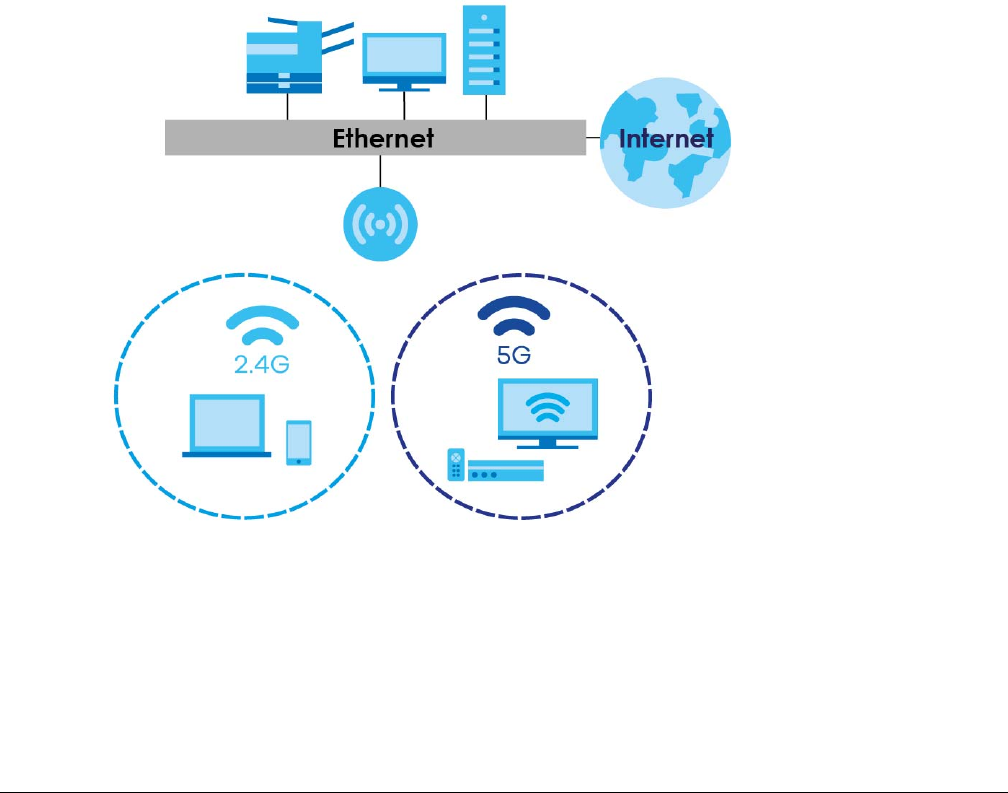
EMG6765-Q10A User’s Guide
12
CHAPTER 1
Introduction
1.1 Overview
This chapter introduces the main features and applications of the EMG6765-Q10A.
The EMG6765-Q10A extends the range of your existing wired network without additional wiring,
providing easy network access to mobile users. You can set up a wireless network with other IEEE
802.11a/ac/b/g/n compatible devices.
The EMG6765-Q10A is a dual-band AP and able to function both 2.4G and 5G networks at the same
time. You could use the 2.4 GHz band for regular Internet surfing and downloading while using the 5 GHz
band for time sensitive traffic like high-definition video, music, and gaming.
Figure 1 Dual-Band Application
A range of services such as a firewall and content filtering are also available for secure Internet
computing. There is one USB 2.0 port on the side panel of your EMG6765-Q10A, and the other one is on
the rear panel of your EMG6765-Q10A. You can connect USB (version 2.0 or lower) memory sticks, USB
hard drives, or USB devices for file sharing. The EMG6765-Q10A automatically detects the USB devices.
Make sure the USB LED is off before removing your USB device. This will remove your USB device safely,
preventing file or data loss if it is being transmitted through the USB device.
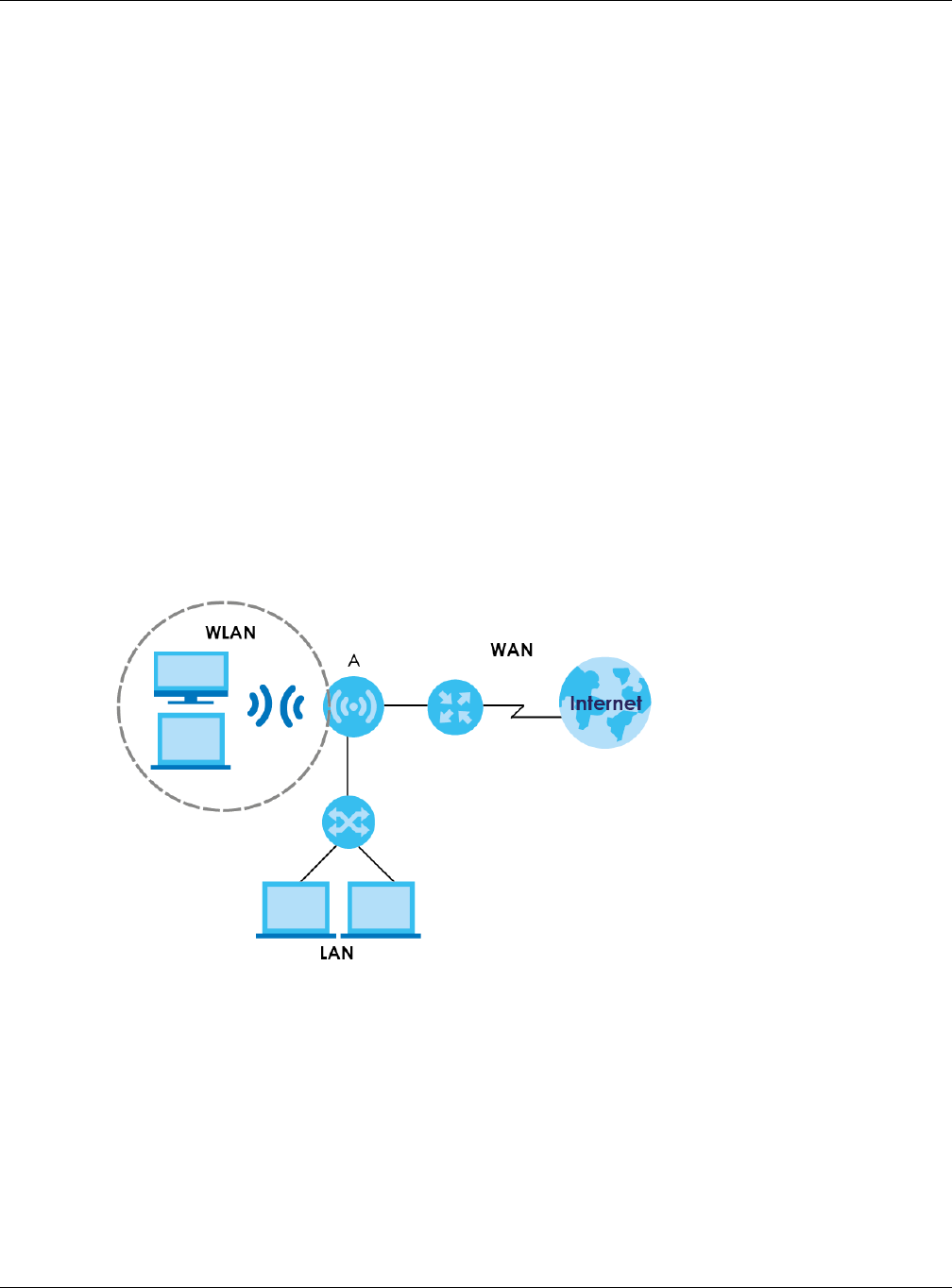
Chapter 1 Introduction
EMG6765-Q10A User’s Guide
13
Note: For the USB function, it is strongly recommended to use version 2.0 or lower USB storage
devices (such as memory sticks, USB hard drives) and/or USB devices. Other USB
products are not guaranteed to function properly with the EMG6765-Q10A.
The EMG6765-Q10A also comes with one coaxial port that supports MoCA (Multimedia over Coax
Alliance) technology. Use MoCA technology to extend your network through a coaxial connection to
another MoCA device and/or a device connected to a MoCA adapter.
Use a (supported) web browser to manage the EMG6765-Q10A.
1.2 Applications
You can have the following networks with the EMG6765-Q10A:
•Wired. You can connect network devices via the Ethernet ports of the EMG6765-Q10A so that they
can communicate with each other and access the Internet.
•Wireless. Wireless clients can connect to the EMG6765-Q10A to access network resources. You can
use WPS (Wi-Fi Protected Setup) to create an instant network connection with another WPS-
compatible device.
•WAN. Connect to a broadband modem/router for Internet access.
Figure 2 EMG6765-Q10A Networks
1.3 Ways to Manage the EMG6765-Q10A
Use any of the following methods to manage the EMG6765-Q10A.
• WPS (Wi-Fi Protected Setup). You can use the WPS button or the WPS section of the Web Configurator
to set up a wireless network with your EMG6765-Q10A.
• Web Configurator. This is recommended for everyday management of the EMG6765-Q10A using a
(supported) web browser.

Chapter 1 Introduction
EMG6765-Q10A User’s Guide
14
1.4 Good Habits for Managing the EMG6765-Q10A
Do the following things regularly to make the EMG6765-Q10A more secure and to manage the
EMG6765-Q10A more effectively.
• Change the password. Use a password that’s not easy to guess and that consists of different types of
characters, such as numbers and letters.
• Write down the password and put it in a safe place.
• Back up the configuration (and make sure you know how to restore it). Restoring an earlier working
configuration may be useful if the device becomes unstable or even crashes. If you forget your
password, you will have to reset the EMG6765-Q10A to its factory default settings. If you backed up
an earlier configuration file, you would not have to totally re-configure the EMG6765-Q10A. You could
simply restore your last configuration.
1.5 Resetting the EMG6765-Q10A
If you forget your password or IP address, or you cannot access the Web Configurator, you will need to
use the RESET button at the back of the EMG6765-Q10A to reload the factory-default configuration file.
This means that you will lose all configurations that you had previously saved, the user name will be reset
to “admin”, the password will be reset to the back-label default key, and the IP address will be reset to
“192.168.1.1” (router mode).
1.5.1 RESET Button
1Make sure the power LED is on.
2Press and hold the RESET button for more than 5 seconds, the power LED begins flashing.
3Release the RESET button. The EMG6765-Q10A reloads factory-default settings and begins to reboot.
1.5.2 The WPS Button
Your EMG6765-Q10A supports Wi-Fi Protected Setup (WPS), which is an easy way to set up a secure
wireless network. WPS is an industry standard specification, defined by the Wi-Fi Alliance.
WPS allows you to quickly set up a wireless network with strong security, without having to configure
security settings manually. Each WPS connection works between two devices. Both devices must
support WPS (check each device’s documentation to make sure).
Depending on the devices you have, you can either press a button (on the device itself, or in its
configuration utility) or enter a PIN (a unique Personal Identification Number that allows one device to
authenticate the other) on each of the two devices. When WPS is activated on a device, it has two
minutes to find another device that also has WPS activated. Then, the two devices connect and set up
a secure network by themselves.
You can use the WPS button ( ) on the side panel of the EMG6765-Q10A to activate WPS in order to
quickly set up a wireless network with strong security.
1Make sure the power LED is on (not blinking).
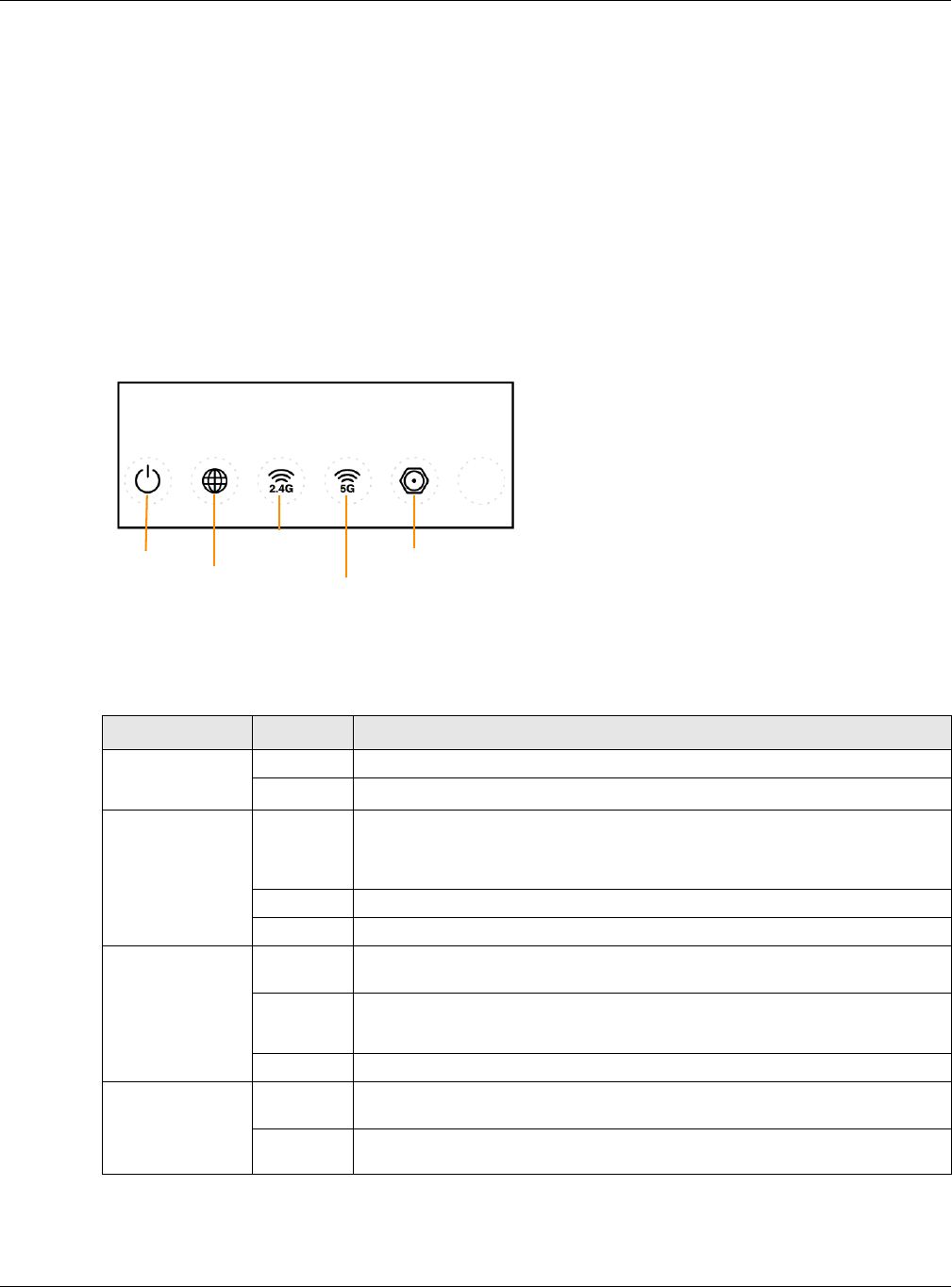
Chapter 1 Introduction
EMG6765-Q10A User’s Guide
15
2Press the WPS button for more than one second and release it. Press the WPS button on another WPS-
enabled device within range of the EMG6765-Q10A.
Note: You must activate WPS on the EMG6765-Q10A and on another wireless device within
two minutes of each other.
For more information on using WPS, see Section 6.8 on page 48.
1.6 Front Panel
The LED indicators are located on the front panel. Look at the LED lights on the front panel to determine
the status of the EMG6765-Q10A. Front Panel
The following table describes the LEDs.
Table 1 Front Panel and Rear panel LEDs
LED STATUS DESCRIPTION
Power On The EMG6765-Q10A is receiving power and functioning properly.
Off The EMG6765-Q10A is not receiving power.
Internet On The EMG6765-Q10A has an IP connection but no traffic.
Your device has a WAN IP address (either static or assigned by a DHCP server),
PPP negotiation was successfully completed (if used) and the connection is up.
Blinking The EMG6765-Q10A is sending or receiving IP traffic.
Off The EMG6765-Q10A does not have an IP connection.
WLAN 2.4/5G
(White)
On The EMG6765-Q10A is ready, but is not sending/receiving data through the 5G
wireless LAN.
Blinking The EMG6765-Q10A is sending/receiving data through the 5G wireless LAN.
The EMG6765-Q10A is negotiating a WPS connection with a wireless client.
Off The wireless LAN is not ready or has failed.
WLAN 2.4/5G
(Amber)
On The EMG6765-Q10A is setting up a WPS connection with a 2.4GHz or 5GHz
wireless client.
Off The 2.4 GHz or 5GHz WPS process is completed or failed.
Power MoCA
Internet
WLAN 2.4G
WLAN 5G
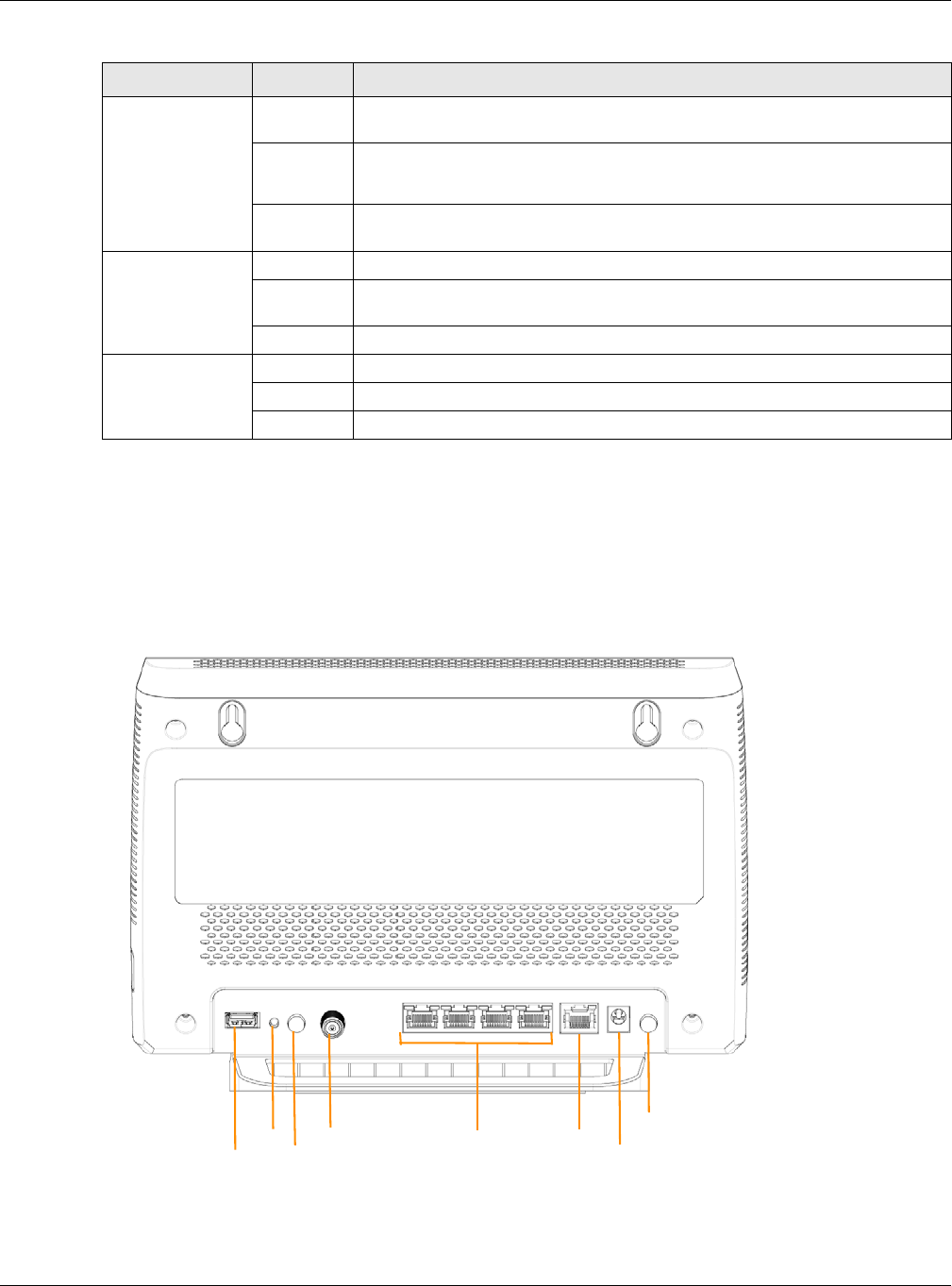
Chapter 1 Introduction
EMG6765-Q10A User’s Guide
16
1.7 Rear Panel
The connection ports are located on the rear panel.
Figure 3 Rear Panel
MoCA On The MoCA port is connected and the EMG6765-Q10A detects another MoCA
device.
Blinking The EMG6765-Q10A is communicating with another MoCA device.
Data is being transmitted and/or received through the coaxial cables.
Off The MoCA port is not connected, or the EMG6765-Q10A does not detect
another MoCA device.
LAN 1-4
(Rear Panel)
On The EMG6765-Q10A’s LAN connection is ready.
Blinking The EMG6765-Q10A is sending/receiving data through the LAN with a 1000Mbps
transmission rate.
Off The LAN connection is not ready, or has failed.
WAN
(Rear Panel)
On The EMG6765-Q10A’s WAN connection is ready.
Blinking The EMG6765-Q10A is sending/receiving data through the WAN.
Off The WAN connection is not ready, or has failed.
Table 1 Front Panel and Rear panel LEDs (continued)
LED STATUS DESCRIPTION
ResetWi-Fi MoCA LAN WAN DC IN
Power
USB
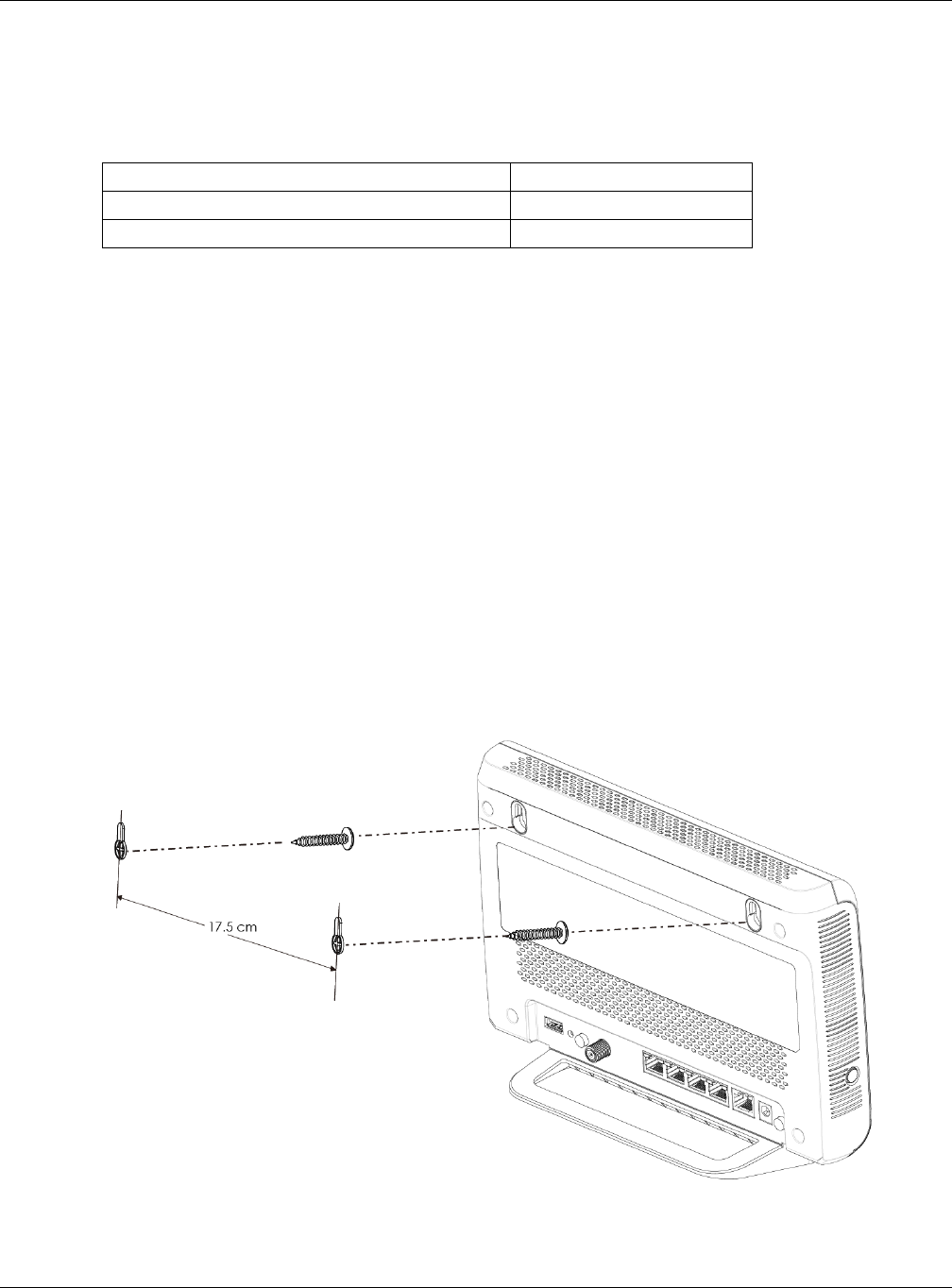
Chapter 1 Introduction
EMG6765-Q10A User’s Guide
17
1.8 Wall Mounting
You may need screw anchors if mounting on a concrete or brick wall.
1Select a position free of obstructions on a wall strong enough to hold the weight of the device.
2Mark two holes on the wall at the appropriate distance apart for the screws.
Be careful to avoid damaging pipes or cables located inside the wall
when drilling holes for the screws.
3If using screw anchors, drill two holes for the screw anchors into the wall. Push the anchors into the full
depth of the holes, then insert the screws into the anchors. Do not insert the screws all the way in - leave
a small gap of about 0.5 cm.
If not using screw anchors, use a screwdriver to insert the screws into the wall. Do not insert the screws all
the way in - leave a gap of about 0.5 cm.
4Make sure the screws are fastened well enough to hold the weight of the EMG6765-Q10A with the
connection cables.
5Align the holes on the back of the EMG6765-Q10A with the screws on the wall. Hang the EMG6765-Q10A
on the screws.
Figure 4 Wall Mounting Example
Table 2 Wall Mounting Information
Distance between holes 17.5 cm
M4 Screws Two
Screw anchors (optional) Two

EMG6765-Q10A User’s Guide
18
CHAPTER 2
Introducing the Web
Configurator
2.1 Overview
This chapter describes how to access the EMG6765-Q10A Web Configurator and provides an overview
of its screens.
The Web Configurator is an HTML-based management interface that allows easy setup and
management of the EMG6765-Q10A via Internet browser. Use Internet Explorer 9.0 and later versions,
Mozilla Firefox 21 and later versions, Safari 6.0 and later versions or Google Chrome 26.0 and later
versions. The recommended screen resolution is 1024 by 768 pixels.
In order to use the Web Configurator you need to allow:
• Web browser pop-up windows from your device. Web pop-up blocking is enabled by default in
Windows XP SP (Service Pack) 2.
• JavaScript (enabled by default).
• Java permissions (enabled by default).
Refer to the Troubleshooting chapter (Chapter 26 on page 184) to see how to make sure these functions
are allowed in Internet Explorer.
2.2 Login Accounts
With the admin account, you cannot access Remote MGMT screens and can only view the Sys OP
Mode screen. The default user name is “admin” and password is the back-label default key.
2.3 Accessing the Web Configurator
1Make sure your EMG6765-Q10A hardware is properly connected and prepare your computer or
computer network to connect to the EMG6765-Q10A (refer to the Quick Start Guide).
2Launch your web browser.
3The EMG6765-Q10A is in router mode by default. Type "http://192.168.1.1" as the website address.
If the EMG6765-Q10A is in access point, the IP address is 192.168.1.2. See Chapter 3 on page 21 for more
information about the modes of the EMG6765-Q10A.
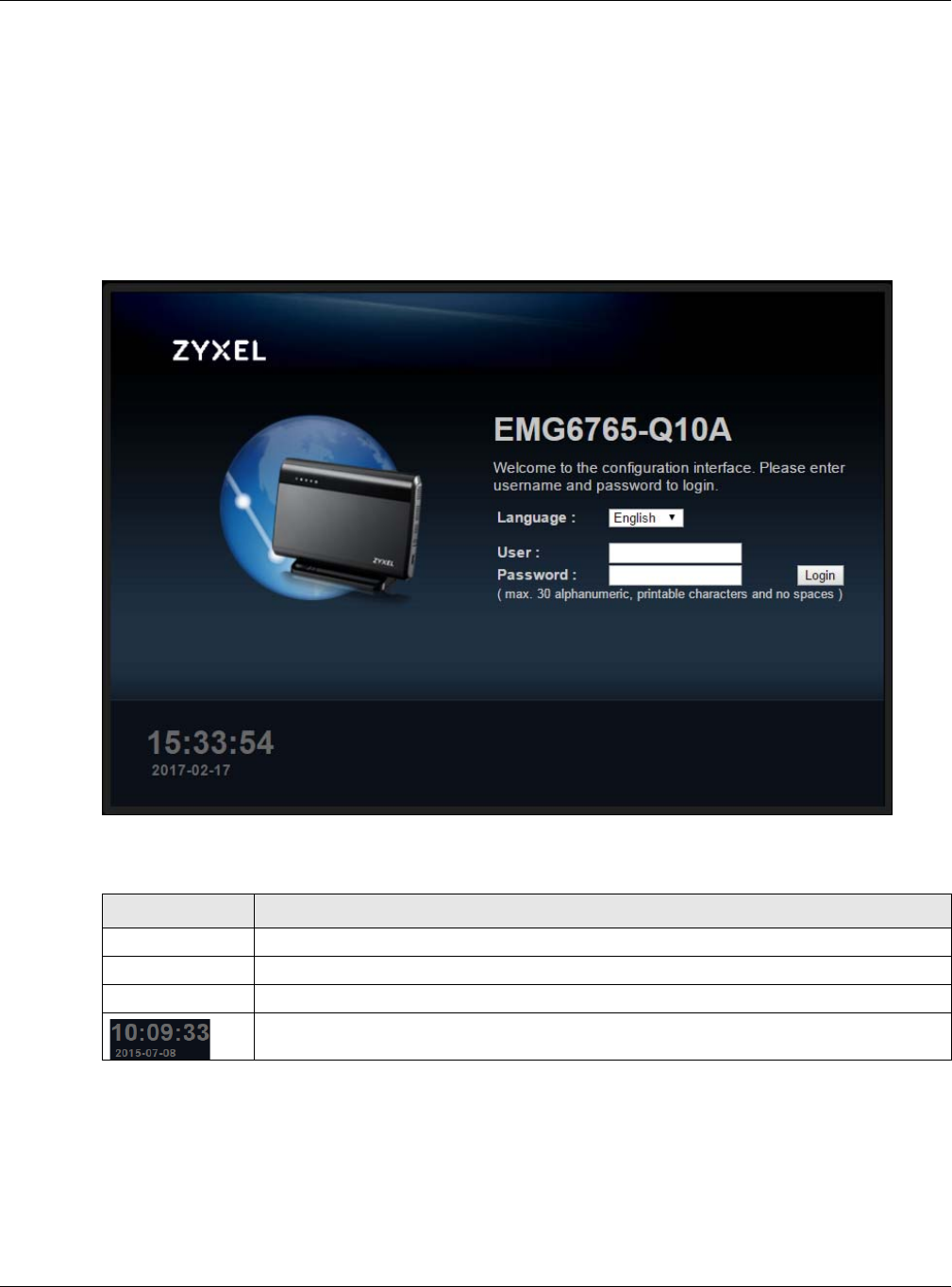
Chapter 2 Introducing the Web Configurator
EMG6765-Q10A User’s Guide
19
Your computer must be in the same subnet in order to access this website address.
2.3.1 Login Screen
The Web Configurator initially displays the following login screen.
If you are logging in with the “admin” account, type the back-label default key as the password.
Then click Login.
Figure 5 Login screen
The following table describes the labels in this screen.
2.3.2 Password Screen
You should see a screen asking you to change your password (highly recommended) as shown next.
Table 3 Login screen
LABEL DESCRIPTION
Language Select the language you want to use to configure the Web Configurator.
User Type "admin" (default) as the user name.
Password Type the back-label default key as the password. Click Login.
This shows the time (hh:mm:ss) and date (yyyy:mm:dd) of the timezone you select in Section
25.5 on page 175. The time is in 24-hour format, for example 15:00 is 3:00 PM.
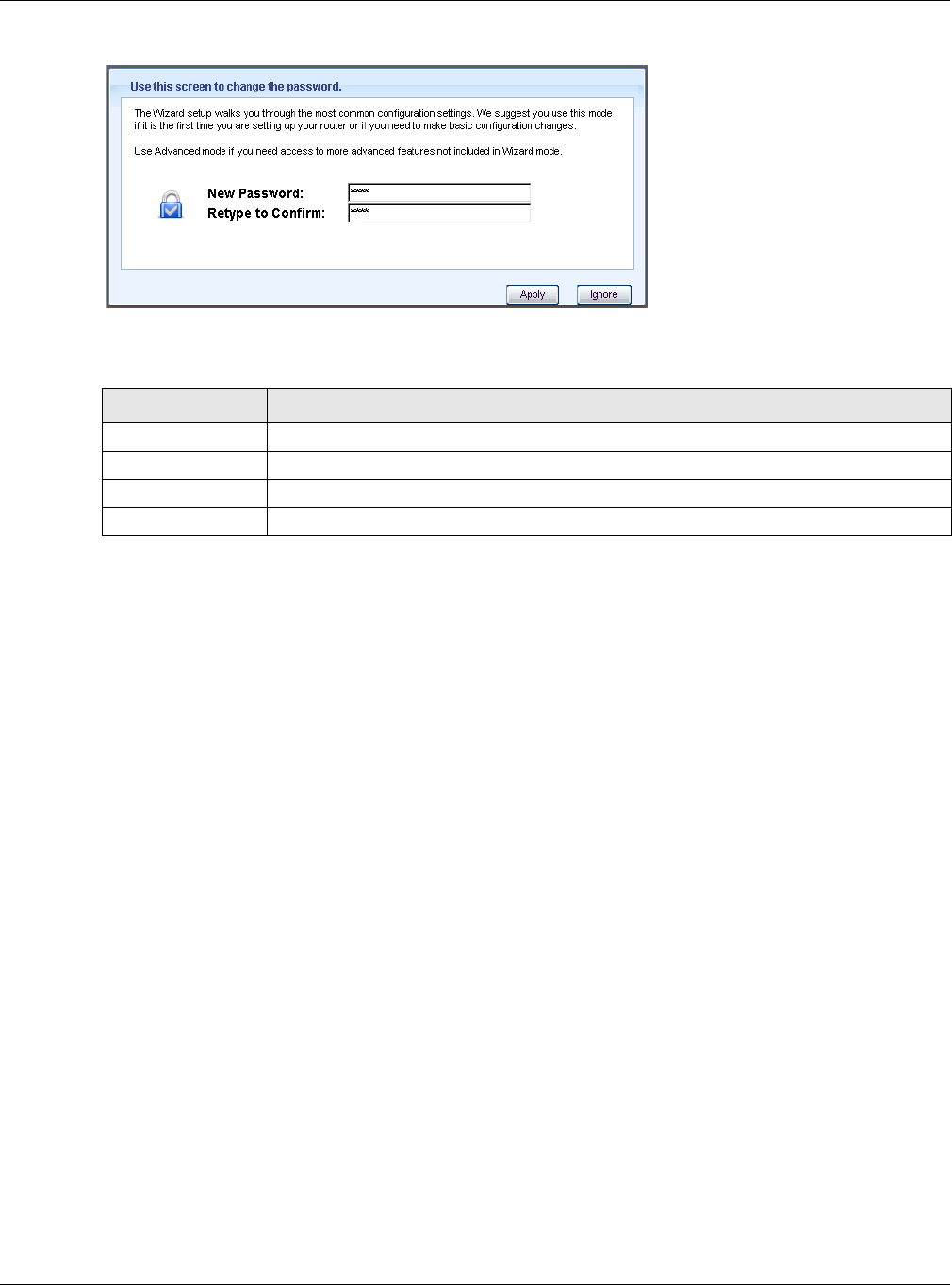
Chapter 2 Introducing the Web Configurator
EMG6765-Q10A User’s Guide
20
Figure 6 Change Password Screen
The following table describes the labels in this screen.
Note: The management session automatically times out when the time period set in the
Administrator Inactivity Timer field expires (default five minutes; go to Chapter 25 on
page 173 to change this). Simply log back into the EMG6765-Q10A if this happens.
Table 4 Change Password Screen
LABEL DESCRIPTION
New Password Type a new password.
Retype to Confirm Retype the password for confirmation.
Apply Click Apply to save your changes back to the EMG6765-Q10A.
Ignore Click Ignore if you do not want to change the password this time.

EMG6765-Q10A User’s Guide
21
CHAPTER 3
EMG6765-Q10A Modes
3.1 Overview
This chapter introduces the operating mode of your EMG6765-Q10A, or simply how the EMG6765-Q10A
is being used in the network.
3.1.1 Device Modes
This refers to the operating mode of the EMG6765-Q10A, which can act as a:
•Router: This is the default device mode of the EMG6765-Q10A. Use this mode to connect the local
network to another network, like the Internet. Go to Section 4.2 on page 22 to view the Status screen
in this mode.
•Access Point: Use this mode if you want to extend your network by allowing network devices to
connect to the EMG6765-Q10A wirelessly. Go to Section 5.4 on page 31 to view the Status screen in
this mode.
For more information on these modes and to change the mode of your EMG6765-Q10A, refer to
Chapter 25 on page 173.
Note: Choose your device mode carefully to avoid having to change it later.
When changing to another mode, the IP address of the EMG6765-Q10A changes. The running
applications and services of the network devices connected to the EMG6765-Q10A can be interrupted.
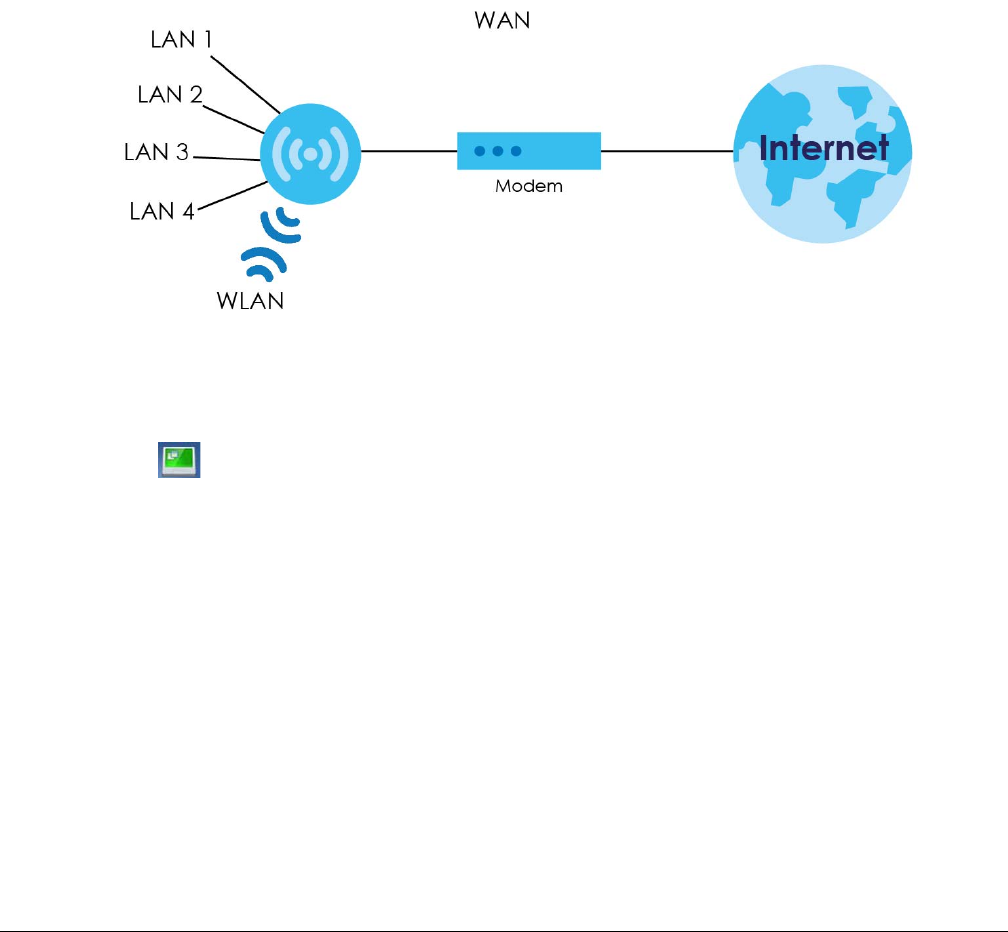
EMG6765-Q10A User’s Guide
22
CHAPTER 4
Router Mode
4.1 Overview
The EMG6765-Q10A is set to router mode by default. Routers are used to connect the local network to
another network (for example, the Internet). In the figure below, the EMG6765-Q10A connects the local
network (LAN1 ~ LAN4) to the Internet.
Figure 7 EMG6765-Q10A Network
4.2 Router Mode Status Screen
Click to open the status screen.
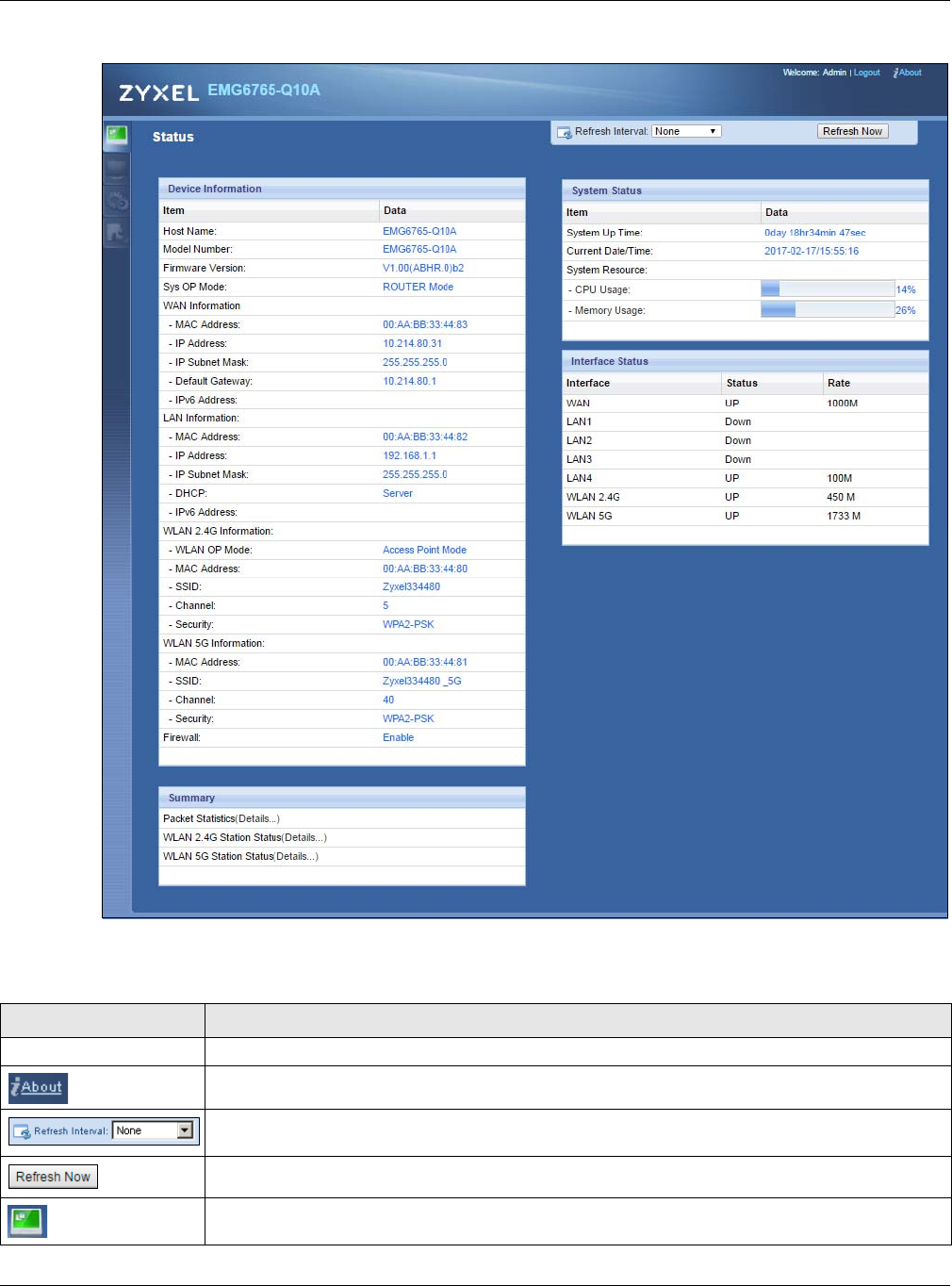
Chapter 4 Router Mode
EMG6765-Q10A User’s Guide
23
Figure 8 Status Screen: Router Mode
The following table describes the icons shown in the Status screen.
Table 5 Status Screen Icon Key
ICON DESCRIPTION
Logout Click this at any time to exit the Web Configurator.
Click this icon to view copyright and a link for related product information.
Select a number of seconds or None from the drop-down list box to refresh all screen statistics
automatically at the end of every time interval or to not refresh the screen statistics.
Click this button to refresh the status screen statistics.
Click this icon to see the Status page. The information in this screen depends on the device mode
you select.
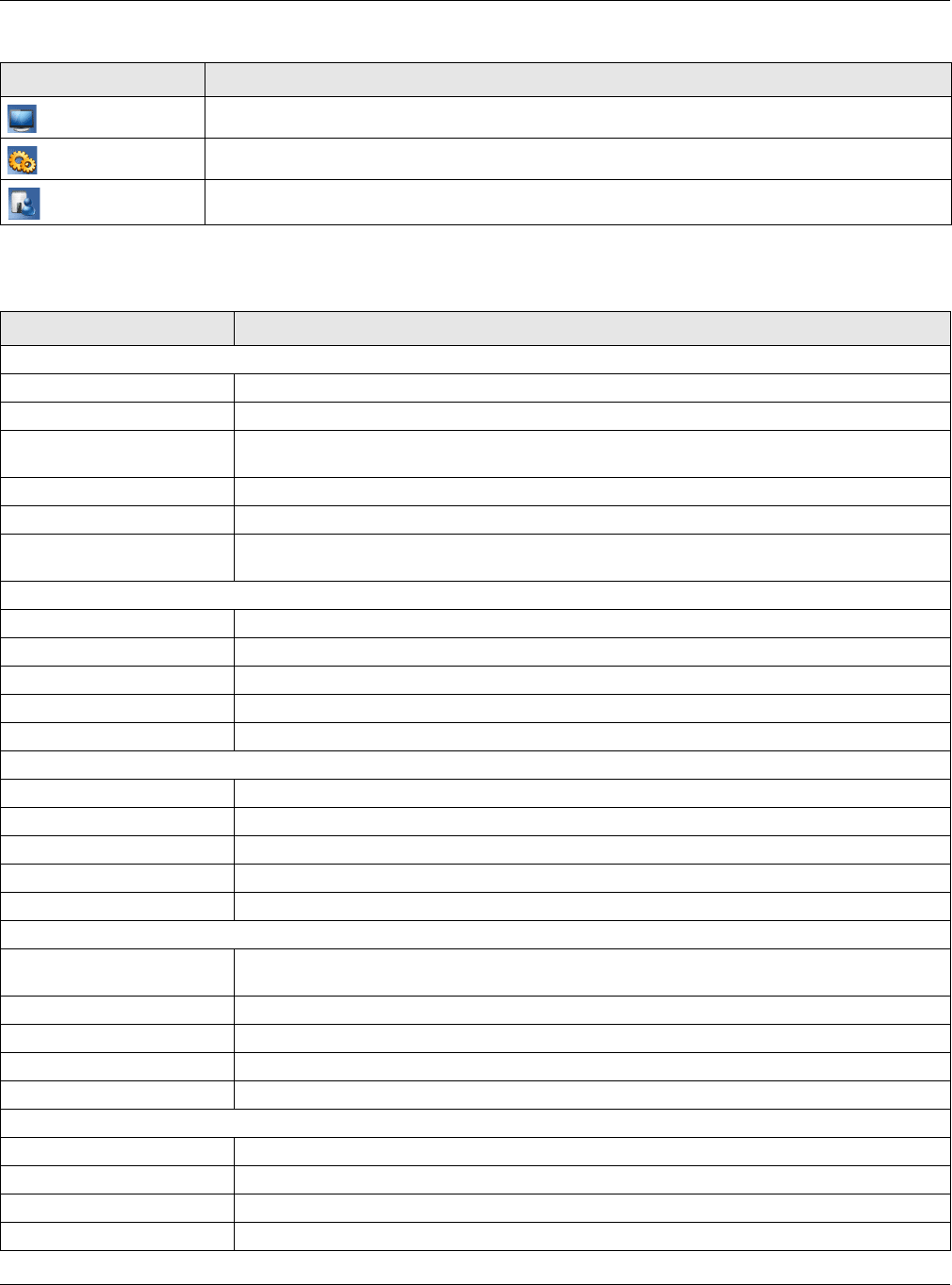
Chapter 4 Router Mode
EMG6765-Q10A User’s Guide
24
The following table describes the labels shown in the Status screen.
Click this icon to see the Monitor navigation menu.
Click this icon to see the Configuration navigation menu.
Click this icon to see the Maintenance navigation menu.
Table 5 Status Screen Icon Key (continued)
ICON DESCRIPTION
Table 6 Status Screen: Router Mode
LABEL DESCRIPTION
Device Information
Item This column shows the type of data the EMG6765-Q10A is recording.
Data This column shows the actual data recorded by the EMG6765-Q10A.
Host Name This is the System Name you enter in the Maintenance > General screen. It is for identification
purposes.
Model Number This is the model name of your device.
Firmware Version This is the firmware version and the date created.
Sys OP Mode This is the device mode (Section 3.1.1 on page 21) to which the EMG6765-Q10A is set - Router
Mode.
WAN Information
MAC Address This shows the WAN Ethernet adapter MAC Address of your device.
IP Address This shows the WAN port’s IP address.
IP Subnet Mask This shows the WAN port’s subnet mask.
Default Gateway This shows the WAN port’s gateway IP address.
IPv6 Address This shows the IPv6 address of the EMG6765-Q10A on the WAN.
LAN Information
MAC Address This shows the LAN Ethernet adapter MAC Address of your device.
IP Address This shows the LAN port’s IP address.
IP Subnet Mask This shows the LAN port’s subnet mask.
DHCP This shows the LAN port’s DHCP role - Server or Disable.
IPv6 Address This shows the IPv6 address of the EMG6765-Q10A on the LAN.
WLAN 2.4G Information
WLAN OP Mode This is the device mode (Section 3.1.1 on page 21) to which the EMG6765-Q10A’s wireless LAN is
set - Access Point Mode.
MAC Address This shows the 2.4GHz wireless adapter MAC Address of your device.
SSID This shows a descriptive name used to identify the EMG6765-Q10A in the 2.4GHz wireless LAN.
Channel This shows the channel number which you select manually.
Security This shows the level of wireless security the EMG6765-Q10A is using.
WLAN 5G Information
MAC Address This shows the 5GHz wireless adapter MAC Address of your device.
SSID This shows a descriptive name used to identify the EMG6765-Q10A in the 5GHz wireless LAN.
Channel This shows the channel number which you select manually.
Security This shows the level of wireless security the EMG6765-Q10A is using.

Chapter 4 Router Mode
EMG6765-Q10A User’s Guide
25
4.2.1 Navigation Panel
Use the sub-menus on the navigation panel to configure EMG6765-Q10A features.
Firewall This shows whether the firewall is enabled or not.
Summary
Packet Statistics Click Details... to go to the Monitor > Packet Statistics screen (Section 7.5 on page 56). Use this
screen to view port status and packet specific statistics.
WLAN 2.4G Station Status Click Details... to go to the Monitor > WLAN 2.4G Station Status screen (Section 7.6 on page 57).
Use this screen to view the wireless stations that are currently associated to the EMG6765-Q10A’s
2.4GHz wireless LAN.
WLAN 5G Station Status Click Details... to go to the Monitor > WLAN 5G Station Status screen (Section 7.6 on page 57). Use
this screen to view the wireless stations that are currently associated to the EMG6765-Q10A’s
5GHz wireless LAN.
System Status
System Up Time This is the total time the EMG6765-Q10A has been on.
Current Date/Time This field displays your EMG6765-Q10A’s present date and time.
System Resource
- CPU Usage This displays what percentage of the EMG6765-Q10A’s processing ability is currently used. When
this percentage is close to 100%, the EMG6765-Q10A is running at full load, and the throughput is
not going to improve anymore. If you want some applications to have more throughput, you
should turn off other applications (for example, using bandwidth management.)
- Memory Usage This shows what percentage of the heap memory the EMG6765-Q10A is using.
Interface Status
Interface This displays the EMG6765-Q10A port types. The port types are: WAN, LAN and WLAN.
Status For the LAN and WAN ports, this field displays Down (line is down) or Up (line is up or connected).
For the 2.4GHz/5GHz WLAN, it displays Up when the 2.4GHz/5GHz WLAN is enabled or Down
when the 2.4G/5G WLAN is disabled.
Rate For the LAN ports, this displays the port speed and duplex setting or N/A when the line is
disconnected.
For the WAN port, it displays the port speed and duplex setting if you’re using Ethernet
encapsulation. This field displays N/A when the line is disconnected.
For the 2.4GHz/5GHz WLAN, it displays the maximum transmission rate when the 2.4GHz/5GHz
WLAN is enabled and N/A when the WLAN is disabled.
Table 6 Status Screen: Router Mode (continued)
LABEL DESCRIPTION
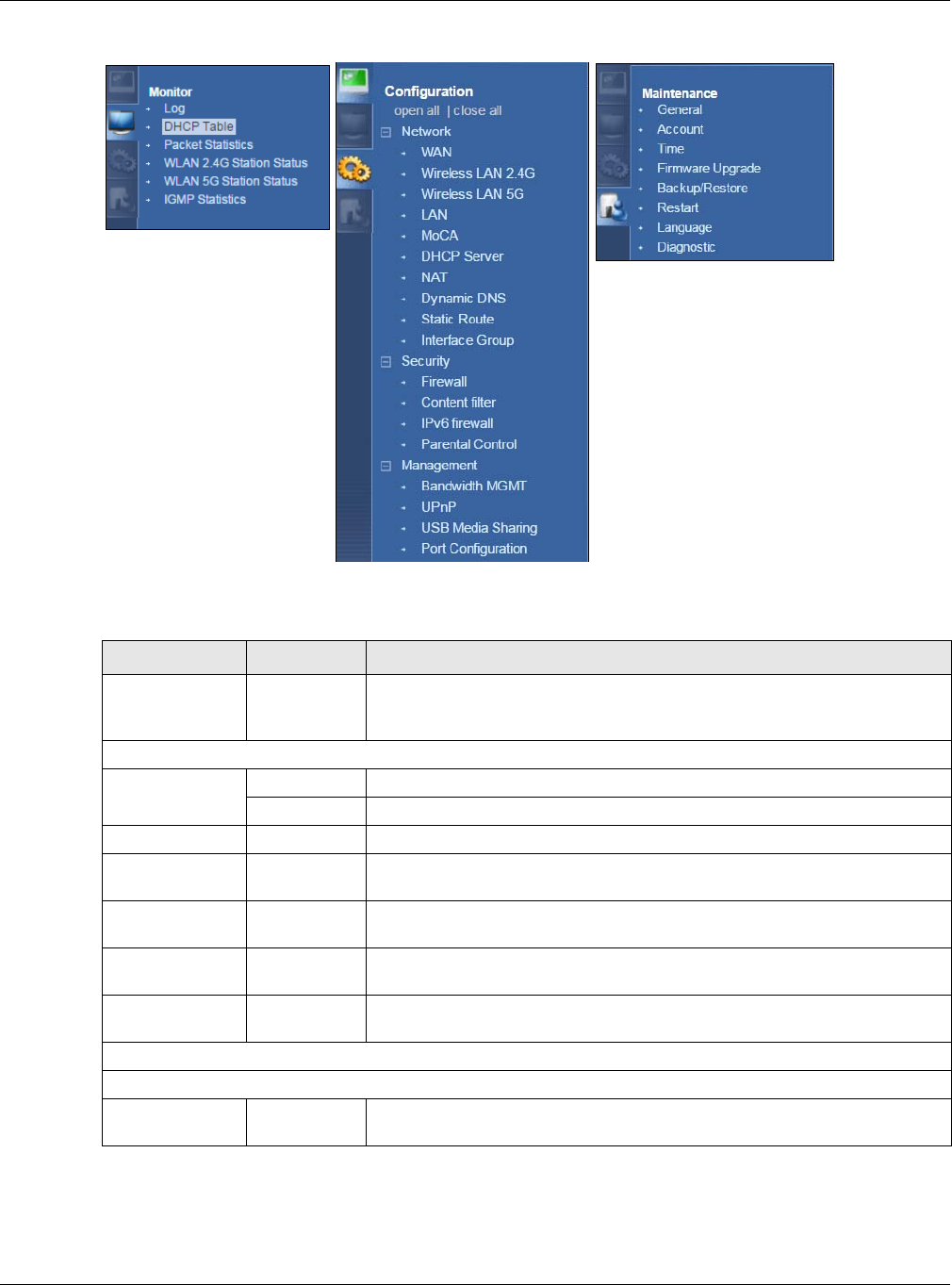
Chapter 4 Router Mode
EMG6765-Q10A User’s Guide
26
Figure 9 Navigation Panel: Router Mode (Admin)
The following table describes the sub-menus.
Table 7 Navigation Panel: Router Mode (Admin)
LINK TAB FUNCTION
Status This screen shows the EMG6765-Q10A’s general device, system and interface
status information. Use this screen to access the wizard, and summary statistics
tables.
MONITOR
Log View Log Use this screen to view the list of activities recorded by your EMG6765-Q10A.
Log Setting Use this screen to specify which logs to display in the View Log screen.
DHCP Table DHCP Table Use this screen to view current DHCP client information.
Packet Statistics Packet
Statistics
Use this screen to view port status and packet specific statistics.
WLAN 2.4G
Station Status
Association
List
Use this screen to view the wireless stations that are currently associated to the
EMG6765-Q10A’s 2.4GHz wireless LAN.
WLAN 5G Station
Status
Association
List
Use this screen to view the wireless stations that are currently associated to the
EMG6765-Q10A’s 5GHz wireless LAN.
IGMP Statistics IGMP Statistics Use this screen to view the EMG6765-Q10A’s IGMP multicast group and IGMP
traffic statistics.
CONFIGURATION
Network
WAN Management
WAN
This screen allows you to configure ISP parameters, WAN IP address
assignment, DNS servers, the WAN MAC address, and VLAN settings.

Chapter 4 Router Mode
EMG6765-Q10A User’s Guide
27
Wireless LAN
2.4G/5G General Use this screen to enable the wireless LAN and configure wireless LAN and
wireless security settings.
More AP Use this screen to configure multiple BSSs on the EMG6765-Q10A.
MAC Filter Use the MAC filter screen to configure the EMG6765-Q10A to block access to
devices or block the devices from accessing the EMG6765-Q10A.
Advanced This screen allows you to configure advanced wireless settings.
QoS Use this screen to configure Wi-Fi Multimedia Quality of Service (WMM QoS).
WMM QoS allows you to prioritize wireless traffic according to the delivery
requirements of individual services.
WPS Use this screen to configure WPS.
WPS Station Use this screen to add a wireless station using WPS.
Scheduling Use this screen to schedule the times the Wireless LAN is enabled.
LAN IP Use this screen to configure LAN IP address and subnet mask.
IP Alias Use this screen to have the EMG6765-Q10A apply IP alias to create LAN
subnets.
IPv6 LAN Use this screen to configure the IPv6 address for the EMG6765-Q10A on the
LAN.
IGMP
Snooping
Use this screen to activate IGMP snooping and configure IGMP modes.
MoCA MoCA Use this screen to set the MoCA Privacy, and enable multimedia and home
networking over coaxial cabling.
Monitor Use this screen to view the MoCA connection status and information about the
connected MoCA device(s).
DHCP Server General Use this screen to enable the EMG6765-Q10A’s DHCP server.
Advanced Use this screen to assign IP addresses to specific individual computers based
on their MAC addresses and to have DNS servers assigned by the DHCP server.
Client List Use this screen to view information related to your DHCP status.
NAT General Use this screen to enable NAT.
Port
Forwarding
Use this screen to configure servers behind the EMG6765-Q10A and forward
incoming service requests to the server(s) on your local network.
Port Trigger Use this screen to change your EMG6765-Q10A’s port triggering settings.
Dynamic DNS Dynamic DNS Use this screen to set up dynamic DNS.
Static Route Static Route Use this screen to configure IP static routes.
Interface
Group Interface
Group
Use this screen to add a LAN interface or a VLAN ID to a new group.
Security
Firewall General Use this screen to activate/deactivate the firewall.
Services This screen shows a summary of the firewall rules, and allows you to edit/add a
firewall rule.
Content Filter Content Filter Use this screen to restrict web features and designate a trusted computer.
IPv6 firewall Services Use this screen to configure IPv6 firewall rules.
Parental
Control Parental
Control
Use this screen to block certain web features and sites containing certain
keywords in the URL.
Management
Table 7 Navigation Panel: Router Mode (Admin) (continued)
LINK TAB FUNCTION

Chapter 4 Router Mode
EMG6765-Q10A User’s Guide
28
Bandwidth
MGMT General Use this screen to enable or disable QoS and set the upstream bandwidth.
Queue Setup Use this screen to configure QoS queue assignment.
Class Setup Use this screen to configure QoS classifiers.
UPnP UPnP Use this screen to enable UPnP on the EMG6765-Q10A.
USB Media
Sharing DLNA Use this screen to have the EMG6765-Q10A function as a DLNA-compliant
media server, that lets DLNA-compliant media clients play video, audio, and
photo content files stored on the connected USB storage device.
SAMBA Use this screen to enable file sharing through the EMG6765-Q10A.
FTP Use this screen to have the EMG6765-Q10A act as a FTP server.
Port
Configuration Port
Configuration
Use this screen to change the Ethernet port speed and duplex settings.
MAINTENANCE
General General Use this screen to view and change administrative settings such as system and
domain names.
Account User Account Use this screen to change the password of your EMG6765-Q10A.
Time Time Setting Use this screen to change your EMG6765-Q10A’s time and date.
Firmware
Upgrade Firmware
Upgrade
Use this screen to upload firmware to your EMG6765-Q10A.
Backup/
Restore Backup/
Restore
Use this screen to backup and restore the configuration or reset the factory
defaults to your EMG6765-Q10A.
Restart System Restart This screen allows you to reboot the EMG6765-Q10A without turning the power
off.
Language Language This screen allows you to select the language you prefer.
Diagnostic Ping Use this screen to ping an IP address.
Trace Route Use this screen to trace the route packets take to a host.
Nslookup Use this screen to perform an nslookup (name server lookup).
Table 7 Navigation Panel: Router Mode (Admin) (continued)
LINK TAB FUNCTION
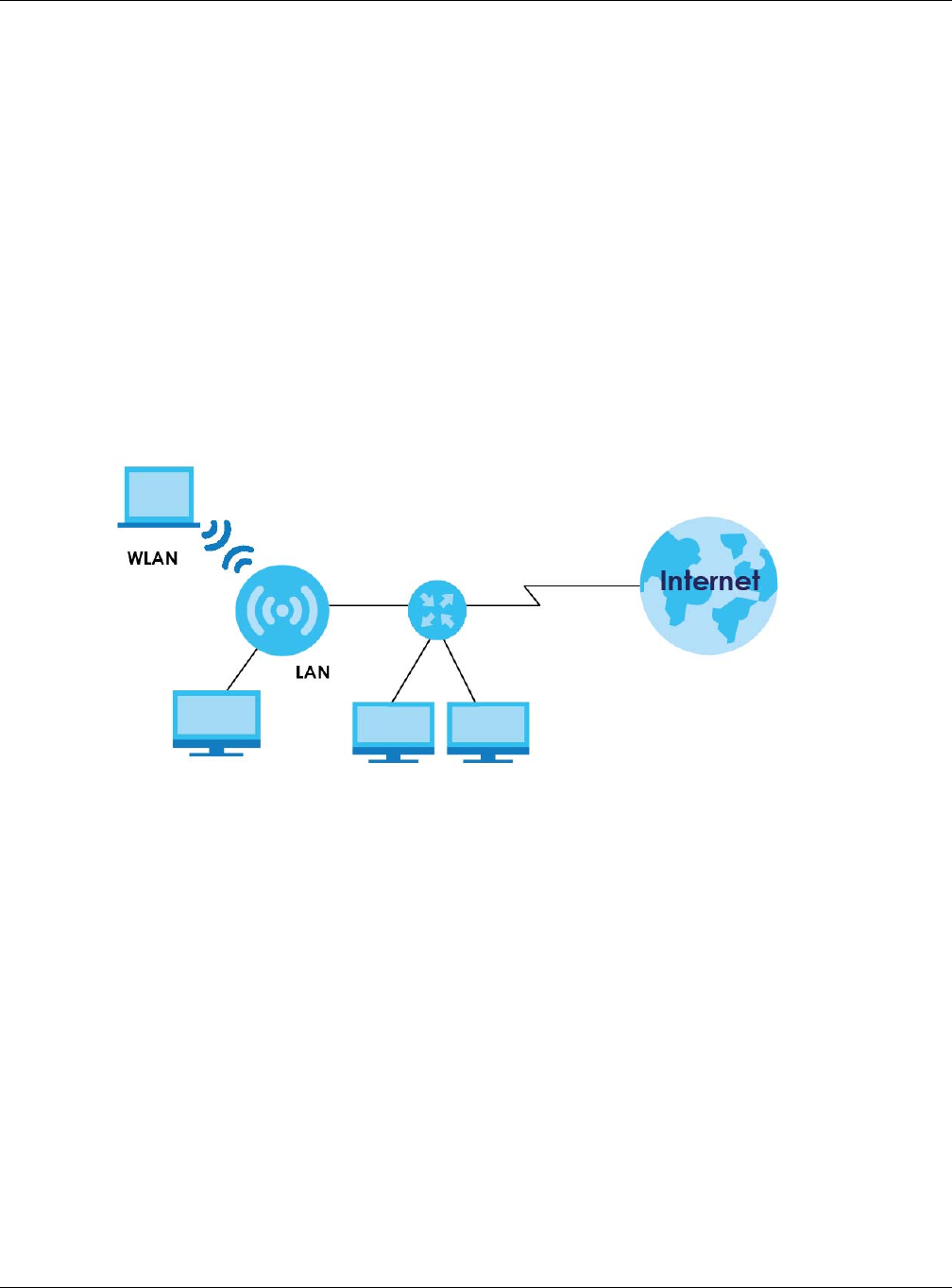
Chapter 5 Access Point Mode
EMG6765-Q10A User’s Guide
29
CHAPTER 5
Access Point Mode
5.1 Overview
Use your EMG6765-Q10A as an access point (AP) if you already have a router or gateway on your
network. In this mode your EMG6765-Q10A bridges a wired network (LAN) and wireless LAN (WLAN) in
the same subnet. See the figure below for an example.
Figure 10 Wireless Internet Access in Access Point Mode
Many screens that are available in Router Mode are not available in Access Point Mode, such as
bandwidth management and firewall.
5.2 What You Can Do
• Use the Status screen to view read-only information about your EMG6765-Q10A (Section 5.4 on page
31).
• Use the LAN screen to set the IP address for your EMG6765-Q10A acting as an access point (Section
5.5 on page 33).
5.3 What You Need to Know
See Chapter 6 on page 36 for a tutorial on setting up a network with the EMG6765-Q10A as an access
point.
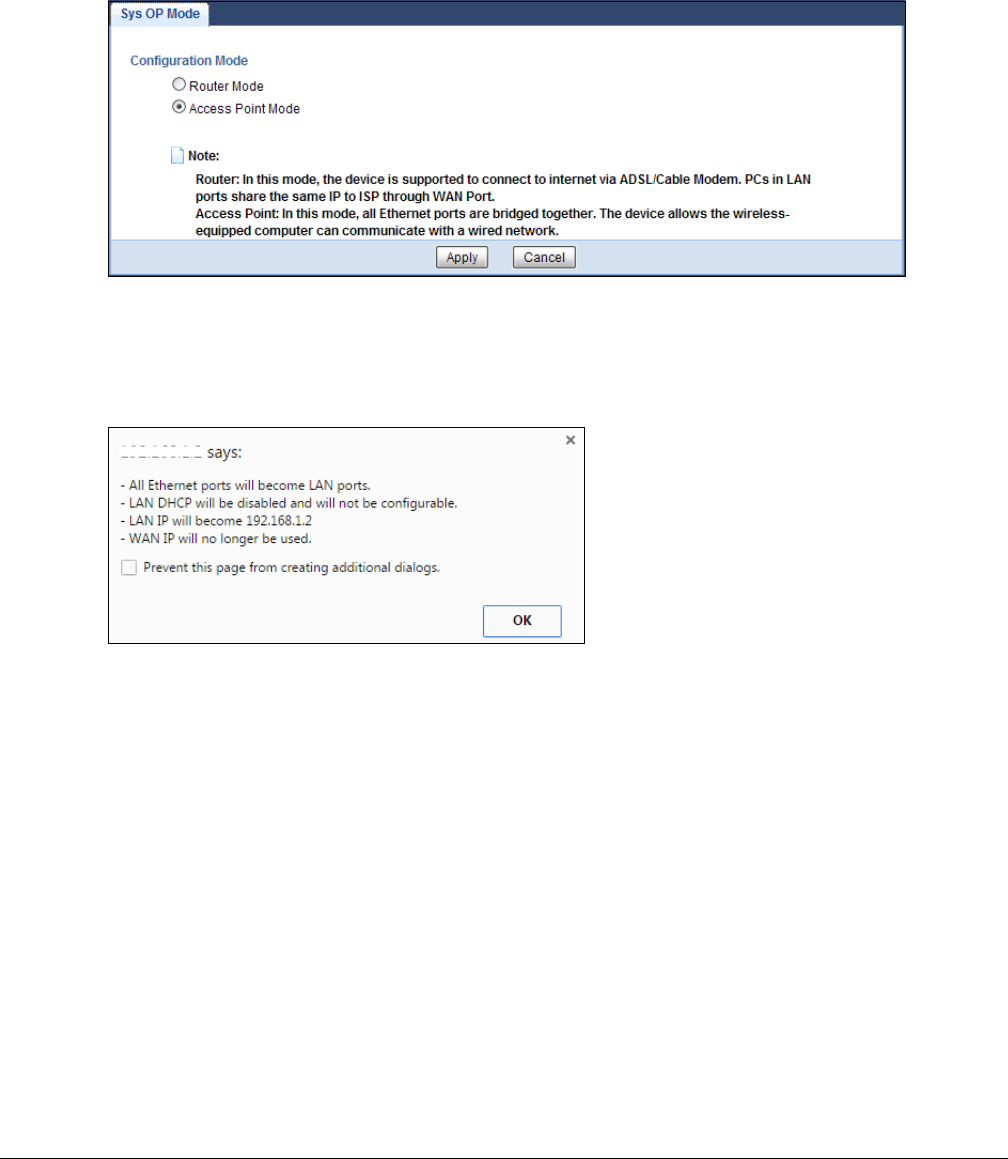
EMG6765-Q10A User’s Guide
30
5.3.1 Setting your EMG6765-Q10A to AP Mode
1Log into the Web Configurator if you haven’t already. See the Quick start Guide for instructions on how
to do this.
2To use your EMG6765-Q10A as an access point, go to Maintenance > Sys OP Mode and select Access
Point Mode.
Figure 11 Changing to Access Point mode
Note: You have to log in to the Web Configurator again when you change modes. As soon as
you do, your EMG6765-Q10A is already in Access Point mode.
3When you select Access Point Mode, the following pop-up message window appears.
Figure 12 Pop up for Access Point mode
Click OK. Then click Apply. The Web Configurator refreshes once the change to Access Point mode is
successful.
5.3.2 Accessing the Web Configurator in Access Point Mode
Log in to the Web Configurator in Access Point mode, do the following:
1Connect your computer to the LAN port of the EMG6765-Q10A.
2The default IP address of the EMG6765-Q10A is “192.168.1.2”. In this case, your computer must have an
IP address in the range between “192.168.1.3” and “192.168.1.254”.
3Click Start > Run on your computer in Windows. Type “cmd” in the dialog box. Enter “ipconfig” to show
your computer’s IP address. If your computer’s IP address is not in the correct range then see Appendix
B on page 200 for information on changing your computer’s IP address.
4After you’ve set your computer’s IP address, open a web browser such as Internet Explorer and type
“192.168.1.2” as the web address in your web browser.
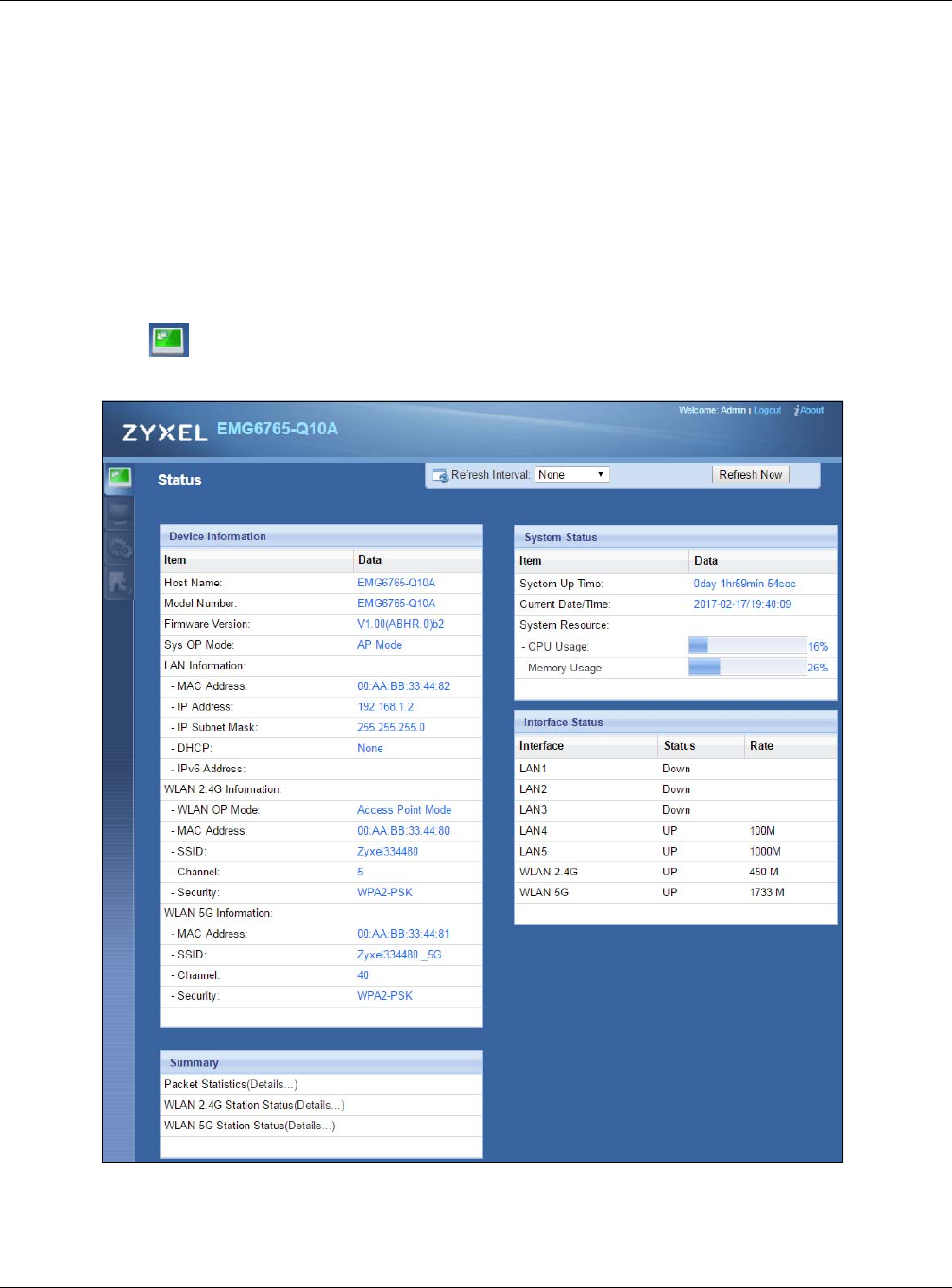
Chapter 5 Access Point Mode
EMG6765-Q10A User’s Guide
31
5.3.3 Configuring your WLAN and Maintenance Settings
The configuration of wireless and maintenance settings in Access Point Mode is the same as for Router
Mode.
•See Chapter 9 on page 72 for information on the configuring your wireless network.
•See Chapter 25 on page 173 for information on configuring your Maintenance settings.
5.4 AP Mode Status Screen
Click to open the Status screen.
Figure 13 Status Screen: Access Point Mode

Chapter 5 Access Point Mode
EMG6765-Q10A User’s Guide
32
The following table describes the labels shown in the Status screen.
Table 8 Status Screen: Access Point Mode
LABEL DESCRIPTION
Device Information
Item This column shows the type of data the EMG6765-Q10A is recording.
Data This column shows the actual data recorded by the EMG6765-Q10A.
Host Name This is the System Name you enter in the Maintenance > General screen. It is for identification
purposes.
Model Number This is the model name of your device.
Firmware Version This is the firmware version and the date created.
Sys OP Mode This is the device mode (Section 3.1.1 on page 21) to which the EMG6765-Q10A is set - AP Mode.
LAN Information
MAC Address This shows the LAN Ethernet adapter MAC Address of your device.
IP Address This shows the LAN port’s IP address.
IP Subnet Mask This shows the LAN port’s subnet mask.
DHCP This shows the LAN port’s DHCP role - Client or None.
IPv6 Address This shows the IPv6 address of the EMG6765-Q10A on the LAN.
WLAN 2.4G Information
WLAN OP Mode This is the device mode (Section 3.1.1 on page 21) to which the EMG6765-Q10A’s wireless LAN is
set - Access Point Mode.
MAC Address This shows the 2.4GHz wireless adapter MAC Address of your device.
SSID This shows a descriptive name used to identify the EMG6765-Q10A in the 2.4GHz wireless LAN.
Channel This shows the channel number which you select manually.
Security This shows the level of wireless security the EMG6765-Q10A is using.
WLAN 5G Information
MAC Address This shows the 5GHz wireless adapter MAC Address of your device.
SSID This shows a descriptive name used to identify the EMG6765-Q10A in the 5GHz wireless LAN.
Channel This shows the channel number which you select manually.
Security This shows the level of wireless security the EMG6765-Q10A is using.
Summary
Packet Statistics Click Details... to go to the Monitor > Packet Statistics screen (Section 7.5 on page 56). Use this
screen to view port status and packet specific statistics.
WLAN 2.4G Station Status Click Details... to go to the Monitor > WLAN 2.4G Station Status screen (Section 7.6 on page 57).
Use this screen to view the wireless stations that are currently associated to the EMG6765-Q10A’s
2.4GHz wireless LAN.
WLAN 5G Station Status Click Details... to go to the Monitor > WLAN 5G Station Status screen (Section 7.6 on page 57). Use
this screen to view the wireless stations that are currently associated to the EMG6765-Q10A’s
5GHz wireless LAN.
System Status
System Up Time This is the total time the EMG6765-Q10A has been on.
Current Date/Time This field displays your EMG6765-Q10A’s present date and time.
System Resource
- CPU Usage This displays what percentage of the EMG6765-Q10A’s processing ability is currently used. When
this percentage is close to 100%, the EMG6765-Q10A is running at full load, and the throughput is
not going to improve anymore. If you want some applications to have more throughput, you
should turn off other applications (for example, using bandwidth management.)
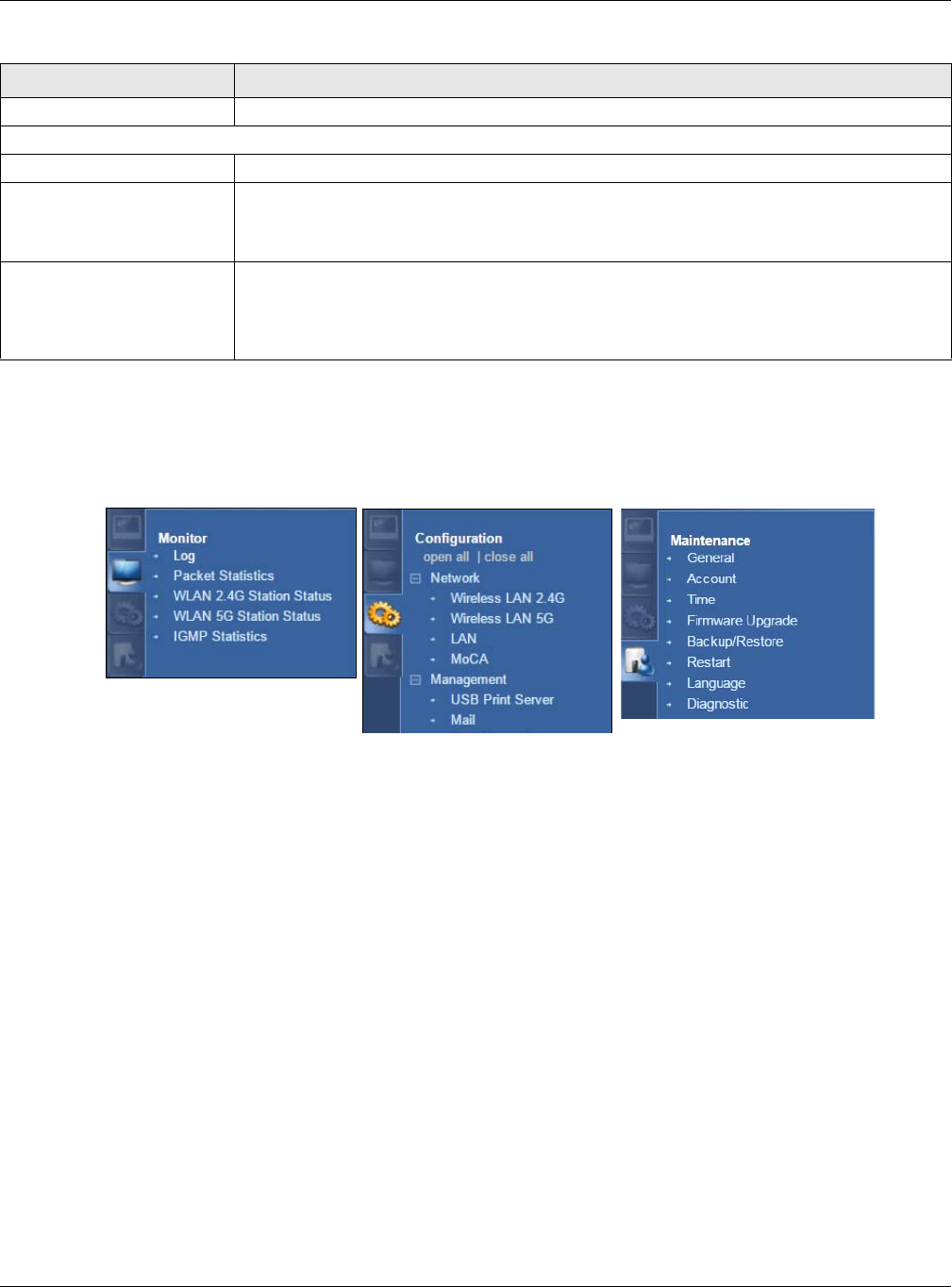
Chapter 5 Access Point Mode
EMG6765-Q10A User’s Guide
33
5.4.1 Navigation Panel
Use the menu in the navigation panel to configure EMG6765-Q10A features in Access Point Mode.
Figure 14 Menu: Access Point Mode (Admin)
Refer to Table 7 on page 26 for descriptions of the labels shown in the navigation panel.
5.5 LAN Screen
Use this section to configure your LAN settings while in Access Point Mode.
Click Network > LAN to see the screen below.
Note: If you change the IP address of the EMG6765-Q10A in the screen below, you will need
to log into the EMG6765-Q10A again using the new IP address.
- Memory Usage This shows what percentage of the heap memory the EMG6765-Q10A is using.
Interface Status
Interface This displays the EMG6765-Q10A port types. The port types are: LAN and WLAN.
Status For the LAN ports, this field displays Down (line is down) or Up (line is up or connected).
For the 2.4GHz/5GHz WLAN, it displays Up when the 2.4GHz/5GHz WLAN is enabled or Down
when the 2.4G/5G WLAN is disabled.
Rate For the LAN ports, this displays the port speed and duplex setting or N/A when the line is
disconnected.
For the 2.4GHz/5GHz WLAN, it displays the maximum transmission rate when the 2.4GHz/5GHz
WLAN is enabled and N/A when the WLAN is disabled.
Table 8 Status Screen: Access Point Mode (continued)
LABEL DESCRIPTION
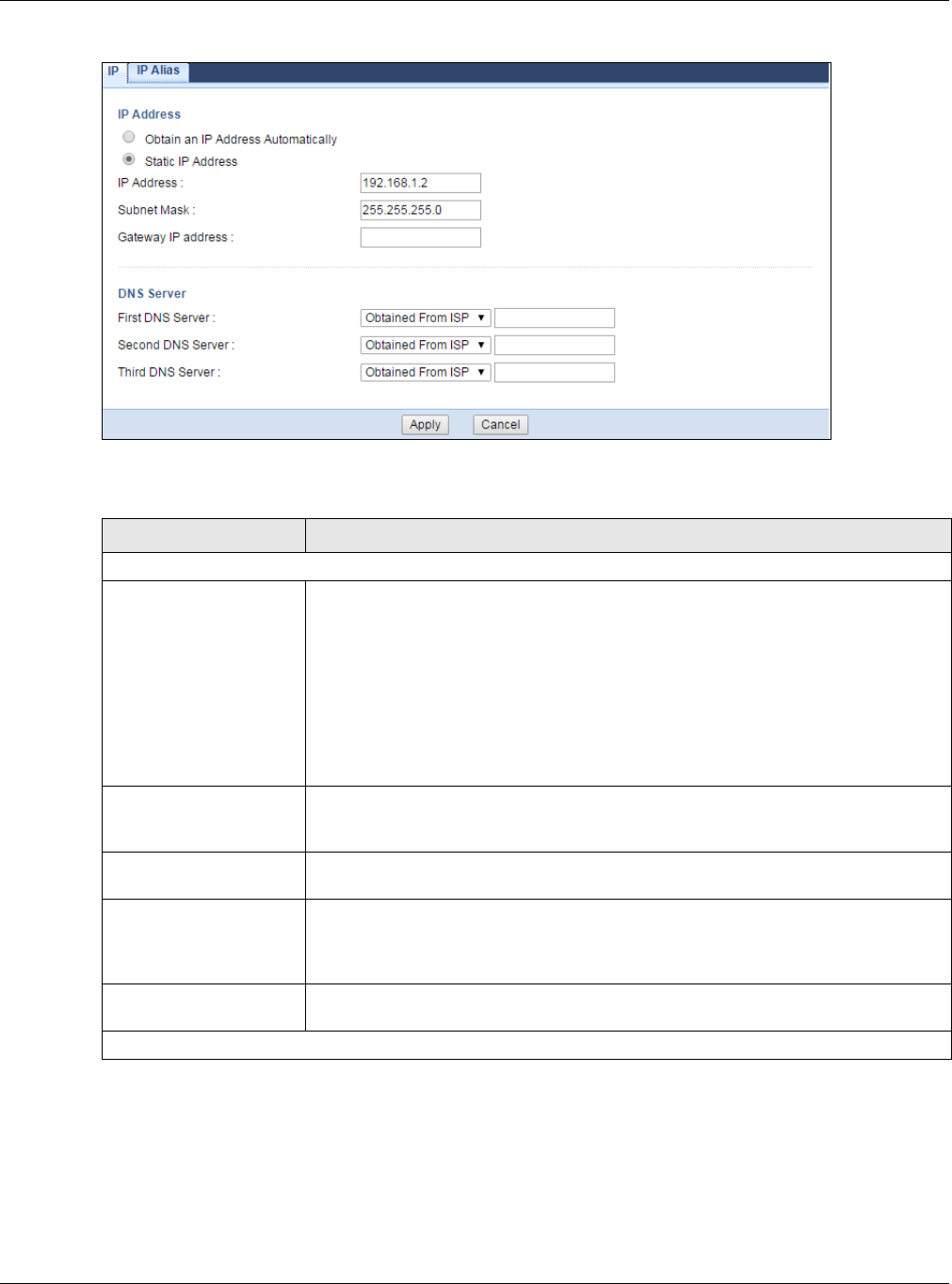
Chapter 5 Access Point Mode
EMG6765-Q10A User’s Guide
34
Figure 15 Network > LAN > IP
The table below describes the labels in the screen.
Table 9 Network > LAN > IP
LABEL DESCRIPTION
IP Address
Obtain an IP Address
Automatically
When you enable this, the EMG6765-Q10A gets its IP address from the network’s DHCP
server (for example, your ISP). Users connected to the EMG6765-Q10A can now access
the network (i.e., the Internet if the IP address is given by the ISP).
The Web Configurator may no longer be accessible unless you know the IP address
assigned by the DHCP server to the EMG6765-Q10A. You need to reset the EMG6765-
Q10A to be able to access the Web Configurator again (see Section 25.7 on page 178
for details on how to reset the EMG6765-Q10A).
Also when you select this, you cannot enter an IP address for your EMG6765-Q10A in
the field below.
Static IP Address Click this if you want to specify the IP address of your EMG6765-Q10A. Or if your ISP or
network administrator gave you a static IP address to access the network or the
Internet.
IP Address Type the IP address in dotted decimal notation. The default setting is 192.168.1.2. If you
change the IP address you will have to log in again with the new IP address.
Subnet Mask The subnet mask specifies the network number portion of an IP address. Your EMG6765-
Q10A will automatically calculate the subnet mask based on the IP address that you
assign. Unless you are implementing subnetting, use the subnet mask computed by the
EMG6765-Q10A.
Gateway IP Address Enter a Gateway IP Address (if your ISP or network administrator gave you one) in this
field.
DNS Server

Chapter 5 Access Point Mode
EMG6765-Q10A User’s Guide
35
First DNS Server
Second DNS Server
Third DNS Server
Select Obtained From ISP if your ISP dynamically assigns DNS server information (and
the EMG6765-Q10A's WAN IP address). The field to the right displays the (read-only) DNS
server IP address that the ISP assigns.
Select User-Defined if you have the IP address of a DNS server. Enter the DNS server's IP
address in the field to the right. If you chose User-Defined, but leave the IP address set
to 0.0.0.0, User-Defined changes to None after you click Apply. If you set a second
choice to User-Defined, and enter the same IP address, the second User-Defined
changes to None after you click Apply.
Select None if you do not want to configure DNS servers. If you do not configure a DNS
server, you must know the IP address of a computer in order to access it.
Apply Click Apply to save your changes to the EMG6765-Q10A.
Cancel Click Cancel to reload the previous configuration for this screen.
Table 9 Network > LAN > IP (continued)
LABEL DESCRIPTION
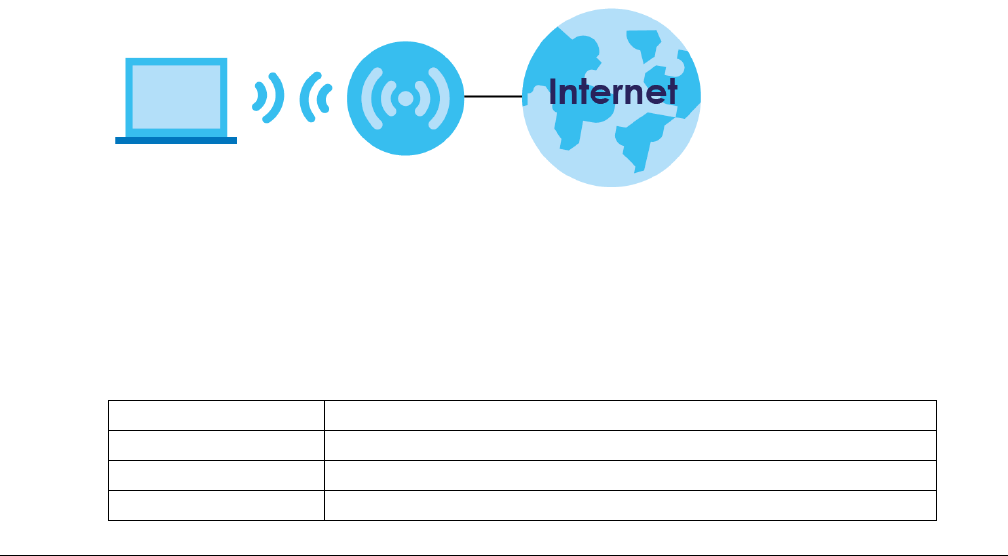
EMG6765-Q10A User’s Guide
36
CHAPTER 6
Tutorials
6.1 Overview
This chapter provides tutorials for setting up your EMG6765-Q10A.
•Setting Up a Secure Wireless Network
•Connecting to the EMG6765-Q10A’s Wi-Fi Network Using WPS
•Connecting to the EMG6765-Q10A’s Wi-Fi Network Without WPS
•Configuring Static Route for Routing to Another Network
•Access the EMG6765-Q10A Using DDNS
•Configuring the MAC Address Filter
•Using Multiple SSIDs on the EMG6765-Q10A
6.2 Setting Up a Secure Wireless Network
Thomas wants to set up a wireless network so that he can use his notebook to access the Internet. In this
wireless network, the EMG6765-Q10A serves as an access point (AP), and the notebook is the wireless
client. The wireless client can access the Internet through the AP.
Thomas has to configure the wireless network settings on the EMG6765-Q10A.
6.2.1 Configuring the Wireless Network Settings
This example shows how to configure wireless security settings with the following parameters on your
EMG6765-Q10A and connect your computer to the EMG6765-Q10A’s wireless network.
SSID Example
802.11 Mode 802.11b/g/n
Security Mode WPA2-PSK
Pre-Shared Key DoNotStealMyWirelessNetwork
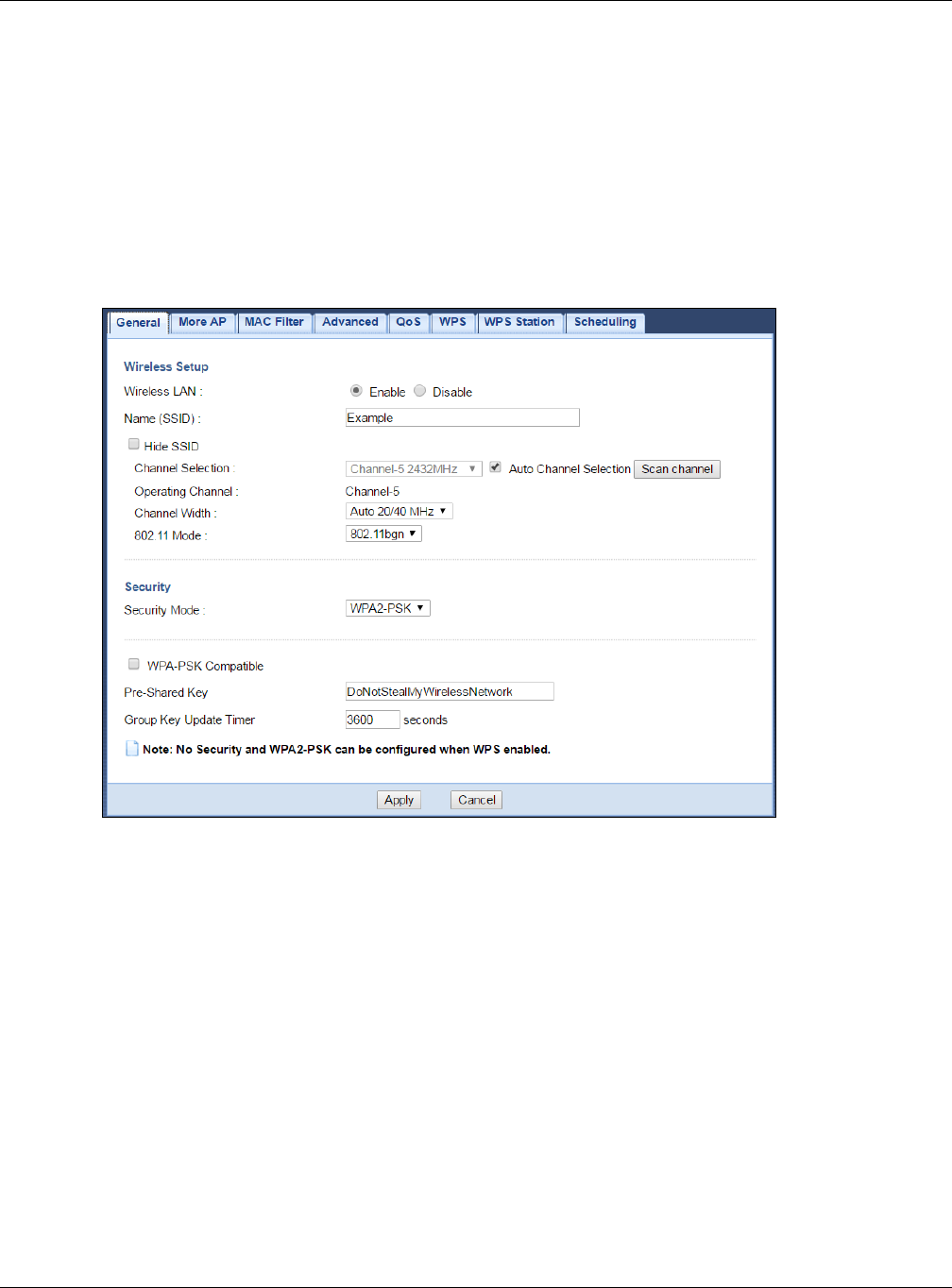
Chapter 6 Tutorials
EMG6765-Q10A User’s Guide
37
Follow the steps below to configure the wireless settings on your EMG6765-Q10A.
The instructions require that your hardware is connected (see the Quick Start Guide) and you are
logged into the Web Configurator through your LAN connection (see Section 2.3 on page 18).
1Make sure the Wi-Fi button (at the back panel of the EMG6765-Q10A) is set ON.
2Click Configuration > Network > Wireless LAN 2.4G or 5G to open the General screen.
3Confirm that the wireless LAN is enabled on the EMG6765-Q10A. Configure the screen using the
provided parameters. Click Apply.
4Open the Dashboard screen. Verify your wireless and wireless security settings under Device Information
and check if the WLAN connection is up and under Interface Status.
Thomas can now use the WPS feature to establish a wireless connection between his notebook and the
EMG6765-Q10A (see Section 6.3 on page 37). He can also use the notebook’s wireless client to search
for the EMG6765-Q10A (see Section 6.5 on page 44).
6.3 Connecting to the EMG6765-Q10A’s Wi-Fi Network
Using WPS
This section gives you an example of how to set up a wireless network using WPS. This example uses the
EMG6765-Q10A as the AP and a WPS-enabled Android 4.4.2 smartphone as the wireless client.
There are two WPS methods for creating a secure connection. This tutorial shows you how to do both.
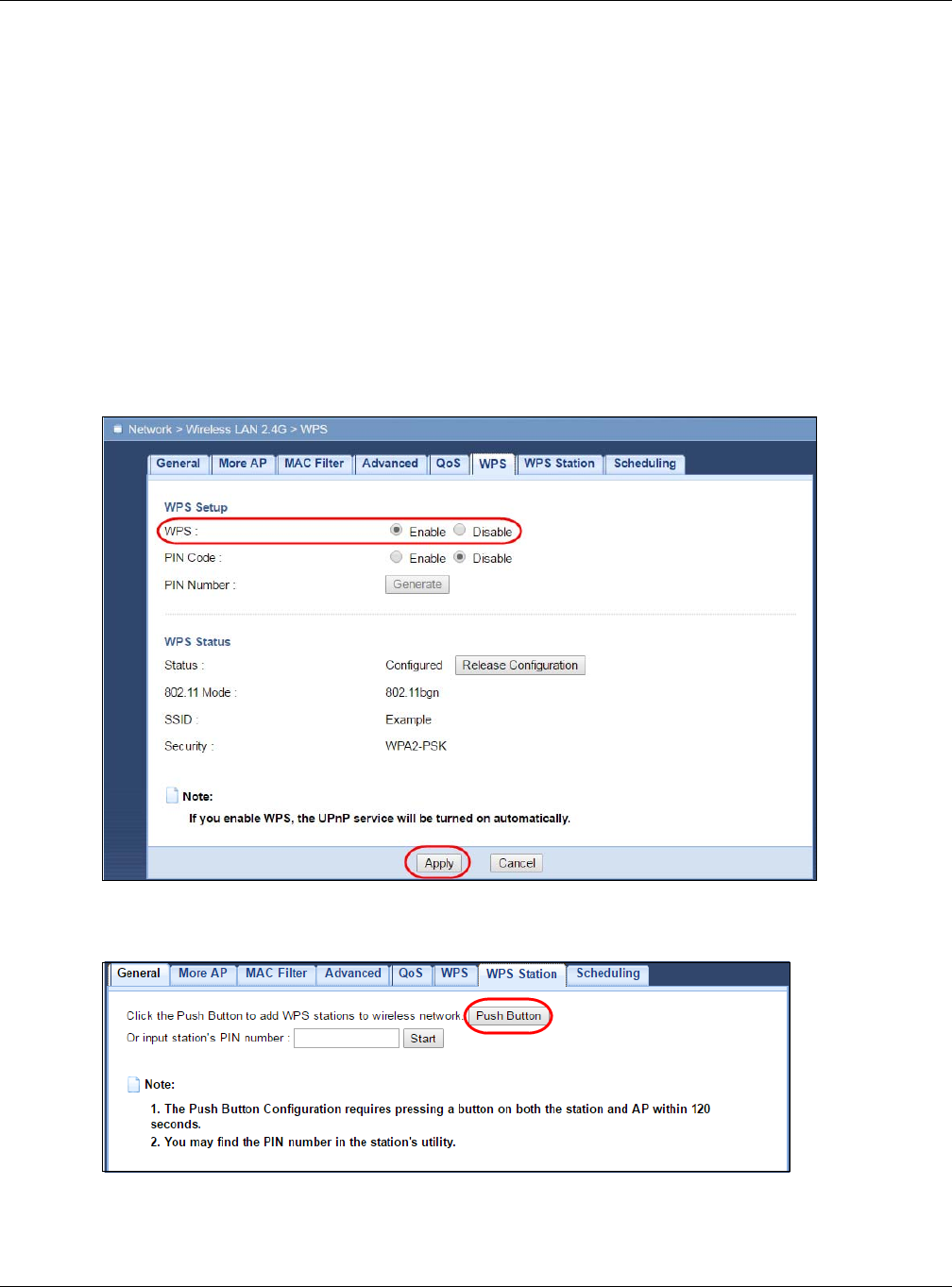
Chapter 6 Tutorials
EMG6765-Q10A User’s Guide
38
•Push Button Configuration (PBC) - create a secure wireless network simply by pressing a button. See
Section 6.3.1 on page 38. This is the easier method.
•PIN Configuration - create a secure wireless network simply by entering a wireless client's PIN (Personal
Identification Number) in the EMG6765-Q10A’s interface. See Section 6.3.2 on page 39. This is the
more secure method, since one device can authenticate the other.
6.3.1 Push Button Configuration (PBC)
1Make sure that your EMG6765-Q10A is turned on and that it is within range of your computer.
2Push and hold the WPS button located on the EMG6765-Q10A’s side panel for more than 1 second.
Alternatively, you may log into EMG6765-Q10A’s web configurator and go to the Configuration >
Network > Wireless LAN 2.4G or 5G > WPS screen. Enable the WPS function and click Apply. WPS is
enabled by default on the EMG6765-Q10A.
3Then go to the Configuration > Network > Wireless LAN 2.4G or 5G > WPS Station screen and click the
Push button.
Note: Your EMG6765-Q10A has a WPS button located on the side of the device as well as a
WPS button in its web configurator. Both buttons have exactly the same function: you
can use one or the other.
1
2
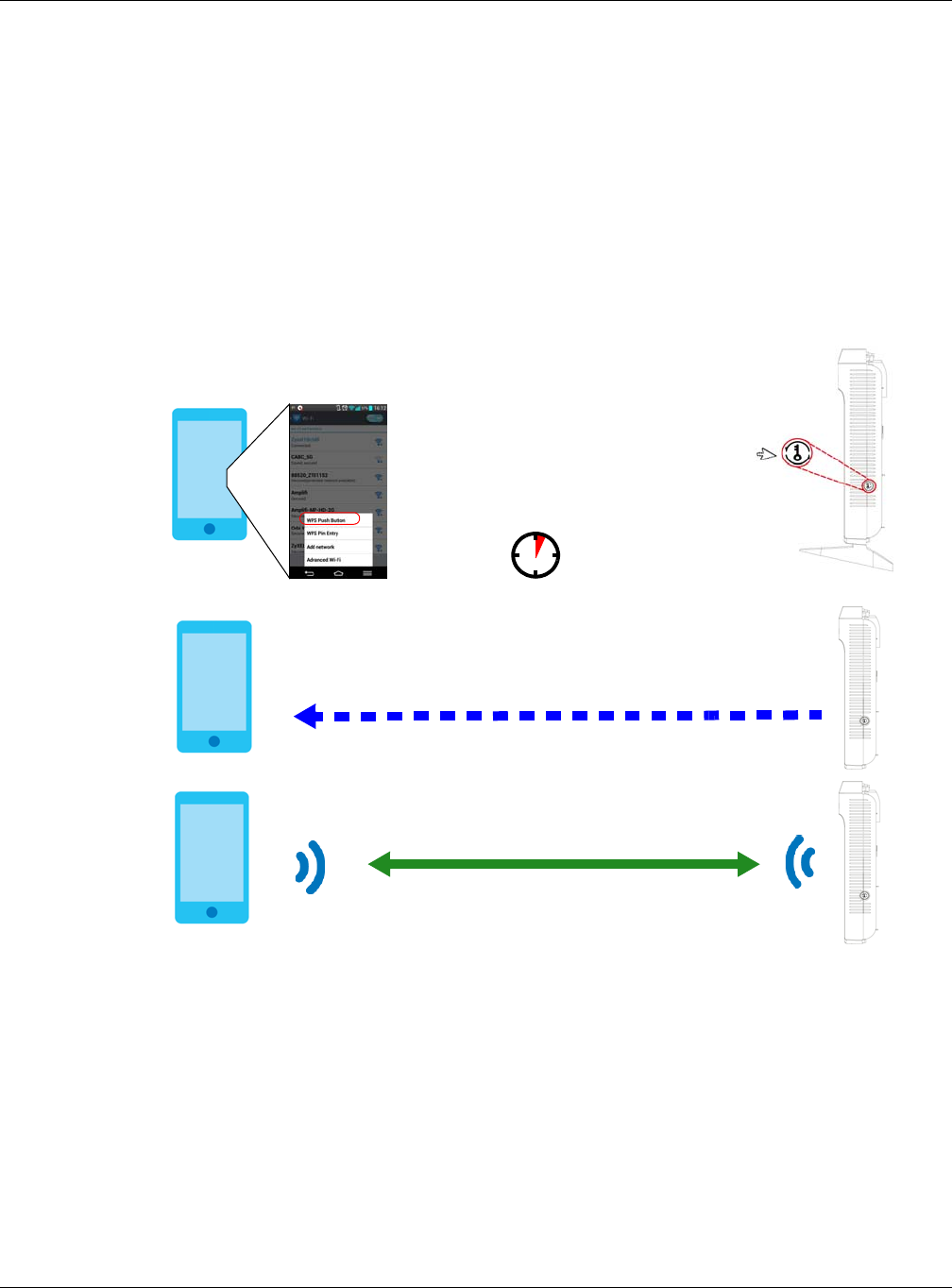
Chapter 6 Tutorials
EMG6765-Q10A User’s Guide
39
4Go to your phone settings and turn on Wi-Fi. Open the Wi-Fi networks and tap WPS Push Button or the
WPS icon (Section 3 on page 14).
Note: It doesn’t matter which button is pressed first. You must press the second button within
two minutes of pressing the first one.
The EMG6765-Q10A sends the proper configuration settings to the wireless client. This may take up to
two minutes. The wireless client is then able to communicate with the EMG6765-Q10A securely.
The following figure shows you an example of how to set up a wireless network and its security by
pressing a button on both EMG6765-Q10A and wireless client (the Android 4.4.2 phone in this example).
Figure 16 Example WPS Process: PBC Method
6.3.2 PIN Configuration
When you use the PIN configuration method, you need to check the client’s PIN number and use the
EMG6765-Q10A’s configuration interface.
1Go to your phone settings and turn on Wi-Fi. Open the Wi-Fi networks list and tap WPS PIN Entry to get a
PIN number.
2Then go to Configuration > Network > Wireless LAN 2.4G or 5G > WPS Station screen. Enter the client’s PIN
number to the PIN field. Click the Start button (or button next to the PIN field) on the EMG6765-Q10A WPS
Station screen within two minutes.
Wireless Client
SECURITY INFO
COMMUNICATION
WITHIN 2 MINUTES
AP
Press and hold
for more than
1 second
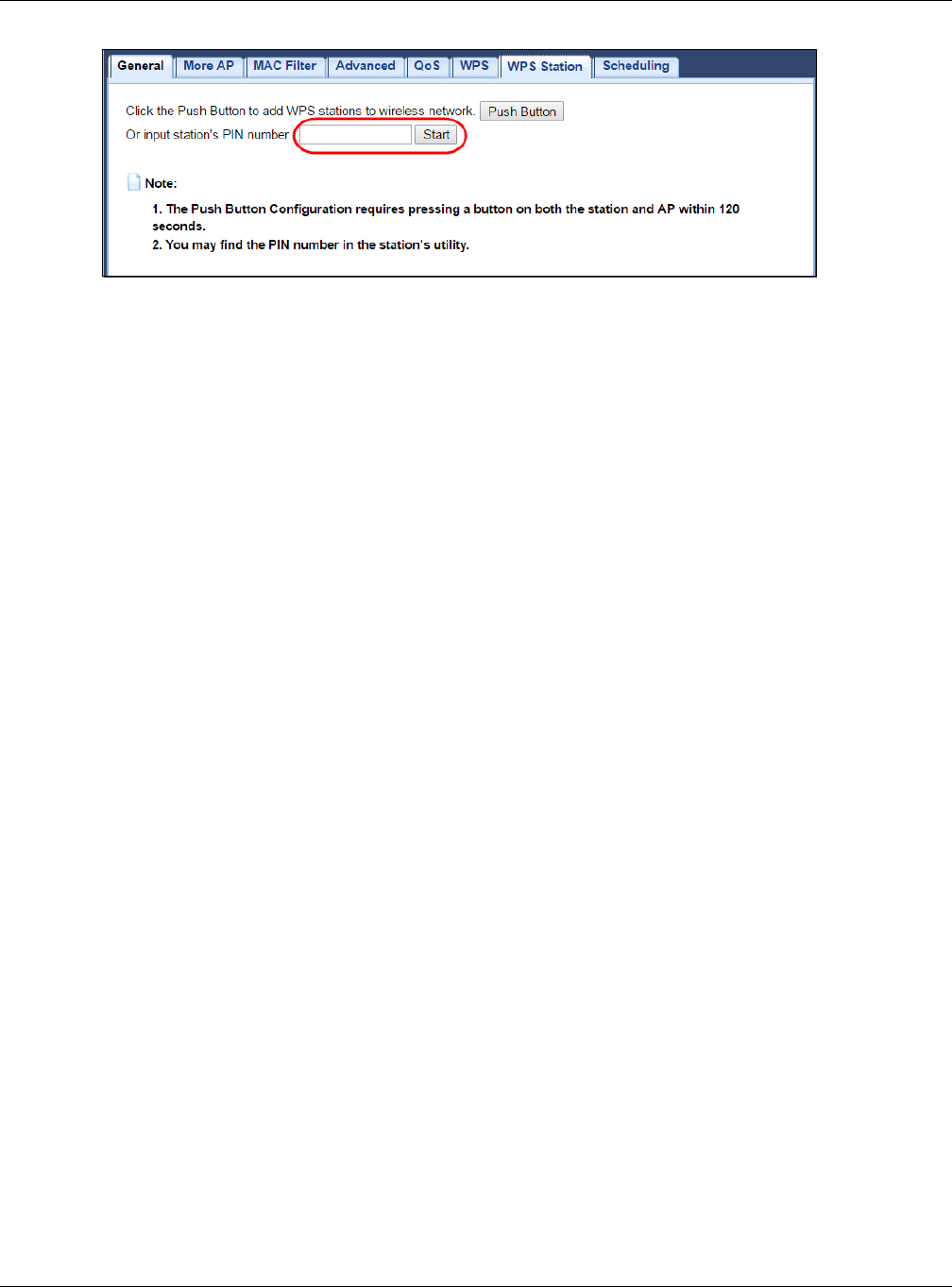
Chapter 6 Tutorials
EMG6765-Q10A User’s Guide
40
Note: You can also get a WPS PIN Code in EMG6765-Q10A’s Configuration > Network >
Wireless LAN 2.4G or 5G > WPS screen. Enable Pin Code then click Generate and enter
this PIN code in the wireless client’s configuration utility.
The EMG6765-Q10A authenticates the wireless client and sends the proper configuration settings to the
wireless client. This may take up to two minutes. The wireless client is then able to communicate with the
EMG6765-Q10A securely.
The following figure shows you how to set up a wireless network and its security on a EMG6765-Q10A and
a wireless client (android 4.4.2 smartphone) by using PIN method.
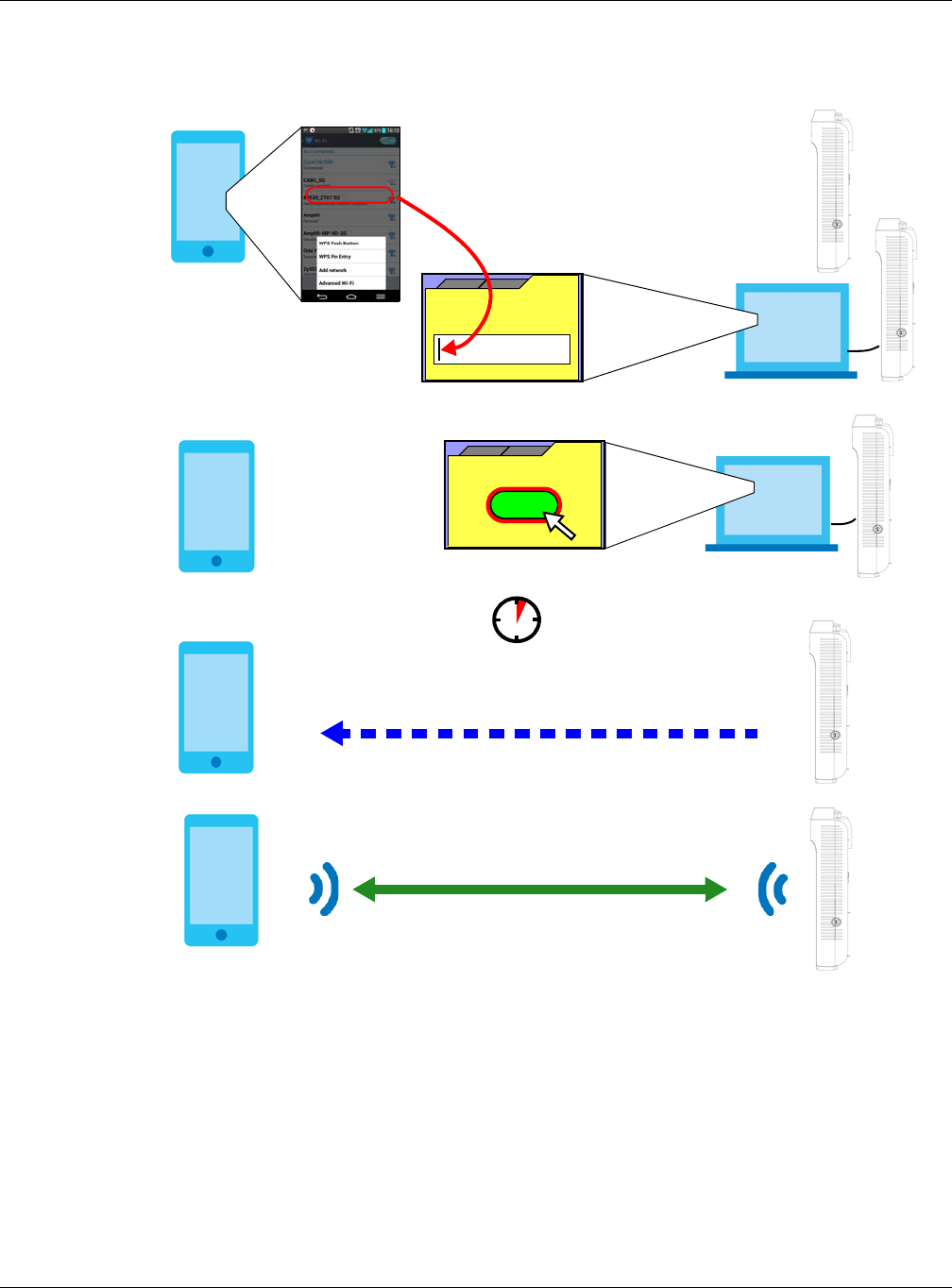
Chapter 6 Tutorials
EMG6765-Q10A User’s Guide
41
Figure 17 Example WPS Process: PIN Method
6.4 Connecting to the EMG6765-Q10A’s Wi-Fi Network
Without WPS
Note: In this example, we use a Windows 7 laptop that has a built-in wireless adapter as the
wireless client.
SECURITY INFO
WITHIN 2 MINUTES
Enter WPS PIN
WPS
from other device:
WPS
START
Wireless Client AP
Authentication by PIN
COMMUNICATION
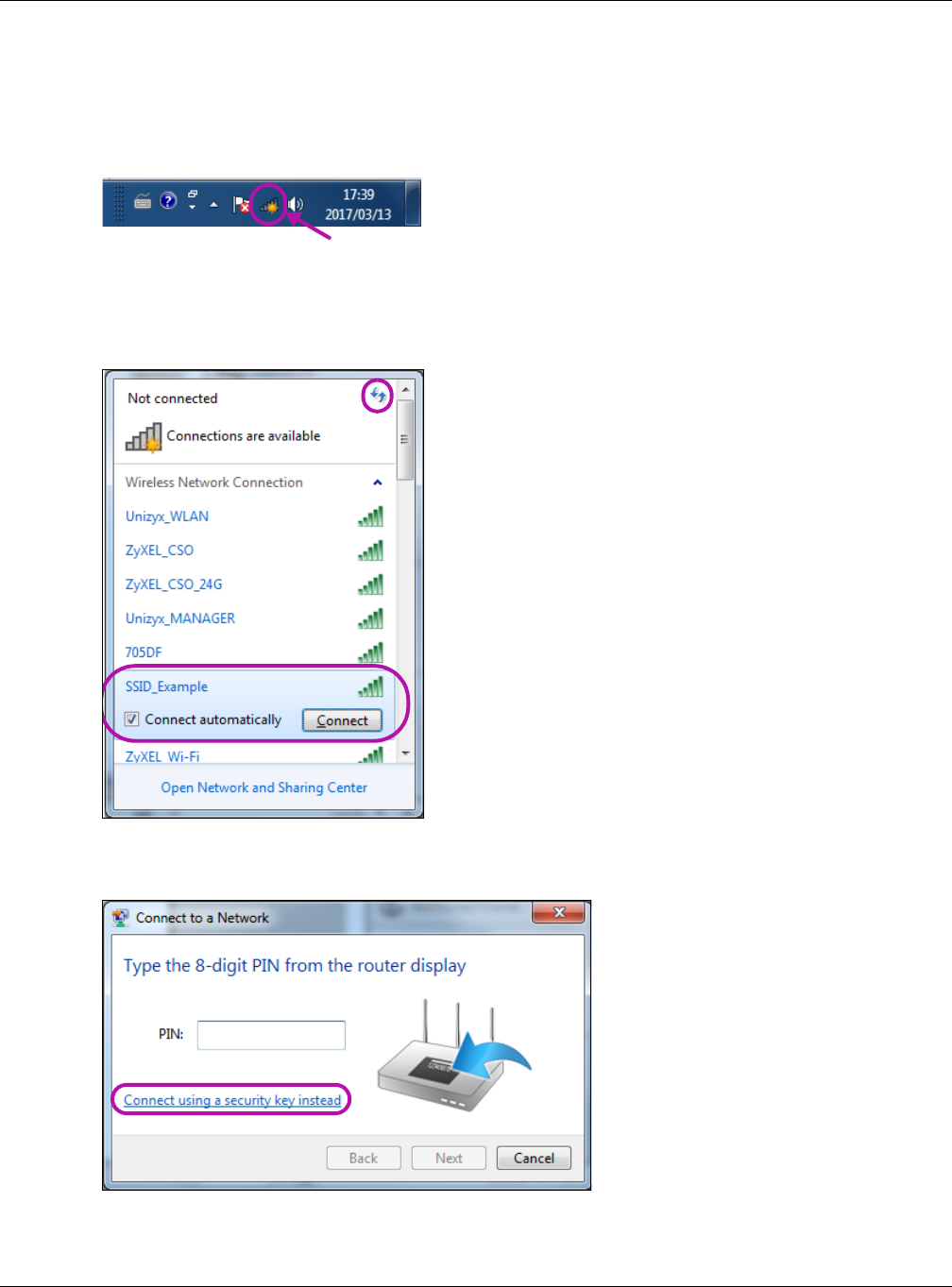
Chapter 6 Tutorials
EMG6765-Q10A User’s Guide
42
1The EMG6765-Q10A supports IEEE 802.11a, IEEE 802.11b, IEEE 802.11g, IEEE 802.11n, and IEEE 802.11ac
wireless clients. Make sure that your notebook or computer’s wireless adapter supports one of these
standards.
2Click the Wi-Fi icon in your computer’s system tray.
3The Wireless Network Connection screen displays. Click the refresh button to update the list of the
available wireless APs within range.
4Select SSID_Example and click Connect.
5The following screen displays if WPS is enabled on the EMG6765-Q10A but you didn’t press the WPS
button. Click Connect using as security key instead.
6Type the security key in the following screen. Click OK.
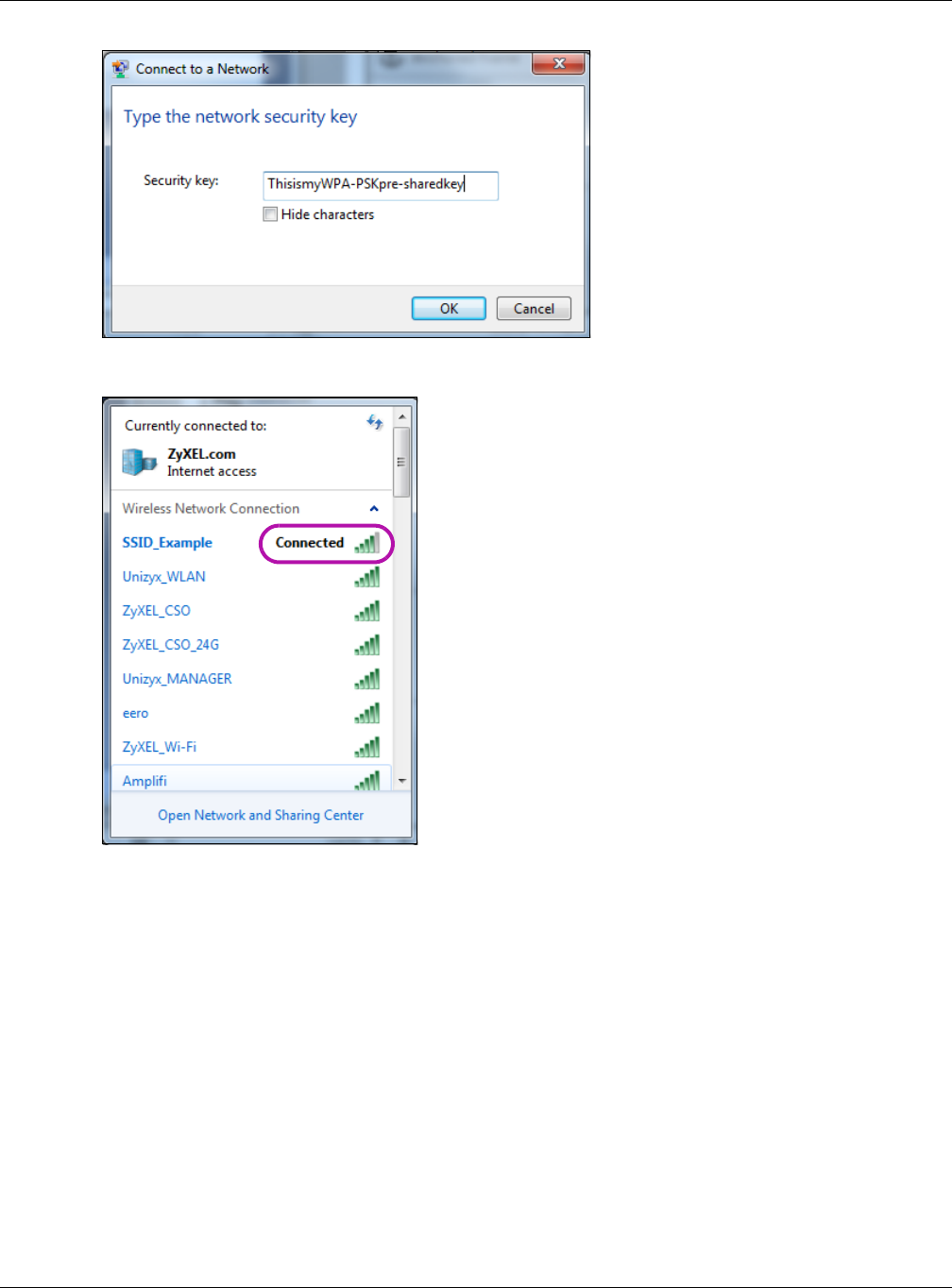
Chapter 6 Tutorials
EMG6765-Q10A User’s Guide
43
7Check the status of your wireless connection in the screen below.
8If the wireless client keeps trying to connect to or acquiring an IP address from the EMG6765-Q10A,
make sure you entered the correct security key.
If the connection has limited or no connectivity, make sure the DHCP server is enabled on the EMG6765-
Q10A.
If your connection is successful, open your Internet browser and enter http://www.zyxel.com or the URL
of any other web site in the address bar. If you are able to access the web site, your wireless connection
is successfully configured.
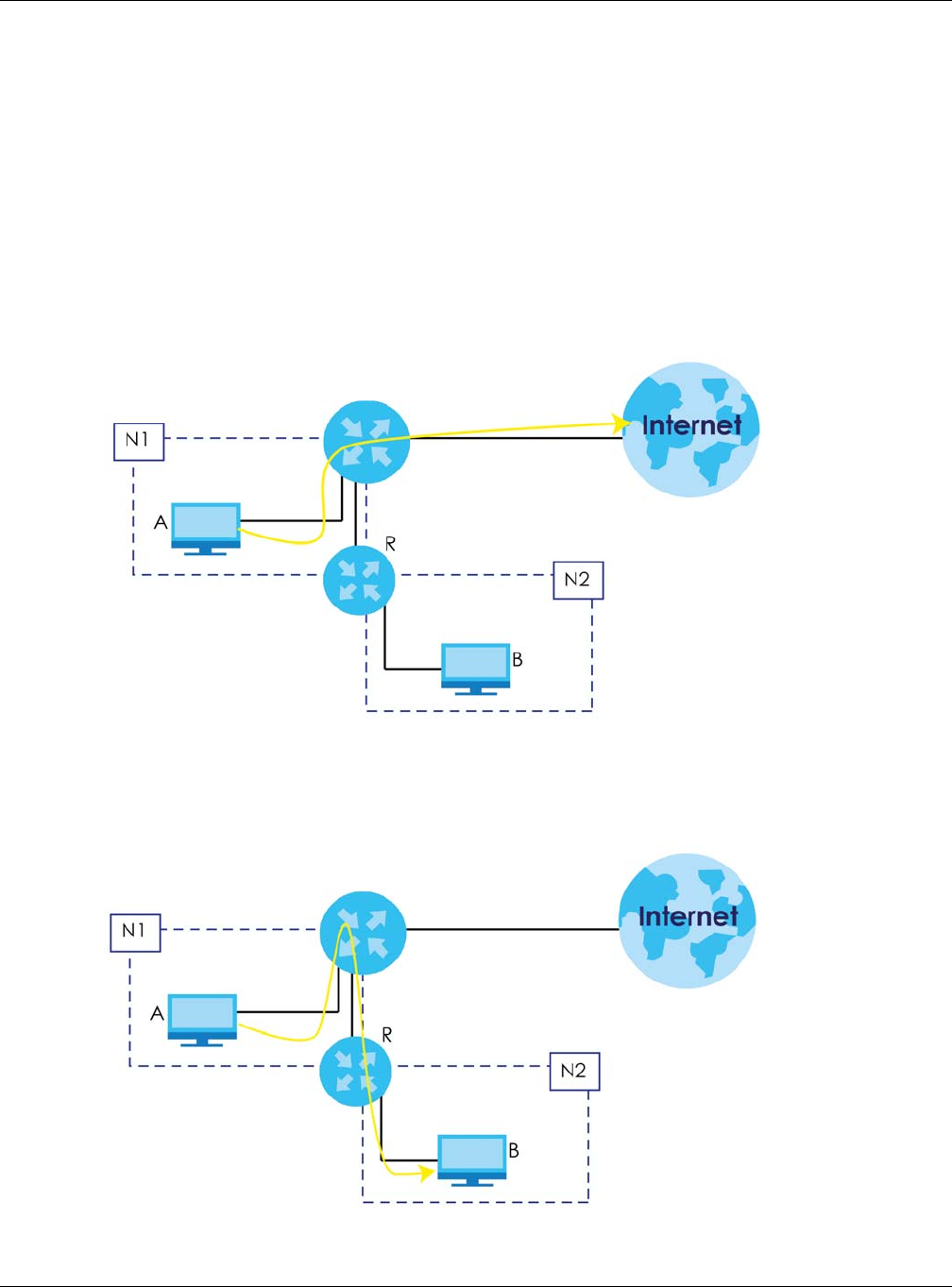
Chapter 6 Tutorials
EMG6765-Q10A User’s Guide
44
6.5 Configuring Static Route for Routing to Another
Network
In order to extend your Intranet and control traffic flowing directions, you may connect a router to the
EMG6765-Q10A’s LAN. The router may be used to separate two department networks. This tutorial shows
how to configure a static routing rule for two network routings.
In the following figure, router R is connected to the EMG6765-Q10A’s LAN. R connects to two networks,
N1 (192.168.1.x/24) and N2 (192.168.10.x/24). If you want to send traffic from computer A (in N1 network)
to computer B (in N2 network), the traffic is sent to the EMG6765-Q10A’s WAN default gateway by
default. In this case, B will never receive the traffic.
You need to specify a static routing rule on the EMG6765-Q10A to specify R as the router in charge of
forwarding traffic to N2. In this case, the EMG6765-Q10A routes traffic from A to R and then R routes the
traffic to B.
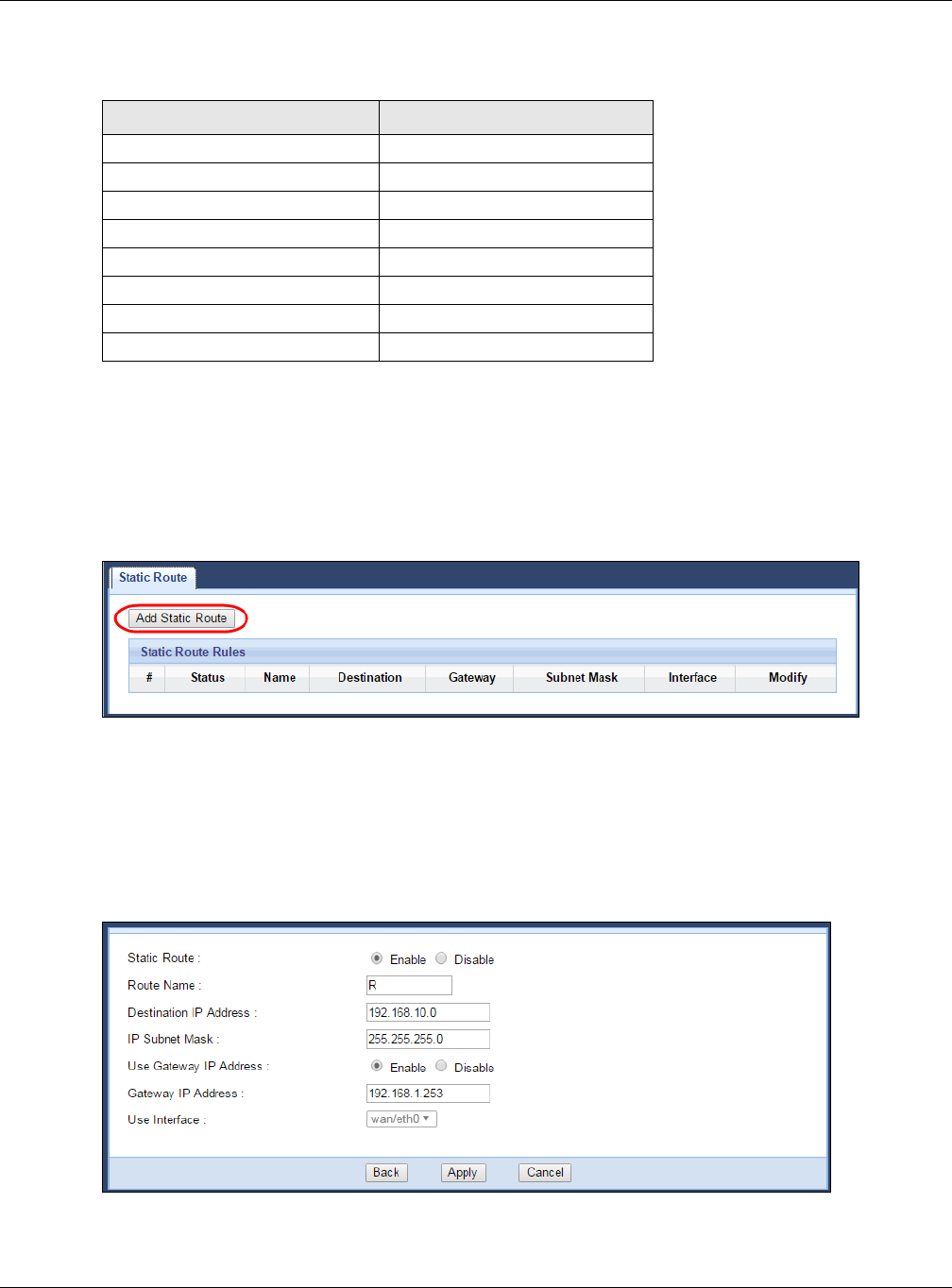
Chapter 6 Tutorials
EMG6765-Q10A User’s Guide
45
This tutorial uses the following example IP settings:
To configure a static route to route traffic from N1 to N2:
1Log into the EMG6765-Q10A’s Web Configurator in advanced mode.
2Click Configuration > Network > Static Route.
3Click Add Static Route in the Static Route screen.
4Configure the Add Static Route screen using the following settings:
4a Select Enable in the Static Route field. Enter the Route Name as R.
4b Type 192.168.10.0 and subnet mask 255.255.255.0 for the destination, N2.
4c Select Enable in the Use Gateway IP Address field. Type 192.168.1.253 (R’s N1 address) in the
Gateway IP Address field.
4d Click Apply.
Table 10 IP Settings in this Tutorial
DEVICE / COMPUTER IP ADDRESS
The EMG6765-Q10A’s WAN 172.16.1.1
The EMG6765-Q10A’s LAN 192.168.1.1
IP Type WAN
Use Interface VDSL
A192.168.1.34
R’s N1 192.168.1.253
R’s N2 192.168.10.2
B192.168.10.33
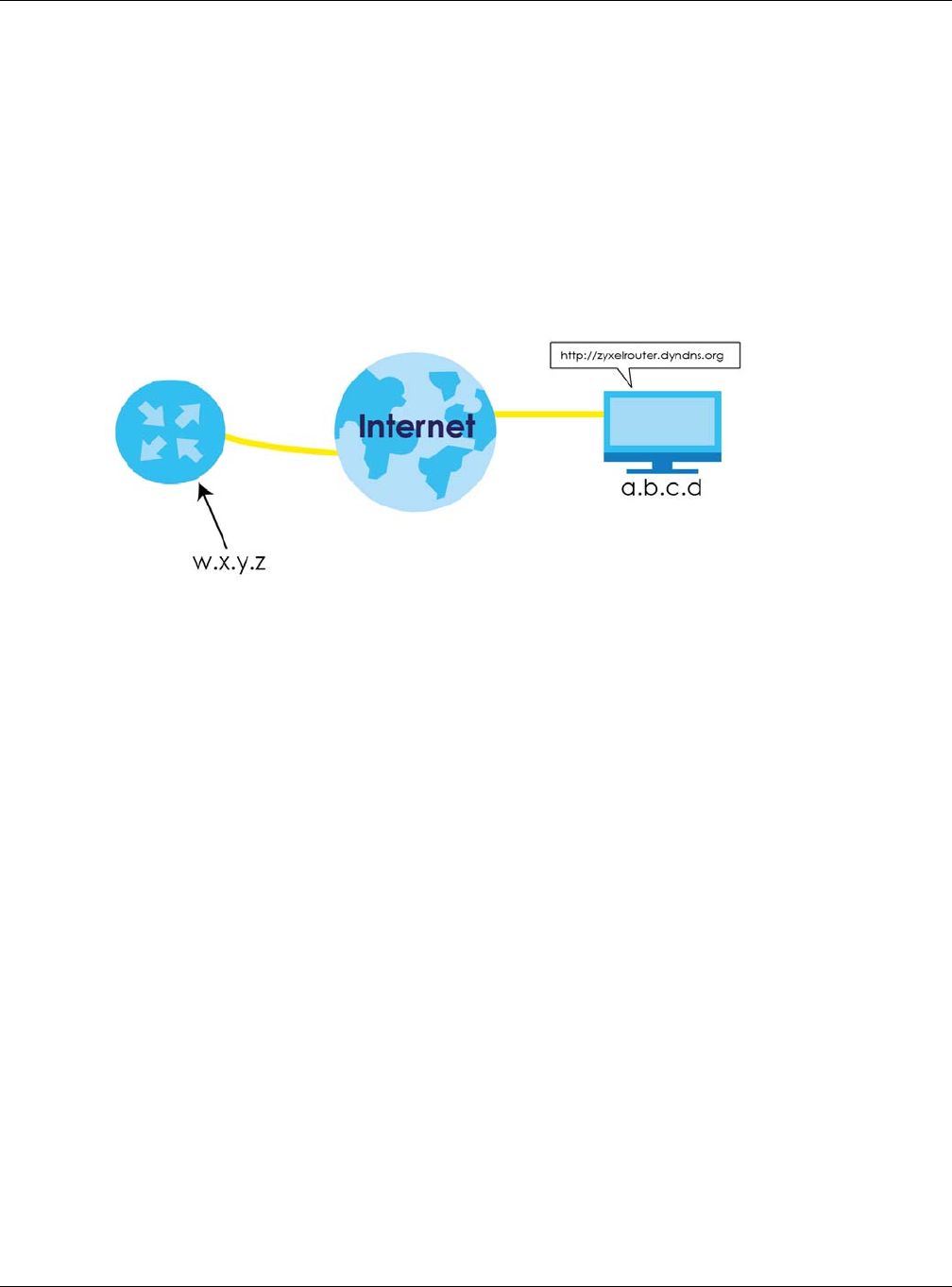
Chapter 6 Tutorials
EMG6765-Q10A User’s Guide
46
Now B should be able to receive traffic from A. You may need to additionally configure B’s firewall
settings to allow specific traffic to pass through.
6.6 Access the EMG6765-Q10A Using DDNS
If you connect your EMG6765-Q10A to the Internet and it uses a dynamic WAN IP address, it is
inconvenient for you to manage the device from the Internet. The EMG6765-Q10A’s WAN IP address
changes dynamically. Dynamic DNS (DDNS) allows you to access the EMG6765-Q10A using a domain
name.
To use this feature, you have to apply for DDNS service at, for example, www.dyndns.org.
This tutorial covers:
•Registering a DDNS Account on www.dyndns.org
•Configuring DDNS on Your EMG6765-Q10A
•Testing the DDNS Setting
Note: If you have a private WAN IP address, then you cannot use DDNS.
6.6.1 Registering a DDNS Account on www.dyndns.org
1Open a browser and type http://www.dyndns.org.
2Apply for a user account. This tutorial uses UserName1 and 5 as the username and password.
3Log into www.dyndns.org using your account.
4Add a new DDNS host name. This tutorial uses the following settings as an example.
• Hostname: zyxelrouter.dyndns.org
• Service Type: Host with IP address
• IP Address: Enter the WAN IP address that your EMG6765-Q10A is currently using. You can find the IP
address on the EMG6765-Q10A’s Web Configurator Status page.
Then you will need to configure the same account and host name on the EMG6765-Q10A later.
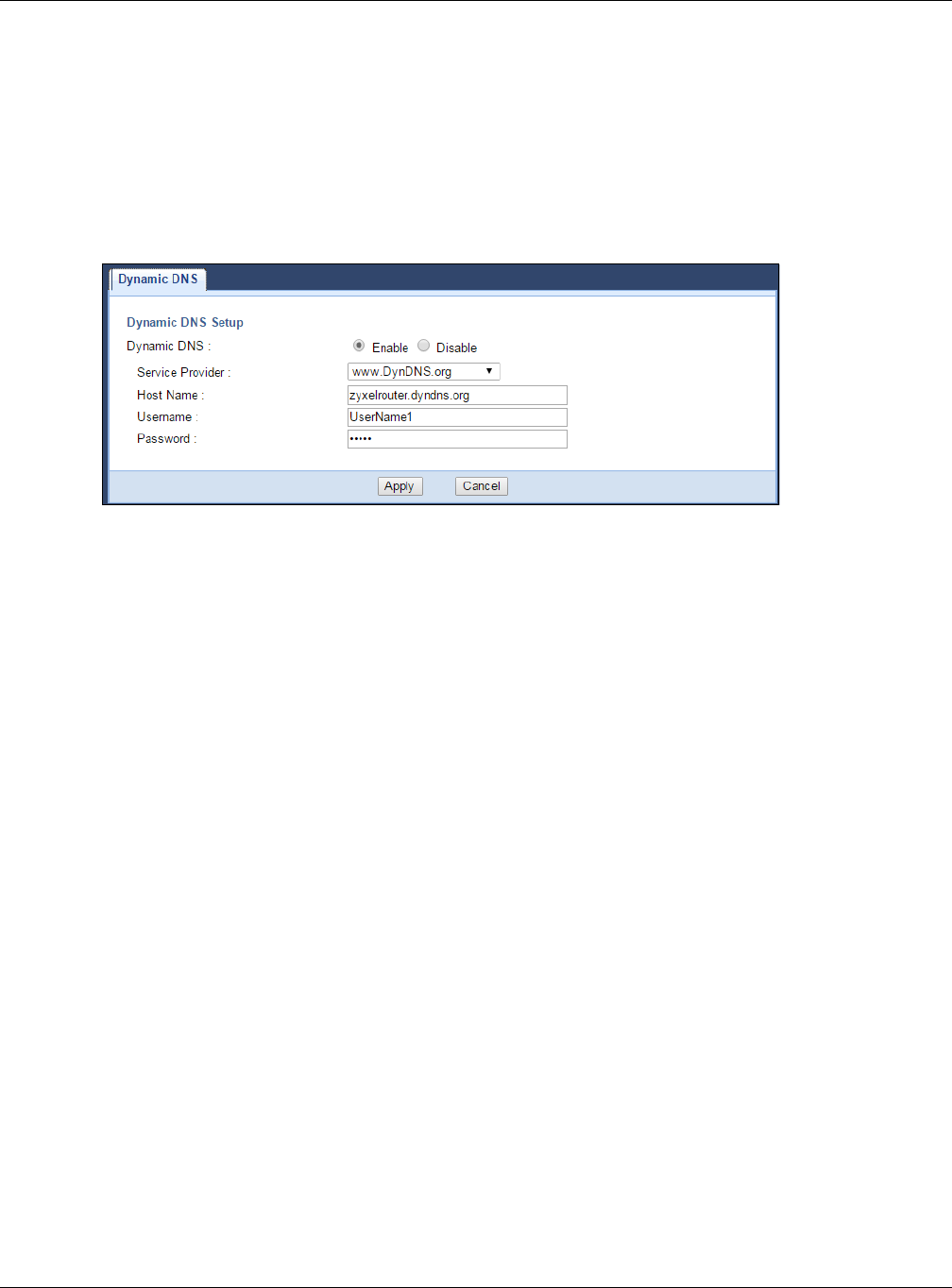
Chapter 6 Tutorials
EMG6765-Q10A User’s Guide
47
6.6.2 Configuring DDNS on Your EMG6765-Q10A
Configure the following settings in the Network Setting > DNS > Dynamic DNS screen.
•Select Enable Dynamic DNS.
•Select www.DynDNS.com as the service provider.
•Type zyxelrouter.dyndns.org in the Host Name field.
• Enter the user name (UserName1) and password (5).
Click Apply.
6.6.3 Testing the DDNS Setting
Now you should be able to access the EMG6765-Q10A from the Internet. To test this:
1Open a web browser on the computer (using the IP address a.b.c.d) that is connected to the Internet.
2Type http://zyxelrouter.dyndns.org and press [Enter].
3The EMG6765-Q10A’s login page should appear. You can then log into the EMG6765-Q10A and
manage it.
6.7 Configuring the MAC Address Filter
Thomas noticed that his daughter Josephine spends too much time surfing the web and downloading
media files. He decided to prevent Josephine from accessing the Internet so that she can concentrate
on preparing for her final exams.
Josephine’s computer connects wirelessly to the Internet through the EMG6765-Q10A. Thomas decides
to use the Configuration > Network > Wireless LAN 2.4G or 5G > MAC Filter screen to grant wireless
network access to his computer but not to Josephine’s computer.
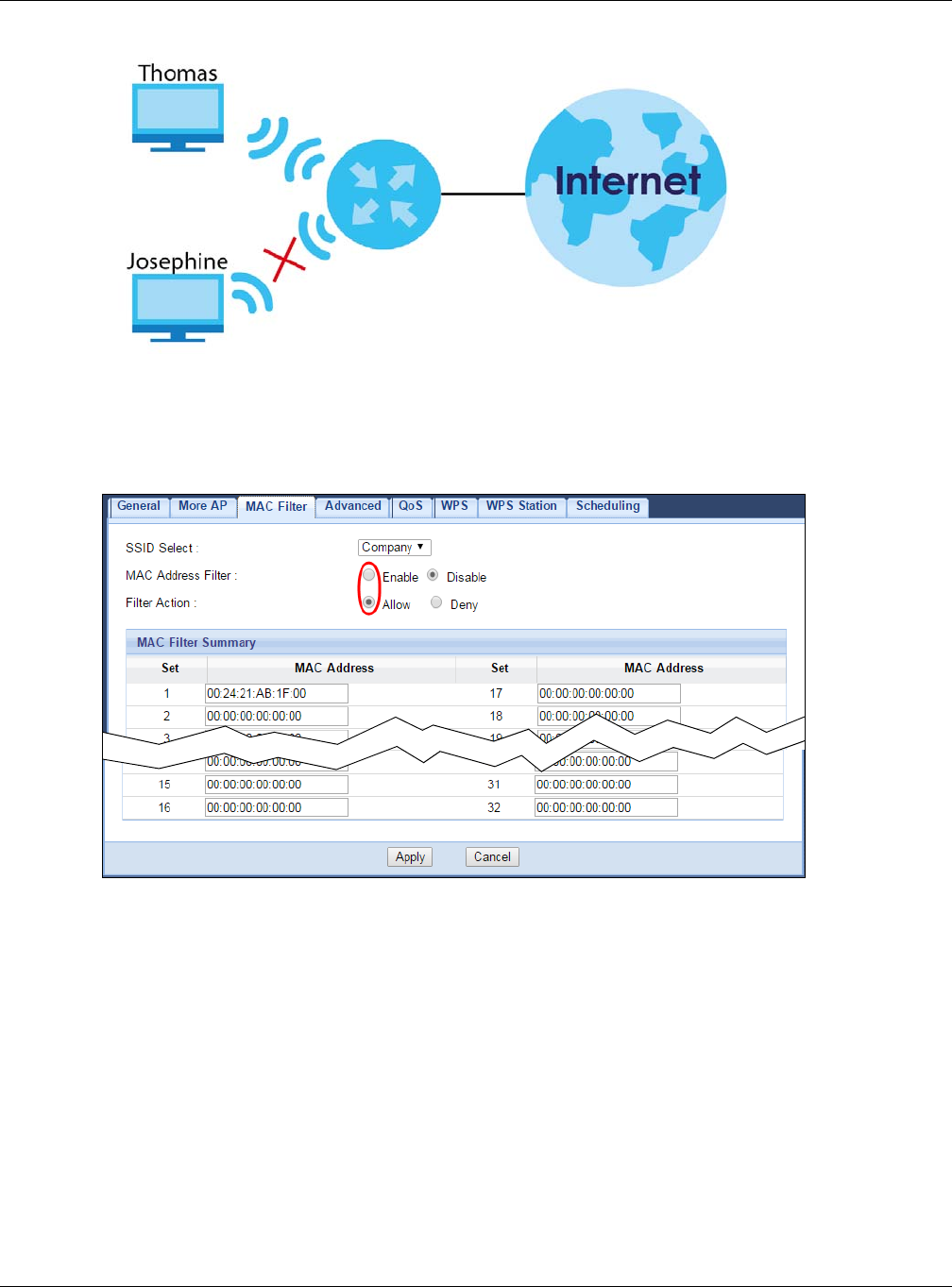
Chapter 6 Tutorials
EMG6765-Q10A User’s Guide
48
1Click Configuration > Network > Wireless LAN 2.4G or 5G to open the MAC Filter screen. Select the
Enable check box to activate MAC Address Filter.
2Select Allow. Then enter the MAC address of Thomas’ computer in this screen. Click Apply.
Thomas can also grant access to the computers of other members of his family and friends. However,
Josephine and others not listed in this screen will no longer be able to access the Internet through the
EMG6765-Q10A.
6.8 Using Multiple SSIDs on the EMG6765-Q10A
You can configure more than one SSID on a EMG6765-Q10A. See Section 9.4 on page 81.
This allows you to configure multiple independent wireless networks on the EMG6765-Q10A as if there
were multiple APs (virtual APs). Each virtual AP has its own SSID, wireless security type and MAC filtering
settings. That is, each SSID on the EMG6765-Q10A represents a different access point/wireless network to
wireless clients in the network.
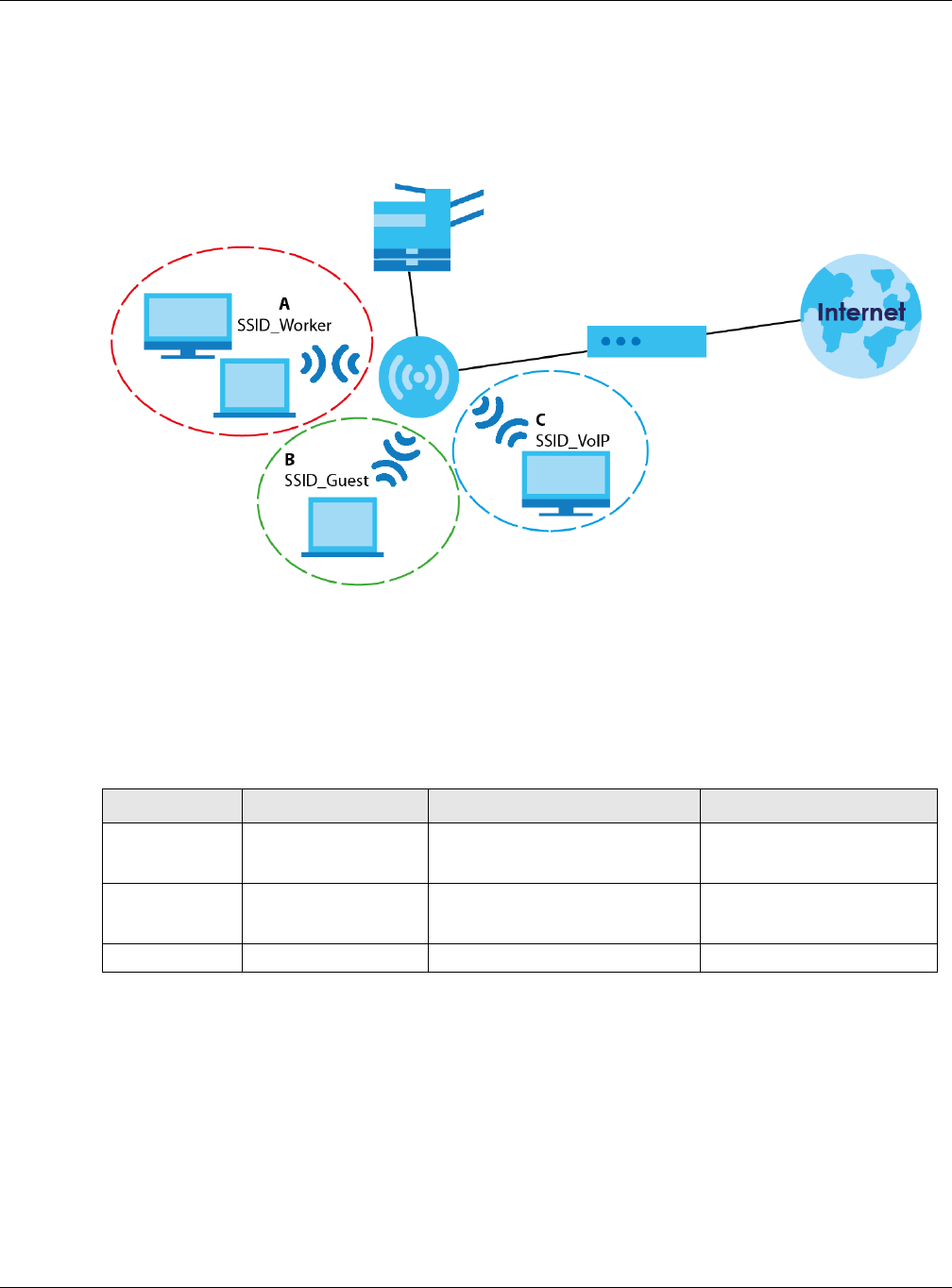
Chapter 6 Tutorials
EMG6765-Q10A User’s Guide
49
Clients can associate only with the SSIDs for which they have the correct security settings. Clients using
different SSIDs can access the Internet and the wired network behind the EMG6765-Q10A (such as a
printer).
For example, you may set up three wireless networks (A, B and C) in your office. A is for workers, B is for
guests and C is specific to a VoIP device in the meeting room.
6.8.1 Configuring Security Settings of Multiple SSIDs
The EMG6765-Q10A is in router mode by default.
This example shows you how to configure the SSIDs with the following parameters on your EMG6765-
Q10A (in router mode).
1Connect your computer to the LAN port of the EMG6765-Q10A using an Ethernet cable.
2The default IP address of the EMG6765-Q10A in router mode is “192.168.1.1”. In this case, your computer
must have an IP address in the range between “192.168.1.2” and “192.168.1.254”.
3Click Start > Run on your computer in Windows. Type “cmd” in the dialog box. Enter “ipconfig” to show
your computer’s IP address. If your computer’s IP address is not in the correct range then see Appendix
B on page 200 for information on changing your computer’s IP address.
4After you’ve set your computer’s IP address, open a web browser such as Internet Explorer and type
“http://192.168.1.1” as the web address in your web browser.
SSID SECURITY TYPE KEY MAC FILTERING
SSID_Worker WPA2-PSK
WPA Compatible
DoNotStealMyWirelessNetwork Disable
SSID_VoIP WPA2-PSK VoIPOnly12345678 Allow
00:A0:C5:01:23:45
SSID_Guest WPA2-PSK keyexample123 Disable
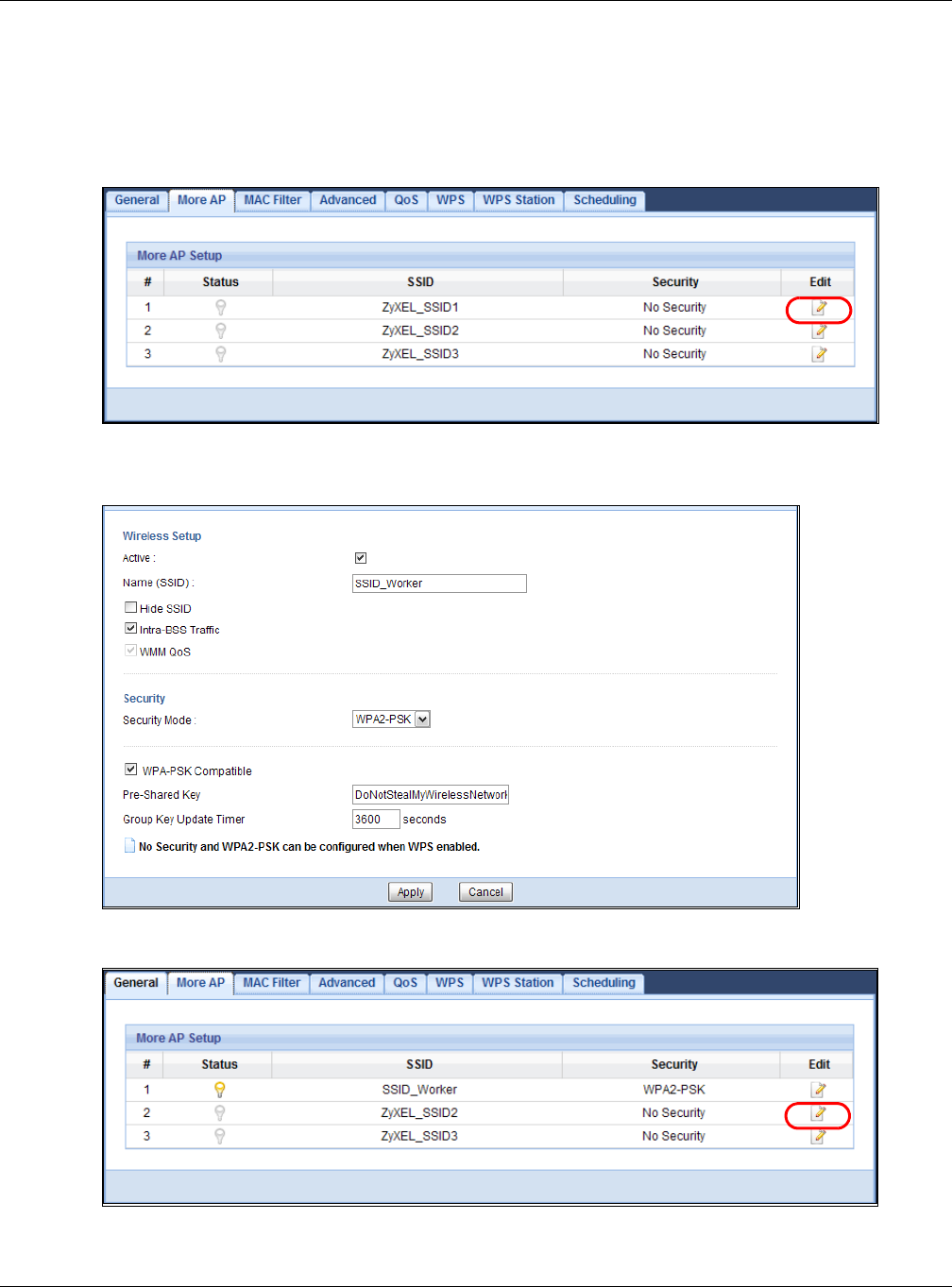
Chapter 6 Tutorials
EMG6765-Q10A User’s Guide
50
5Enter the back-label default key as the password and click Login.
6Type a new password and retype it to confirm, then click Apply. Otherwise, click Ignore.
7Go to Configuration > Network > Wireless LAN 2.4G > More AP. Click the Edit icon of the first entry to
configure wireless and security settings for SSID_Worker.
8Configure the screen as follows. In this example, you enable Intra-BSS Traffic for SSID_Worker to allow
wireless clients in the same wireless network to communicate with each other. Click Apply.
9Click the Edit icon of the second entry to configure wireless and security settings for SSID_VoIP.
10 Configure the screen as follows. You do not enable Intra-BSS Traffic for SSID_VoIP. Click Apply.
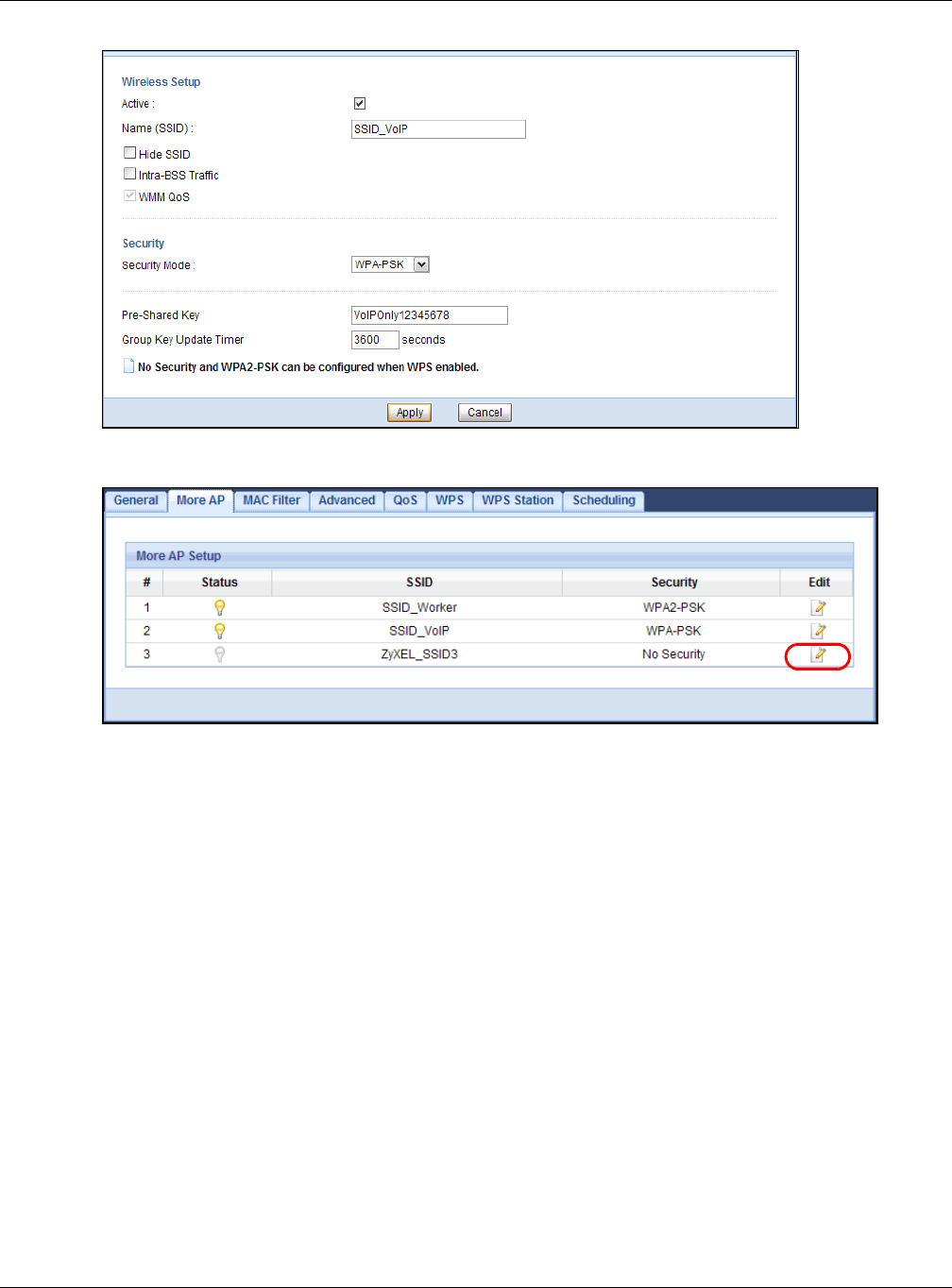
Chapter 6 Tutorials
EMG6765-Q10A User’s Guide
51
11 Click the Edit icon of the third entry to configure wireless and security settings for SSID_Guest.
12 Configure the screen as follows. In this example, you enable Intra-BSS Traffic for SSID_Guest to allow
wireless clients in the same wireless network to communicate with each other. Select Enable Guest
WLAN to allow clients to access the Internet only. Click Apply.
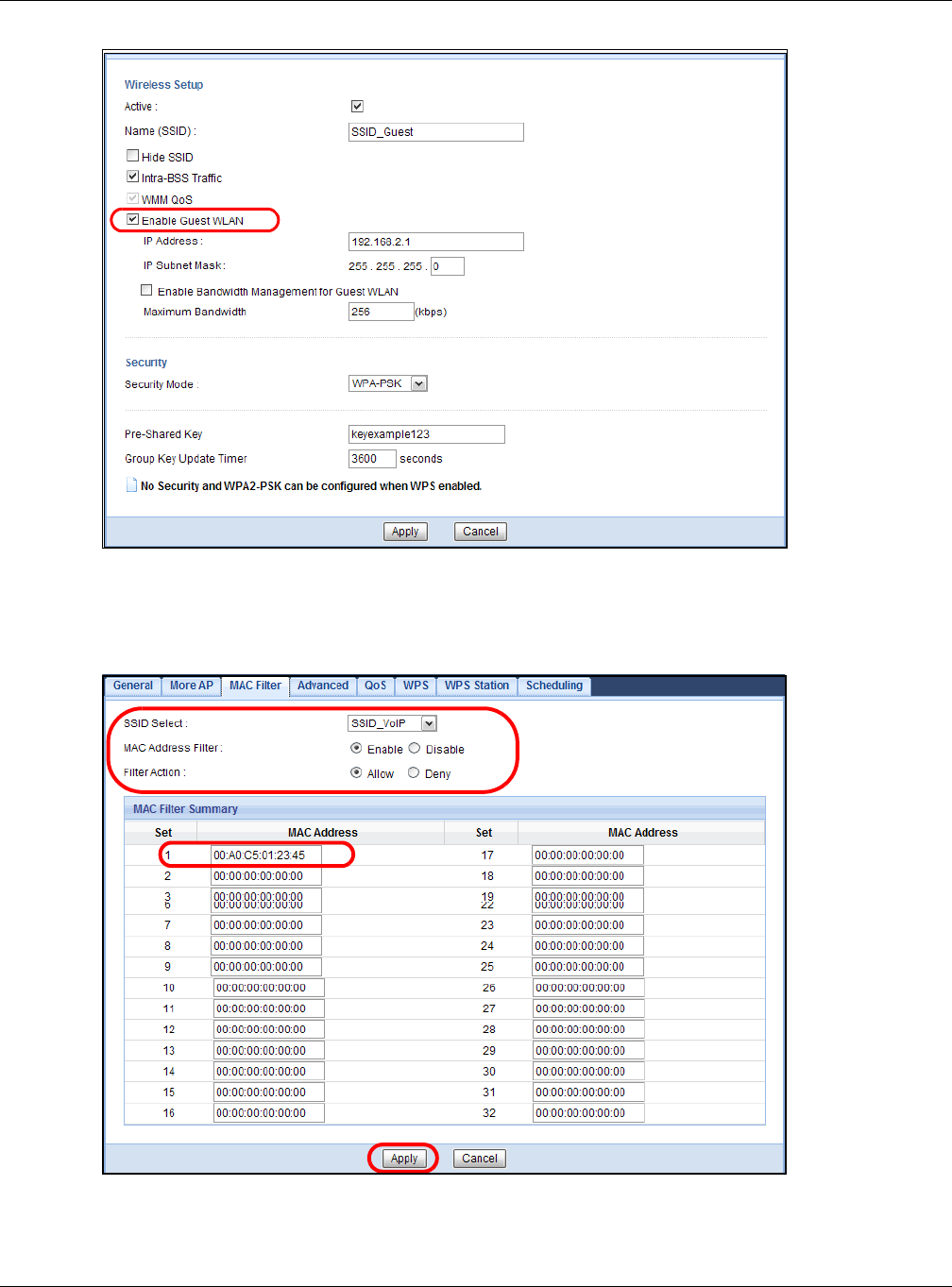
Chapter 6 Tutorials
EMG6765-Q10A User’s Guide
52
13 Click the MAC Filter tab to configure MAC filtering for the SSID_VoIP wireless network. Select SSID_VoIP
from the SSID Select drop-down list, enable MAC address filtering and set the Filter Action to Allow. Enter
the VoIP device’s MAC address in the Mac Address field and click Apply to allow only the VoIP device
to associate with the EMG6765-Q10A using this SSID.

53
PART II
Technical Reference
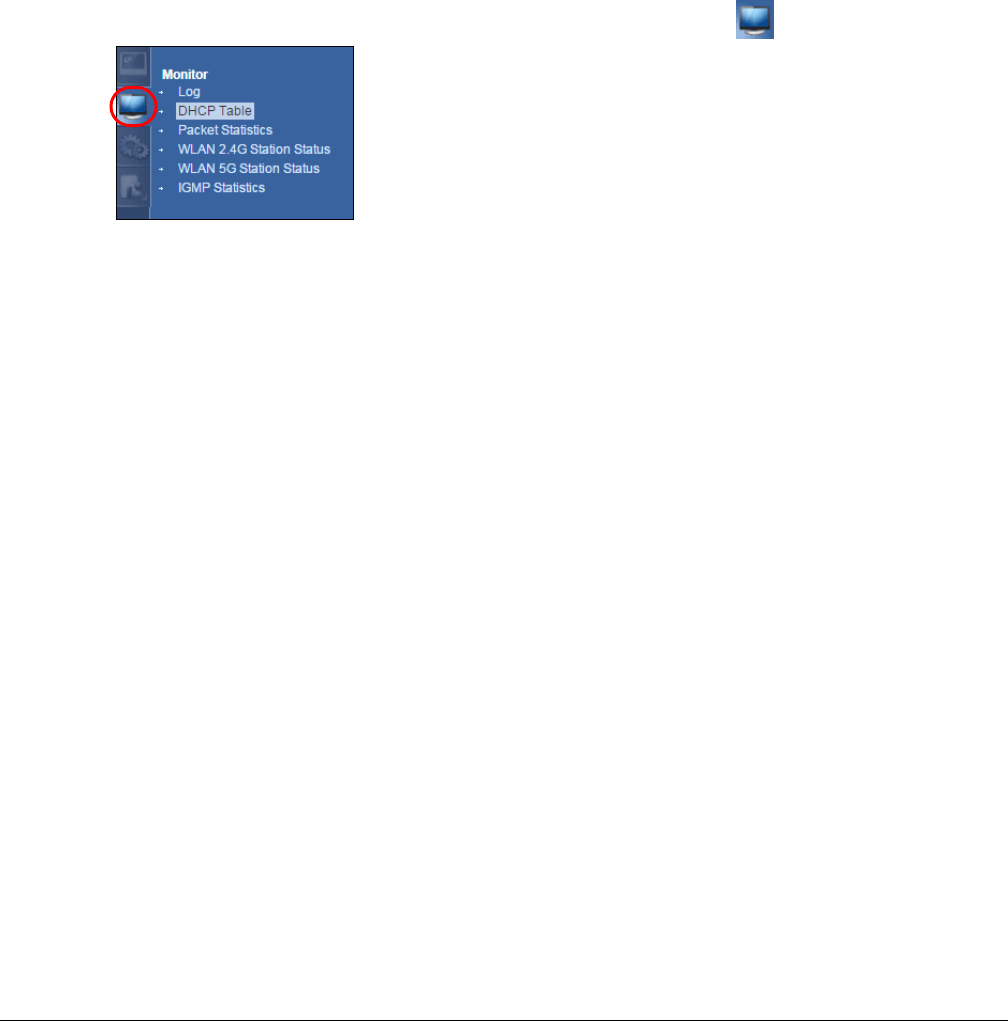
EMG6765-Q10A User’s Guide
54
CHAPTER 7
Monitor
7.1 Overview
This chapter discusses read-only information related to the device state of the EMG6765-Q10A.
To access the Monitor screens, go to Expert Mode after login, then click .
You can also click the links in the Summary table of the Status screen to view the packets sent/received
as well as the status of clients connected to the EMG6765-Q10A.
7.2 What You Can Do
• Use the Log screen to see the logs for the activity on the EMG6765-Q10A (Section 7.3 on page 54).
• Use the DHCP Table screen to view information related to your DHCP status (Section 7.4 on page 56).
•use the Packet Statistics screen to view port status, packet specific statistics, the “system up time” and
so on (Section 7.5 on page 56).
• Use the WLAN 2.4G/5G Station Status screen to view the wireless stations that are currently associated
to the EMG6765-Q10A (Section 7.6 on page 57).
• Use the IGMP Statistics screen (Section 7.7 on page 58) to view multicasting details.
7.3 The Log Screen
The Web Configurator allows you to look at all of the EMG6765-Q10A’s logs in one location.
7.3.1 View Log
Use the View Log screen to see the logged messages for the EMG6765-Q10A. The log wraps around and
deletes the old entries after it fills. Select what logs you want to see from the Display drop list. The log
choices depend on your settings in the Log Setting screen. Click Refresh to renew the log screen. Click
Clear Log to delete all the logs Click Backup System Info to download a folder containing EMG6765-
Q10A current backup information.
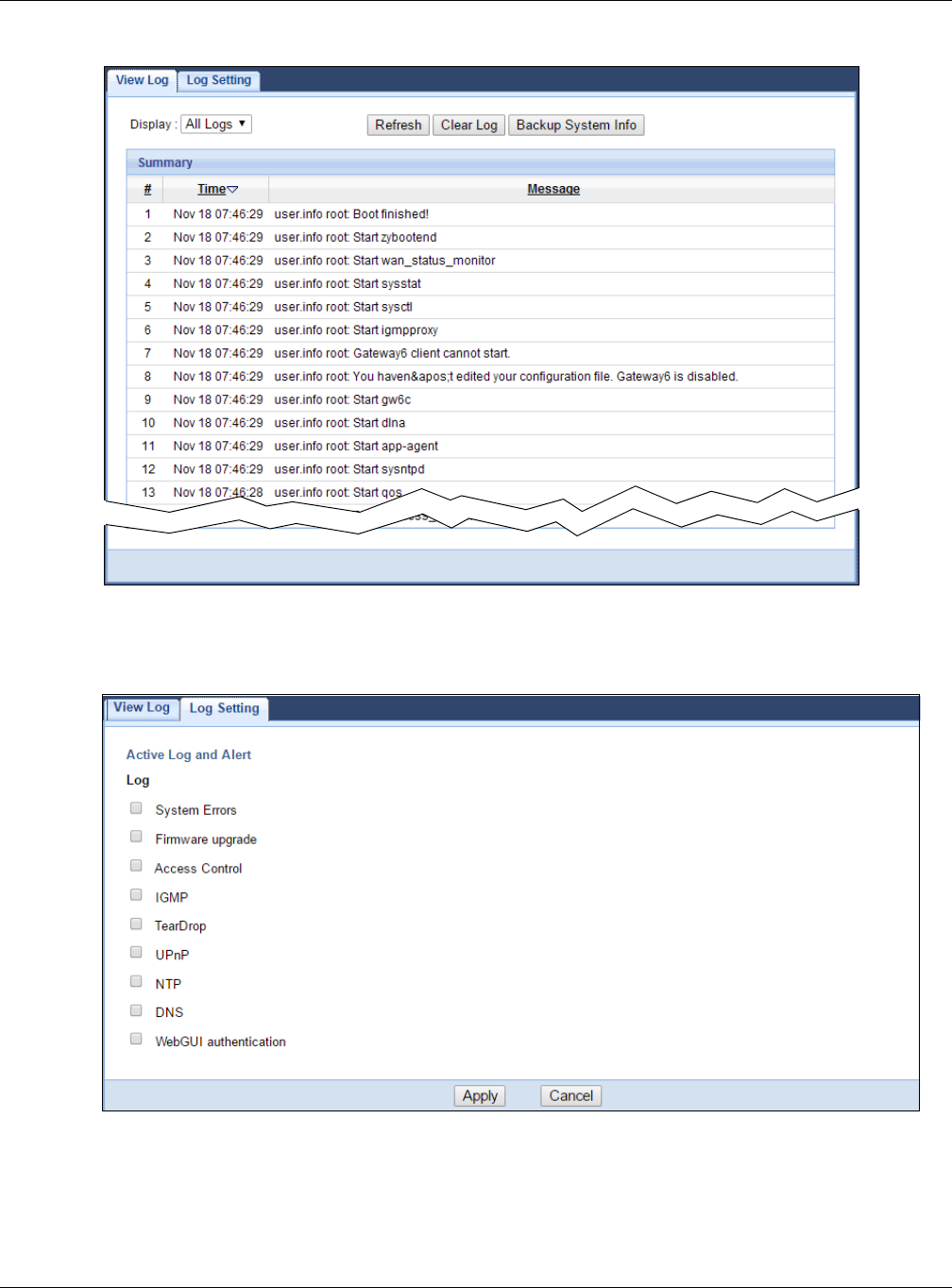
Chapter 7 Monitor
EMG6765-Q10A User’s Guide
55
Figure 18 View Log
You can configure which logs to display in the View Log screen. Go to the Log Setting screen and select
the logs you wish to display. Click Apply to save your settings. Click Cancel to start the screen afresh.
Figure 19 Log Settings
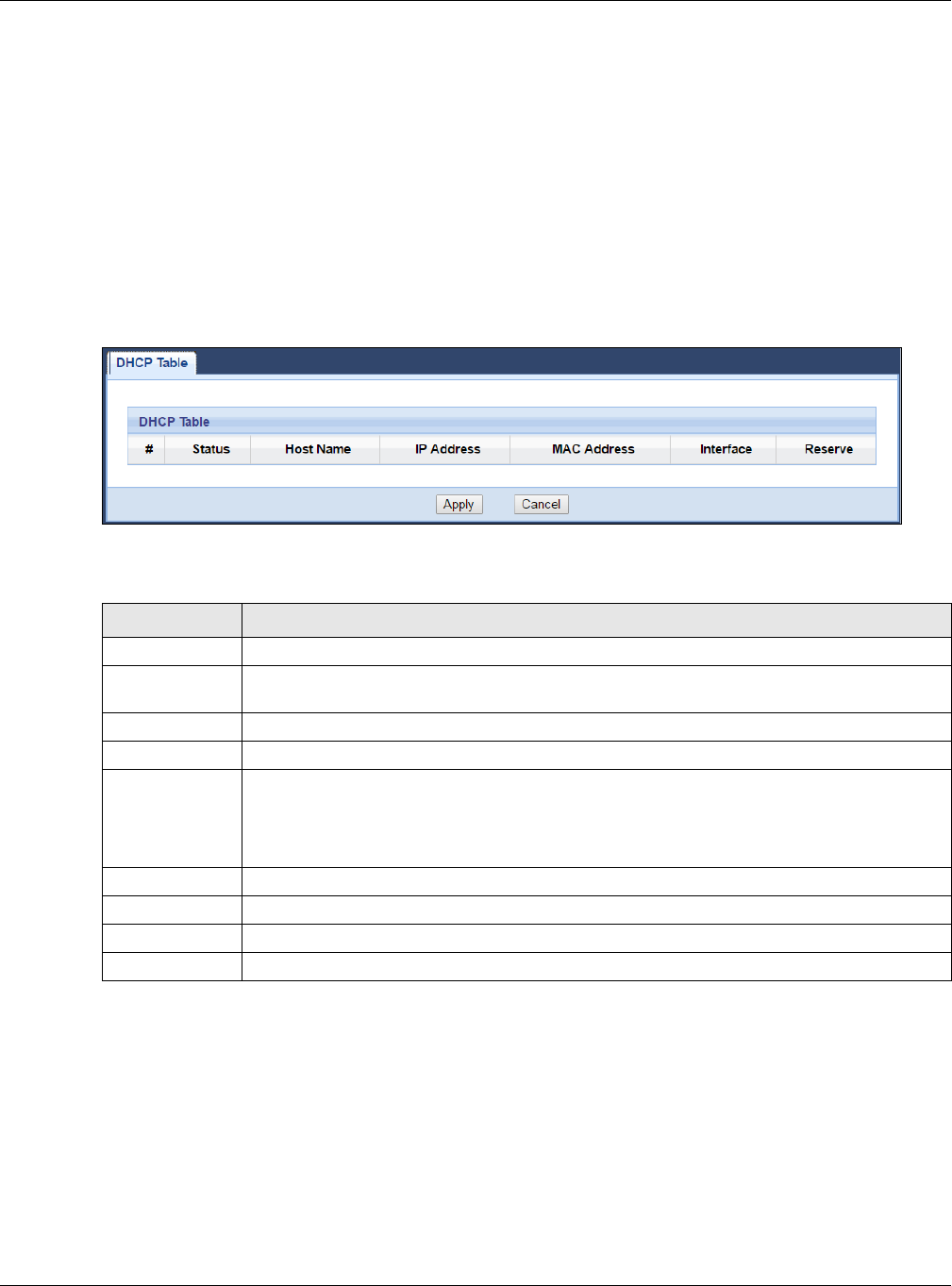
Chapter 7 Monitor
EMG6765-Q10A User’s Guide
56
7.4 DHCP Table
DHCP (Dynamic Host Configuration Protocol, RFC 2131 and RFC 2132) allows individual clients to obtain
TCP/IP configuration at start-up from a server. You can configure the EMG6765-Q10A’s LAN as a DHCP
server or disable it. When configured as a server, the EMG6765-Q10A provides the TCP/IP configuration
for the clients. If DHCP service is disabled, you must have another DHCP server on that network, or else
the computer must be manually configured.
Click Monitor > DHCP Table or Configuration > Network > DHCP Server > Client List. Read-only information
here relates to your DHCP status. The DHCP table shows current DHCP client information (including MAC
Address, and IP Address) of all network clients using the EMG6765-Q10A’s DHCP server.
Figure 20 Monitor > DHCP Table
The following table describes the labels in this screen.
7.5 Packet Statistics
Click Monitor > Packet Statistics or the Packet Statistics (Details...) hyperlink in the Status screen. Read-
only information here includes port status, packet specific statistics and the "system up time". The Poll
Interval(s) field is configurable and is used for refreshing the screen.
Table 11 Monitor > DHCP Table
LABEL DESCRIPTION
# This is the index number of the host computer.
Status This field displays whether the connection to the host computer is up (a yellow bulb) or down (a
gray bulb).
Host Name This field displays the computer host name.
IP Address This field displays the IP address relative to the # field listed above.
MAC Address This field shows the MAC address of the computer with the name in the Host Name field.
Every Ethernet device has a unique MAC (Media Access Control) address which uniquely
identifies a device. The MAC address is assigned at the factory and consists of six pairs of
hexadecimal characters, for example, 00:A0:C5:00:00:02.
Interface This field identifies the interface that assigned an IP address to a DHCP client.
Reserve Select this if you want to reserve the IP address for this specific MAC address.
Apply Click Apply to save your changes back to the EMG6765-Q10A.
Cancel Click Cancel to reload the previous configuration for this screen.
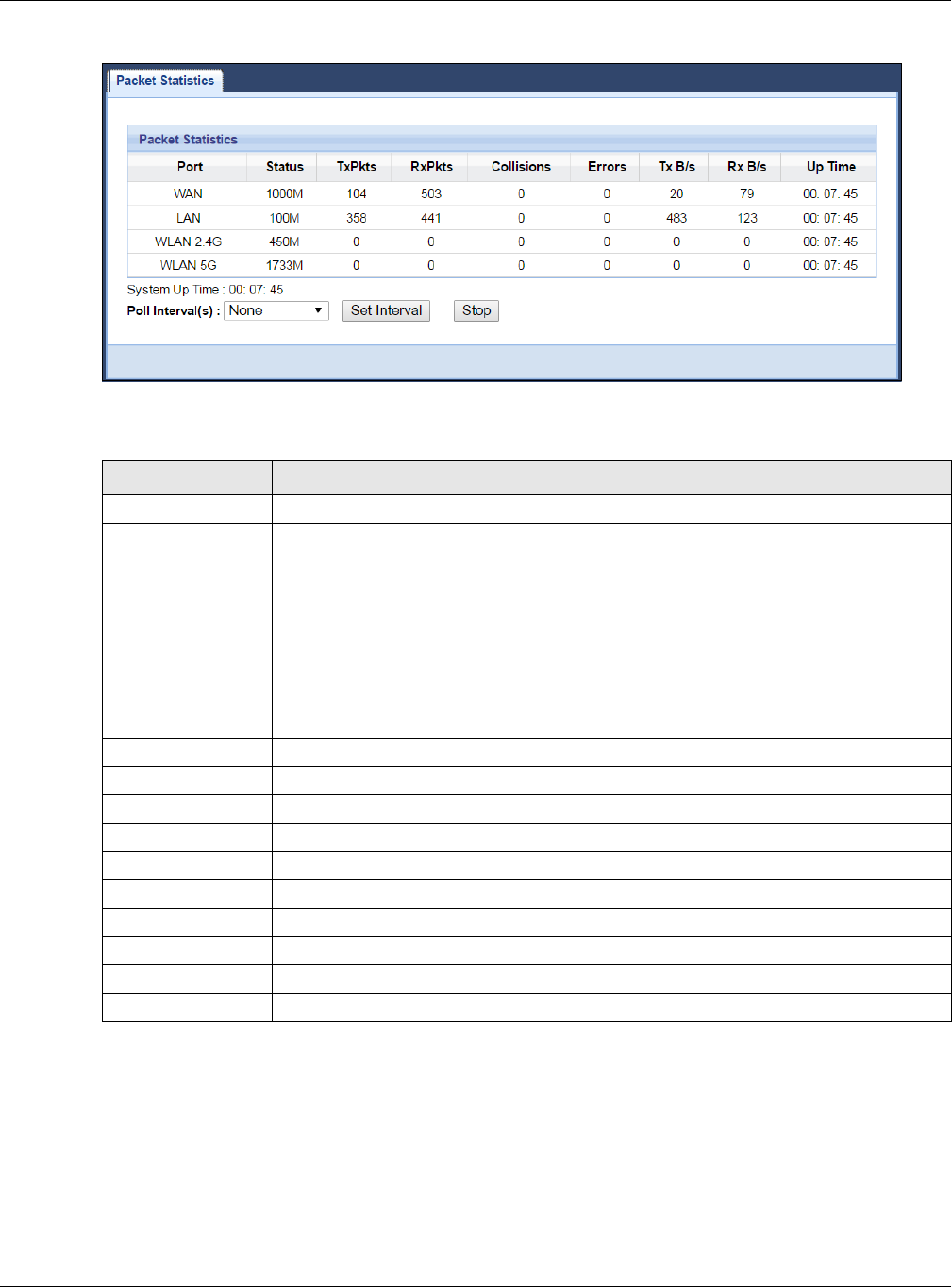
Chapter 7 Monitor
EMG6765-Q10A User’s Guide
57
Figure 21 Monitor > Packet Statistics
The following table describes the labels in this screen.
7.6 WLAN Station Status
Click Monitor > WLAN 2.4G/5G Station Status or the WLAN 2.4G/5G Station Status (Details...) hyperlink in
the Status screen. View the wireless stations that are currently associated to the EMG6765-Q10A’s 2.4GHz
or 5GHz wireless network in the Association List. Association means that a wireless client (for example,
your network or computer with a wireless network card) has connected successfully to the AP (or
wireless router) using the same SSID, channel and security settings.
Table 12 Monitor > Packet Statistics
LABEL DESCRIPTION
Port This is the EMG6765-Q10A’s interface type.
Status For the LAN ports, this displays the port speed and duplex setting or Down when the line is
disconnected.
For the WAN port, it displays the port speed and duplex setting if you’re using Ethernet
encapsulation and Idle (line (ppp) idle), Dial (starting to trigger a call) and Drop (dropping
a call) if you're using PPPoE encapsulation. This field displays Down when the line is
disconnected.
For the 2.4GHz or 5GHz WLAN, it displays the maximum transmission rate when the WLAN is
enabled and Down when the WLAN is disabled.
TxPkts This is the number of transmitted packets on this port.
RxPkts This is the number of received packets on this port.
Collisions This is the number of collisions on this port.
Errors This is the number of received errors on this port.
Tx B/s This displays the transmission speed in bytes per second on this port.
Rx B/s This displays the reception speed in bytes per second on this port.
Up Time This is the total time the EMG6765-Q10A has been for each session.
System Up Time This is the total time the EMG6765-Q10A has been on.
Poll Interval(s) Enter the time interval in seconds for refreshing statistics in this field.
Set Interval Click this button to apply the new poll interval you entered in the Poll Interval(s) field.
Stop Click Stop to stop refreshing statistics.
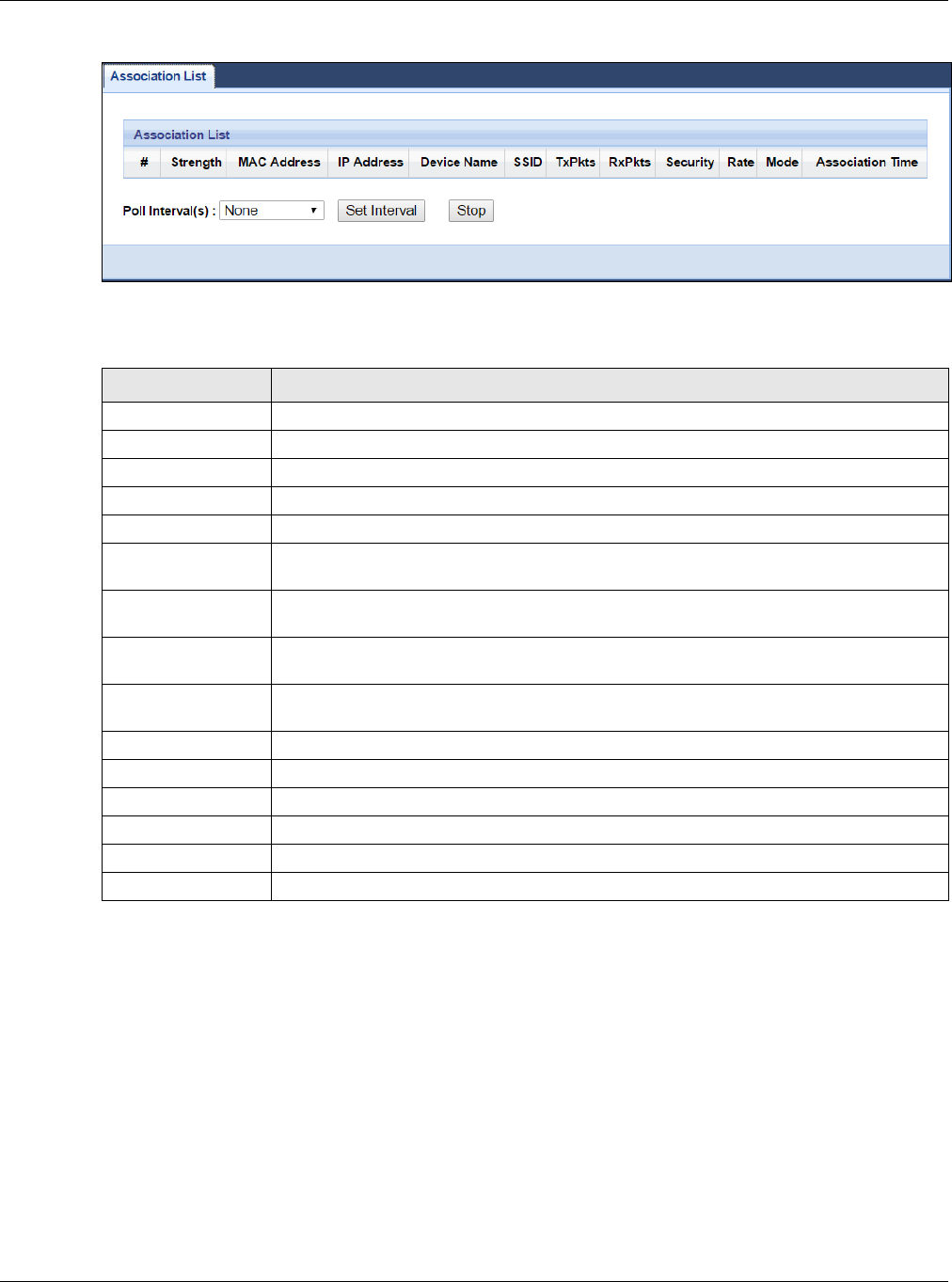
Chapter 7 Monitor
EMG6765-Q10A User’s Guide
58
Figure 22 Monitor > WLAN Station Status
The following table describes the labels in this screen.
7.7 IGMP Statistics
Use this screen to look at the current number of IGMP-related packets received for each IGMP multicast
group and from each LAN host. Click Monitor > IGMP Statistics to open the following screen.
Table 13 Monitor > WLAN Station Status
LABEL DESCRIPTION
# This is the index number of an associated wireless station.
Strength This field displays the station’s wireless connection signal strength.
MAC Address This field displays the MAC address of an associated wireless station.
IP Address This field displays the IP address of an associated wireless station.
Device Name This field displays the name of an associated wireless station.
SSID This field displays the name of the EMG6765-Q10A’s wireless network to which the station is
connected.
TxPkts This field displays the number of packets transmitted by the station through the wireless
connection.
RxPkts This field displays the number of packets received by the station through the wireless
connection.
Security This field displays which secure encryption method is being used by the station to connect
to the network.
Rate This field displays the wireless station’s transmission rate.
Mode This field displays the wireless standard supported by the wireless station.
Association Time This field displays the time a wireless station first associated with the EMG6765-Q10A’s WLAN.
Poll Interval(s) Enter the time interval in seconds for refreshing this screen in this field.
Set Interval Click this button to apply the new poll interval you entered in the Poll Interval(s) field.
Stop Click Stop to stop refreshing the screen.
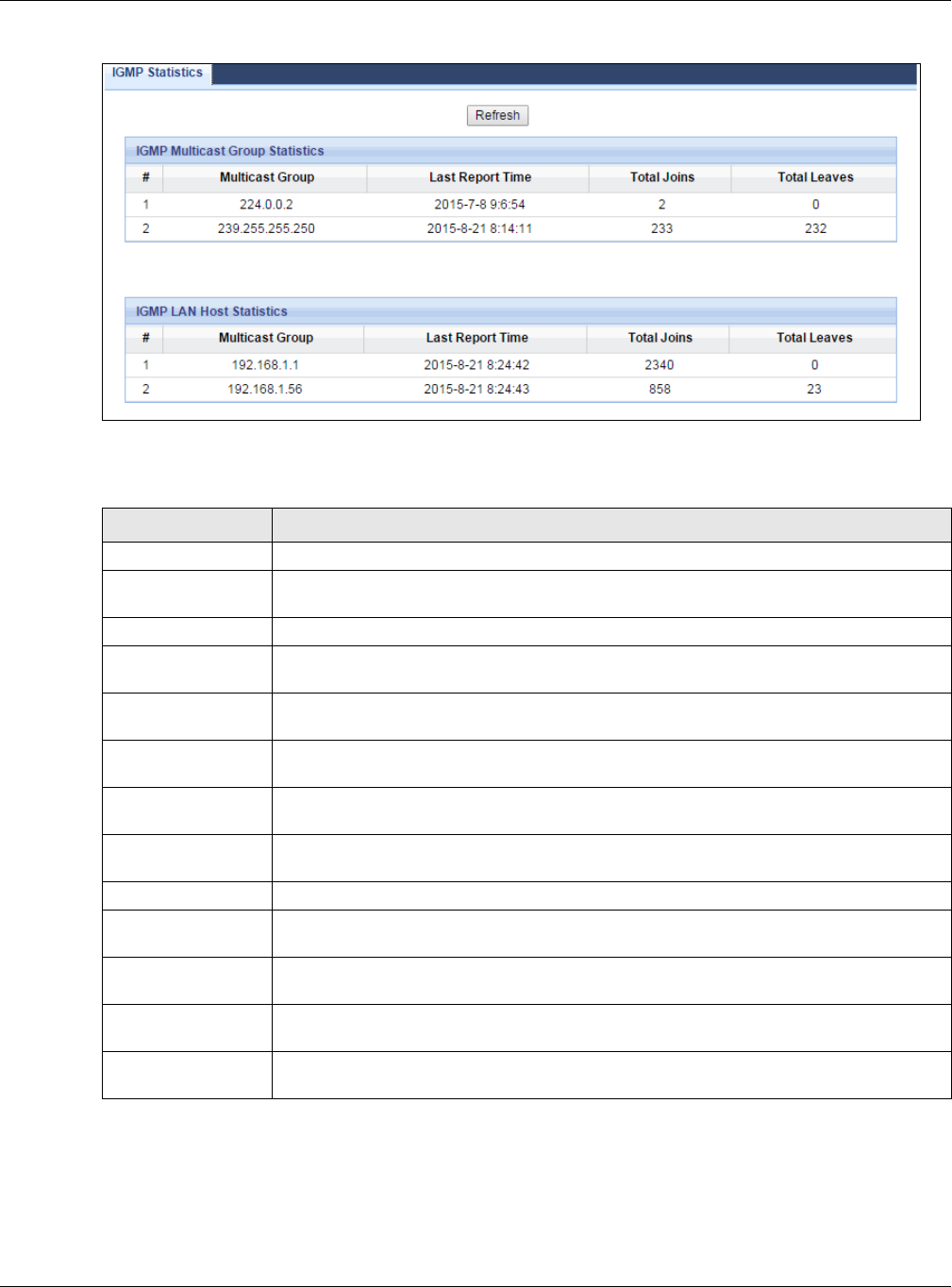
Chapter 7 Monitor
EMG6765-Q10A User’s Guide
59
Figure 23 Monitor > IGMP Statistics
The following table describes the labels in this screen.
Table 14 Monitor > IGMP Statistics
LABEL DESCRIPTION
Refresh Click this button to update the information in the screen.
IGMP Multicast
Group Statistics
This section shows statistics about the number of IGMP-related packets received for each
IGMP multicast group.
# This field is a sequential value, and it is not associated with a specific IGMP Statistics.
Multicast Group This field displays the IP address of the IGMP multicast group for which the EMG6765-Q10A
received IGMP-related packets.
Last Report Time This field displays when the EMG6765-Q10A received the latest packet for this IGMP
multicast group.
Total Joins This field displays the total number of Join packets the EMG6765-Q10A has received for this
IGMP multicast group.
Total Leaves This field displays the total number of Leave packets the EMG6765-Q10A has received for
this IGMP multicast group.
IGMP LAN Host
Statistics
This section shows statistics about the number of IGMP-related packets received from each
LAN host.
# This field is a sequential value, and it is not associated with a specific IGMP Statistics.
Multicast Group This field displays the IP address of a LAN computer that has sent the EMG6765-Q10A IGMP-
related packets.
Last Report Time This field displays when the EMG6765-Q10A received the latest packet from this LAN IP
address for this IGMP multicast group.
Total Joins This field displays the total number of Join packets the EMG6765-Q10A has received from
this LAN IP address.
Total Leaves This field displays the total number of Leave packets the EMG6765-Q10A has received from
this LAN IP address.
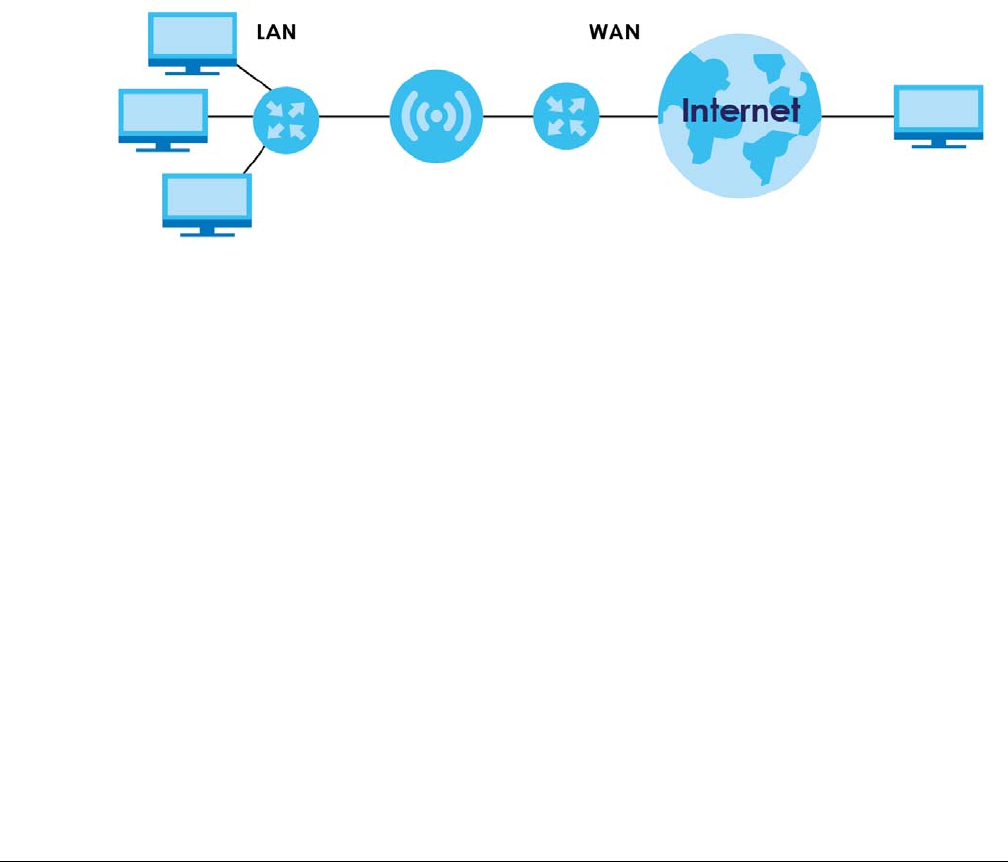
EMG6765-Q10A User’s Guide
60
CHAPTER 8
WAN
8.1 Overview
This chapter discusses the EMG6765-Q10A’s WAN screens. Use these screens to configure your EMG6765-
Q10A for Internet access.
A WAN (Wide Area Network) connection is an outside connection to another network or the Internet. It
connects your private networks such as a LAN (Local Area Network) and other networks, so that a
computer in one location can communicate with computers in other locations.
Figure 24 LAN and WAN
8.2 What You Can Do
• Use the Internet Connection screen to enter your ISP information and set how the computer acquires
its IP, DNS and WAN MAC addresses (Section 8.4 on page 62).
8.3 What You Need To Know
The information in this section can help you configure the screens for your WAN connection, as well as
enable/disable some advanced features of your EMG6765-Q10A.
8.3.1 Configuring Your Internet Connection
Encapsulation Method
Encapsulation is used to include data from an upper layer protocol into a lower layer protocol. To set up
a WAN connection to the Internet, you need to use the same encapsulation method used by your ISP
(Internet Service Provider). If your ISP offers a dial-up Internet connection using PPPoE (PPP over

Chapter 8 WAN
EMG6765-Q10A User’s Guide
61
Ethernet) or PPTP (Point-to-Point Tunneling Protocol), they should also provide a username and password
(and service name) for user authentication.
WAN IP Address
The WAN IP address is an IP address for the EMG6765-Q10A, which makes it accessible from an outside
network. It is used by the EMG6765-Q10A to communicate with other devices in other networks. It can
be static (fixed) or dynamically assigned by the ISP each time the EMG6765-Q10A tries to access the
Internet.
If your ISP assigns you a static WAN IP address, they should also assign you the subnet mask and DNS
server IP address(es) (and a gateway IP address if you use the Ethernet or ENET ENCAP encapsulation
method).
DNS Server Address Assignment
Use Domain Name System (DNS) to map a domain name to its corresponding IP address and vice versa,
for instance, the IP address of www.zyxel.com is 204.217.0.2. The DNS server is extremely important
because without it, you must know the IP address of a computer before you can access it.
The EMG6765-Q10A can get the DNS server addresses in the following ways.
1The ISP tells you the DNS server addresses, usually in the form of an information sheet, when you sign up.
If your ISP gives you DNS server addresses, manually enter them in the DNS server fields.
2If your ISP dynamically assigns the DNS server IP addresses (along with the EMG6765-Q10A’s WAN IP
address), set the DNS server fields to get the DNS server address from the ISP.
WAN MAC Address
The MAC address screen allows users to configure the WAN port's MAC address by either using the
factory default or cloning the MAC address from a computer on your LAN. Choose Factory Default to
select the factory assigned default MAC Address.
Otherwise, click Clone the computer's MAC address - IP Address and enter the IP address of the
computer on the LAN whose MAC you are cloning. Once it is successfully configured, the address will be
copied to configuration file. It is recommended that you clone the MAC address prior to hooking up the
WAN Port.
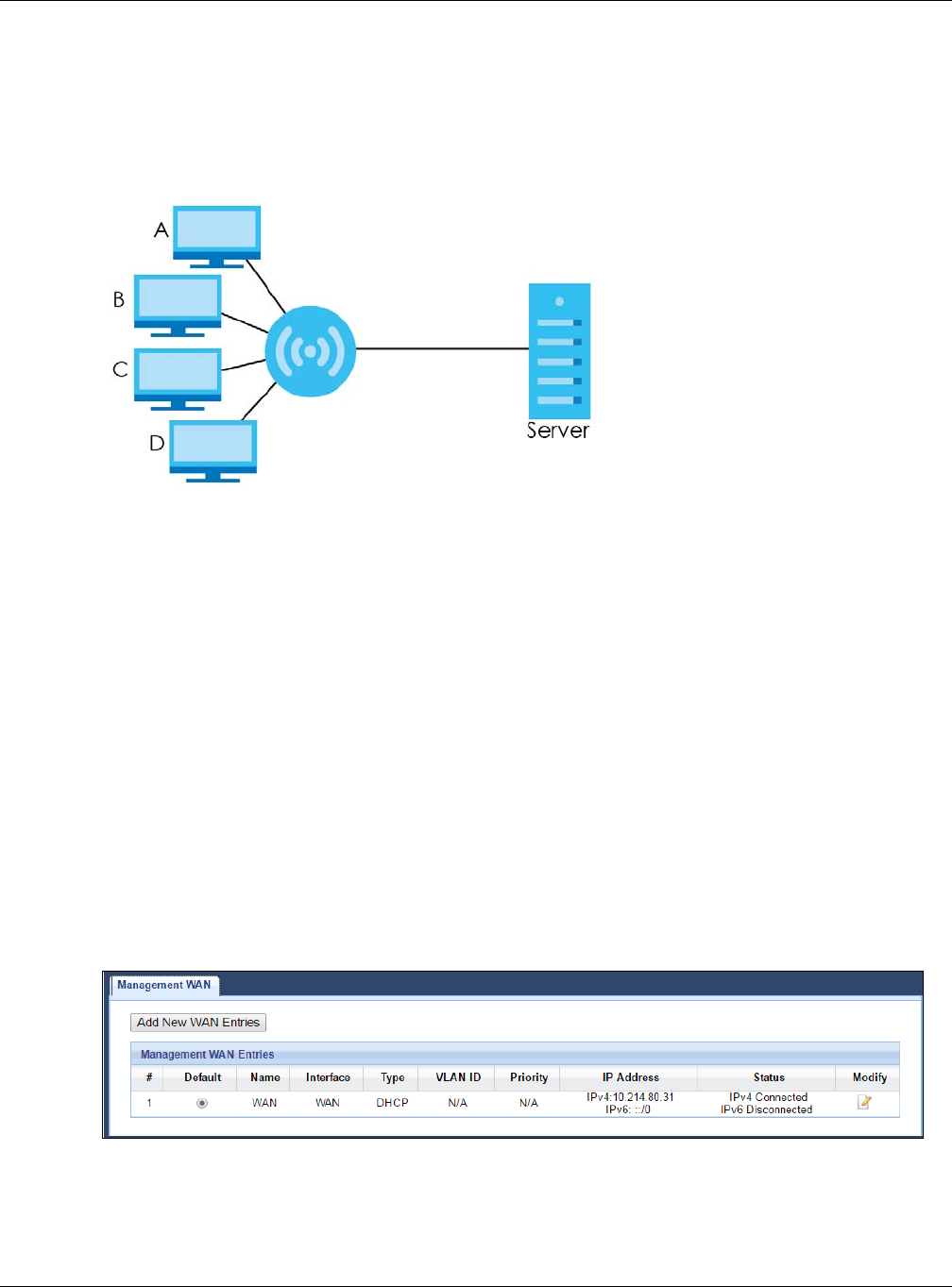
Chapter 8 WAN
EMG6765-Q10A User’s Guide
62
Multicast
Traditionally, IP packets are transmitted in one of either two ways - Unicast (1 sender - 1 recipient) or
Broadcast (1 sender - everybody on the network). Multicast delivers IP packets to a group of hosts on
the network - not everybody and not just 1.
Figure 25 Multicast Example
In the multicast example above, systems A and D comprise one multicast group. In multicasting, the
server only needs to send one data stream and this is delivered to systems A and D.
IGMP (Internet Group Multicast Protocol) is a network-layer protocol used to establish membership in a
multicast group - it is not used to carry user data. The EMG6765-Q10A supports both IGMP version 1
(IGMP-v1) and IGMP version 2 (IGMP-v2).
At start up, the EMG6765-Q10A queries all directly connected networks to gather group membership.
After that, the EMG6765-Q10A periodically updates this information. IP multicasting can be enabled/
disabled on the EMG6765-Q10A WAN interface in the Web Configurator (WAN). Select None to disable
IP multicasting on these interfaces.
8.4 Management WAN
Use this screen to view, change, or add your EMG6765-Q10A’s Internet access settings. Click
Configuration > Network > WAN. The following screen opens.
Figure 26 Network > WAN > Management WAN

Chapter 8 WAN
EMG6765-Q10A User’s Guide
63
The following table describes the labels in this screen.
8.4.1 Add/Edit WAN Connection
Click the Add New WAN Entries in the Configuration > WAN screen or the Edit icon next to the
connection you want to configure. Use this screen to configure a WAN connection. The screen varies
depending on the encapsulation you select.
8.4.1.1 IPoE Encapsulation
This screen displays when you select IPoE encapsulation.
Table 15 Network > WAN > Management WAN
LABEL DESCRIPTION
Add New WAN
Entries
Click this to create a new WAN interface entry.
Management WAN Entries
#This is the index number of the connection.
Default Select the WAN interface that you want to configure as default.
Name This is the service name of the connection.
Interface This is the interface of the connection.
Type This shows the type of interface used by this connection.
VLAN ID This indicates the VLAN ID number assigned to traffic sent through this connection.
Priority This indicates the 802.1p priority level assigned to traffic sent through this connection. This
displays N/A when there is no priority level assigned.
IP Address This is the WAN IP address used by this connection.
Status This shows the status of the connection.
Modify Click the Edit icon to configure the connection.
Click the Delete icon to delete this connection from the EMG6765-Q10A. A window displays
asking you to confirm that you want to delete the connection.
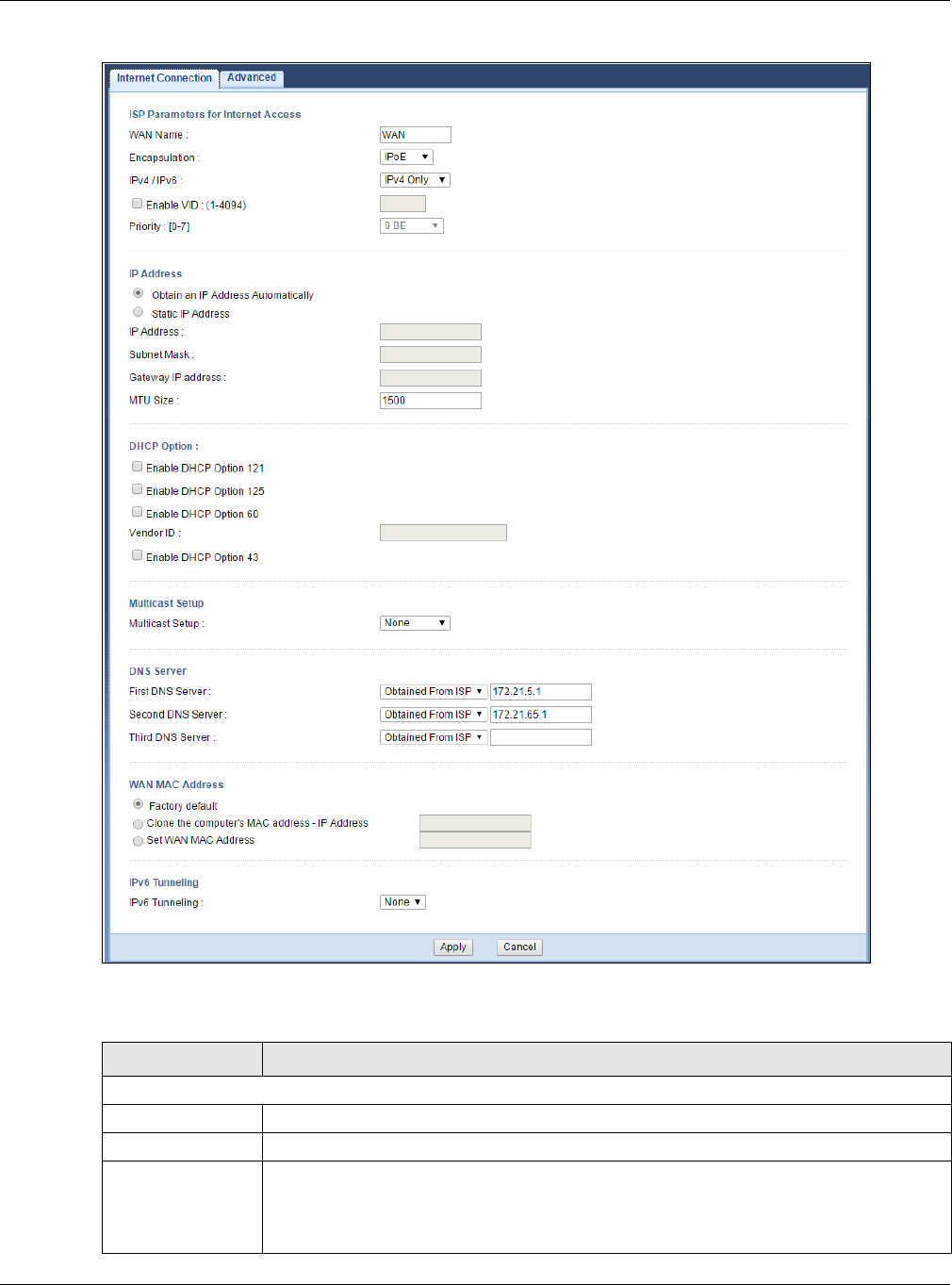
Chapter 8 WAN
EMG6765-Q10A User’s Guide
64
Figure 27 Network > WAN > Internet Connection: IPoE Encapsulation (IPv4 Only)
The following table describes the labels in this screen.
Table 16 Network > WAN > Internet Connection: IPoE Encapsulation
LABEL DESCRIPTION
ISP Parameters for Internet Access
WAN Name Enter the name to use for this connection definition.
Encapsulation You must choose the IPoE option when the WAN port is used as a regular Ethernet.
IPv4 / IPv6 Select IPv4 Only if you want the EMG6765-Q10A to run IPv4 only.
Select Dual Stack to allow the EMG6765-Q10A to run IPv4 and IPv6 at the same time.
Select IPv6 Only if you want the EMG6765-Q10A to run IPv6 only.

Chapter 8 WAN
EMG6765-Q10A User’s Guide
65
Enable VID Enter a VLAN identifier between 11 to 4094 (the 802.1Q tag specifies only a priority and is
referred to as a priority tag).
VID 1 (the default VLAN ID) is reserved for a management VLAN.
Note: This field is not available when you are configuring the default WAN entry.
Priority Select the IEEE 802.1p priority level (from 0 to 7) to add to traffic through this connection. The
greater the number, the higher the priority level.
IP Address
This is not available when you select IPv6 Only in the IPv6/IPv4 field.
Obtain an IP
Address
Automatically
Select this option If your ISP did not assign you a fixed IP address. This is the default selection.
Static IP Address Select this option If the ISP assigned a fixed IP address.
IP Address Enter your WAN IP address in this field if you selected Static IP Address.
Subnet Mask Enter the Subnet Mask in this field.
Gateway IP
Address Enter a Gateway IP Address (if your ISP gave you one) in this field.
MTU Size Enter the MTU (Maximum Transmission Unit) size for each packet. If a larger packet arrives, the
EMG6765-Q10A divides it into smaller fragments.
DHCP Option
This is not available when you select IPv6 Only in the IPv6/IPv4 field.
Enable DHCP
Option 121
Select this to enable the classless route option 121.
Enable DHCP
Option 125
Select this to add vendor specific information to DHCP requests that the EMG6765-Q10A
sends to a DHCP server when getting a WAN IP address.
Enable DHCP
Option 60
Select this to identify the vendor and functionality of the EMG6765-Q10A in DHCP requests
that the EMG6765-Q10A sends to a DHCP server when getting a WAN IP address.
Vendor ID Enter the Vendor Class Identifier (Option 60), such as the type of hardware or firmware.
Enable DHCP
Option 43
Select this for clients and servers to exchange vendor specific information.
Multicast Setup Select IGMPv1/v2 to turn on IGMP (Internet Group Multicast Protocol). IGMP is a network-
layer protocol used to establish membership in a Multicast group - it is not used to carry user
data.
DNS Server
First DNS Server
Second DNS
Server
Third DNS Server
Select Obtained From ISP if your ISP dynamically assigns DNS server information (and the
EMG6765-Q10A's WAN IP address). The field to the right displays the (read-only) DNS server IP
address that the ISP assigns.
Select User-Defined if you have the IP address of a DNS server. Enter the DNS server's IP
address in the field to the right.
Select None if you do not want to configure DNS servers. If you do not configure a DNS server,
you must know the IP address of a computer in order to access it.
WAN MAC Address The MAC address section allows users to configure the WAN port's MAC address by using the
EMG6765-Q10A’s MAC address, copying the MAC address from a computer on your LAN or
manually entering a MAC address.
Factory default Select Factory default to use the factory assigned default MAC Address.
Table 16 Network > WAN > Internet Connection: IPoE Encapsulation (continued)
LABEL DESCRIPTION

Chapter 8 WAN
EMG6765-Q10A User’s Guide
66
Clone the
computer’s
MAC address -
IP Address
Select Clone the computer's MAC address - IP Address and enter the IP address of the
computer on the LAN whose MAC you are cloning.
Set WAN MAC
Address Select this option and enter the MAC address you want to use.
IPv6 Tunneling
The EMG6765-Q10A uses tunnel interfaces in Generic Routing Encapsulation (GRE), IPv6 in IPv4, and 6to4
tunnels. GRE tunnels encapsulate a wide variety of network layer protocol packet types inside IP tunnels. A GRE
tunnel serves as a virtual point-to-point link between the EMG6765-Q10A and another router over an IPv4
network.
IPv6 Tunneling Enable IPv6 Rapid Deployment (6rd) to tunnel IPv6 traffic from the local network through the
ISP’s IPv4 network. The EMG6765-Q10A generates a global IPv6 prefix from its IPv4 WAN
address and tunnels IPv6 traffic to the ISP’s Border Relay router to connect to the native IPv6
Internet. The local network can also use IPv4 services. The EMG6765-Q10A uses its configured
IPv4 WAN IP to route IPv4 traffic to the IPv4 Internet.
Enable 6to4 to enable IPv6 packets to cross IPv4 networks. the EMG6765-Q10A should get a
public IPv4 address for the WAN. The EMG6765-Q10A adds an IPv4 IP header to an IPv6
packet when transmitting the packet to the Internet. In reverse, the EMG6765-Q10A removes
the IPv4 header from an IPv6 packet when receiving it from the Internet.
Enable 6in4 if the EMG6765-Q10A has a public IPv4 IP address given from your ISP and you
want to transmit your Ipv6 packets to one and only one remote site whose LAN network is
also an IPv6 network.
This is available only when you select IPv4 Only in the IPv6/IPv4 field.
Automatically
configured by
DHCPC
Select this to have the EMG6765-Q10A detect the relay server’s IP address automatically
through DHCP.
Manually
Configured
Select this if you have the IPv4 address of the relay server.
Border Relay IPv4
Address
Specify the relay server’s IPv4 address.
Service Provider
IPv6 Prefix
Enter an IPv6 prefix for tunneling IPv6 traffic to the ISP’s Border Relay router and connecting to
the native IPv6 Internet.
Service Provider
IPv6 Prefix length
Enter the IPv6 prefix length.
An IPv6 prefix length specifies how many most significant bits (starting from the left) in the
address compose the network address.
IPv4 mask length Enter the subnet mask number (1~32) for the IPv4 network.
IPv6 Address This is not available when you select IPv4 Only in the IPv6/IPv4 field.
Obtain an IP
Address
Automatically
Select this if you want to obtain an IPv6 address from a DHCPv6 server.
Static IP Address Select this if you have a fixed IPv6 address assigned by your ISP.
IPv6 Address Enter the IPv6 address assigned by your ISP.
Prefix length Enter the address prefix length to specify how many most significant bits in an IPv6 address
compose the network address.
IPv6 Default
Gateway Enter the IP address of the next-hop gateway. The gateway is a router or switch on the same
segment as your EMG6765-Q10A's interface(s). The gateway helps forward packets to their
destinations.
Link Local Only Select this if you want the IPv6 address to be generated automatically by EMG6765-Q10A.
Table 16 Network > WAN > Internet Connection: IPoE Encapsulation (continued)
LABEL DESCRIPTION

Chapter 8 WAN
EMG6765-Q10A User’s Guide
67
8.4.1.2 PPPoE Encapsulation
The EMG6765-Q10A supports PPPoE (Point-to-Point Protocol over Ethernet). PPPoE is an IETF standard
(RFC 2516) specifying how a personal computer (PC) interacts with a broadband modem (DSL, cable,
wireless, etc.) connection. The PPP over Ethernet option is for a dial-up connection using PPPoE.
For the service provider, PPPoE offers an access and authentication method that works with existing
access control systems (for example Radius).
One of the benefits of PPPoE is the ability to let you access one of multiple network services, a function
known as dynamic service selection. This enables the service provider to easily create and offer new IP
services for individuals.
Operationally, PPPoE saves significant effort for both you and the ISP or carrier, as it requires no specific
configuration of the broadband modem at the customer site.
By implementing PPPoE directly on the EMG6765-Q10A (rather than individual computers), the
computers on the LAN do not need PPPoE software installed, since the EEMG6765-Q10A does that part
of the task. Furthermore, with NAT, all of the LANs’ computers will have access.
This screen displays when you select PPPoE encapsulation.
IPv6 DNS server
This is not available when you select IPv4 Only in the IPv6/IPv4 field.
Obtain IPv6 DNS
info Automatically
Select this to have the EMG6765-Q10A get the IPv6 DNS server addresses from the ISP
automatically.
Use the following
Static DNS IPv6
Address
Select this to have the EMG6765-Q10A use the IPv6 DNS server addresses you configure
manually.
IPv6 DNS Server Enter the IPv6 DNS server address assigned by the ISP.
Apply Click Apply to save your changes back to the EMG6765-Q10A.
Cancel Click Cancel to begin configuring this screen afresh.
Table 16 Network > WAN > Internet Connection: IPoE Encapsulation (continued)
LABEL DESCRIPTION
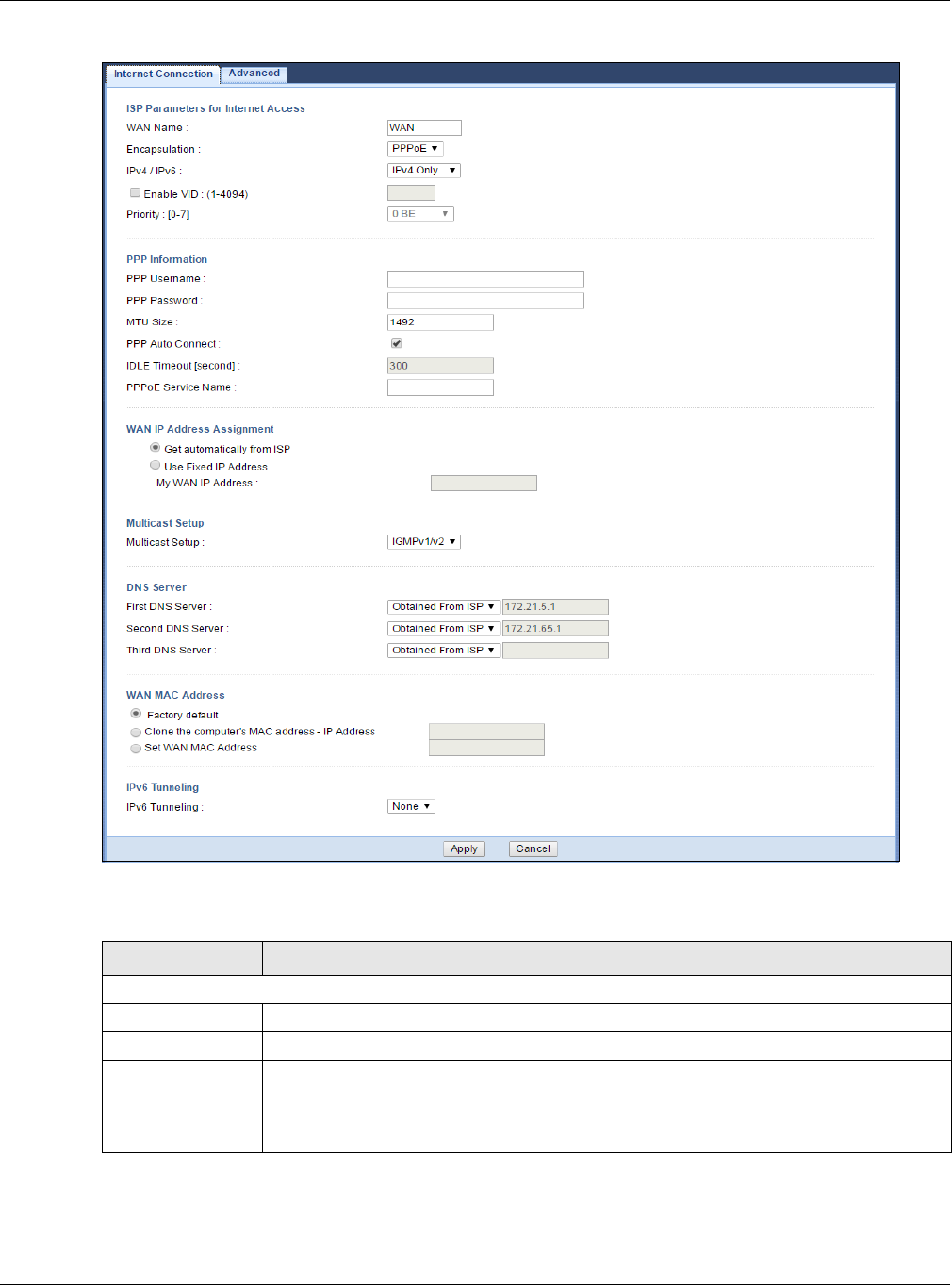
Chapter 8 WAN
EMG6765-Q10A User’s Guide
68
Figure 28 Network > WAN > Internet Connection: PPPoE Encapsulation (IPv4 Only)
The following table describes the labels in this screen.
Table 17 Network > WAN > Internet Connection: PPPoE Encapsulation
LABEL DESCRIPTION
ISP Parameters for Internet Access
WAN Name Enter the name to use for this connection definition.
Encapsulation You must choose the PPPoE option when the WAN port is used as a regular Ethernet.
IPv4 / IPv6 Select IPv4 Only if you want the EMG6765-Q10A to run IPv4 only.
Select Dual Stack to allow the EMG6765-Q10A to run IPv4 and IPv6 at the same time.
Select IPv6 Only if you want the EMG6765-Q10A to run IPv6 only.

Chapter 8 WAN
EMG6765-Q10A User’s Guide
69
Enable VID Enter a VLAN identifier between 11 to 4094 (the 802.1Q tag specifies only a priority and is
referred to as a priority tag).
VID 1 (the default VLAN ID) is reserved for a management VLAN.
Note: This field is not available when you are configuring the default WAN entry.
Priority Select the IEEE 802.1p priority level (from 0 to 7) to add to traffic through this connection. The
greater the number, the higher the priority level.
PPP Information
PPP Username Type the user name given to you by your ISP.
PPP Password Type the password associated with the user name above.
MTU Size Enter the Maximum Transmission Unit (MTU) or the largest packet size per frame that your
EMG6765-Q10A can receive and process.
PPP Auto Connect Select this option if you do not want the connection to time out.
Idle Timeout
(second)
This value specifies the time in minutes that elapses before the router automatically
disconnects from the PPPoE server.
PPPoE Service
Name
Enter the PPPoE service name specified in the ISP account.
WAN IP Address Assignment
Get automatically
from ISP
Select this option If your ISP did not assign you a fixed IP address. This is the default selection.
Use Fixed IP Address Select this option If the ISP assigned a fixed IP address.
My WAN IP
Address Enter your WAN IP address in this field if you selected Use Fixed IP Address.
Multicast Setup Select IGMPv1/v2 to turn on IGMP (Internet Group Multicast Protocol). IGMP is a network-
layer protocol used to establish membership in a Multicast group - it is not used to carry user
data.
DNS Server
First DNS Server
Second DNS
Server
Third DNS Server
Select Obtained From ISP if your ISP dynamically assigns DNS server information (and the
EMG6765-Q10A's WAN IP address). The field to the right displays the (read-only) DNS server IP
address that the ISP assigns.
Select User-Defined if you have the IP address of a DNS server. Enter the DNS server's IP
address in the field to the right.
Select None if you do not want to configure DNS servers. If you do not configure a DNS server,
you must know the IP address of a computer in order to access it.
WAN MAC Address The MAC address section allows users to configure the WAN port's MAC address by using the
EMG6765-Q10A’s MAC address, copying the MAC address from a computer on your LAN or
manually entering a MAC address.
Factory default Select Factory default to use the factory assigned default MAC Address.
Clone the
computer’s
MAC address -
IP Address
Select Clone the computer's MAC address - IP Address and enter the IP address of the
computer on the LAN whose MAC you are cloning.
Set WAN MAC
Address Select this option and enter the MAC address you want to use.
IPv6 Tunneling
The EMG6765-Q10A uses tunnel interfaces in Generic Routing Encapsulation (GRE), IPv6 in IPv4, and 6to4
tunnels. GRE tunnels encapsulate a wide variety of network layer protocol packet types inside IP tunnels. A GRE
tunnel serves as a virtual point-to-point link between the EMG6765-Q10A and another router over an IPv4
network.
Table 17 Network > WAN > Internet Connection: PPPoE Encapsulation (continued)
LABEL DESCRIPTION

Chapter 8 WAN
EMG6765-Q10A User’s Guide
70
8.4.1.3 Add/Edit WAN Connection > Advanced
Click the Add New WAN Entries in the Configuration > WAN screen or the Edit icon next to the
connection you want to configure. Then click the Advanced tab to view the following screen. Use this
screen to enable the Auto-IP Change Mode to have the EMG6765-Q10A change it LAN IP address to
10.0.0.1 or 192.168.1.1 accordingly when the EMG6765-Q10A gets a dynamic WAN IP address in the
same subnet as the LAN IP address 192.168.1.1 or 10.0.0.1.
IPv6 Tunneling Enable IPv6 Rapid Deployment (6rd) to tunnel IPv6 traffic from the local network through the
ISP’s IPv4 network. The EMG6765-Q10A generates a global IPv6 prefix from its IPv4 WAN
address and tunnels IPv6 traffic to the ISP’s Border Relay router to connect to the native IPv6
Internet. The local network can also use IPv4 services. The EMG6765-Q10A uses its configured
IPv4 WAN IP to route IPv4 traffic to the IPv4 Internet.
Enable 6to4 to enable IPv6 packets to cross IPv4 networks. the EMG6765-Q10A should get a
public IPv4 address for the WAN. The EMG6765-Q10A adds an IPv4 IP header to an IPv6
packet when transmitting the packet to the Internet. In reverse, the EMG6765-Q10A removes
the IPv4 header from an IPv6 packet when receiving it from the Internet.
Enable 6in4 if the EMG6765-Q10A has a public IPv4 IP address given from your ISP and you
want to transmit your Ipv6 packets to one and only one remote site whose LAN network is
also an IPv6 network.
This is available only when you select IPv4 Only in the IPv6/IPv4 field.
Manually
Configured
Select this if you have the IPv4 address of the relay server.
Border Relay IPv4
Address
Specify the relay server’s IPv4 address.
Service Provider
IPv6 Prefix
Enter an IPv6 prefix for tunneling IPv6 traffic to the ISP’s Border Relay router and connecting to
the native IPv6 Internet.
Service Provider
IPv6 Prefix length
Enter the IPv6 prefix length.
An IPv6 prefix length specifies how many most significant bits (starting from the left) in the
address compose the network address.
IPv4 mask length Enter the subnet mask number (1~32) for the IPv4 network.
IPv6 DNS server
This is not available when you select IPv4 Only in the IPv6/IPv4 field.
Obtain IPv6 DNS
info Automatically
Select this to have the EMG6765-Q10A get the IPv6 DNS server addresses from the ISP
automatically.
Use the following
Static DNS IPv6
Address
Select this to have the EMG6765-Q10A use the IPv6 DNS server addresses you configure
manually.
IPv6 DNS Server Enter the IPv6 DNS server address assigned by the ISP.
Apply Click Apply to save your changes back to the EMG6765-Q10A.
Cancel Click Cancel to begin configuring this screen afresh.
Table 17 Network > WAN > Internet Connection: PPPoE Encapsulation (continued)
LABEL DESCRIPTION

Chapter 8 WAN
EMG6765-Q10A User’s Guide
71
Figure 29 Add/Edit WAN Connection > Advanced
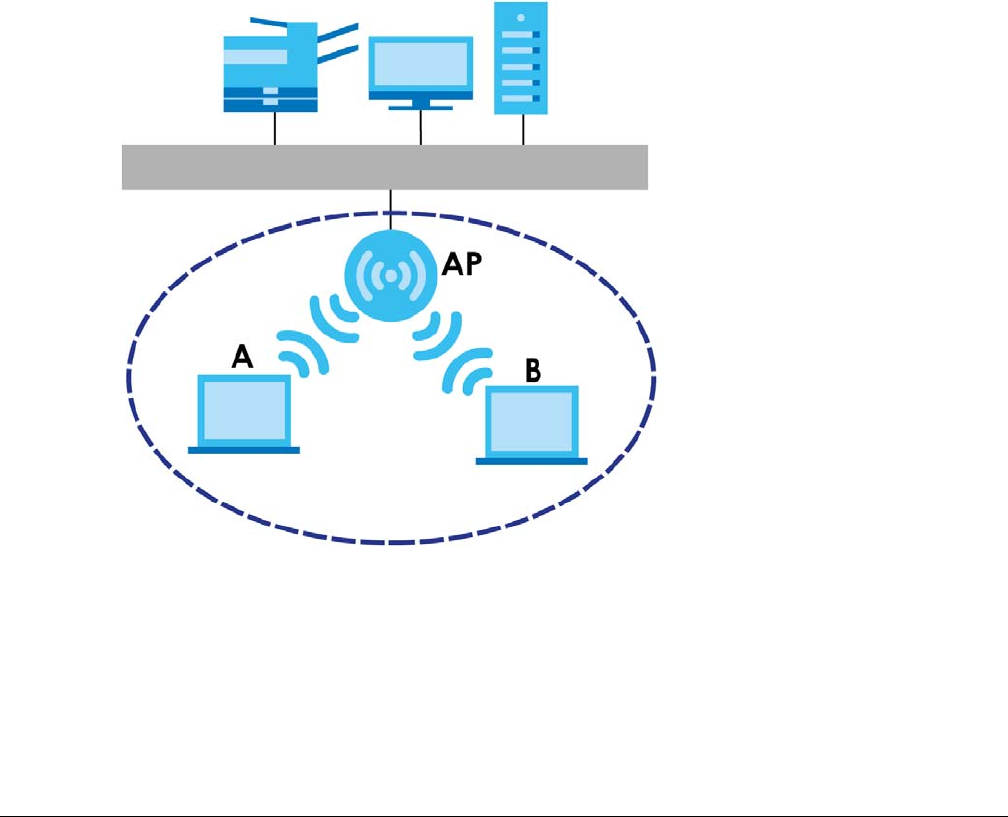
EMG6765-Q10A User’s Guide
72
CHAPTER 9
Wireless LAN
9.1 Overview
This chapter discusses how to configure the wireless network settings in your EMG6765-Q10A. The
EMG6765-Q10A is able to function both 2.4GHz and 5GHz network at the same time. You can have
different wireless and wireless security settings for 2.4GHz and 5GHz wireless LANs. Click Configuration >
Network > Wireless LAN 2.4G or Wireless LAN 5G to configure to do so.
See the appendices for more detailed information about wireless networks.
The following figure provides an example of a wireless network.
Figure 30 Example of a Wireless Network
The wireless network is the part in the blue circle. In this wireless network, devices A and B are called
wireless clients. The wireless clients use the access point (AP) to interact with other devices (such as the
printer) or with the Internet. Your EMG6765-Q10A is the AP.

Chapter 9 Wireless LAN
EMG6765-Q10A User’s Guide
73
9.1.1 What You Can Do
• Use the General screen to turn the wireless connection on or off, set up wireless security between the
EMG6765-Q10A and the wireless clients, and make other basic configuration changes (Section 9.2 on
page 76).
• Use the More AP screen to set up multiple wireless networks on your EMG6765-Q10A (Section 9.4 on
page 81).
• Use the MAC Filter screen to allow or deny wireless stations based on their MAC addresses from
connecting to the EMG6765-Q10A (Section 9.5 on page 84).
• Use the Advanced screen to allow intra-BSS networking and set the RTS/CTS Threshold (Section 9.6 on
page 86).
• Use the QoS screen to ensure Quality of Service (QoS) in your wireless network (Section 9.7 on page
87).
• Use the WPS screen to quickly set up a wireless network with strong security, without having to
configure security settings manually (Section 9.8 on page 87).
• Use the WPS Station screen to add a wireless station using WPS (Section 9.9 on page 89).
• Use the Scheduling screen to set the times your wireless LAN is turned on and off (Section 9.10 on
page 89).
• Use the Airtime Management screen to assign available airtime and bandwidth to interfaces and
hosts (Section 9.11 on page 90).
9.1.2 What You Should Know
Every wireless network must follow these basic guidelines.
• Every wireless client in the same wireless network must use the same SSID.
The SSID is the name of the wireless network. It stands for Service Set IDentity.
• If two wireless networks overlap, they should use different channels.
Like radio stations or television channels, each wireless network uses a specific channel, or frequency,
to send and receive information.
• Every wireless client in the same wireless network must use security compatible with the AP.
Security stops unauthorized devices from using the wireless network. It can also protect the
information that is sent in the wireless network.
Wireless Security Overview
The following sections introduce different types of wireless security you can set up in the wireless
network.
SSID
Normally, the AP acts like a beacon and regularly broadcasts the SSID in the area. You can hide the
SSID instead, in which case the AP does not broadcast the SSID. In addition, you should change the
default SSID to something that is difficult to guess.
This type of security is fairly weak, however, because there are ways for unauthorized devices to get the
SSID. In addition, unauthorized devices can still see the information that is sent in the wireless network.

Chapter 9 Wireless LAN
EMG6765-Q10A User’s Guide
74
MAC Address Filter
Every wireless client has a unique identification number, called a MAC address.1 A MAC address is
usually written using twelve hexadecimal characters2; for example, 00A0C5000002 or 00:A0:C5:00:00:02.
To get the MAC address for each wireless client, see the appropriate User’s Guide or other
documentation.
You can use the MAC address filter to tell the AP which wireless clients are allowed or not allowed to use
the wireless network. If a wireless client is allowed to use the wireless network, it still has to have the
correct settings (SSID, channel, and security). If a wireless client is not allowed to use the wireless
network, it does not matter if it has the correct settings.
This type of security does not protect the information that is sent in the wireless network. Furthermore,
there are ways for unauthorized devices to get the MAC address of an authorized wireless client. Then,
they can use that MAC address to use the wireless network.
User Authentication
You can make every user log in to the wireless network before they can use it. This is called user
authentication. However, every wireless client in the wireless network has to support IEEE 802.1x to do
this.
For wireless networks, there are two typical places to store the user names and passwords for each user.
• In the AP: this feature is called a local user database or a local database.
• In a RADIUS server: this is a server used in businesses more than in homes.
If your AP does not provide a local user database and if you do not have a RADIUS server, you cannot
set up user names and passwords for your users.
Unauthorized devices can still see the information that is sent in the wireless network, even if they cannot
use the wireless network. Furthermore, there are ways for unauthorized wireless users to get a valid user
name and password. Then, they can use that user name and password to use the wireless network.
Local user databases also have an additional limitation that is explained in the next section.
Guest WLAN
Guest WLAN allows you to set up a wireless network where users can access to Internet via the
EMG6765-Q10A (Z), but not other networks connected to the Z. In the following figure, a guest user can
access the Internet from the guest wireless network A via Z but not the home or company network N.
Note: The home or company network N and Guest WLAN network are independent networks.
1. Some wireless devices, such as scanners, can detect wireless networks but cannot use wireless networks. These
kinds of wireless devices might not have MAC addresses.
2. Hexadecimal characters are 0, 1, 2, 3, 4, 5, 6, 7, 8, 9, A, B, C, D, E, and F.
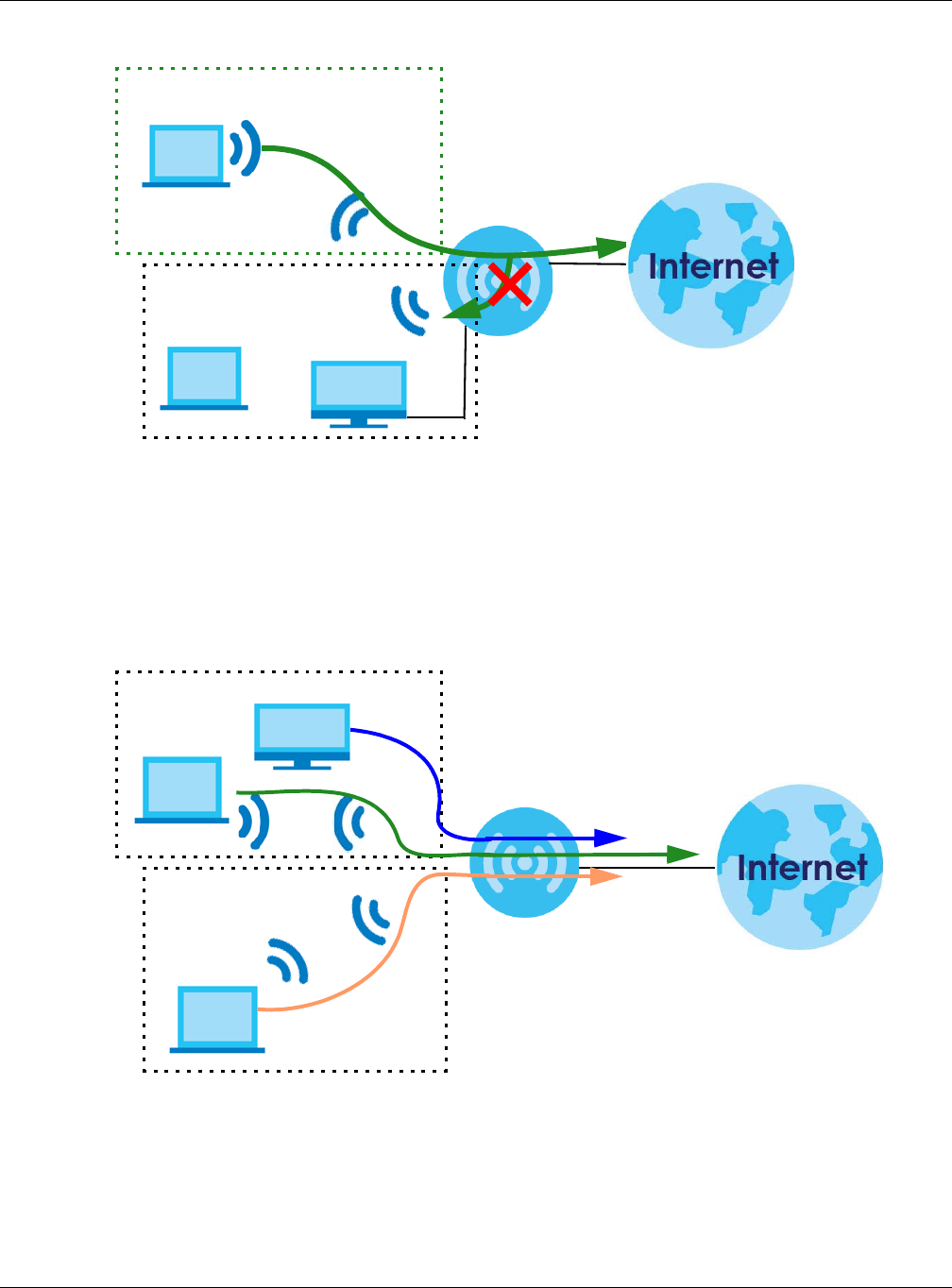
Chapter 9 Wireless LAN
EMG6765-Q10A User’s Guide
75
Figure 31 Guest Wireless LAN Network
Guest WLAN Bandwidth
The Guest WLAN Bandwidth function allows you to restrict the maximum bandwidth for the guest
wireless network. Additionally, you can also define bandwidth for your home or office network. An
example is shown next to define maximum bandwidth for your networks (A is Guest WLAN and N is home
or company network.)
Figure 32 Example: Bandwidth for Different Networks
WPS
Wi-Fi Protected Setup (WPS) is an industry standard specification, defined by the Wi-Fi Alliance. WPS
allows you to quickly set up a wireless network with strong security, without having to configure security
settings manually. Depending on the devices in your network, you can either press a button (on the
device itself, or in its configuration utility) or enter a PIN (Personal Identification Number) in the devices.
N
A
Z
600 kbps
300 kbps
N
A 100 kbps
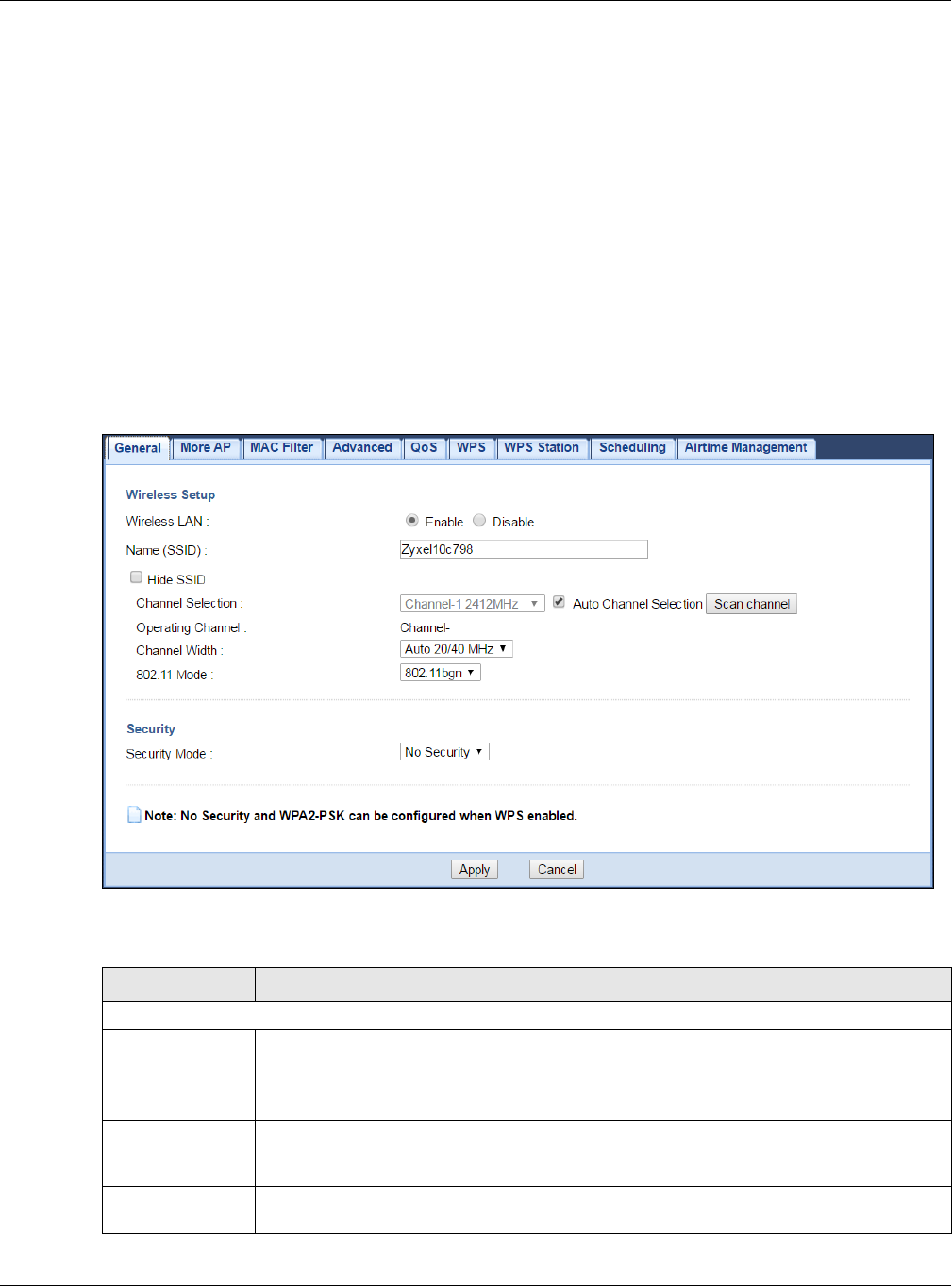
Chapter 9 Wireless LAN
EMG6765-Q10A User’s Guide
76
Then, they connect and set up a secure network by themselves. See how to set up a secure wireless
network using WPS in the Section 6.8 on page 48.
9.2 General Wireless LAN Screen
Use this screen to configure the SSID and wireless security of the wireless LAN.
Note: If you are configuring the EMG6765-Q10A from a computer connected to the wireless
LAN and you change the EMG6765-Q10A’s SSID, channel or security settings, you will
lose your wireless connection when you press Apply to confirm. You must then change
the wireless settings of your computer to match the EMG6765-Q10A’s new settings.
Click Network > Wireless LAN 2.4G/5G to open the General screen.
Figure 33 Network > Wireless LAN 2.4G/5G > General
The following table describes the general wireless LAN labels in this screen.
Table 18 Network > Wireless LAN 2.4G/5G > General
LABEL DESCRIPTION
Wireless Setup
Wireless LAN Select Enable to activate the 2.4GHz and/or 5GHz wireless LAN. Select Disable to turn it off.
Note: You can enable or disable both 2.4GHz and 5GHz wireless LANs by using the
WIFI button located on the side panel of the EMG6765-Q10A.
Name (SSID) The SSID (Service Set IDentity) identifies the Service Set with which a wireless client is
associated. Enter a descriptive name (up to 32 printable characters found on a typical English
language keyboard) for the wireless LAN.
Hide SSID Select this check box to hide the SSID in the outgoing beacon frame so a station cannot
obtain the SSID through scanning using a site survey tool.

Chapter 9 Wireless LAN
EMG6765-Q10A User’s Guide
77
Channel Selection Set the operating frequency/channel depending on your particular region.
Select a channel from the drop-down list box. The options vary depending on the frequency
band and the country you are in.
Refer to the Connection Wizard chapter for more information on channels. This option is only
available if Network Search is disabled.
Network Search Select this check box for the EMG6765-Q10A to automatically choose the channel with the
least interference. Deselect this check box if you wish to manually select the channel using
the Channel Selection field. Click Scan channel so the EMG6765-Q10A can scan for an
available channel.
Operating
Channel
This displays the channel the EMG6765-Q10A is currently using.
Channel Width Select the wireless channel width used by EMG6765-Q10A.
A standard 20 MHz channel offers transfer speeds of up to 144Mbps (2.4GHz) or 217Mbps
(5GHZ) whereas a 40MHz channel uses two standard channels and offers speeds of up to
300Mbps (2.4GHz) or 450Mbps (5GHZ). An IEEE 802.11ac-specific 80MHz channel offers speeds
of up to 1.3Gbps.
Because not all devices support 40 MHz and/or 80 MHz channels, select Auto 20/40 MHz or
Auto 20/40/80 MHz to allow the EMG6765-Q10A to adjust the channel bandwidth
automatically.
40 MHz (channel bonding or dual channel) bonds two adjacent radio channels to increase
throughput. A 80 MHz channel consists of two adjacent 40 MHz channels. The wireless clients
must also support 40 MHz or 80 MHz. It is often better to use the 20 MHz setting in a location
where the environment hinders the wireless signal.
Select 20 MHz if you want to lessen radio interference with other wireless devices in your
neighborhood or the wireless clients do not support channel bonding.
802.11 Mode If you are in the Wireless LAN 2.4G > General screen, you can select from the following:
•802.11b: allows either IEEE 802.11b or IEEE 802.11g compliant WLAN devices to associate
with the EMG6765-Q10A. In this mode, all wireless devices can only transmit at the data
rates supported by IEEE 802.11b.
•802.11g: allows IEEE 802.11g compliant WLAN devices to associate with the Device. IEEE
802.11b compliant WLAN devices can associate with the EMG6765-Q10A only when they
use the short preamble type.
•802.11bg: allows either IEEE 802.11b or IEEE 802.11g compliant WLAN devices to associate
with the EMG6765-Q10A. The EMG6765-Q10A adjusts the transmission rate automatically
according to the wireless standard supported by the wireless devices.
•802.11n: allows IEEE 802.11n compliant WLAN devices to associate with the EMG6765-
Q10A. This can increase transmission rates, although IEEE 802.11b or IEEE 802.11g clients will
not be able to connect to the EMG6765-Q10A.
•802.11gn: allows either IEEE 802.11g or IEEE 802.11n compliant WLAN devices to associate
with the EMG6765-Q10A. The transmission rate of your EMG6765-Q10A might be reduced.
•802.11 bgn: allows IEEE802.11b, IEEE802.11g and IEEE802.11n compliant WLAN devices to
associate with the EMG6765-Q10A. The transmission rate of your EMG6765-Q10A might be
reduced.
If you are in the Wireless LAN 5G > General screen, you can select from the following:
•802.11a: allows only IEEE 802.11a compliant WLAN devices to associate with the EMG6765-
Q10A.
•802.11a/an: allows both IEEE802.11n and IEEE802.11a compliant WLAN devices to
associate with the EMG6765-Q10A. The transmission rate of your EMG6765-Q10A might be
reduced.
•802.11a/an/ac: allows both IEEE802.11a, IEEE802.11n and IEEE802.11ac compliant WLAN
devices to associate with the EMG6765-Q10A. The transmission rate of your EMG6765-
Q10A might be reduced.
Security
Table 18 Network > Wireless LAN 2.4G/5G > General (continued)
LABEL DESCRIPTION
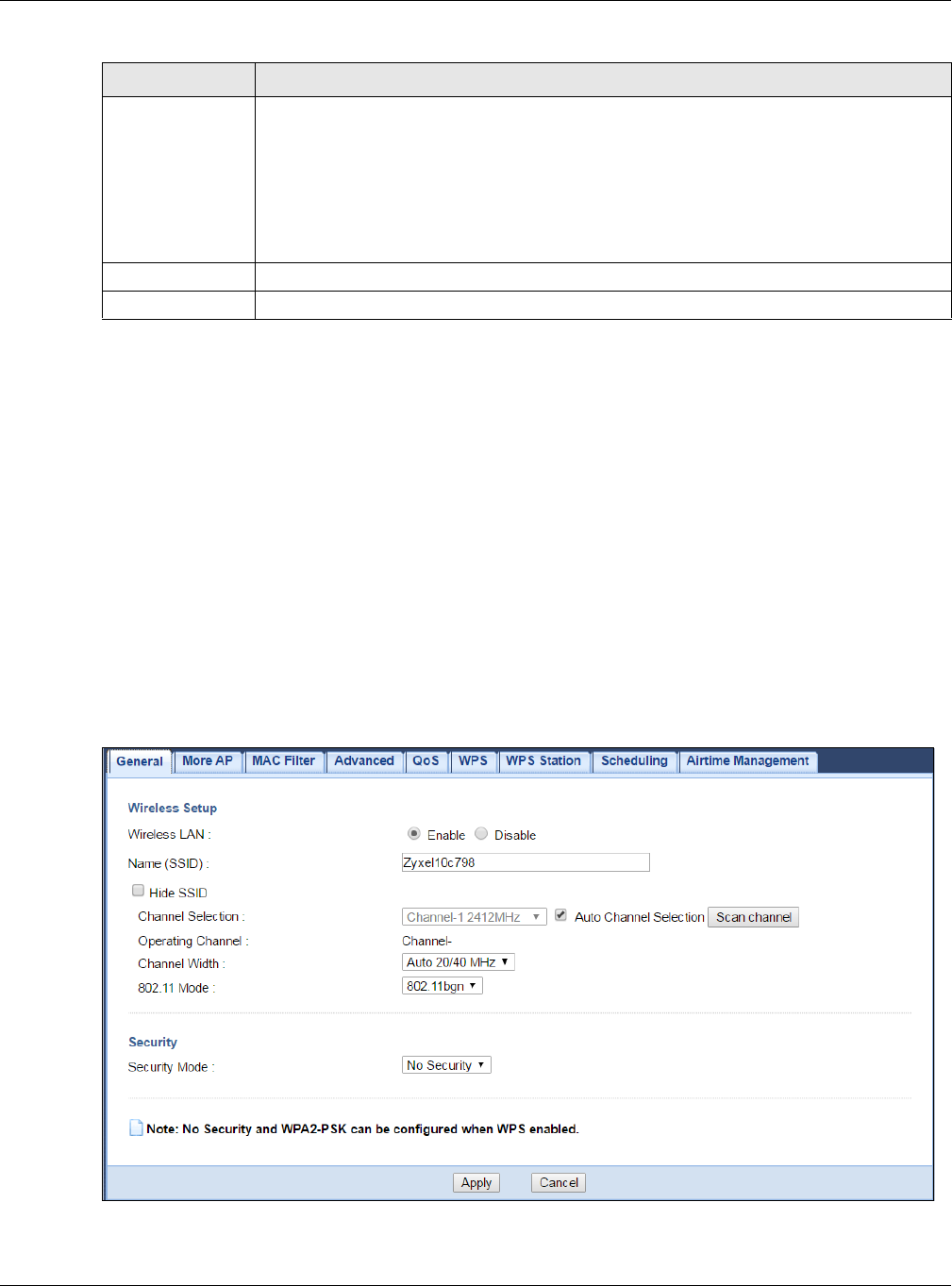
Chapter 9 Wireless LAN
EMG6765-Q10A User’s Guide
78
See the rest of this chapter for information on the other labels in this screen.
9.3 Wireless Security
The screen varies depending on what you select in the Security Mode field.
9.3.1 No Security
Select No Security to allow wireless clients to communicate with the access points without any data
encryption.
Note: If you do not enable any wireless security on your EMG6765-Q10A, your network is
accessible to any wireless networking device that is within range.
Figure 34 Network > Wireless LAN 2.4G/5G > General: No Security
Security Mode Select WPA2-PSK or WPA2 to add security on this wireless network. The wireless clients which
want to associate to this network must have same wireless security settings as this device.
After you select to use a security, additional options appears in this screen. See Section 9.3 on
page 78 for detailed information on different security modes. Or you can select No Security to
allow any client to associate this network without authentication.
Note: If the WPS function is enabled (default), only No Security and WPA2-PSK are
available in this field.
Apply Click Apply to save your changes back to the EMG6765-Q10A.
Cancel Click Cancel to reload the previous configuration for this screen.
Table 18 Network > Wireless LAN 2.4G/5G > General (continued)
LABEL DESCRIPTION
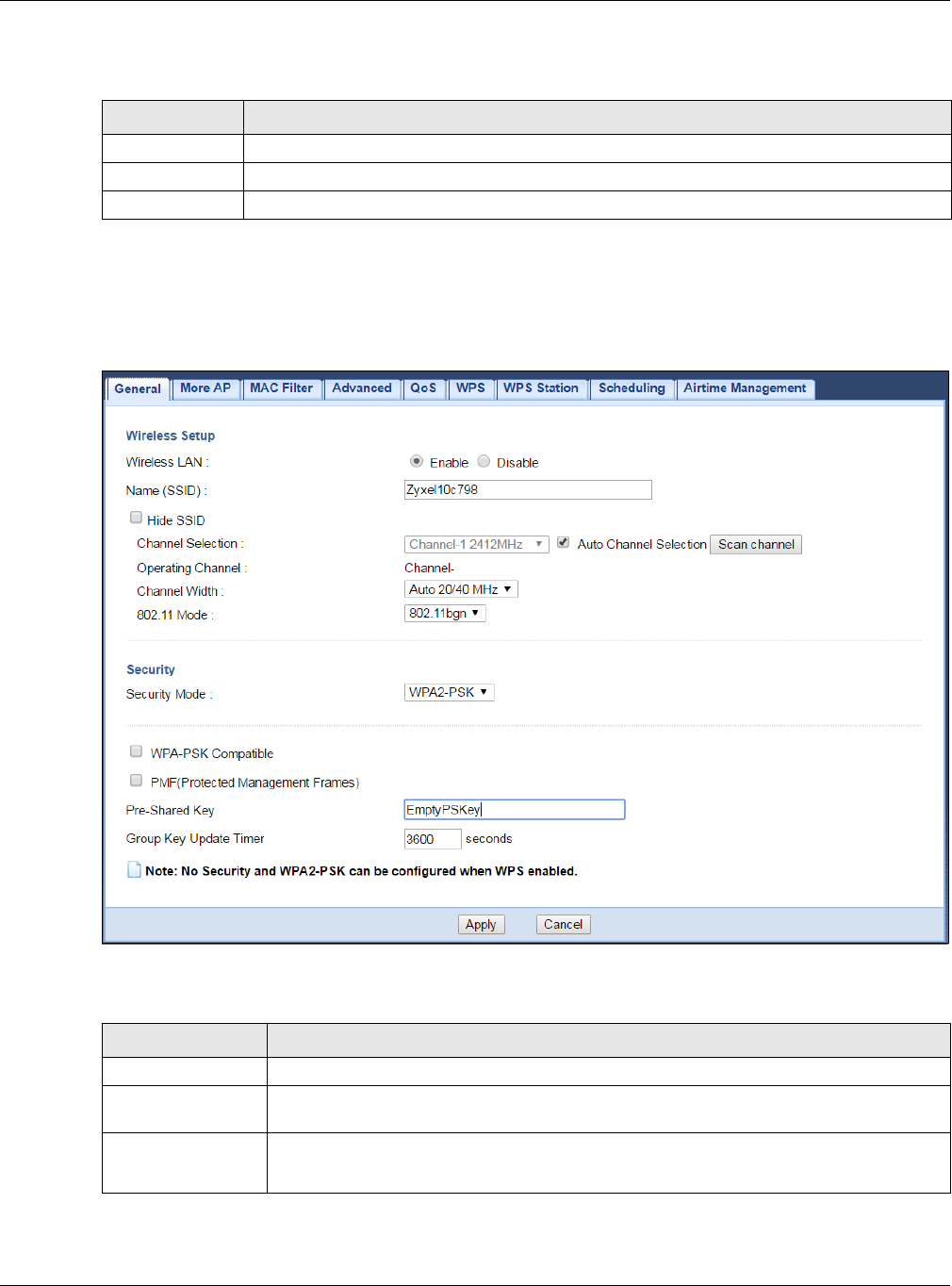
Chapter 9 Wireless LAN
EMG6765-Q10A User’s Guide
79
The following table describes the labels in this screen.
9.3.2 WPA2-PSK
Select WPA2-PSK from the Security Mode list.
Figure 35 Network > Wireless LAN 2.4G/5G > General: WPA2-PSK
The following table describes the labels in this screen.
Table 19 Network > Wireless LAN 2.4G/5G > General: No Security
LABEL DESCRIPTION
Security Mode Choose No Security from the drop-down list box.
Apply Click Apply to save your changes back to the EMG6765-Q10A.
Cancel Click Cancel to reload the previous configuration for this screen.
Table 20 Network > Wireless LAN 2.4G/5G > General: WPA2-PSK
LABEL DESCRIPTION
Security Mode Select WPA2-PSK to enable data encryption.
WPA-PSK
Compatible
Check this field to allow wireless devices using WPA-PSK security mode to connect to your
EMG6765-Q10A even when the EMG6765-Q10A is using WPA2-PSK.
Pre-Shared Key WPA2-PSK uses a simple common password for authentication.
Type a pre-shared key from 8 to 63 case-sensitive keyboard characters.
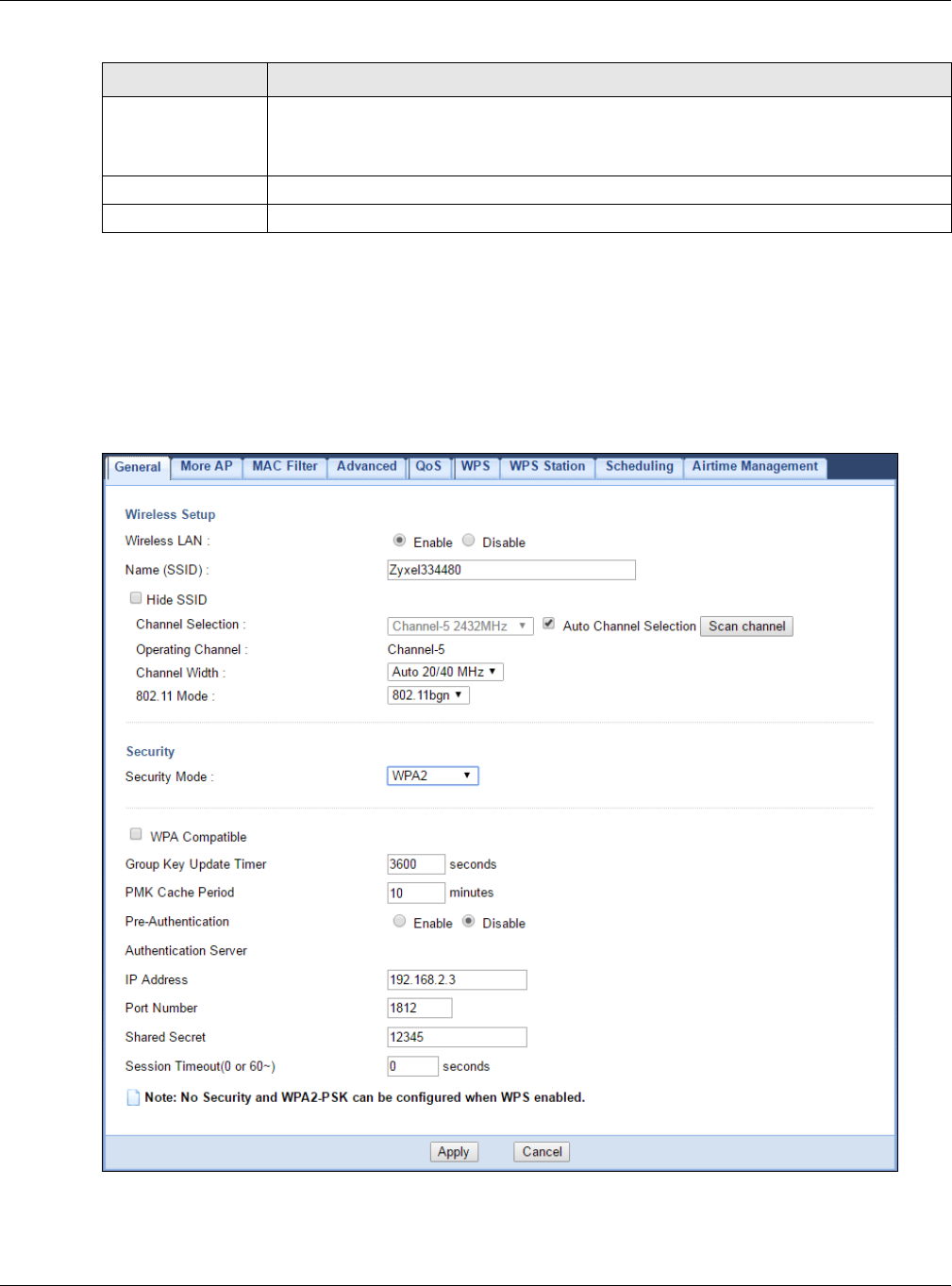
Chapter 9 Wireless LAN
EMG6765-Q10A User’s Guide
80
9.3.3 WPA2
Select WPA2 from the Security Mode list.
Note: WPA2 is not available if you enable WPS before you configure WPA2 in the Wireless LAN
2.4G/5G > General screen.
Figure 36 Network > Wireless LAN 2.4G/5G > General: WPA2
Group Key Update
Timer
The Group Key Update Timer is the rate at which the AP sends a new group key out to all
clients.
The default is 3600 seconds (60 minutes).
Apply Click Apply to save your changes back to the EMG6765-Q10A.
Cancel Click Cancel to reload the previous configuration for this screen.
Table 20 Network > Wireless LAN 2.4G/5G > General: WPA2-PSK (continued)
LABEL DESCRIPTION

Chapter 9 Wireless LAN
EMG6765-Q10A User’s Guide
81
The following table describes the labels in this screen.
9.4 More AP Screen
This screen allows you to enable and configure multiple wireless networks and guest wireless network
settings on the EMG6765-Q10A.
Table 21 Network > Wireless LAN 2.4G/5G > General: WPA2
LABEL DESCRIPTION
Security Mode Select WPA or WPA2 to enable data encryption.
WPA Compatible This check box is available only when you select WPA2-PSK or WPA2 in the Security Mode
field.
Select the check box to have both WPA2 and WPA wireless clients be able to
communicate with the EMG6765-Q10A even when the EMG6765-Q10A is using WPA2-PSK
or WPA2.
Group Key Update
Timer
The Group Key Update Timer is the rate at which the AP (if using WPA-PSK/WPA2-PSK key
management) or RADIUS server (if using WPA/WPA2 key management) sends a new group
key out to all clients. The re-keying process is the WPA/WPA2 equivalent of automatically
changing the WEP key for an AP and all stations in a WLAN on a periodic basis. Setting of
the Group Key Update Timer is also supported in WPA-PSK/WPA2-PSK mode.
PMK Cache Period This field is available only when you select WPA2.
Specify how often wireless clients have to resend usernames and passwords in order to
stay connected. Enter a time interval between 10 and 999999 minutes.
Note: If wireless client authentication is done using a RADIUS server, the
reauthentication timer on the RADIUS server has priority.
Pre-Authentication This field is available only when you select WPA2.
Pre-authentication enables fast roaming by allowing the wireless client (already
connecting to an AP) to perform IEEE 802.1x authentication with another AP before
connecting to it. Select Enable to turn on preauthentication in WAP2. Otherwise, select
Disable.
Authentication Server
IP Address Enter the IP address of the external authentication server in dotted decimal notation.
Port Number Enter the port number of the external authentication server.
You need not change this value unless your network administrator instructs you to do so
with additional information.
Shared Secret Enter a password (up to 127 alphanumeric characters) as the key to be shared between
the external authentication server and the EMG6765-Q10A.
The key must be the same on the external authentication server and your EMG6765-Q10A.
The key is not sent over the network.
Session Timeout The EMG6765-Q10A automatically disconnects a wireless client from the wireless and wired
networks after a period of inactivity. The wireless client needs to send the username and
password again before it can use the wireless and wired networks again. Some wireless
clients may prompt users for a username and password; other clients may use saved login
credentials. In either case, there is usually a short delay while the wireless client logs in to
the wireless network again.
Enter the time in seconds from 0 to 999999.
Apply Click Apply to save your changes back to the EMG6765-Q10A.
Cancel Click Cancel to reload the previous configuration for this screen.
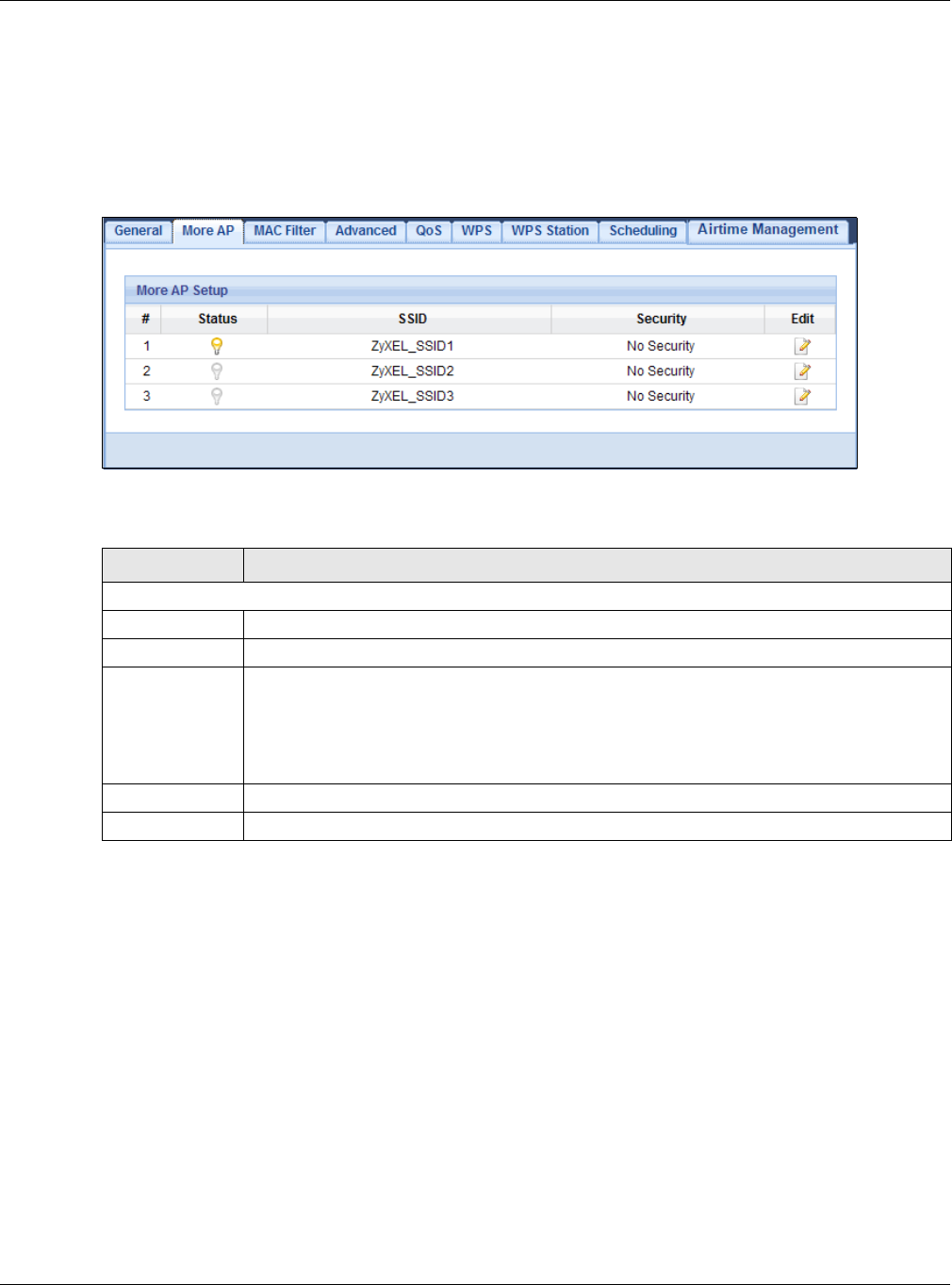
Chapter 9 Wireless LAN
EMG6765-Q10A User’s Guide
82
You can configure up to four SSIDs to enable multiple BSSs (Basic Service Sets) on the EMG6765-Q10A.
This allows you to use one access point to provide several BSSs simultaneously. You can then assign
varying security types to different SSIDs. Wireless clients can use different SSIDs to associate with the
same access point.
Click Network > Wireless LAN 2.4G/5G > More AP. The following screen displays.
Figure 37 Network > Wireless LAN 2.4G/5G > More AP
The following table describes the labels in this screen.
9.4.1 More AP Edit
Use this screen to edit an SSID profile. Click the Edit icon next to an SSID in the More AP screen. The
following screen displays.
Table 22 Network > Wireless LAN 2.4G/5G > More AP
LABEL DESCRIPTION
More AP Setup
#This is the index number of each SSID profile.
Status This shows whether the SSID profile is active (a yellow bulb) or not (a gray bulb).
SSID An SSID profile is the set of parameters relating to one of the EMG6765-Q10A’s BSSs. The SSID
(Service Set IDentifier) identifies the Service Set with which a wireless device is associated.
This field displays the name of the wireless profile on the network. When a wireless client scans
for an AP to associate with, this is the name that is broadcast and seen in the wireless client
utility.
Security This field indicates the security mode of the SSID profile.
Edit Click the Edit icon to configure the SSID profile.
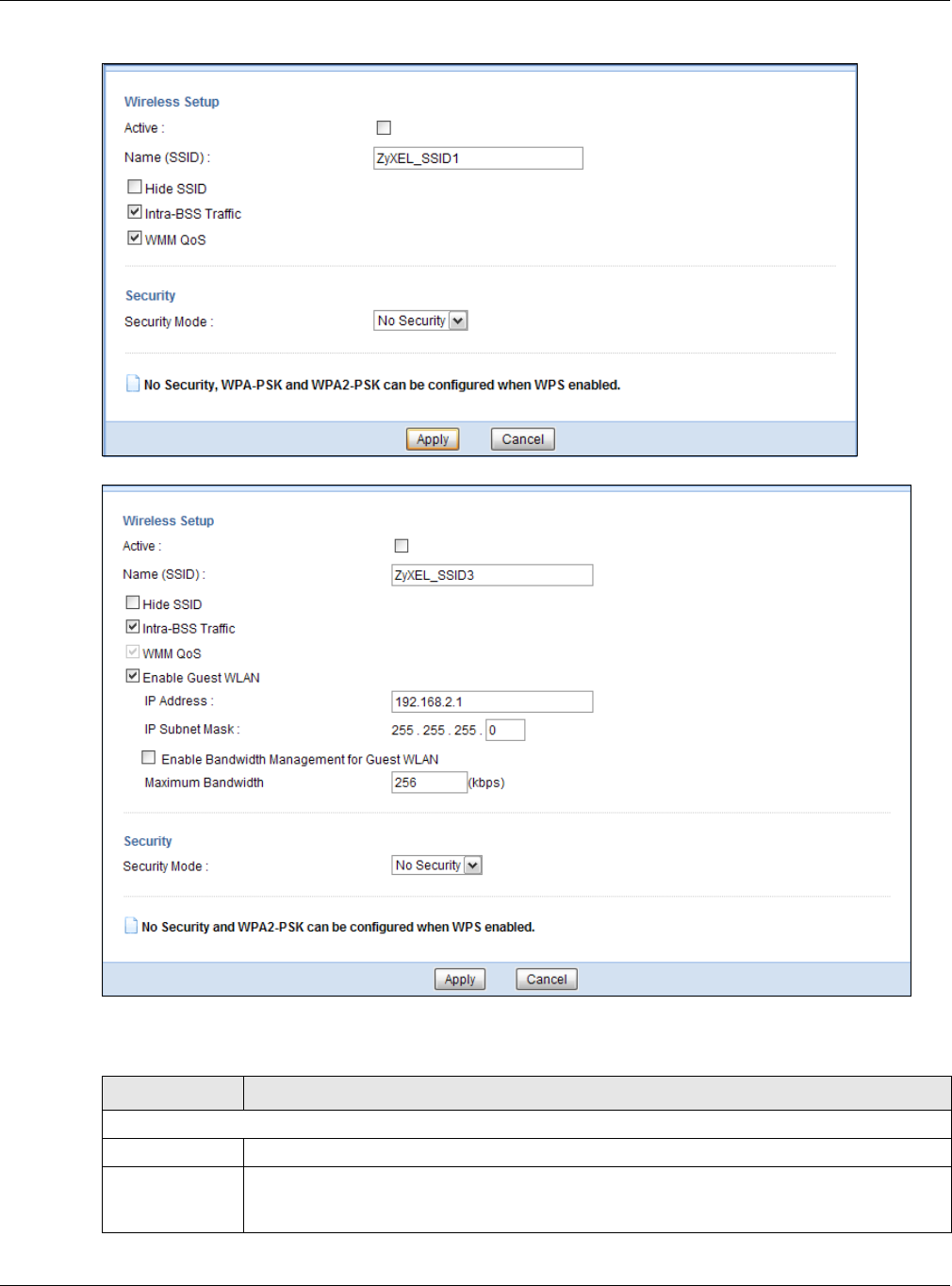
Chapter 9 Wireless LAN
EMG6765-Q10A User’s Guide
83
Figure 38 Network > Wireless LAN 2.4G/5G > More AP: Edit
Figure 39 Network > Wireless LAN 2.4G/5G > More AP: Edit (the last SSID)
The following table describes the labels in this screen.
Table 23 Network > Wireless LAN 2.4G/5G > More AP: Edit
LABEL DESCRIPTION
Wireless Setup
Active Select this to activate the SSID profile.
Name (SSID) The SSID (Service Set IDentity) identifies the Service Set with which a wireless client is associated.
Enter a descriptive name (up to 32 printable characters found on a typical English language
keyboard) for the wireless LAN.

Chapter 9 Wireless LAN
EMG6765-Q10A User’s Guide
84
9.5 MAC Filter Screen
The MAC filter screen allows you to configure the EMG6765-Q10A to give exclusive access to devices
(Allow) or exclude devices from accessing the EMG6765-Q10A (Deny). Every Ethernet device has a
unique MAC (Media Access Control) address. The MAC address is assigned at the factory and consists
of six pairs of hexadecimal characters, for example, 00:A0:C5:00:00:02. You need to know the MAC
address of the devices to configure this screen.
To change your EMG6765-Q10A’s MAC filter settings, click Network > Wireless LAN 2.4G/5G > MAC Filter.
The screen appears as shown.
Hide SSID Select this check box to hide the SSID in the outgoing beacon frame so a station cannot obtain
the SSID through scanning using a site survey tool.
Intra-BSS Traffic A Basic Service Set (BSS) exists when all communications between wireless clients or between a
wireless client and a wired network client go through one access point (AP).
Intra-BSS traffic is traffic between wireless clients in the BSS. When Intra-BSS is enabled, wireless
clients can access the wired network and communicate with each other. When Intra-BSS is
disabled, wireless clients can still access the wired network but cannot communicate with each
other.
WMM QoS Check this to have the EMG6765-Q10A automatically give a service a priority level according
to the ToS value in the IP header of packets it sends.
WMM QoS (Wifi MultiMedia Quality of Service) gives high priority to voice and video, which
makes them run more smoothly.
Enable Guest
WLAN
Select the check box to activate guest wireless LAN. This is available only for the last SSID on the
EMG6765-Q10A.
IP Address Type an IP address for the devices on the Guest WLAN using this as the gateway IP address.
IP Subnet
Mask Type the subnet mask for the guest wireless LAN.
Enable
Bandwidth
Managemen
t for Guest
WLAN
Select this to turn on bandwidth management for the Guest WLAN network.
Maximum
Bandwidth Enter a number to specify maximum bandwidth the Guest WLAN network can use.
Security
Security Mode Select WPA2-PSK or WPA2 to add security on this wireless network. The wireless clients which
want to associate to this network must have same wireless security settings as this device. After
you select to use a security, additional options appears in this screen. See Section 9.3 on page
78 for detailed information on different security modes. Or you can select No Security to allow
any client to associate this network without authentication.
Note: If the WPS function is enabled (default), only No Security and WPA2-PSK are
available in this field.
Apply Click Apply to save your changes back to the EMG6765-Q10A.
Cancel Click Cancel to reload the previous configuration for this screen.
Table 23 Network > Wireless LAN 2.4G/5G > More AP: Edit (continued)
LABEL DESCRIPTION
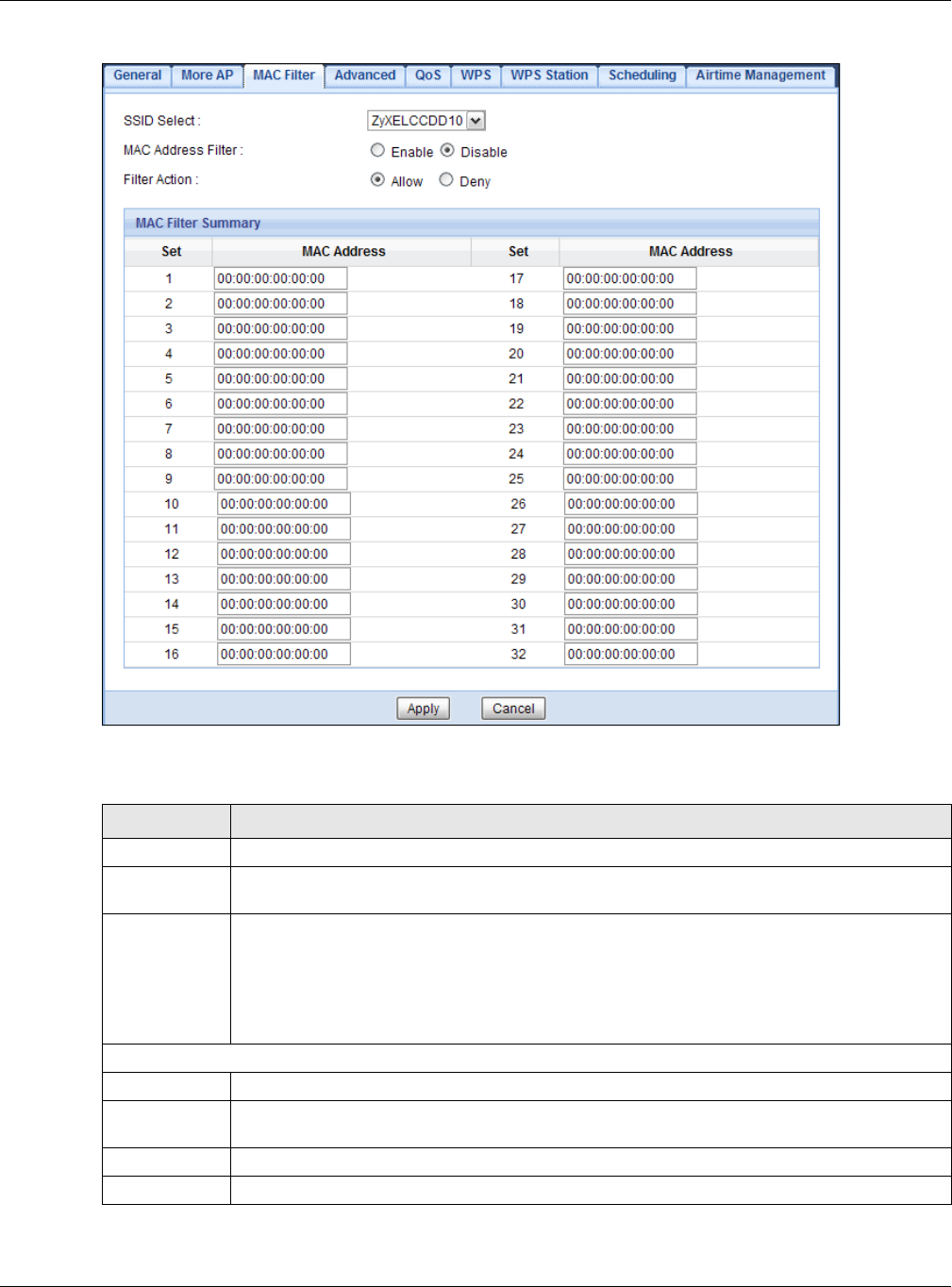
Chapter 9 Wireless LAN
EMG6765-Q10A User’s Guide
85
Figure 40 Network > Wireless LAN 2.4G/5G > MAC Filter
The following table describes the labels in this menu.
Table 24 Network > Wireless LAN 2.4G/5G > MAC Filter
LABEL DESCRIPTION
SSID Select Select the SSID for which you want to configure MAC filtering.
MAC Address
Filter
Select to turn on (Enable) or off (Disable) MAC address filtering.
Filter Action Define the filter action for the list of MAC addresses in the MAC Filter Summary table.
Select Allow to permit access to the EMG6765-Q10A, MAC addresses not listed will be denied
access to the EMG6765-Q10A.
Select Deny to block access to the EMG6765-Q10A, MAC addresses not listed will be allowed to
access the EMG6765-Q10A.
MAC Filter Summary
Set This is the index number of the MAC address.
MAC Address Enter the MAC address of the wireless station that are allowed or denied access to the EMG6765-
Q10A.
Apply Click Apply to save your changes back to the EMG6765-Q10A.
Cancel Click Cancel to reload the previous configuration for this screen.
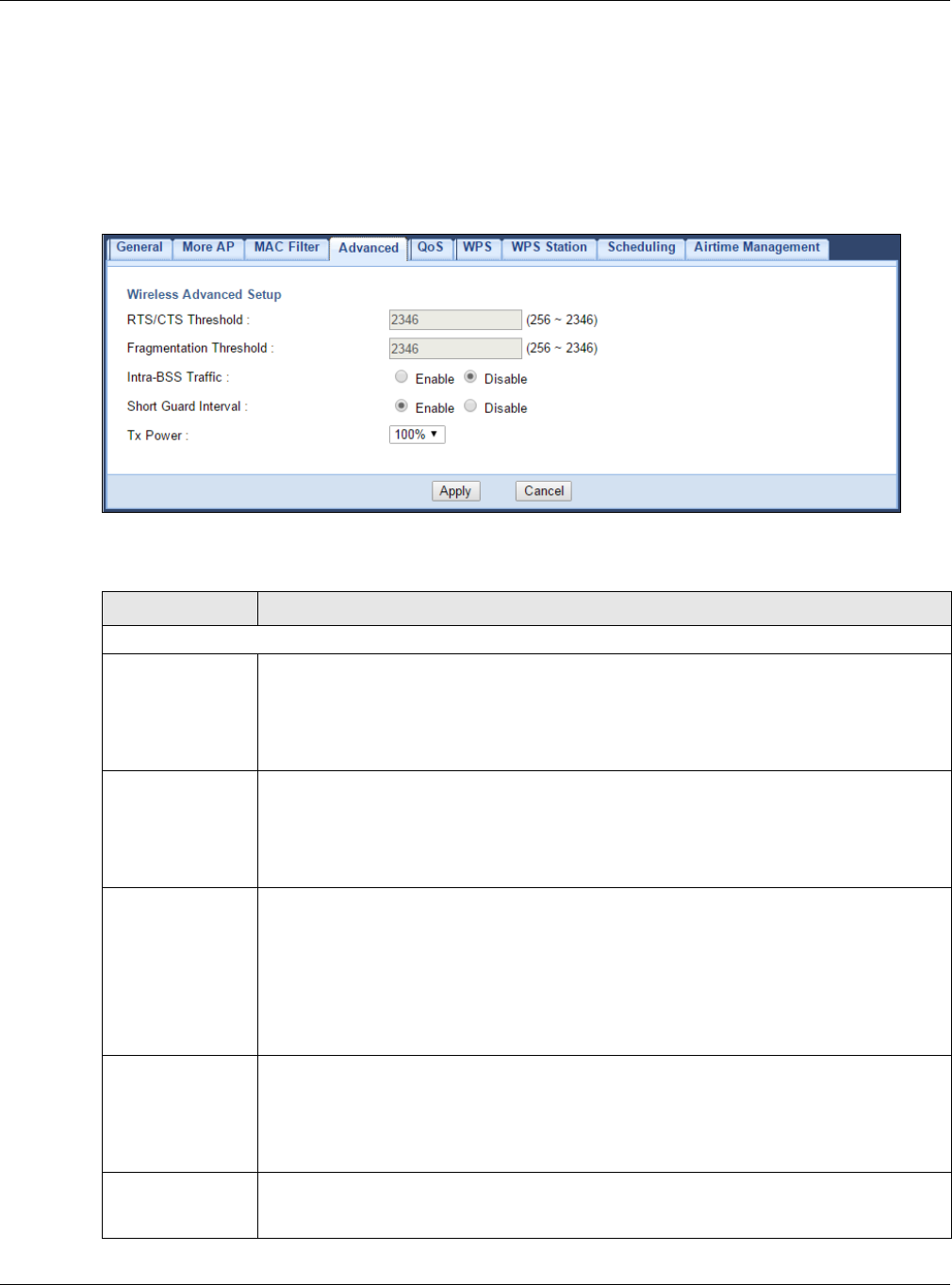
Chapter 9 Wireless LAN
EMG6765-Q10A User’s Guide
86
9.6 Wireless LAN Advanced Screen
Use this screen to allow wireless advanced features, such as the output power, RTS/CTS Threshold
settings.
Click Network > Wireless LAN 2.4G/5G > Advanced. The screen appears as shown.
Figure 41 Network > Wireless LAN 2.4G/5G > Advanced
The following table describes the labels in this screen.
Table 25 Network > Wireless LAN 2.4G/5G > Advanced
LABEL DESCRIPTION
Wireless Advanced Setup
RTS/CTS Threshold Data with its frame size larger than this value will perform the RTS (Request To Send)/CTS (Clear
To Send) handshake.
This field is not configurable and the EMG6765-Q10A automatically changes to use the
maximum value if you select 802.11a/an, 802.11a/an/ac, 802.11n, 802.11gn or 802.11bgn in
the Wireless LAN 2.4G/5G > General screen.
Fragmentation
Threshold
The threshold (number of bytes) for the fragmentation boundary for directed messages. It is
the maximum data fragment size that can be sent.
This field is not configurable and the EMG6765-Q10A automatically changes to use the
maximum value if you select 802.11a/an, 802.11a/an/ac, 802.11n, 802.11gn or 802.11bgn in
the Wireless LAN 2.4G/5G > General screen.
Intra-BSS Traffic
Blocking
A Basic Service Set (BSS) exists when all communications between wireless clients or between
a wireless client and a wired network client go through one access point (AP).
Intra-BSS traffic is traffic between wireless clients in the BSS. When Intra-BSS is enabled, wireless
clients can access the wired network and communicate with each other. When Intra-BSS is
disabled, wireless clients can still access the wired network but cannot communicate with
each other.
Select Enable to prevent crossover traffic from within the same SSID on the EMG6765-Q10A.
Short Guard
Interval
Select Enable to use Short GI (Guard Interval).
The guard interval is the gap introduced between data transmission from users in order to
reduce interference. Reducing the interval increases data transfer rates but also increases
interference. Increasing the interval reduces data transfer rates but also reduces
interference.
Tx Power Set the output power of the EMG6765-Q10A in this field. If there is a high density of APs in an
area, decrease the output power of the EMG6765-Q10A to reduce interference with other
APs. Select one of the following 100%, 90%, 75%, 50%, 25% or 10%.
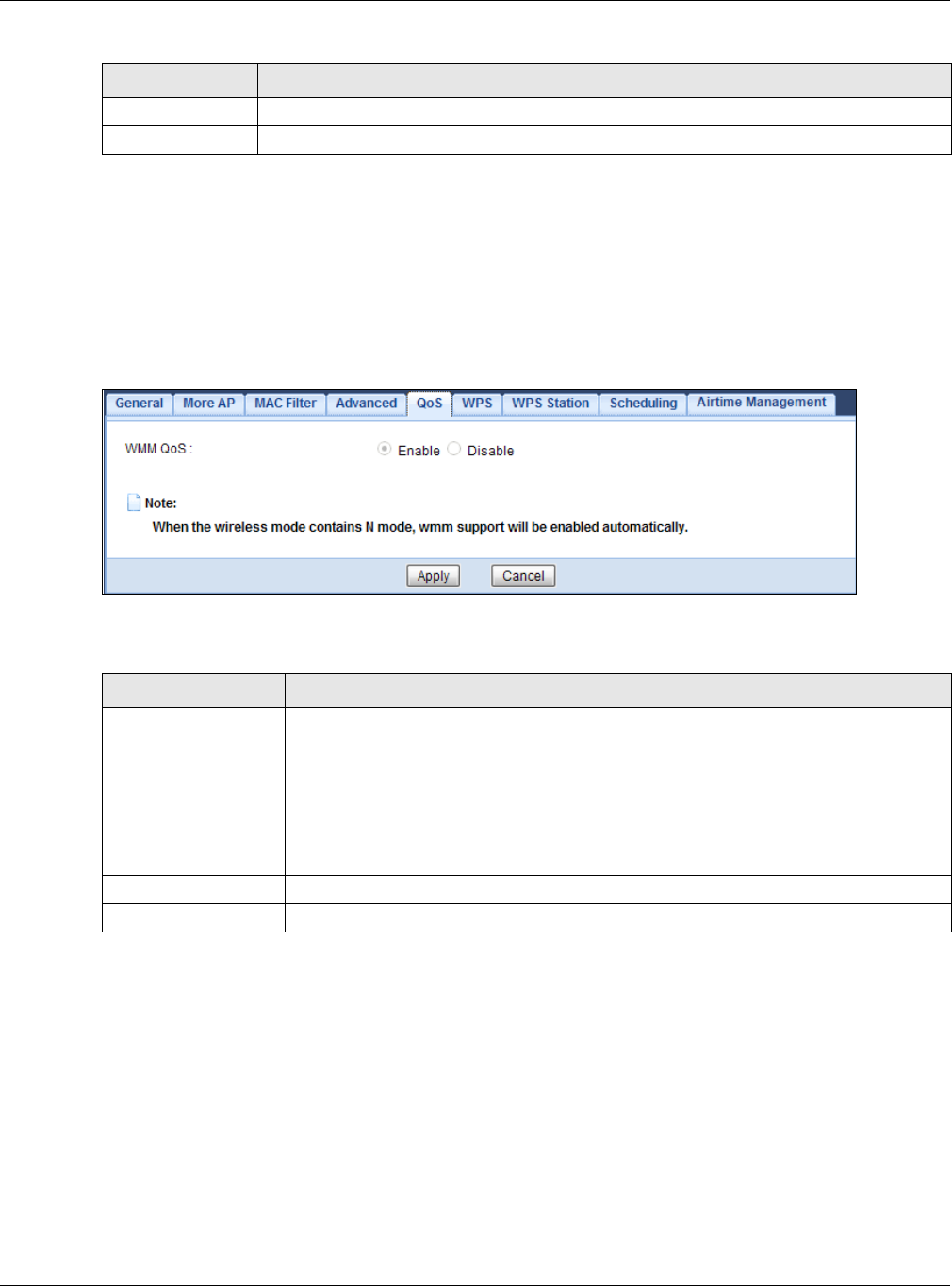
Chapter 9 Wireless LAN
EMG6765-Q10A User’s Guide
87
9.7 Quality of Service (QoS) Screen
The QoS screen allows you to automatically give a service (such as VoIP and video) a priority level.
Click Network > Wireless LAN 2.4G/5G > QoS. The following screen appears.
Figure 42 Network > Wireless LAN 2.4G/5G > QoS
The following table describes the labels in this screen.
9.8 WPS Screen
Use this screen to enable/disable WPS, view or generate a new PIN number and check current WPS
status. To open this screen, click Network > Wireless LAN 2.4G/5G > WPS.
Note: With WPS, wireless clients can only connect to the wireless network using the first SSID on
the EMG6765-Q10A.
Apply Click Apply to save your changes back to the EMG6765-Q10A.
Cancel Click Cancel to reload the previous configuration for this screen.
Table 25 Network > Wireless LAN 2.4G/5G > Advanced (continued)
LABEL DESCRIPTION
Table 26 Network > Wireless LAN 2.4G/5G > QoS
LABEL DESCRIPTION
WMM QoS Select Enable to have the EMG6765-Q10A automatically give a service a priority level
according to the ToS value in the IP header of packets it sends. WMM QoS (Wifi
MultiMedia Quality of Service) gives high priority to voice and video, which makes them
run more smoothly.
Note: This field is not configurable and the EMG6765-Q10A automatically
enables WMM QoS if you select 802.11n, 802.11an, 802.11gn or 802.11bgn
in the Wireless LAN 24G/5G > General screen.
Apply Click Apply to save your changes to the EMG6765-Q10A.
Cancel Click Cancel to reload the previous configuration for this screen.
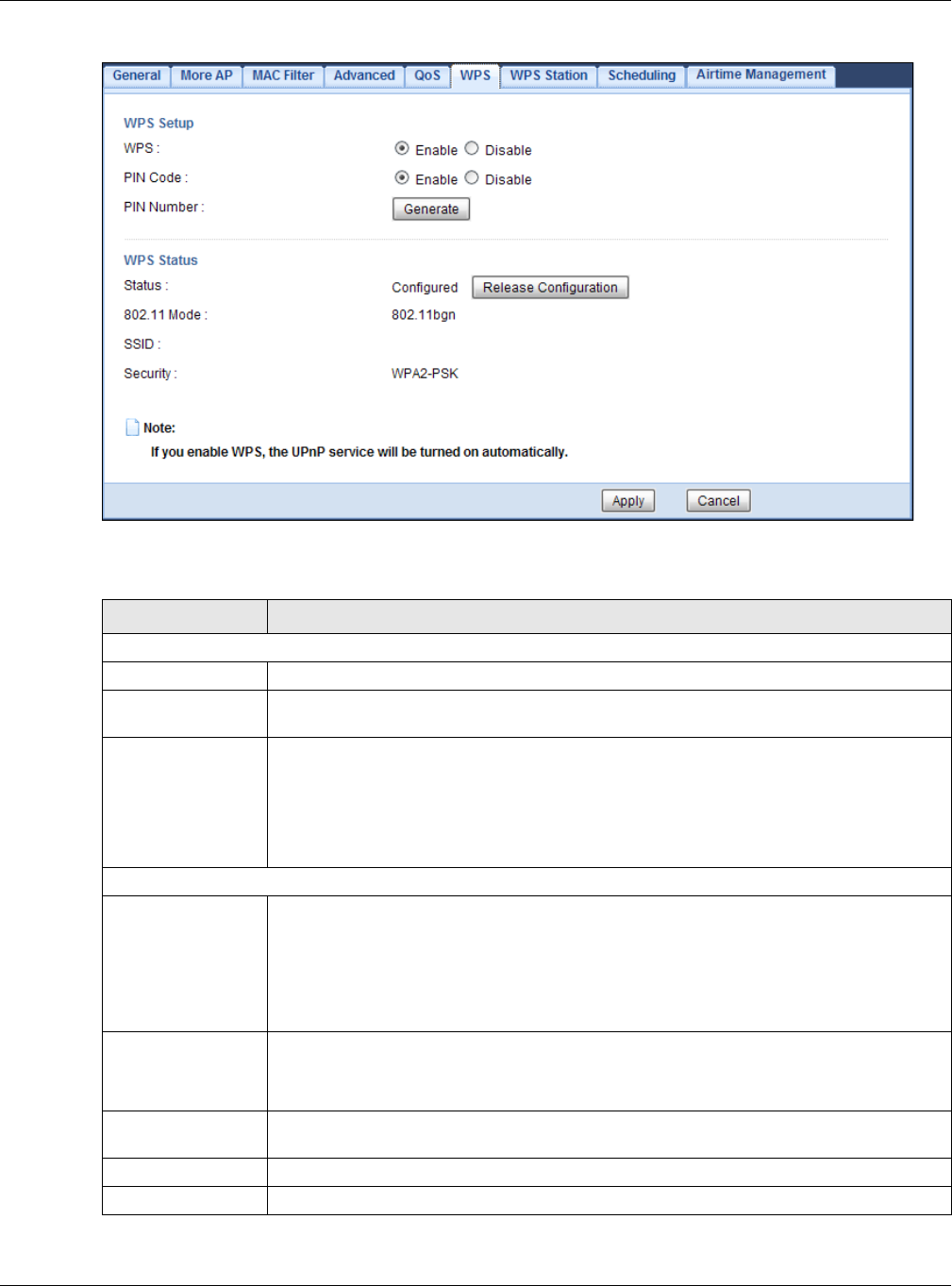
Chapter 9 Wireless LAN
EMG6765-Q10A User’s Guide
88
Figure 43 Network > Wireless LAN 2.4G/5G > WPS
The following table describes the labels in this screen.
Table 27 Network > Wireless LAN 2.4G/5G > WPS
LABEL DESCRIPTION
WPS Setup
WPS Select Enable to turn on the WPS feature. Otherwise, select Disable.
PIN Code Select Enable and click Apply to allow the PIN Configuration method. If you select Disable,
you cannot create a new PIN number.
PIN Number This is the WPS PIN (Personal Identification Number) of the EMG6765-Q10A. Enter this PIN in
the configuration utility of the device you want to connect to the EMG6765-Q10A using
WPS.
The PIN is not necessary when you use WPS push-button method.
Click Generate to generate a new PIN number.
WPS Status
Status This displays Configured when the EMG6765-Q10A has connected to a wireless network
using WPS or when WPS Enable is selected and wireless or wireless security settings have
been changed. The current wireless and wireless security settings also appear in the screen.
This displays Unconfigured if WPS is disabled and there are no wireless or wireless security
changes on the EMG6765-Q10A or you click Release Configuration to remove the
configured wireless and wireless security settings.
Release
Configuration
This button is only available when the WPS status displays Configured.
Click this button to remove all configured wireless and wireless security settings for WPS
connections on the EMG6765-Q10A.
802.11 Mode This is the 802.11 mode used. Only compliant WLAN devices can associate with the
EMG6765-Q10A.
SSID This is the name of the wireless network (the EMG6765-Q10A’s first SSID).
Security This is the type of wireless security employed by the network.
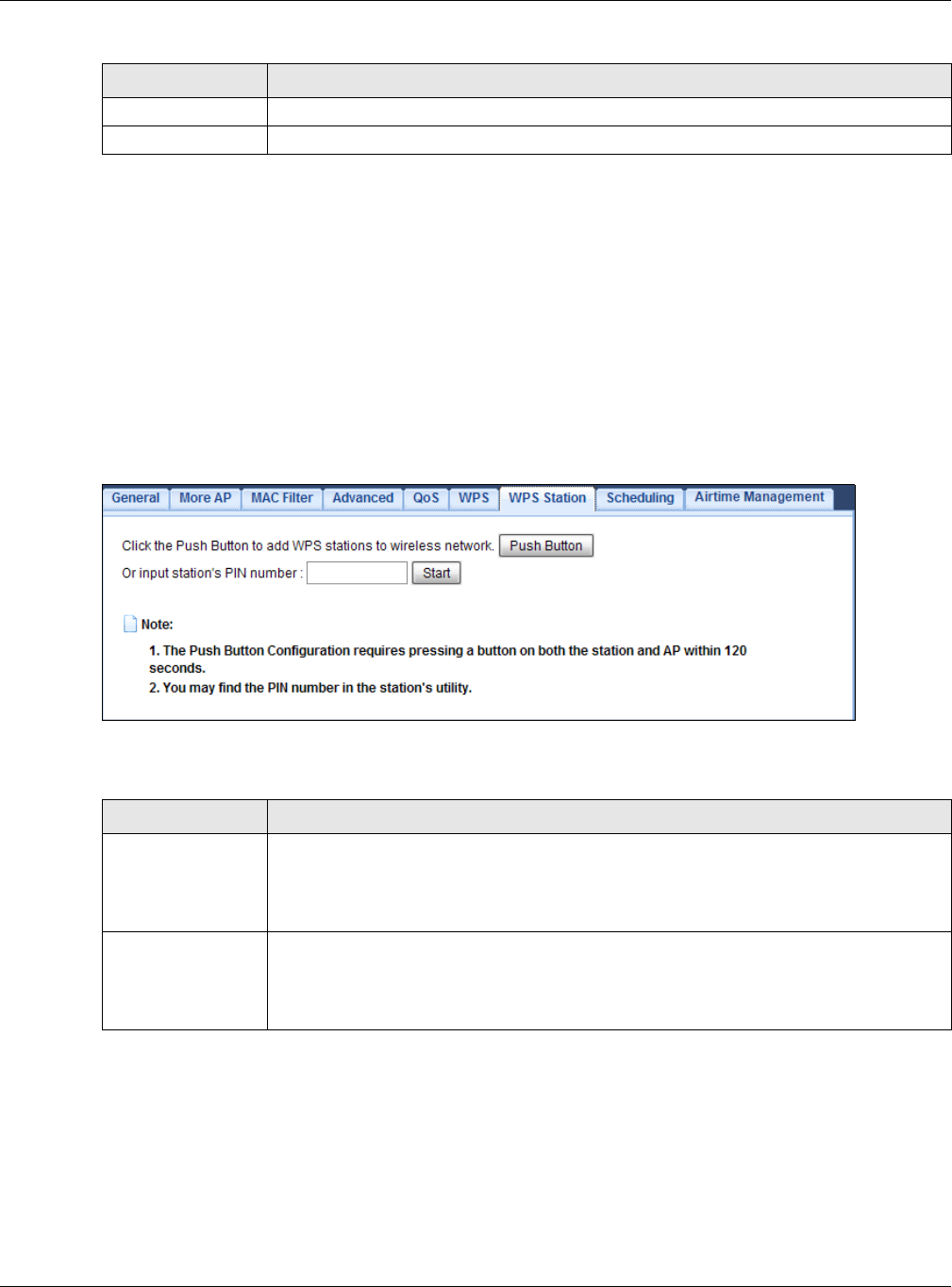
Chapter 9 Wireless LAN
EMG6765-Q10A User’s Guide
89
9.9 WPS Station Screen
Use this screen when you want to add a wireless station using WPS. To open this screen, click Network >
Wireless LAN 2.4G/5G > WPS Station.
Note: After you click Push Button on this screen, you have to press a similar button in the
wireless station utility within 2 minutes. To add the second wireless station, you have to
press these buttons on both device and the wireless station again after the first 2
minutes.
Figure 44 Network > Wireless LAN 2.4G/5G > WPS Station
The following table describes the labels in this screen.
9.10 Scheduling Screen
Use this screen to set the times your wireless LAN is turned on and off. Wireless LAN scheduling is disabled
by default. The wireless LAN can be scheduled to turn on or off on certain days and at certain times. To
open this screen, click Network > Wireless LAN 2.4G/5G > Scheduling tab.
Apply Click Apply to save your changes back to the EMG6765-Q10A.
Cancel Click Cancel to reload the previous configuration for this screen.
Table 27 Network > Wireless LAN 2.4G/5G > WPS (continued)
LABEL DESCRIPTION
Table 28 Network > Wireless LAN 2.4G/5G > WPS Station
LABEL DESCRIPTION
Push Button Use this button when you use the PBC (Push Button Configuration) method to configure
wireless station’s wireless settings.
Click this to start WPS-aware wireless station scanning and the wireless security information
synchronization.
Or input station’s PIN
number
Use this button when you use the PIN Configuration method to configure wireless station’s
wireless settings.
Type the same PIN number generated in the wireless station’s utility. Then click Start to
associate to each other and perform the wireless security information synchronization.
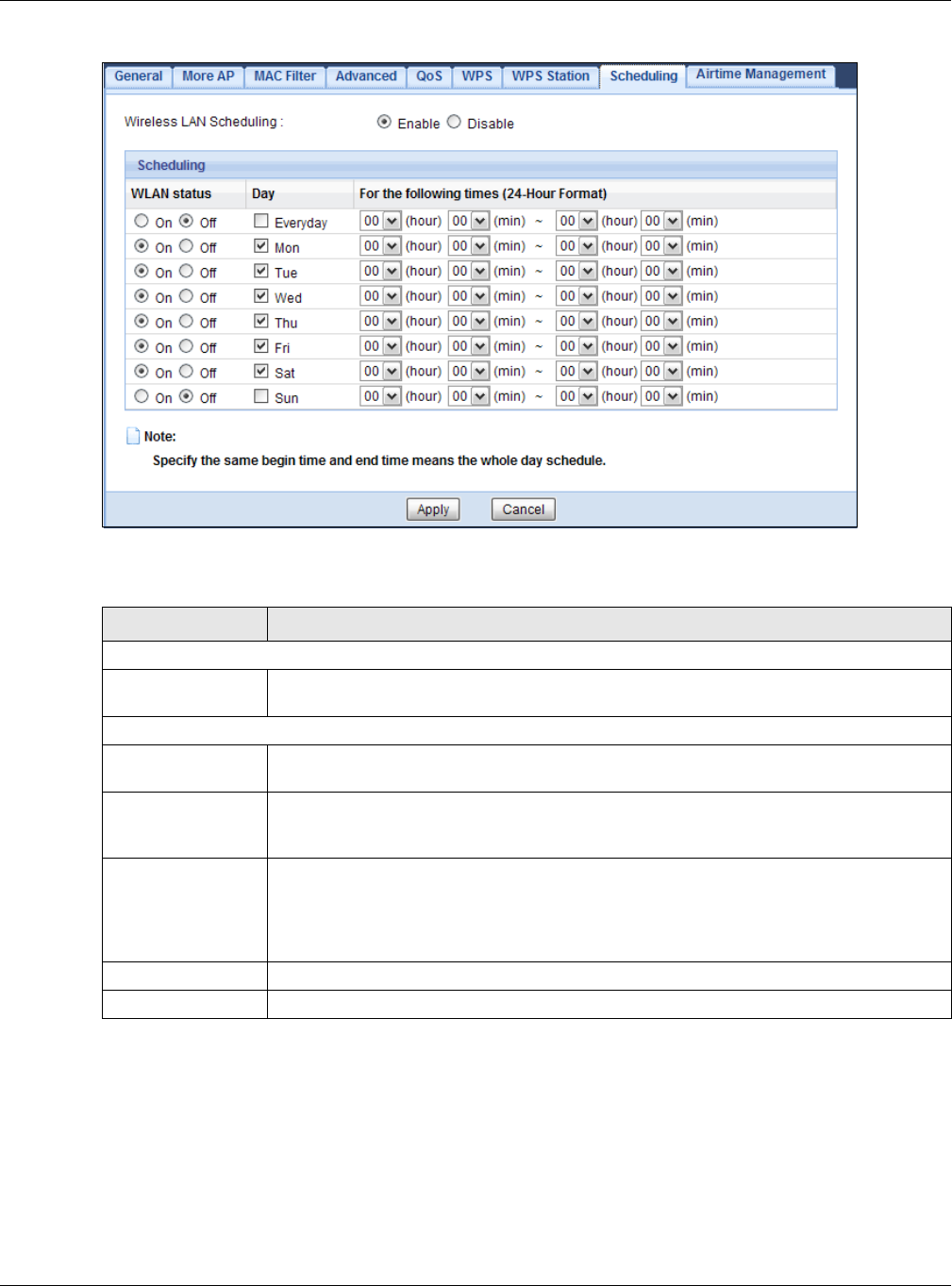
Chapter 9 Wireless LAN
EMG6765-Q10A User’s Guide
90
Figure 45 Network > Wireless LAN 2.4G/5G > Scheduling
The following table describes the labels in this screen.
9.11 Airtime Management Screen
Airtime is a period during which a Wi-Fi station transmits or receives data. Use this screen to manage the
time for Wi-Fi transmission traffic and improve the EMG6765-Q10A’s network performance. Airtime
management contributes to a consistent transmission by preventing clients or SSIDs from hogging the
Wi-Fi network, and affecting others throughput.
Table 29 Network > Wireless LAN 2.4G/5G > Scheduling
LABEL DESCRIPTION
Wireless LAN Scheduling
Wireless LAN
Scheduling
Select Enable to activate the wireless LAN scheduling feature. Select Disable to turn it off.
Scheduling
WLAN Status Select On or Off to specify whether the Wireless LAN is turned on or off. This field works in
conjunction with the Day and For the following times fields.
Day Select Everyday or the specific days to turn the Wireless LAN on or off. If you select Everyday
you can not select any specific days. This field works in conjunction with the For the following
times field.
For the following
times (24-Hour
Format)
Select a begin time using the first set of hour and minute (min) drop down boxes and select
an end time using the second set of hour and minute (min) drop down boxes. If you have
chosen On earlier for the WLAN Status the Wireless LAN will turn on between the two times
you enter in these fields. If you have chosen Off earlier for the WLAN Status the Wireless LAN
will turn off between the two times you enter in these fields.
Apply Click Apply to save your changes back to the EMG6765-Q10A.
Cancel Click Cancel to reload the previous configuration for this screen.
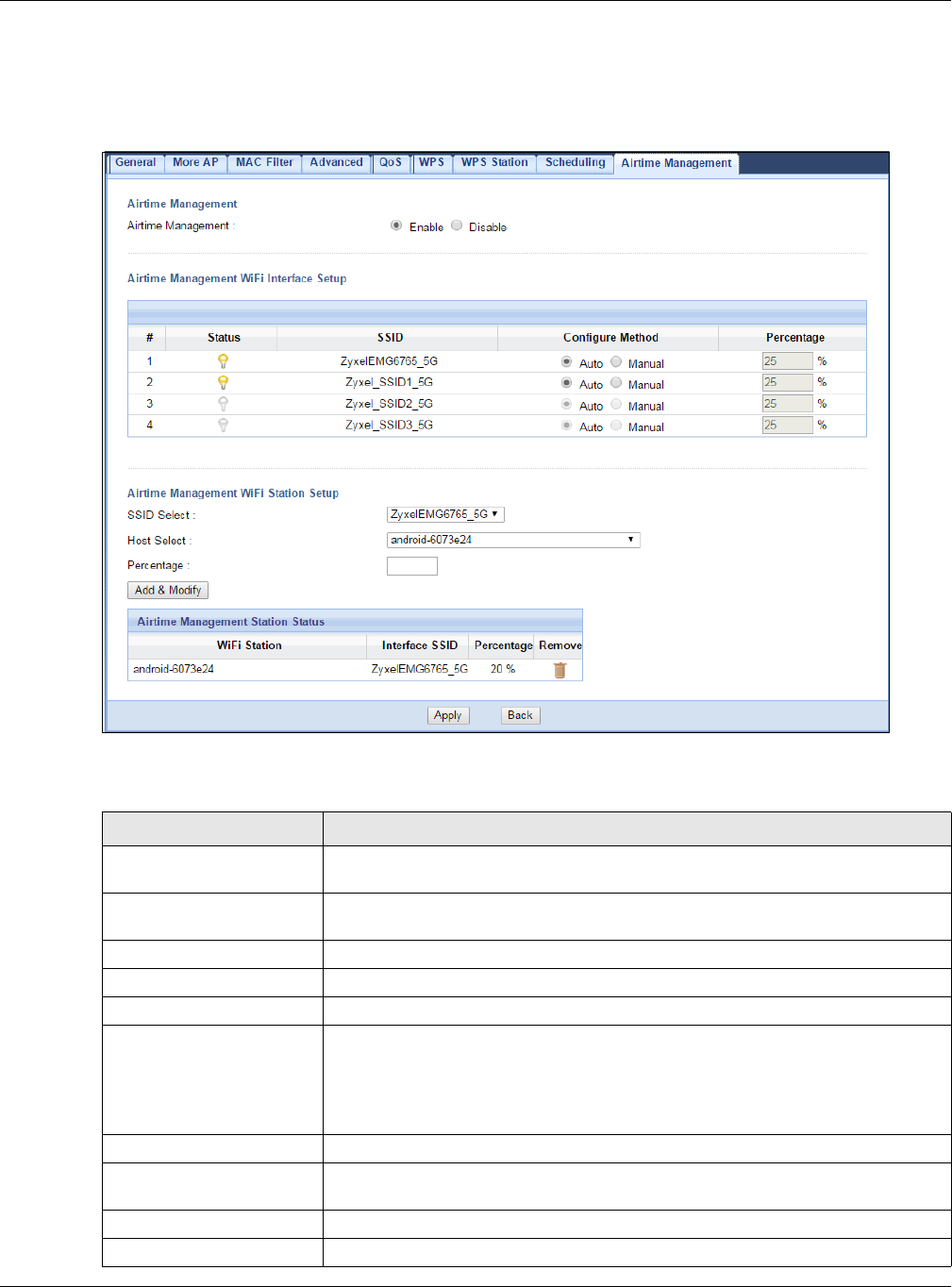
Chapter 9 Wireless LAN
EMG6765-Q10A User’s Guide
91
Use airtime management to allocate a percentage of available airtime to active SSID profiles in the
EMG6765-Q10A. You can also allocate airtime to hosts connected to the network. To open this screen,
click Network > Wireless LAN 2.4G/5G > Airtime Management.
Figure 46 Network > Wireless LAN 2.4G/5G > Airtime Management
The following table describes the labels in this screen.
Table 30 Network > Wireless LAN 2.4G/5G > Airtime Management
LABEL DESCRIPTION
Airtime Management Select Enable to activate the airtime management feature. Click Disable to turn it
off.
Airtime Management WiFi
Interface Setup
Use this to allocate a specific amount of time for an SSID’s transmissions.
# This is the index number of each SSID profile.
Status This shows whether the SSID profile is active (a yellow bulb) or not (a gray bulb).
SSID This field displays the name of the Wi-Fi network used in this SSID profile.
Configure Method Select Manual to configure the percentage of airtime this SSID profile has. Otherwise
select Auto for the EMG6765-Q10A to assign it automatically.
Note: To allocate airtime, the SSID profile’s status should be active in the
More AP screen.
Percentage Enter the percentage of time for the transmissions on this SSID profile.
Airtime Management WiFi
Station Setup
Use this to allocate a specific amount of time for transmissions of a Wi-Fi station
connected to the EMG6765-Q10A.
SSID Select Select the SSID the Wi-Fi station is connected to.
Host Select Select a Wi-Fi station to assign airtime.
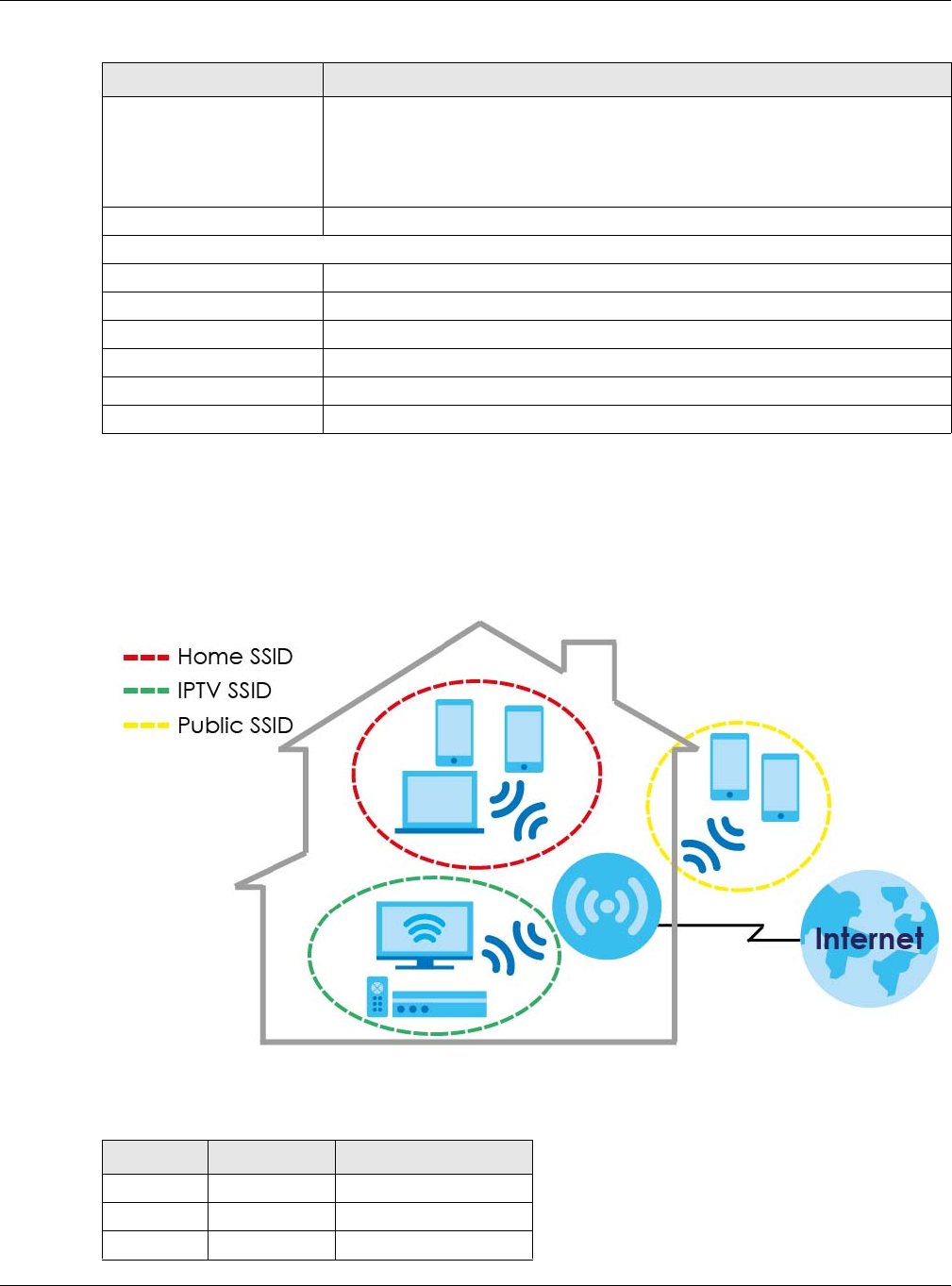
Chapter 9 Wireless LAN
EMG6765-Q10A User’s Guide
92
9.11.1 Airtime Management Scenarios
The figure below is used to explain some possible scenarios on how airtime management works in the
EMG6765-Q10A.
• Scenario 1. All active SSIDs can use all of the EMG6765-Q10A’s airtime. Make sure the airtime total is
100%. If you don’t allocate all airtime to active SSIDs, the remaining airtime will be lost.
Percentage Enter the percentage of time for the transmissions on this Wi-Fi station.
Note: The airtime per Wi-Fi Station is proportional to the airtime of the SSID
this station is connected to.
Add & Modify Click this to add or modify a Wi-Fi station airtime rule to the EMG6765-Q10A.
Airtime Management Station Status
WiFi Station This displays the name and MAC address of the Wi-Fi station.
Interface SSID This displays the SSID the Wi-Fi station is connected to.
Percentage This displays the percentage of airtime this Wi-Fi station has been assigned.
Remove Click this to remove the airtime rule.
Apply Click Apply to save your changes back to the EMG6765-Q10A.
Back Click Back to begin configuring this screen afresh.
Table 30 Network > Wireless LAN 2.4G/5G > Airtime Management
LABEL DESCRIPTION
Table 31 Scenario 1
SSID AIRTIME (%) CONFIGURE METHOD
Home SSID 40% Manual
IPTV SSID 50% Manual
Public SSID 10% Manual

Chapter 9 Wireless LAN
EMG6765-Q10A User’s Guide
93
•Scenario 2. If Home SSID and IPTV SSID take 100% of the airtime in Manual, no Airtime (0%) is allocated
to Public SSID, whether this SSID is in Auto or Manual. In this cases Manual will have priority over Auto.
• Scenario 3. If all active SSIDs are in Auto, the EMG6765-Q10A will assign equal percentages of airtime
to all active SSIDs.
• Scenario 4. Wi-Fi Stations airtime is proportional to the total airtime of the SSID they belong to. In this
scenario Wi-Fi Station A will take up 50% of the 40% assigned to Home SSID, which would be 40%*50%=
20%. Whereas Wi-Fi Station B will use 50% of the 10% assigned to Public SSID, which would be
10%*50%= 5%.
Table 32 Scenario 2
SSID AIRTIME (%) CONFIGURE METHOD
Home SSID 40% Manual
IPTV SSID 60% Manual
Public SSID 0% Auto
Table 33 Scenario 3
SSID AIRTIME (%) CONFIGURE METHOD
Home SSID 33.3% Auto
IPTV SSID 33.3% Auto
Public SSID 33.3% Auto
Table 34 Scenario 4
SSID SSID AIRTIME (%) WI-FI STATION WI-FI STATION AIRTIME (%) CONFIGURE METHOD
Home SSID 40% A 50% Manual
IPTV SSID 50% Manual
Public SSID 10% B 50% Manual
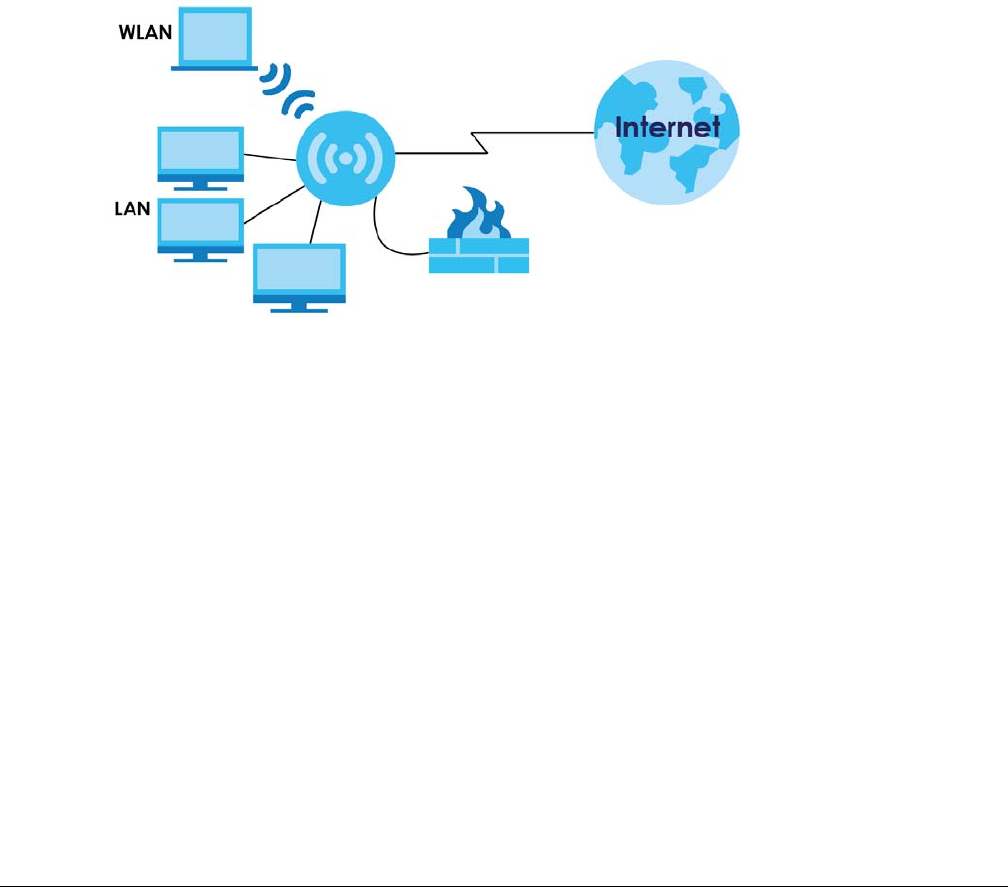
EMG6765-Q10A User’s Guide
94
CHAPTER 10
LAN
10.1 Overview
This chapter describes how to configure LAN settings.
A Local Area Network (LAN) is a shared communication system to which many computers are
attached. A LAN is a computer network limited to the immediate area, usually the same building or floor
of a building.
Figure 47 LAN Example
The LAN screens can help you configure a manage IP address, and partition your physical network into
logical networks.
10.2 What You Can Do
• Use the IP screen to change the IP address for your EMG6765-Q10A (Section 10.4 on page 96).
• Use the IP Alias screen to have the EMG6765-Q10A apply IP alias to create LAN subnets (Section 10.5
on page 96).
• Use the IPv6 LAN screen to configure the IPv6 address for your EMG6765-Q10A on the LAN (Section
10.6 on page 97).
• Use the IGMP Snooping screen to enable IGMP Snooping and configure IGMP modes. (Section 10.7
on page 98).
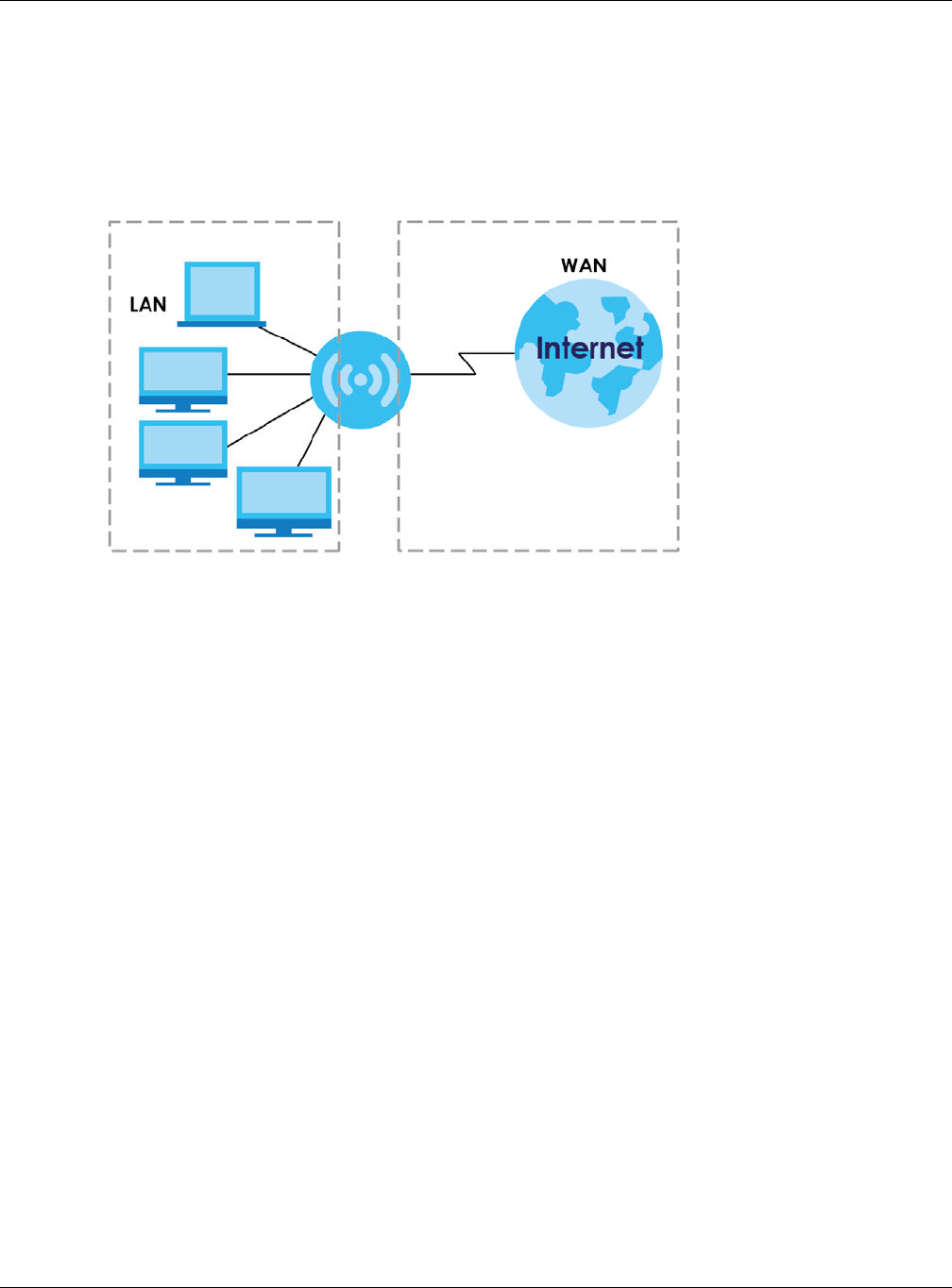
Chapter 10 LAN
EMG6765-Q10A User’s Guide
95
10.3 What You Need To Know
The actual physical connection determines whether the EMG6765-Q10A ports are LAN or WAN ports.
There are two separate IP networks, one inside the LAN network and the other outside the WAN network
as shown next.
Figure 48 LAN and WAN IP Addresses
The LAN parameters of the EMG6765-Q10A are preset in the factory with the following values:
• IP address of 192.168.1.1 with subnet mask of 255.255.255.0 (24 bits)
• DHCP server enabled with 32 client IP addresses starting from 192.168.1.33.
These parameters should work for the majority of installations. If your ISP gives you explicit DNS server
address(es), read the embedded Web Configurator help regarding what fields need to be configured.
10.3.1 IP Pool Setup
The EMG6765-Q10A is pre-configured with a pool of 32 IP addresses starting from 192.168.1.33 to
192.168.1.64. This configuration leaves 31 IP addresses (excluding the EMG6765-Q10A itself) in the lower
range (192.168.1.2 to 192.168.1.32) for other server computers, for instance, servers for mail, FTP, TFTP,
web, etc., that you may have.
10.3.2 LAN TCP/IP
The EMG6765-Q10A has built-in DHCP server capability that assigns IP addresses and DNS servers to
systems that support DHCP client capability.
10.3.3 IP Alias
IP alias allows you to partition a physical network into different logical networks over the same Ethernet
interface. The EMG6765-Q10A supports three logical LAN interfaces via its single physical Ethernet
interface with the EMG6765-Q10A itself as the gateway for each LAN network.
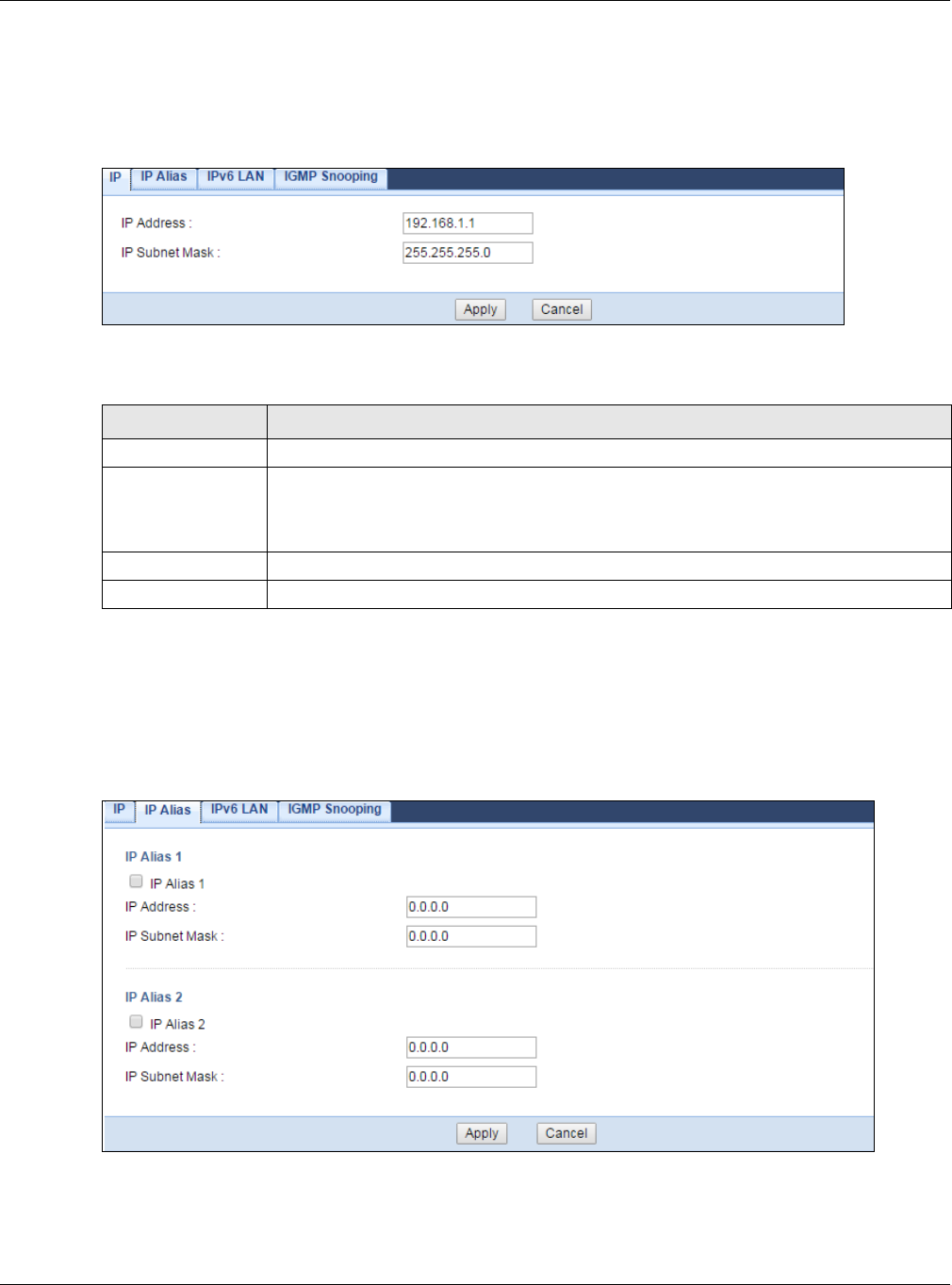
Chapter 10 LAN
EMG6765-Q10A User’s Guide
96
10.4 LAN IP Screen
Use this screen to change the IP address for your EMG6765-Q10A. Click Network > LAN > IP.
Figure 49 Network > LAN > IP
The following table describes the labels in this screen.
10.5 IP Alias Screen
Use this screen to have the EMG6765-Q10A apply IP alias to create LAN subnets. Click LAN > IP Alias.
Figure 50 Network > LAN > IP Alias
Table 35 Network > LAN > IP
LABEL DESCRIPTION
IP Address Type the IP address of your EMG6765-Q10A in dotted decimal notation.
IP Subnet Mask The subnet mask specifies the network number portion of an IP address. Your EMG6765-
Q10A will automatically calculate the subnet mask based on the IP address that you assign.
Unless you are implementing subnetting, use the subnet mask computed by the EMG6765-
Q10A.
Apply Click Apply to save your changes back to the EMG6765-Q10A.
Cancel Click Cancel to begin configuring this screen afresh.
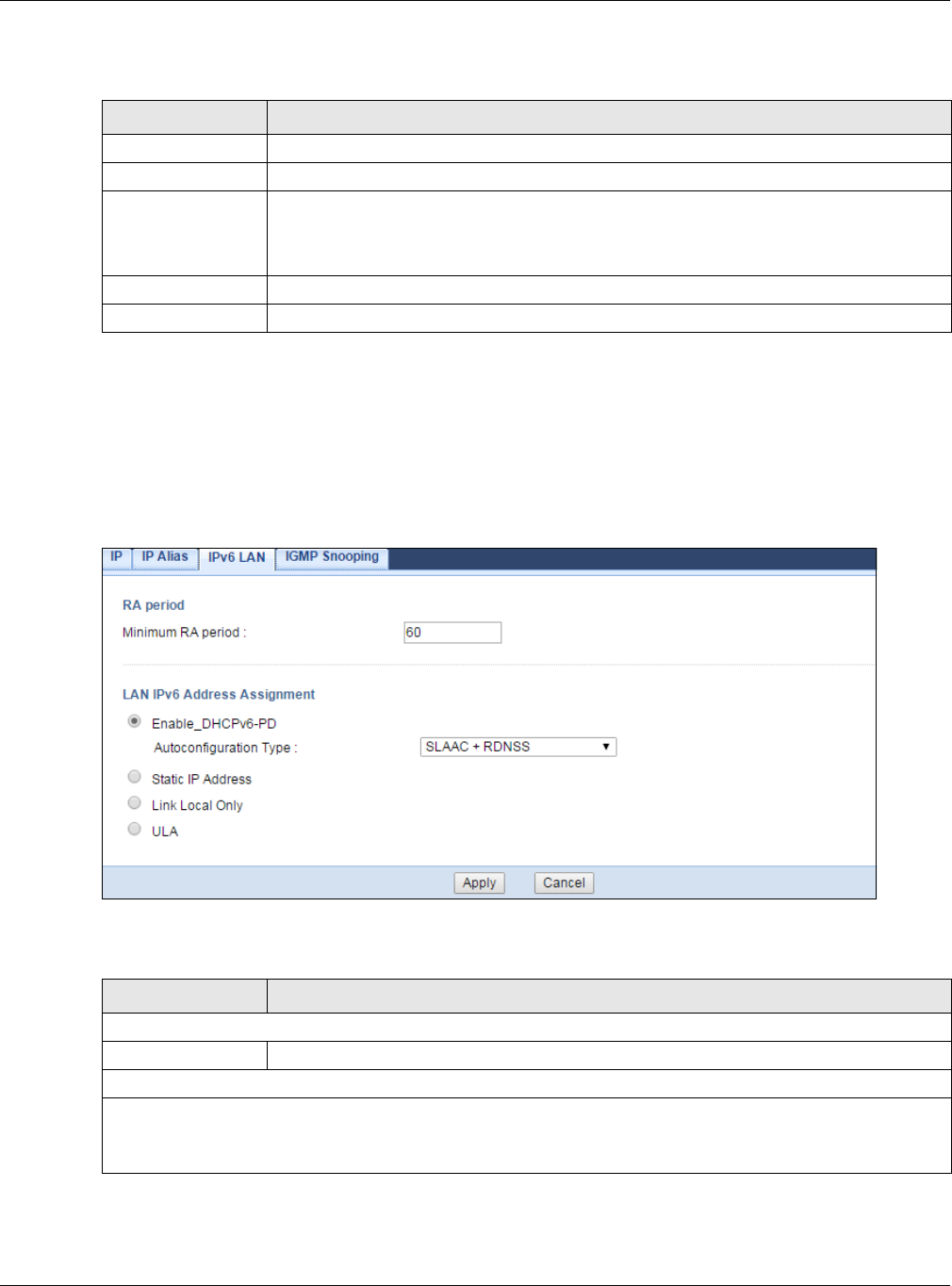
Chapter 10 LAN
EMG6765-Q10A User’s Guide
97
The following table describes the labels in this screen.
10.6 IPv6 LAN Screen
Use this screen to configure the IPv6 address for your EMG6765-Q10A on the LAN. Click Network > LAN >
IPv6 LAN.
Figure 51 Network > LAN > IPv6 LAN
The following table describes the labels on this screen.
Table 36 Network > LAN > IP Alias
LABEL DESCRIPTION
IP Alias 1, 2 Check this to enable IP alias to configure another LAN network for the EMG6765-Q10A.
IP Address Type the IP alias address of your EMG6765-Q10A in dotted decimal notation.
IP Subnet Mask The subnet mask specifies the network number portion of an IP address. Your EMG6765-
Q10A will automatically calculate the subnet mask based on the IP address that you assign.
Unless you are implementing subnetting, use the subnet mask computed by the EMG6765-
Q10A.
Apply Click Apply to save your changes back to the EMG6765-Q10A.
Cancel Click Cancel to begin configuring this screen afresh.
Table 37 Network > LAN > IPv6 LAN
LABEL DESCRIPTION
RA period
Minimum RA period Enter the minimum time in seconds between router advertisement messages.
LAN IPv6 Address Assignment
Enable DHCPv6-PD
Select this option to use DHCPv6 prefix delegation. The EMG6765-Q10A will obtain an IPv6 prefix from the ISP or
a connected uplink router for the LAN.
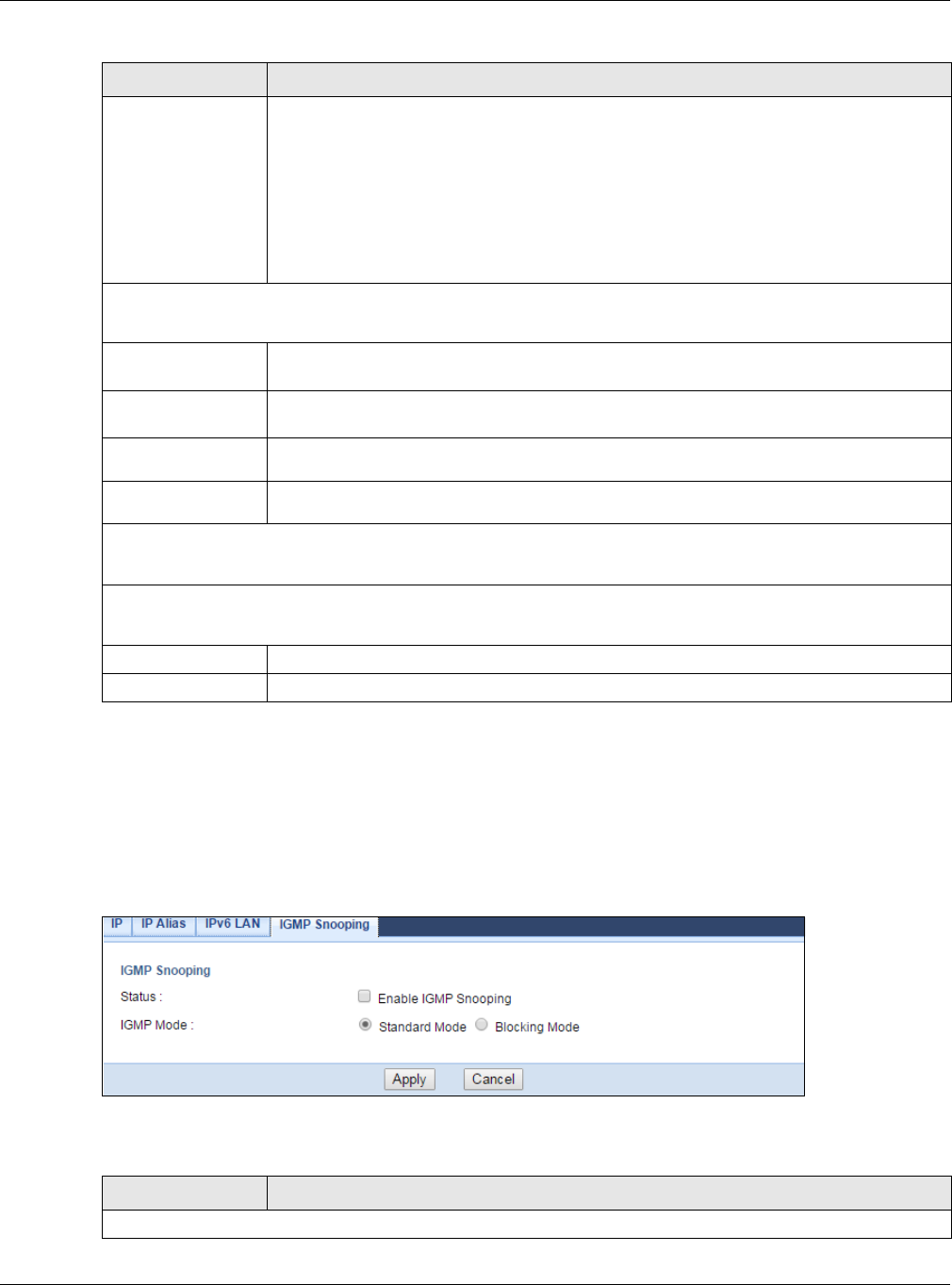
Chapter 10 LAN
EMG6765-Q10A User’s Guide
98
10.7 IGMP Snooping Screen
Use this screen to enable IGMP Snooping and configure IGMP mode. Click Network > LAN > IGMP
Snooping.
Figure 52 Network > LAN > IGMP Snooping
The following table describes the labels on this screen.
Autoconfiguration
Type
Select SLAAC + RDNSS to enable IPv6 stateless auto-configuration on this interface. The
interface will generate an IPv6 IP address itself from a prefix obtained from an IPv6 router in
the network.
Select SLAAC + Stateless DHCPv6 to enable IPv6 stateless auto-configuration on this
interface. The interface will get an IPv6 address from an IPv6 router and the DHCP server. The
IP address information gets through DHCPv6.
Select Stateful DHCPv6 to allow a DHCP server to assign and pass IPv6 network addresses,
prefixes and other configuration information to DHCP clients.
Static IP Address
Select this option to manually enter an IPv6 address if you want to use a static IP address.
LAN IPv6
Address Enter the LAN IPv6 address you want to assign to your EMG6765-Q10A in hexadecimal
notation.
LAN IPv6 Prefix
Length (48~64) Enter the 48 to 64 address prefix length to specify in an IPv6 address compose the network
address.
Prefix Preferred
Lifetime Enter the preferred lifetime for the prefix.
Prefix Valid
Lifetime Enter the valid lifetime for the prefix.
Link Local Only
Select this option to only use the link local address on the EMG6765-Q10A interfaces in the LAN.
ULA
Select this option to identify a unique local address of the EMG6765-Q10A in the LAN.
Apply Click Apply to save your changes with the EMG6765-Q10A.
Cancel Click Cancel to begin configuring this screen afresh.
Table 37 Network > LAN > IPv6 LAN (continued)
LABEL DESCRIPTION
Table 38 Network > LAN > IGMP Snooping
LABEL DESCRIPTION
IGMP Snooping

Chapter 10 LAN
EMG6765-Q10A User’s Guide
99
Status Select this option to activate IGMP snooping. This allows the EMG6765-Q10A to passively
learn multicast group.
IGMP Mode Select Standard Mode to have the EMG6765-Q10A forward multicast packets to a port that
joins the multicast group and broadcast unknown multicast packets from the WAN to all
LAN ports.
Select Blocking Mode to have the EMG6765-Q10A block all unknown multicast packets from
the WAN.
Apply Click Apply to save your changes with the EMG6765-Q10A.
Cancel Click Cancel to begin configuring this screen afresh.
Table 38 Network > LAN > IGMP Snooping (continued)
LABEL DESCRIPTION
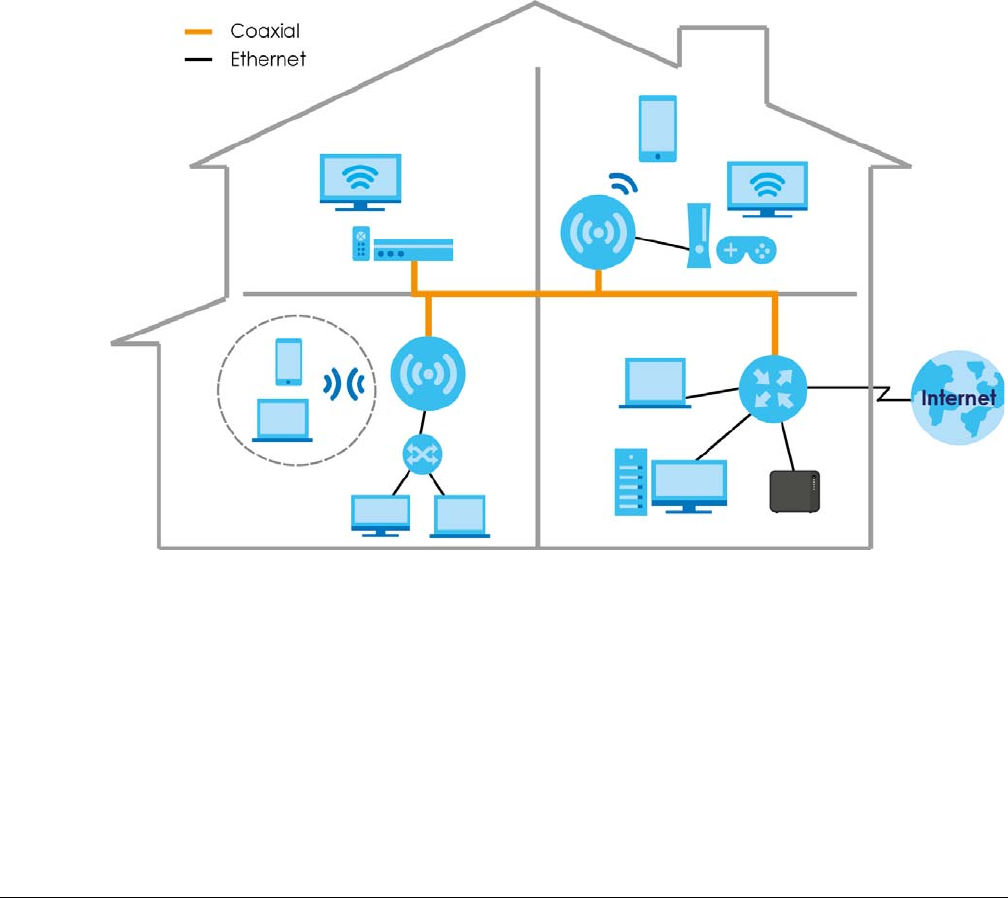
EMG6765-Q10A User’s Guide
100
CHAPTER 11
MoCA
11.1 Overview
MoCA (Multimedia over Coax Alliance) is an industry standard organization, which created a standard
for transferring data and multimedia content over the existing coaxial wires in your home. Data
communication and audio/video streaming are allowed at the same time. The EMG6765-Q10A (A)
automatically sets up a MoCA network when multiple MoCA devices (nodes) are powered on and
connected with a coaxial cable.
The EMG6765-Q10A supports MoCA 2.0 and is backward compatible with MoCA 1.1. The MoCA 1.1
technology provides 175 Mbps net throughputs (270 Mbps PHY rate) and operates in the 500 to 1500
MHz frequency range. MoCA 2.0 in turbo mode offers actual data rates of up to 1 Gbps MAC
throughputs and operates in the 500 to 1650 MHz operating frequency range. MoCA 2.0 also supports
improved packet error rate (PER) and two new power saving modes: Standby (reduced power) and
Sleep (minimum power).
The EMG6765-Q10A should be connected to the WAN via Ethernet, then the coaxial network in your
home will only work as a LAN.
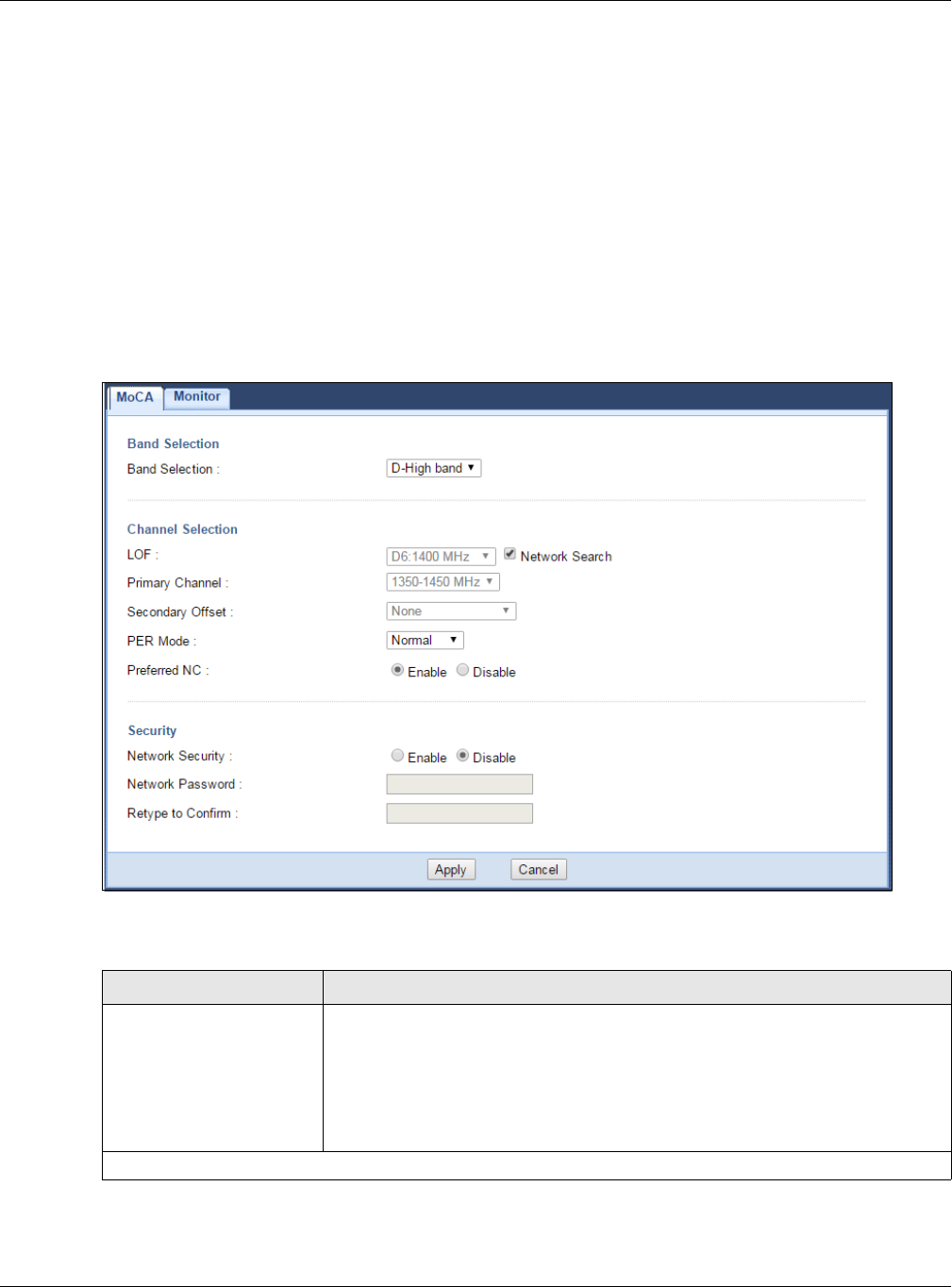
Chapter 11 MoCA
EMG6765-Q10A User’s Guide
101
11.2 What You Can Do
• Use the MoCA screen (Section 11.3 on page 101) to set the MoCA Privacy, and enable multimedia
and home networking over coaxial cabling.
• Use the MoCA > Monitor screen (Section 11.4 on page 103) to view the MoCA network status and
information about the connected MoCA devices (nodes).
11.3 MoCA Screen
Use this screen to change the MoCA settings for your EMG6765-Q10A. Click Network > MoCA.
Figure 53 Network > MoCA
The following table describes the labels in this screen.
Table 39 Network > MoCA
LABEL DESCRIPTION
Band Selection In MoCA frequency band plans, there are bands A, B, C1, C2, C3, C4, D, E, F, G, and
H. The extended band D in MoCA 2.0 is between 1125 MHz and 1675 MHz. Two sub-
bands (D-Low and D-High) are defined within the extended band D.
• Sub-band D-Low (DL): 1125 to 1225 MHz edge to edge (100 MHz wide)
• Sub-band D-High (DH): 1350 to 1675 MHz edge to edge (325 MHz wide)
At the time of setting, the EMG6765-Q10A supports the sub-band D-High only.
Channel Selection

Chapter 11 MoCA
EMG6765-Q10A User’s Guide
102
LOF Last Operational Frequency (LOF) is the last RF channel center frequency which a
MoCA device (node) will automatically turn to when it is last in the linkup state,
The center frequency of a channel is a central frequency in the middle of the upper
cutoff and lower cutoff frequencies.
If you clear the Network Search check box, manually select an operating frequency
from the drop-down list.
Network Search Select the check box to enable auto scan for the operating frequency.
Primary Channel Select the first operating frequency range if you clear the Network Search check
box.
The field options vary depending on the center frequency you select in the LOF field.
Secondary Offset Select the second operating frequency range if you clear the Network Search
check box.
Select None if you do not want to specify a second channel.
Select Above to have the EMG6765-Q10A use a frequency higher than the upper
edge of the selected primary channel.
Select Below to have the EMG6765-Q10A use a frequency less than the lower edge
of the selected primary channel.
PER Mode The Packet Error Rate (PER) indicates the ratio between the total number of
incorrectly received data packets and the total number of transmitted data
packets. The total number of transmitted packets is at least 100,000,000 when the
PER mode is NPER (Normal PER) and at least 10,000,000,000 when the PER mode is
VLPER (Very Low PER). In very low PER mode, the physical data rate will be
decreased in order to achieve a lower packet error rate.
Select Normal to set the PER mode to NPER. Otherwise, select Very Low to set the
PER mode to VLPER.
Preferred NC The Network Coordinator (NC) is a node that performs the following functions in a
MoCA network: beacon generation, MAP (Medium Allocation Plan) generation,
admission of new MoCA nodes to the network, privacy key generation and
distribution, and LMO (Link Maintenance Operation) scheduling. The NC is
dynamically selected from all the MoCA nodes in the network. There is only one NC
in a MoCA network and the rest of the MoCa nodes in the MoCA network are
clients.
Select Enable to configure the EMG6765-Q10A as a preferred network coordinator.
The preferred NC has an advantage in the NC selection.
Security
Network Security Select Enable to turn on MoCA privacy. If this is enabled, all MoCA devices
connected via coaxial cables must use the same password.
Network Password Enter the password for the MoCA network. All packets in the MoCA network are
encrypted except for beacons. The password should be 12 to 17 ASCII characters
long.
Retype to Confirm Enter the password again for confirmation.
Apply Click Apply to save your changes back to the EMG6765-Q10A.
Cancel Click Cancel to reload the previous configuration for this screen.
Table 39 Network > MoCA
LABEL DESCRIPTION
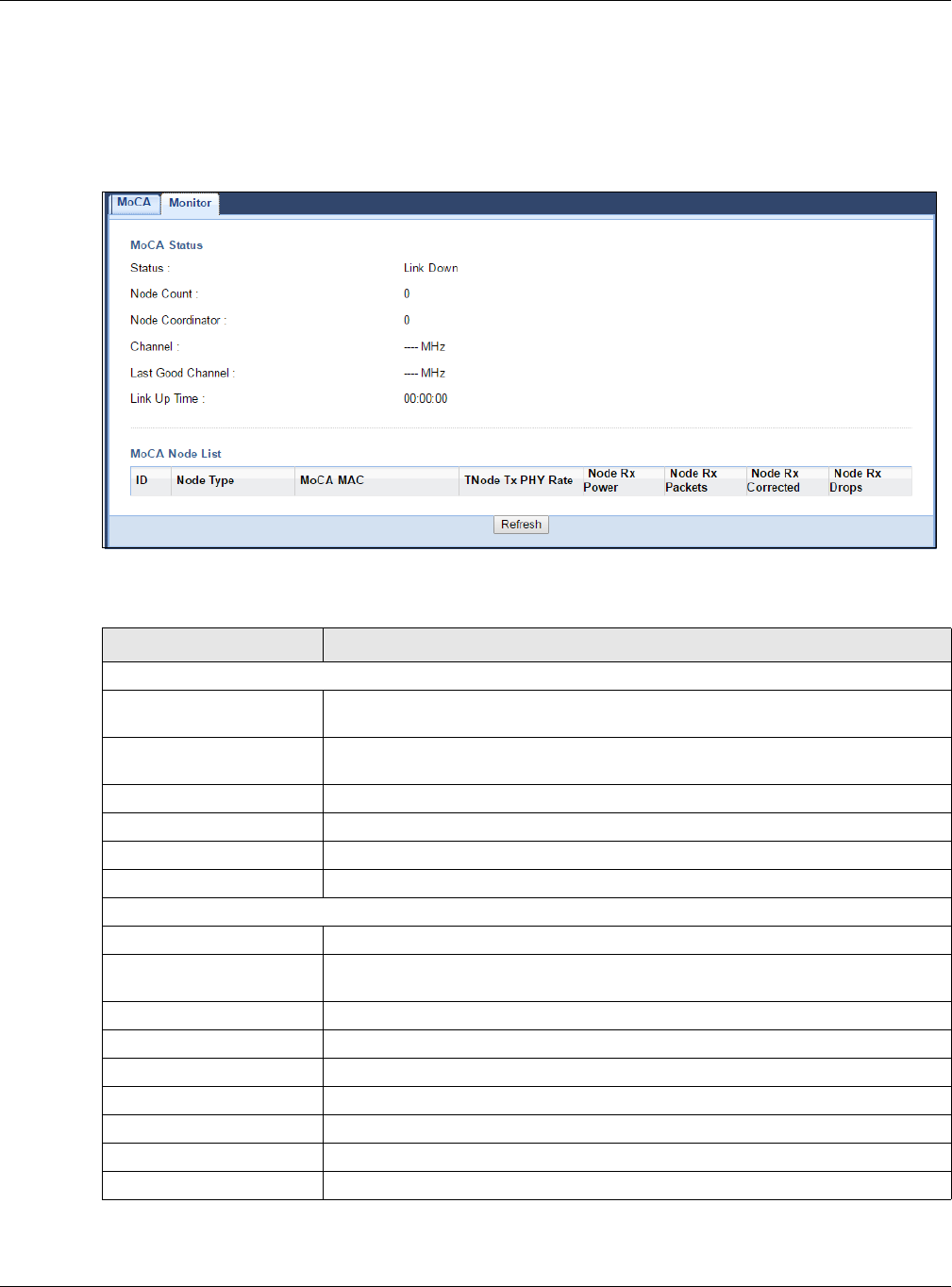
Chapter 11 MoCA
EMG6765-Q10A User’s Guide
103
11.4 MoCA Monitor Screen
Use this screen to view the MoCA network status and information about the connected MoCA devices
(nodes). Click Network > MoCA > Monitor.
Figure 54 Network > MoCA > Monitor
The following table describes the labels in this screen.
Table 40 Network > MoCA > Monitor
LABEL DESCRIPTION
MoCA Status
Status This shows the MoCA network status. It displays Link Up if the EMG6765-Q10A joins the
MoCA network successfully. Otherwise, it displays Link Down.
Node Count This shows the number of the nodes (including the EMG6765-Q10A) present in the
MoCA network.
Node Coordinator This shows the ID of the network coordinator in the MoCA network.
Channel This shows the primary channel frequency at which the EMG6765-Q10A is operating.
Last Good Channel This shows the last RF channel center frequency you configured in the MoCA screen.
Link Up Time This displays how long the connection with other MoCA node(s) has been up.
MoCA Node List
ID This shows the node ID in the MoCA network.
Node Type This shows whether the MoCA node is acting as a Client or an NC (Network
Coordinator)
MoCA MAC This shows the MAC address of the MoCA node.
TNode Tx PHY Rate This shows the transmitted PHY rate in Mbps from the MoCA node.
Node Rx Power This shows the MoCA node’s power consumption (in dBm) of receiving.
Node Rx Packets This shows the number of packets received by the MoCA node.
Node Rx Corrected This shows the number of packets corrected and received by the MoCA node.
Node Rx Drops This shows the number of packets dropped by the MoCA node.
Refresh Click this button to renew the screen.

EMG6765-Q10A User’s Guide
104
CHAPTER 12
DHCP Server
12.1 Overview
DHCP (Dynamic Host Configuration Protocol, RFC 2131 and RFC 2132) allows individual clients to obtain
TCP/IP configuration at start-up from a server. You can configure the EMG6765-Q10A’s LAN as a DHCP
server or disable it. When configured as a server, the EMG6765-Q10A provides the TCP/IP configuration
for the clients. If DHCP service is disabled, you must have another DHCP server on your LAN, or else the
computer must be manually configured.
12.1.1 What You Can Do
• Use the General screen to enable the DHCP server (Section 12.2 on page 104).
• Use the Advanced screen to assign IP addresses on the LAN to specific individual computers based
on their MAC Addresses (Section 12.3 on page 105).
• Use the Client List screen to view the current DHCP client information (Section 12.4 on page 107).
12.1.2 What You Need To Know
The following terms may help as you read through this chapter.
MAC Addresses
Every Ethernet device has a unique MAC (Media Access Control) address. The MAC address is assigned
at the factory and consists of six pairs of hexadecimal characters, for example, 00:A0:C5:00:00:02. Find
out the MAC addresses of your network devices if you intend to add them to the DHCP Client List screen.
12.2 DHCP Server General Screen
Use this screen to enable the DHCP server. Click Network > DHCP Server. The following screen displays.
Figure 55 Network > DHCP Server > General

Chapter 12 DHCP Server
EMG6765-Q10A User’s Guide
105
The following table describes the labels in this screen.
12.3 DHCP Server Advanced Screen
This screen allows you to assign IP addresses on the LAN to specific individual computers based on their
MAC addresses. You can also use this screen to configure the DNS server information that the EMG6765-
Q10A sends to the DHCP clients.
To change your EMG6765-Q10A’s static DHCP settings, click Network > DHCP Server > Advanced. The
following screen displays.
Table 41 Network > DHCP Server > General
LABEL DESCRIPTION
DHCP Server Select Enable to activate DHCP for LAN.
DHCP (Dynamic Host Configuration Protocol, RFC 2131 and RFC 2132) allows individual
clients (computers) to obtain TCP/IP configuration at startup from a server. Enable the
DHCP server unless your ISP instructs you to do otherwise. Select Disable to stop the
EMG6765-Q10A acting as a DHCP server. When configured as a server, the EMG6765-
Q10A provides TCP/IP configuration for the clients. If not, DHCP service is disabled and
you must have another DHCP server on your LAN, or else the computers must be manually
configured. When set as a server, fill in the following four fields.
IP Pool Starting Address This field specifies the first of the contiguous addresses in the IP address pool for LAN.
Pool Size This field specifies the size, or count of the IP address pool for LAN.
Lease Time This field specifies how long an individual client can use an IP address before it has to
request a new one.
Apply Click Apply to save your changes back to the EMG6765-Q10A.
Cancel Click Cancel to begin configuring this screen afresh.
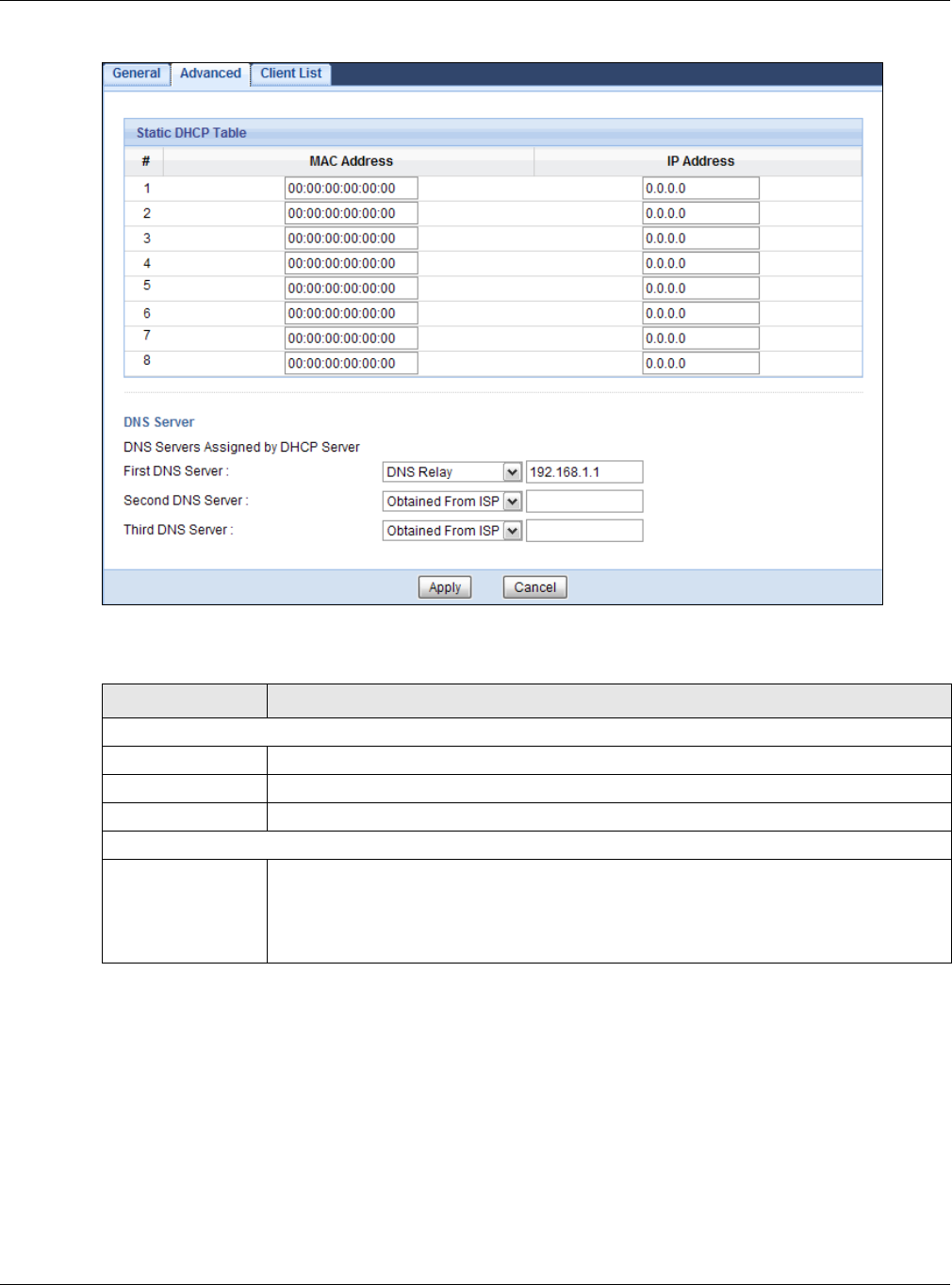
Chapter 12 DHCP Server
EMG6765-Q10A User’s Guide
106
Figure 56 Network > DHCP Server > Advanced
The following table describes the labels in this screen.
Table 42 Network > DHCP Server > Advanced
LABEL DESCRIPTION
Static DHCP Table
# This is the index number of the static IP table entry (row).
MAC Address Type the MAC address (with colons) of a computer on your LAN.
IP Address Type the LAN IP address of a computer on your LAN.
DNS Server
DNS Servers
Assigned by DHCP
Server
The EMG6765-Q10A passes a DNS (Domain Name System) server IP address (in the order you
specify here) to the DHCP clients. The EMG6765-Q10A only passes this information to the LAN
DHCP clients when you enable DHCP Server. When you disable DHCP Server, DHCP service is
disabled and you must have another DHCP sever on your LAN, or else the computers must
have their DNS server addresses manually configured.
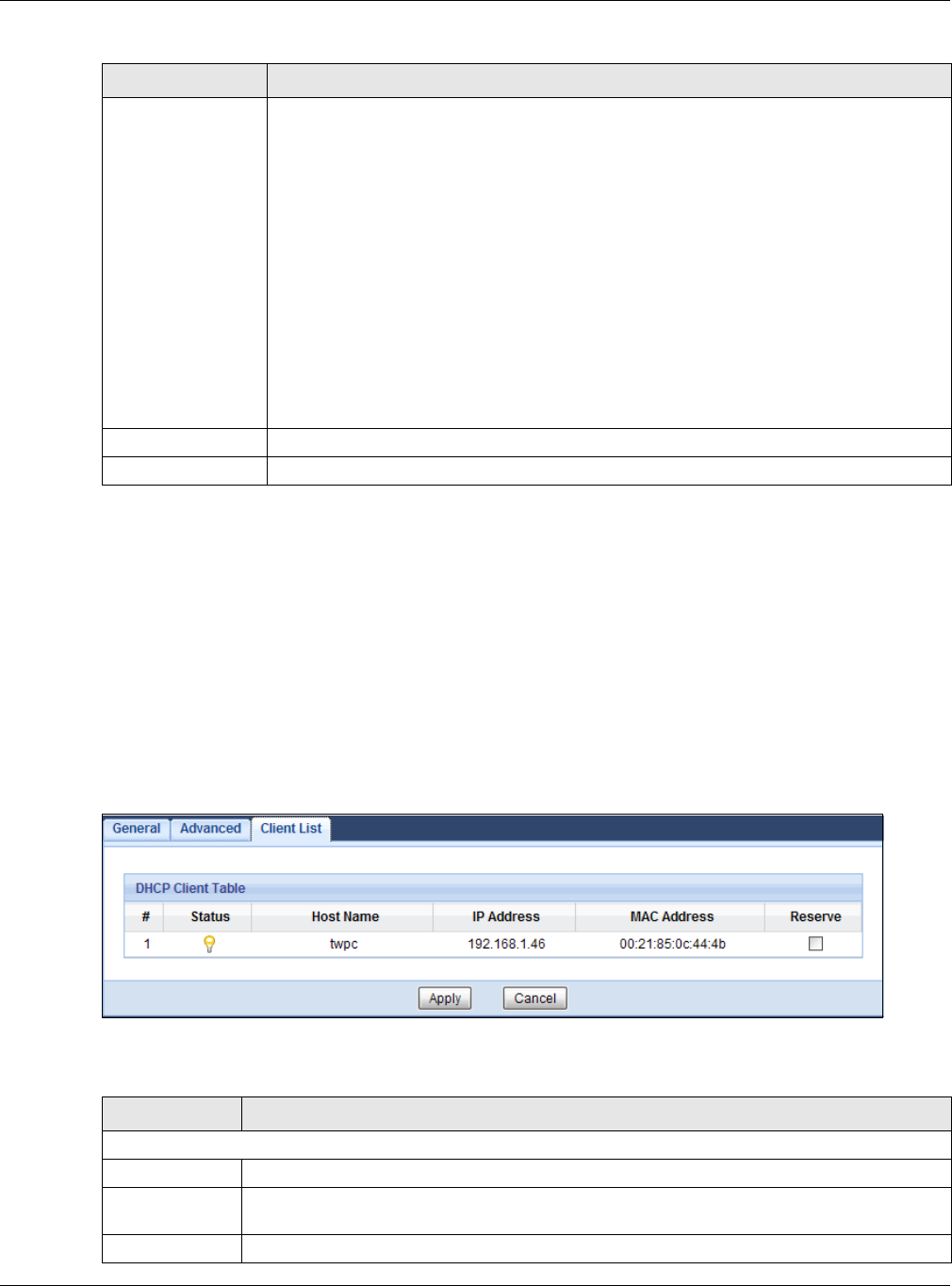
Chapter 12 DHCP Server
EMG6765-Q10A User’s Guide
107
12.4 DHCP Client List Screen
The DHCP table shows current DHCP client information (including IP Address, Host Name and MAC
Address) of network clients using the EMG6765-Q10A’s DHCP servers.
Configure this screen to always assign an IP address to a MAC address (and host name). Click Network
> DHCP Server > Client List.
Note: You can also view a read-only client list by clicking Monitor > DHCP Server.
Figure 57 Network > DHCP Server > Client List
The following table describes the labels in this screen.
First DNS Server
Second DNS Server
Third DNS Server
Select Obtained From ISP if your ISP dynamically assigns DNS server information (and the
EMG6765-Q10A's WAN IP address). The field to the right displays the (read-only) DNS server IP
address that the ISP assigns.
Select User-Defined if you have the IP address of a DNS server. Enter the DNS server's IP
address in the field to the right.
Select DNS Relay to have the EMG6765-Q10A act as a DNS proxy. The EMG6765-Q10A's LAN
IP address displays in the field to the right (read-only). The EMG6765-Q10A tells the DHCP
clients on the LAN that the EMG6765-Q10A itself is the DNS server. When a computer on the
LAN sends a DNS query to the EMG6765-Q10A, the EMG6765-Q10A forwards the query to
the EMG6765-Q10A's system DNS server (configured in the WAN screen) and relays the
response back to the computer. You can only select DNS Relay for one of the three servers;
if you select DNS Relay for a second or third DNS server, that choice changes to None after
you click Apply.
Select None if you do not want to configure DNS servers. If you do not configure a DNS
server, you must know the IP address of a computer in order to access it.
Apply Click Apply to save your changes back to the EMG6765-Q10A.
Cancel Click Cancel to begin configuring this screen afresh.
Table 42 Network > DHCP Server > Advanced (continued)
LABEL DESCRIPTION
Table 43 Network > DHCP Server > Client List
LABEL DESCRIPTION
DHCP Client Table
# This is the index number of the host computer.
Status This field displays whether the connection to the host computer is up (a yellow bulb) or down (a
gray bulb).
Host Name This field displays the computer host name.

Chapter 12 DHCP Server
EMG6765-Q10A User’s Guide
108
IP Address This field displays the IP address relative to the # field listed above.
MAC Address This field shows the MAC address of the computer with the name in the Host Name field.
Every Ethernet device has a unique MAC (Media Access Control) address which uniquely
identifies a device. The MAC address is assigned at the factory and consists of six pairs of
hexadecimal characters, for example, 00:A0:C5:00:00:02.
Reserve Select this if you want to reserve the IP address for this specific MAC address.
Apply Click Apply to save your changes back to the EMG6765-Q10A.
Cancel Click Cancel to reload the previous configuration for this screen.
Table 43 Network > DHCP Server > Client List (continued)
LABEL DESCRIPTION
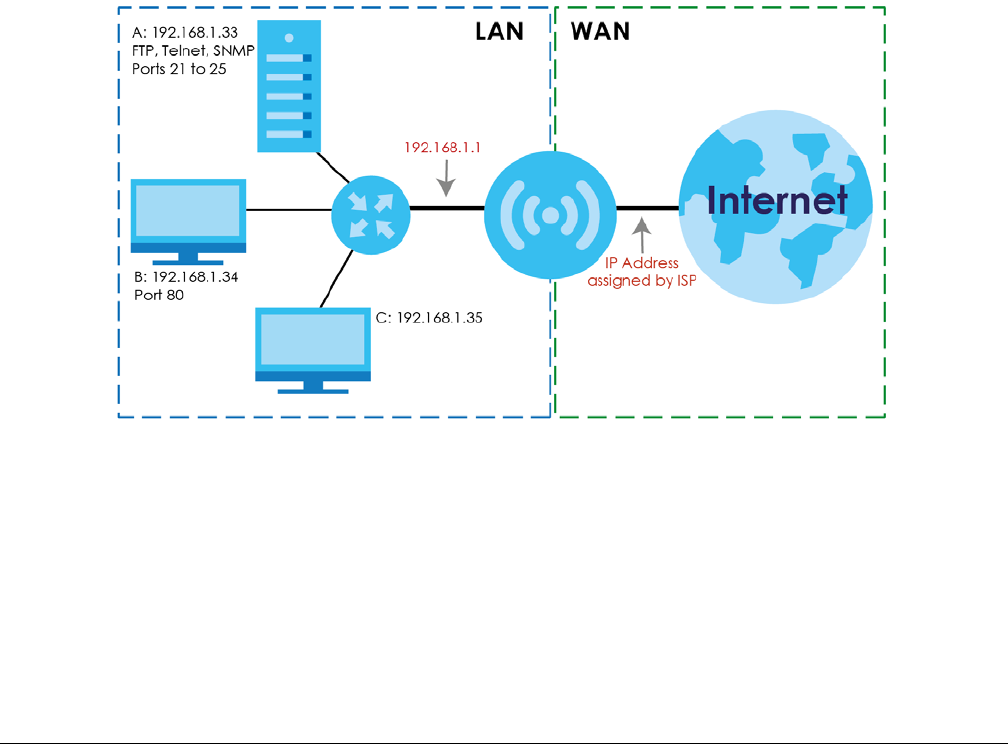
EMG6765-Q10A User’s Guide
109
CHAPTER 13
NAT
13.1 Overview
NAT (Network Address Translation - NAT, RFC 1631) is the translation of the IP address of a host in a
packet. For example, the source address of an outgoing packet, used within one network is changed to
a different IP address known within another network.
The figure below is a simple illustration of a NAT network. You want to assign ports 21-25 to one FTP, Telnet
and SMTP server (A in the example), port 80 to another (B in the example) and assign a default server IP
address of 192.168.1.35 to a third (C in the example).
You assign the LAN IP addresses to the devices (A to D) connected to your EMG6765-Q10A. The ISP
assigns the WAN IP address. The NAT network appears as a single host on the Internet. All traffic coming
from A to D going out to the Internet use the IP address of the EMG6765-Q10A, which is 192.168.1.1.
Figure 58 NAT Example
This chapter discusses how to configure NAT on the EMG6765-Q10A.
Note: You must create a firewall rule in addition to setting up NAT, to allow traffic from the
WAN to be forwarded through the EMG6765-Q10A.
13.1.1 What You Can Do
• Use the General screen to enable NAT (Section 13.2 on page 111).
• Use the Port Forwarding screen to set a default server and change your EMG6765-Q10A’s port
forwarding settings to forward incoming service requests to the server(s) on your local network
(Section 13.3 on page 112).
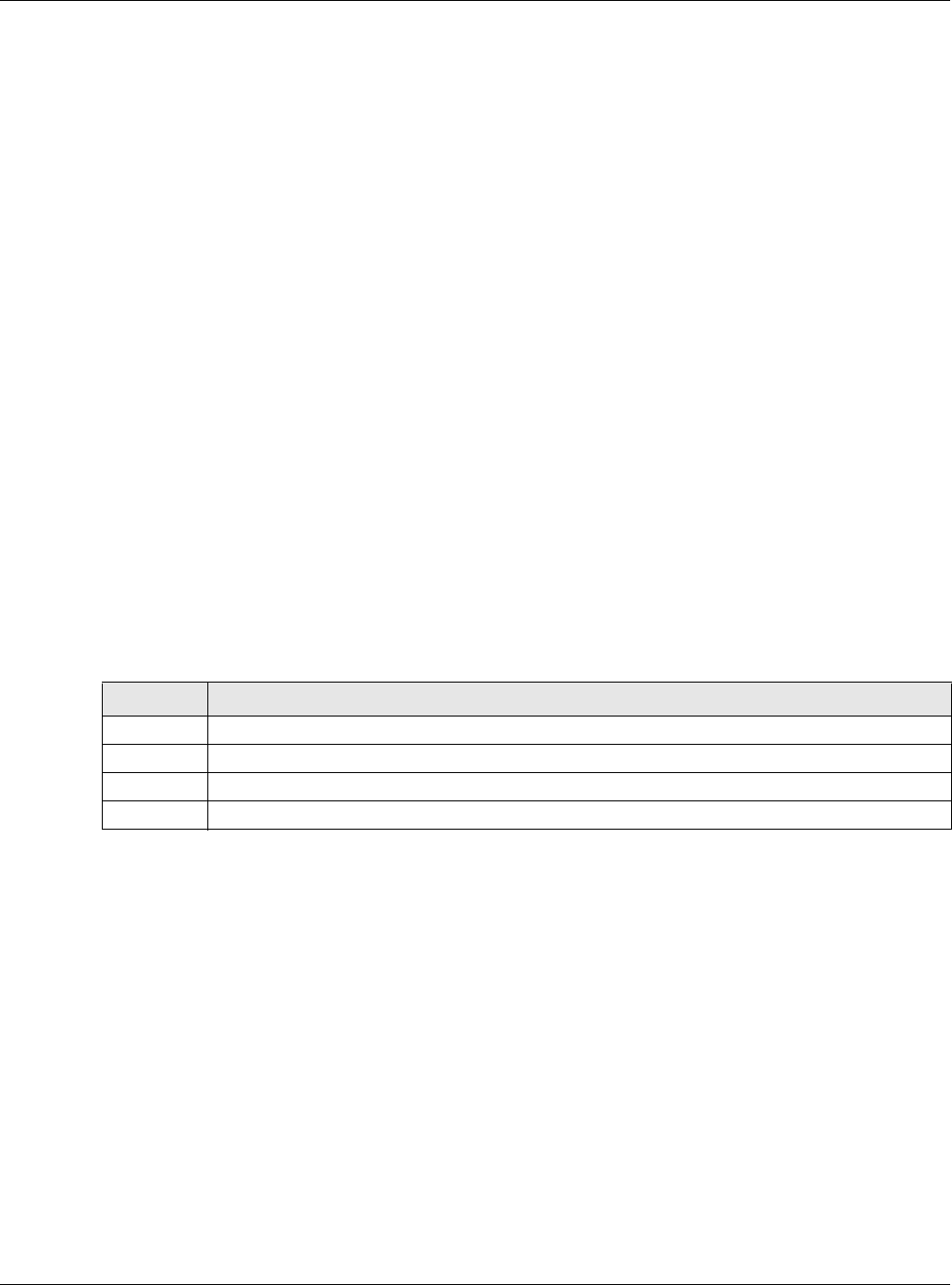
Chapter 13 NAT
EMG6765-Q10A User’s Guide
110
• Use the Port Trigger screen to change your EMG6765-Q10A’s trigger port settings (Section 13.5.3 on
page 117).
13.1.2 What You Need To Know
The following terms and concepts may help as you read through this chapter.
Inside/Outside
This denotes where a host is located relative to the EMG6765-Q10A, for example, the computers of your
subscribers are the inside hosts, while the web servers on the Internet are the outside hosts.
Global/Local
This denotes the IP address of a host in a packet as the packet traverses a router, for example, the local
address refers to the IP address of a host when the packet is in the local network, while the global
address refers to the IP address of the host when the same packet is traveling in the WAN side.
Note: Inside/outside refers to the location of a host, while global/local refers to the IP address
of a host used in a packet.
An inside local address (ILA) is the IP address of an inside host in a packet when the packet is still in the
local network, while an inside global address (IGA) is the IP address of the same inside host when the
packet is on the WAN side. The following table summarizes this information.
Note: NAT never changes the IP address (either local or global) of an outside host.
What NAT Does
In the simplest form, NAT changes the source IP address in a packet received from a subscriber (the
inside local address) to another (the inside global address) before forwarding the packet to the WAN
side. When the response comes back, NAT translates the destination address (the inside global address)
back to the inside local address before forwarding it to the original inside host. Note that the IP address
(either local or global) of an outside host is never changed.
The global IP addresses for the inside hosts can be either static or dynamically assigned by the ISP. In
addition, you can designate servers, for example, a web server and a telnet server, on your local
network and make them accessible to the outside world. If you do not define any servers, NAT offers the
additional benefit of firewall protection. With no servers defined, your EMG6765-Q10A filters out all
incoming inquiries, thus preventing intruders from probing your network. For more information on IP
address translation, refer to RFC 1631, The IP Network Address Translator (NAT).
Table 44 NAT Definitions
ITEM DESCRIPTION
Inside This refers to the host on the LAN.
Outside This refers to the host on the WAN.
Local This refers to the packet address (source or destination) as the packet travels on the LAN.
Global This refers to the packet address (source or destination) as the packet travels on the WAN.
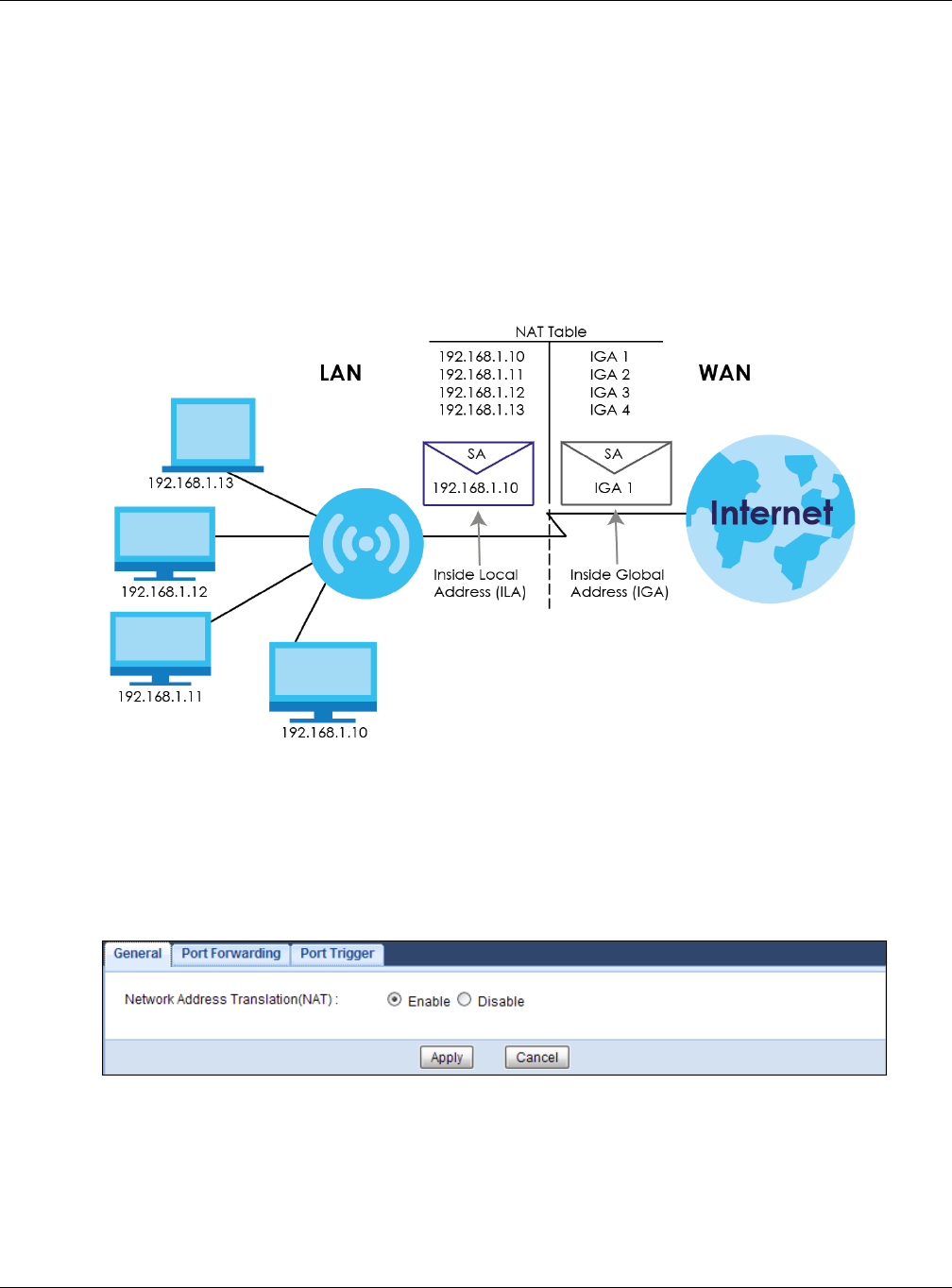
Chapter 13 NAT
EMG6765-Q10A User’s Guide
111
How NAT Works
Each packet has two addresses – a source address and a destination address. For outgoing packets,
the ILA (Inside Local Address) is the source address on the LAN, and the IGA (Inside Global Address) is
the source address on the WAN. For incoming packets, the ILA is the destination address on the LAN,
and the IGA is the destination address on the WAN. NAT maps private (local) IP addresses to globally
unique ones required for communication with hosts on other networks. It replaces the original IP source
address in each packet and then forwards it to the Internet. The EMG6765-Q10A keeps track of the
original addresses and port numbers so incoming reply packets can have their original values restored.
The following figure illustrates this.
Figure 59 How NAT Works
13.2 General
Use this screen to enable NAT and set a default server. Click Network > NAT to open the General screen.
Figure 60 Network > NAT > General

Chapter 13 NAT
EMG6765-Q10A User’s Guide
112
The following table describes the labels in this screen.
13.3 Port Forwarding Screen
Use this screen to forward incoming service requests to the server(s) on your local network and set a
default server. You may enter a single port number or a range of port numbers to be forwarded, and the
local IP address of the desired server. The port number identifies a service; for example, web service is on
port 80 and FTP on port 21. In some cases, such as for unknown services or where one server can support
more than one service (for example both FTP and web service), it might be better to specify a range of
port numbers.
In addition to the servers for specified services, NAT supports a default server. A service request that does
not have a server explicitly designated for it is forwarded to the default server. If the default is not
defined, the service request is simply discarded.
Note: Many residential broadband ISP accounts do not allow you to run any server processes
(such as a Web or FTP server) from your location. Your ISP may periodically check for
servers and may suspend your account if it discovers any active services at your
location. If you are unsure, refer to your ISP.
Port forwarding allows you to define the local servers to which the incoming services will be forwarded.
To change your EMG6765-Q10A’s port forwarding settings, click Network > NAT > Port Forwarding. The
screen appears as shown.
Note: If you do not assign a Default Server, the EMG6765-Q10A discards all packets received
for ports that are not specified in this screen or remote management.
Refer to Appendix B on page 200 for port numbers commonly used for particular services.
Table 45 Network > NAT > General
LABEL DESCRIPTION
Network Address
Translation (NAT)
Network Address Translation (NAT) allows the translation of an Internet protocol address
used within one network (for example a private IP address used in a local network) to a
different IP address known within another network (for example a public IP address used on
the Internet).
Select Enable to activate NAT. Select Disable to turn it off.
Apply Click Apply to save your changes back to the EMG6765-Q10A.
Cancel Click Cancel to begin configuring this screen afresh.
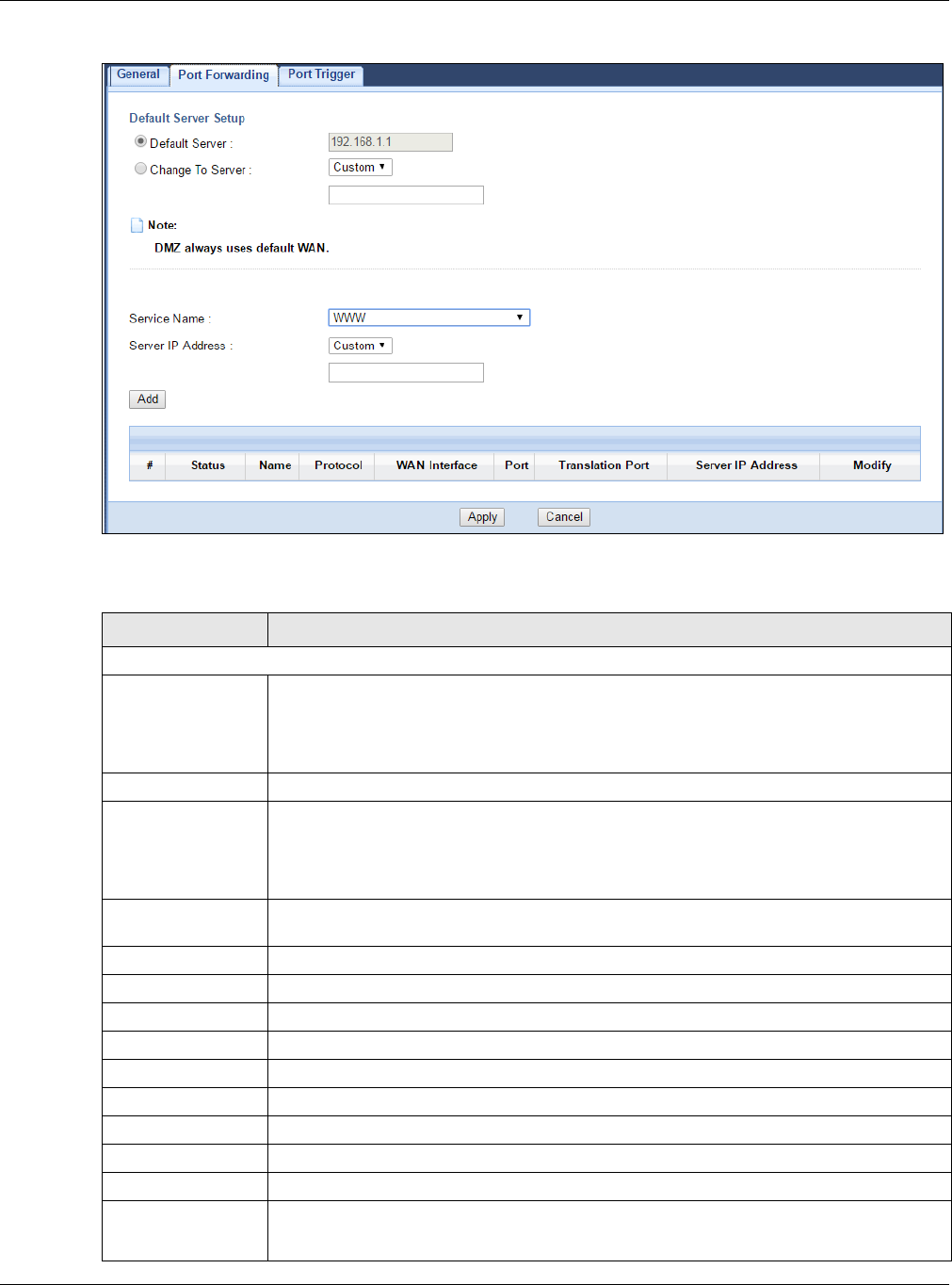
Chapter 13 NAT
EMG6765-Q10A User’s Guide
113
Figure 61 Network > NAT > Port Forwarding
The following table describes the labels in this screen.
Table 46 Network > NAT > Port Forwarding
LABEL DESCRIPTION
Default Server Setup
Default Server In addition to the servers for specified services, NAT supports a default server. A default
server receives packets from ports that are not specified in the Port Forwarding screen. You
can decide whether you want to use the default server or specify a server manually.
Select this to use the default server.
Change to Server Select this and manually enter the server’s IP address.
Service Name Select a pre-defined service from the drop-down list box. The pre-defined service port
number(s) and protocol will be displayed in the port forwarding summary table.
Otherwise, select User define to manually enter the port number(s) and select the IP
protocol.
Server IP Address Enter the inside IP address of the virtual server here and click Add to add it in the port
forwarding summary table.
Add Click this to add a new port forwarding rule.
#This is the number of an individual port forwarding server entry.
Status This icon is turned on when the rule is enabled.
Name This field displays a name to identify this rule.
Protocol This is the transport layer protocol used for the service.
WAN Interface This field displays the interface on which packets for the NAT entry are received.
Port This field displays the external port number(s) that identifies a service.
Translation Port This field displays the internal port number(s) that identifies a service.
Server IP Address This field displays the inside IP address of the server.
Modify Click the Edit icon to open the edit screen where you can modify an existing rule.
Click the Delete icon to remove a rule.
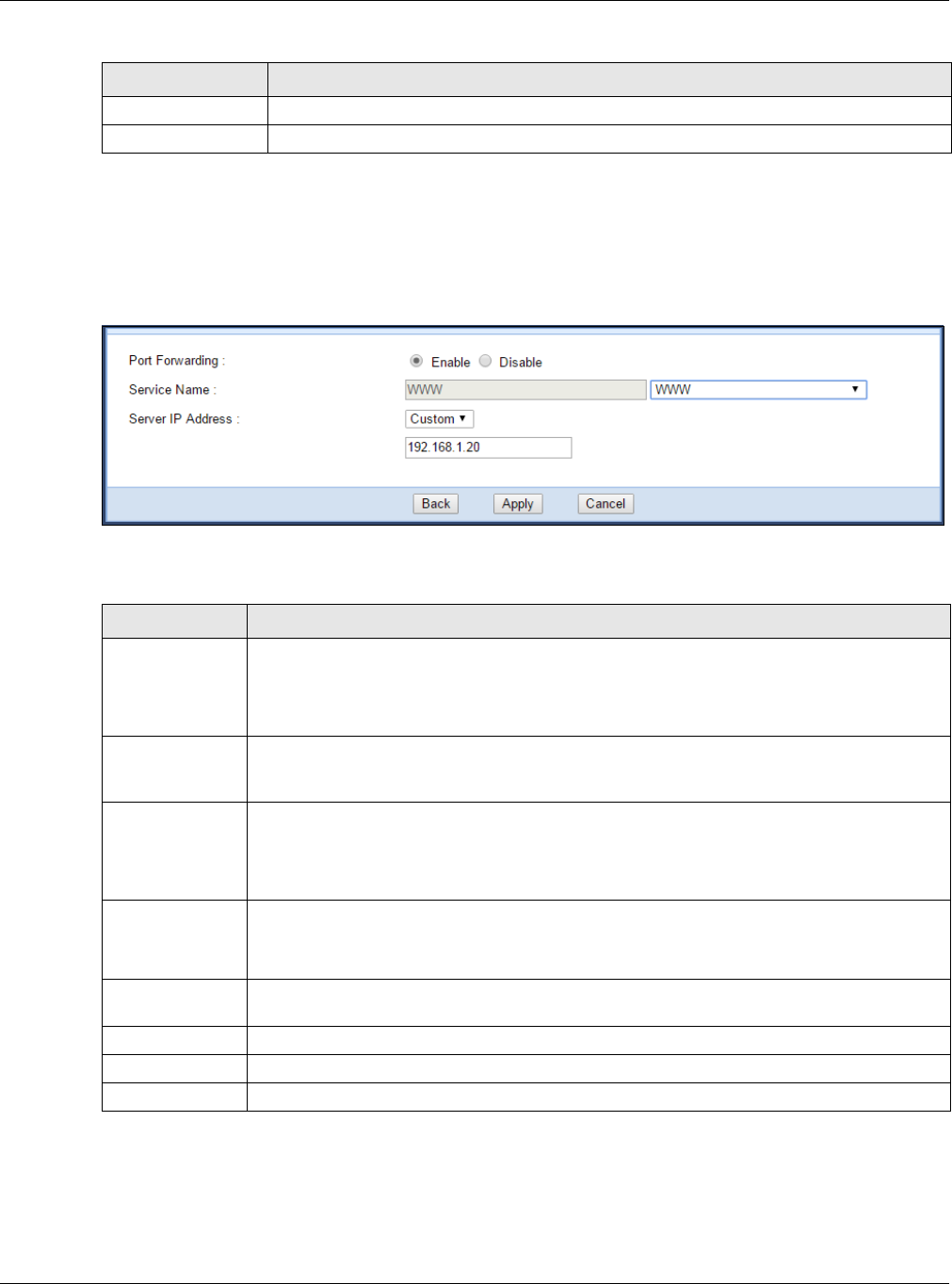
Chapter 13 NAT
EMG6765-Q10A User’s Guide
114
13.3.1 Port Forwarding Edit Screen
This screen lets you edit a port forwarding rule. Click a rule’s Edit icon in the Port Forwarding screen to
open the following screen.
Figure 62 Network > NAT > Port Forwarding Edit
The following table describes the labels in this screen.
Apply Click Apply to save your changes back to the EMG6765-Q10A.
Cancel Click Cancel to begin configuring this screen afresh.
Table 46 Network > NAT > Port Forwarding (continued)
LABEL DESCRIPTION
Table 47 Network > NAT > Port Forwarding Edit
LABEL DESCRIPTION
Port Forwarding Select Enable to turn on this rule and the requested service can be forwarded to the host with
a specified internal IP address.
Select Disable to disallow forwarding of these ports to an inside server without having to delete
the entry.
Service Name Select User define and type a name (of up to 31 printable characters) to identify this rule in the
first field next to Service Name. Otherwise, select a predefined service in the second field next
to Service Name.
Protocol Select the transport layer protocol supported by this virtual server. Choices are TCP, UDP, or
TCP_UDP.
If you have chosen a pre-defined service in the Service Name field, the protocol will be
configured automatically.
Port Type a port number(s) to define the service to be forwarded to the specified server.
To specify a range of ports, enter a hyphen (-) between the first port and the last port, such as
10-.
Server IP Address Type the IP address of the server on your LAN that receives packets from the port(s) specified in
the Port field.
Back Click Back to return to the previous screen.
Apply Click Apply to save your changes back to the EMG6765-Q10A.
Cancel Click Cancel to begin configuring this screen afresh.
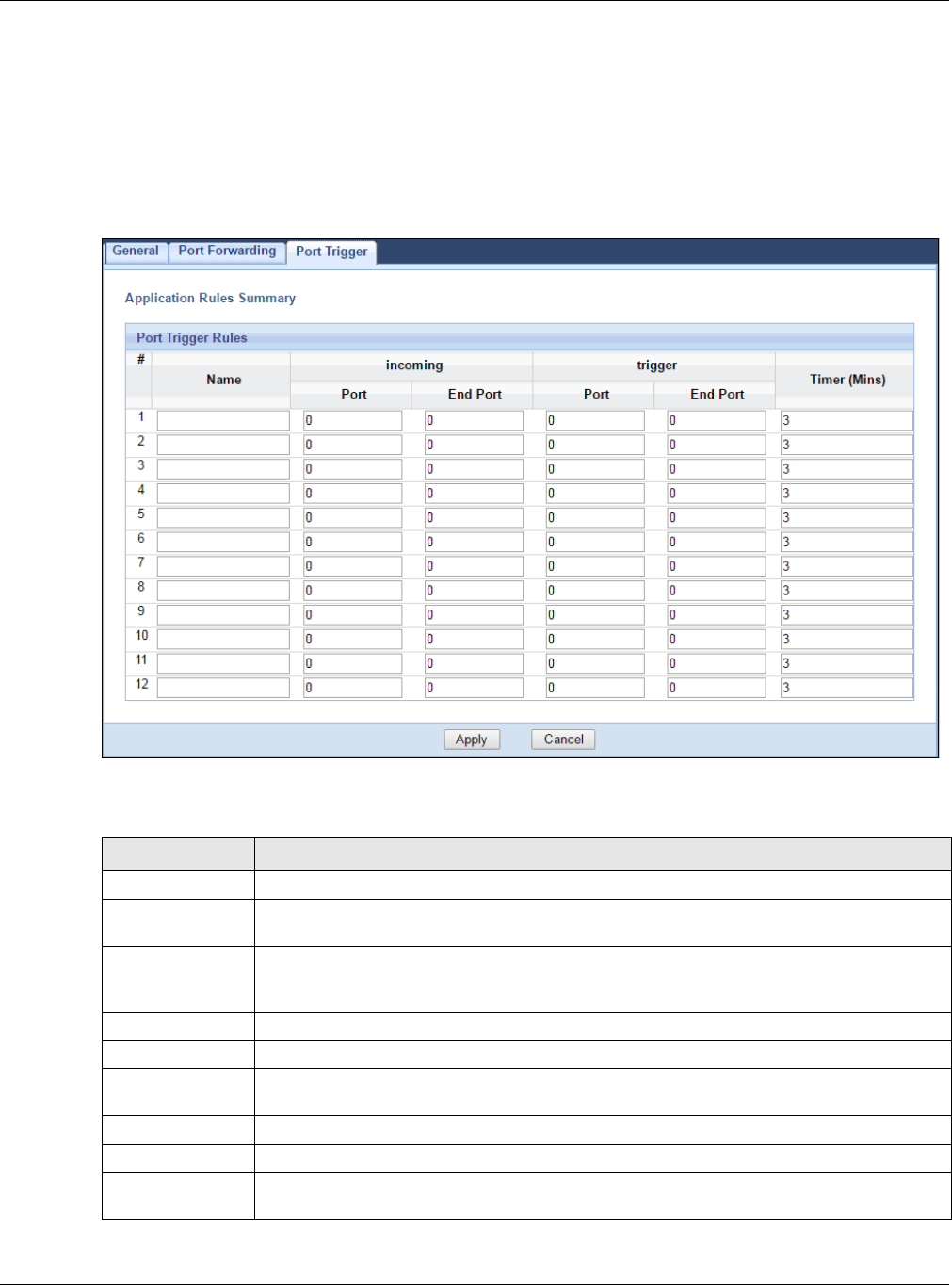
Chapter 13 NAT
EMG6765-Q10A User’s Guide
115
13.4 Port Trigger Screen
To change your EMG6765-Q10A’s trigger port settings, click Network > NAT > Port Trigger. The screen
appears as shown.
Note: Only one LAN computer can use a trigger port (range) at a time.
Figure 63 Network > NAT > Port Trigger
The following table describes the labels in this screen.
Table 48 Network > NAT > Port Trigger
LABEL DESCRIPTION
#This is the rule index number (read-only).
Name Type a unique name (up to 15 characters) for identification purposes. All characters are
permitted - including spaces.
Incoming Incoming is a port (or a range of ports) that a server on the WAN uses when it sends out a
particular service. The EMG6765-Q10A forwards the traffic with this port (or range of ports) to
the client computer on the LAN that requested the service.
Port Type a port number or the starting port number in a range of port numbers.
End Port Type a port number or the ending port number in a range of port numbers.
Trigger The trigger port is a port (or a range of ports) that causes (or triggers) the EMG6765-Q10A to
record the IP address of the LAN computer that sent the traffic to a server on the WAN.
Port Type a port number or the starting port number in a range of port numbers.
End Port Type a port number or the ending port number in a range of port numbers.
Timer (Mins) Enter the interval (in minutes) a trigger port records an IP address of the client requesting the
service.

Chapter 13 NAT
EMG6765-Q10A User’s Guide
116
13.5 Technical Reference
The following section contains additional technical information about the EMG6765-Q10A features
described in this chapter.
13.5.1 NATPort Forwarding: Services and Port Numbers
A port forwarding set is a list of inside (behind NAT on the LAN) servers, for example, web or FTP, that you
can make accessible to the outside world even though NAT makes your whole inside network appear
as a single machine to the outside world.
Use the Port Forwarding screen to forward incoming service requests to the server(s) on your local
network. You may enter a single port number or a range of port numbers to be forwarded, and the local
IP address of the desired server. The port number identifies a service; for example, web service is on port
80 and FTP on port 21. In some cases, such as for unknown services or where one server can support
more than one service (for example both FTP and web service), it might be better to specify a range of
port numbers.
In addition to the servers for specified services, NAT supports a default server. A service request that does
not have a server explicitly designated for it is forwarded to the default server. If the default is not
defined, the service request is simply discarded.
Note: Many residential broadband ISP accounts do not allow you to run any server processes
(such as a Web or FTP server) from your location. Your ISP may periodically check for
servers and may suspend your account if it discovers any active services at your
location. If you are unsure, refer to your ISP.
13.5.2 NAT Port Forwarding Example
Let's say you want to assign ports 21-25 to one FTP, Telnet and SMTP server (A in the example), port 80 to
another (B in the example) and assign a default server IP address of 192.168.1.35 to a third (C in the
example). You assign the LAN IP addresses and the ISP assigns the WAN IP address. The NAT network
appears as a single host on the Internet.
Apply Click Apply to save your changes back to the EMG6765-Q10A.
Cancel Click Cancel to begin configuring this screen afresh.
Table 48 Network > NAT > Port Trigger (continued)
LABEL DESCRIPTION
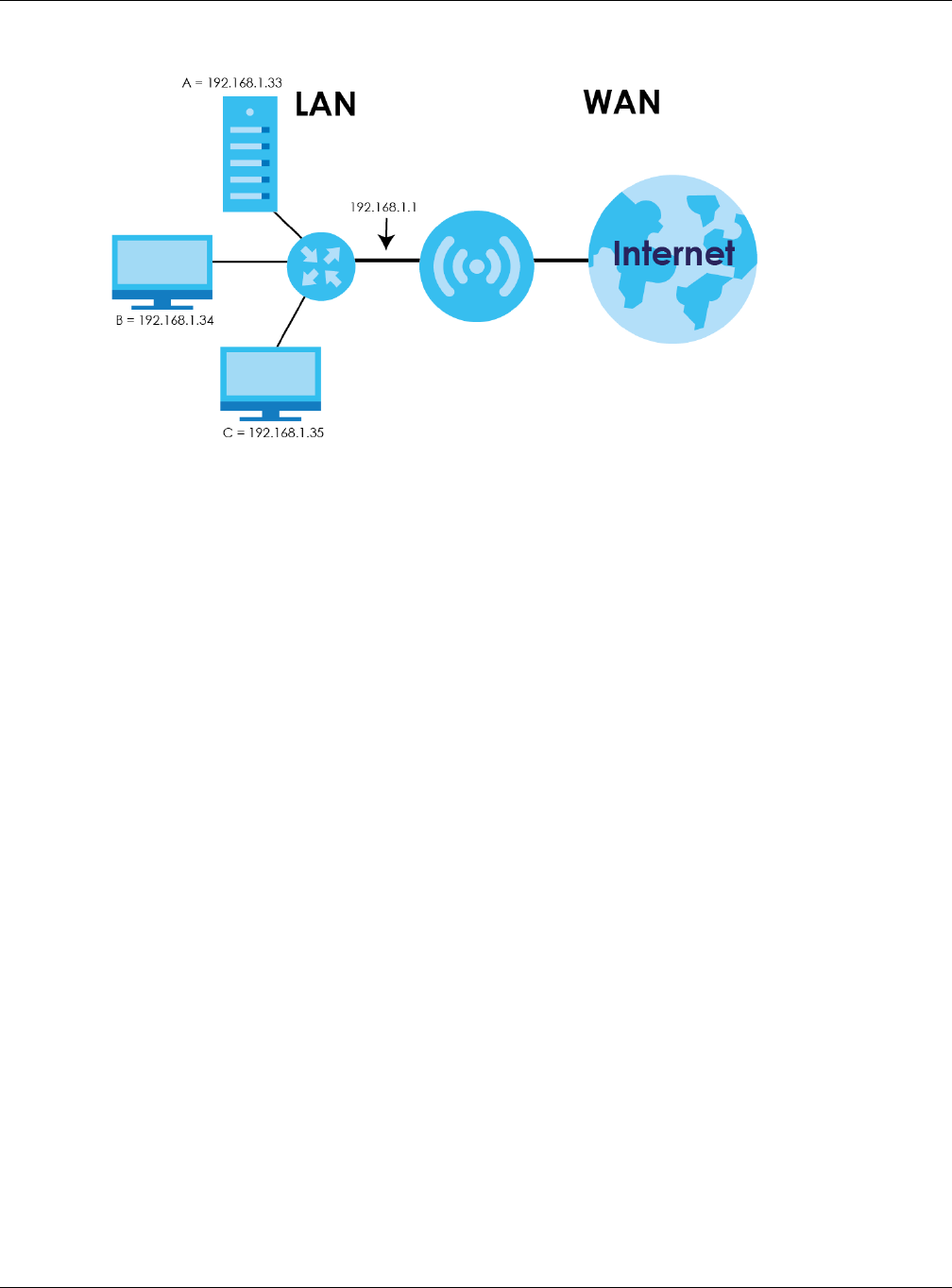
Chapter 13 NAT
EMG6765-Q10A User’s Guide
117
Figure 64 Multiple Servers Behind NAT Example
13.5.3 Trigger Port Forwarding
Some services use a dedicated range of ports on the client side and a dedicated range of ports on the
server side. With regular port forwarding you set a forwarding port in NAT to forward a service (coming in
from the server on the WAN) to the IP address of a computer on the client side (LAN). The problem is that
port forwarding only forwards a service to a single LAN IP address. In order to use the same service on a
different LAN computer, you have to manually replace the LAN computer's IP address in the forwarding
port with another LAN computer's IP address.
Trigger port forwarding solves this problem by allowing computers on the LAN to dynamically take turns
using the service. The EMG6765-Q10A records the IP address of a LAN computer that sends traffic to the
WAN to request a service with a specific port number and protocol (a "trigger" port). When the
EMG6765-Q10A's WAN port receives a response with a specific port number and protocol ("incoming"
port), the EMG6765-Q10A forwards the traffic to the LAN IP address of the computer that sent the
request. After that computer’s connection for that service closes, another computer on the LAN can use
the service in the same manner. This way you do not need to configure a new IP address each time you
want a different LAN computer to use the application.
13.5.4 Trigger Port Forwarding Example
The following is an example of trigger port forwarding.
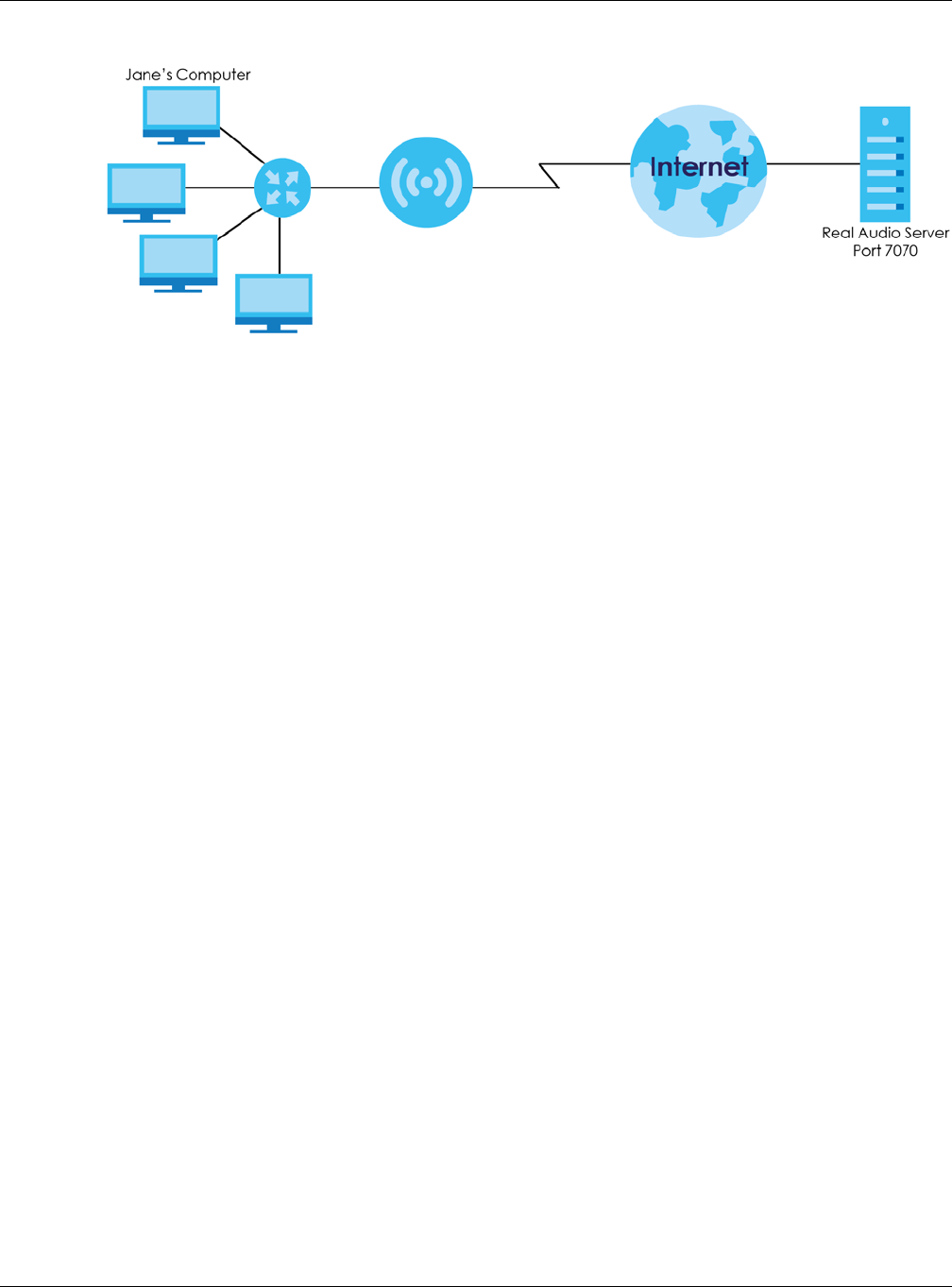
Chapter 13 NAT
EMG6765-Q10A User’s Guide
118
Figure 65 Trigger Port Forwarding Process: Example
1Jane requests a file from the Real Audio server (port 7070).
2Port 7070 is a “trigger” port and causes the EMG6765-Q10A to record Jane’s computer IP address. The
EMG6765-Q10A associates Jane's computer IP address with the "incoming" port range of 6970-7170.
3The Real Audio server responds using a port number ranging between 6970-7170.
4The EMG6765-Q10A forwards the traffic to Jane’s computer IP address.
5Only Jane can connect to the Real Audio server until the connection is closed or times out. The
EMG6765-Q10A times out in three minutes with UDP (User Datagram Protocol), or two hours with TCP/IP
(Transfer Control Protocol/Internet Protocol).
13.5.5 Two Points To Remember About Trigger Ports
1Trigger events only happen on data that is coming from inside the EMG6765-Q10A and going to the
outside.
2If an application needs a continuous data stream, that port (range) will be tied up so that another
computer on the LAN can’t trigger it.
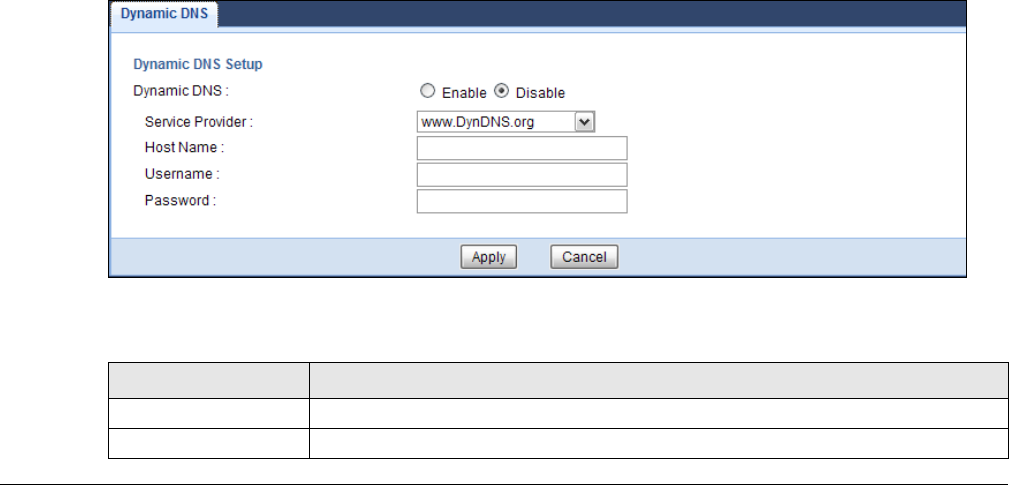
EMG6765-Q10A User’s Guide
119
CHAPTER 14
DDNS
14.1 Overview
DDNS services let you use a domain name with a dynamic IP address.
14.1.1 What You Need To Know
The following terms and concepts may help as you read through this chapter.
What is DDNS?
Dynamic Domain Name Service (DDNS) services let you use a fixed domain name with a dynamic IP
address. Users can always use the same domain name instead of a different dynamic IP address that
changes each time to connect to the EMG6765-Q10A or a server in your network.
Note: The EMG6765-Q10A must have a public global IP address and you should have your
registered DDNS account information on hand.
14.2 General
To change your EMG6765-Q10A’s DDNS, click Network > DDNS. The screen appears as shown.
Figure 66 Dynamic DNS
The following table describes the labels in this screen.
Table 49 Dynamic DNS
LABEL DESCRIPTION
Dynamic DNS Select Enable to use dynamic DNS. Select Disable to turn this feature off.
Service Provider Select the name of your Dynamic DNS service provider.

Chapter 14 DDNS
EMG6765-Q10A User’s Guide
120
Host Name Enter a host names in the field provided. You can specify up to two host names in the
field separated by a comma (",").
Username Enter your user name.
Password Enter the password assigned to you.
Apply Click Apply to save your changes back to the EMG6765-Q10A.
Cancel Click Cancel to begin configuring this screen afresh.
Table 49 Dynamic DNS (continued)
LABEL DESCRIPTION
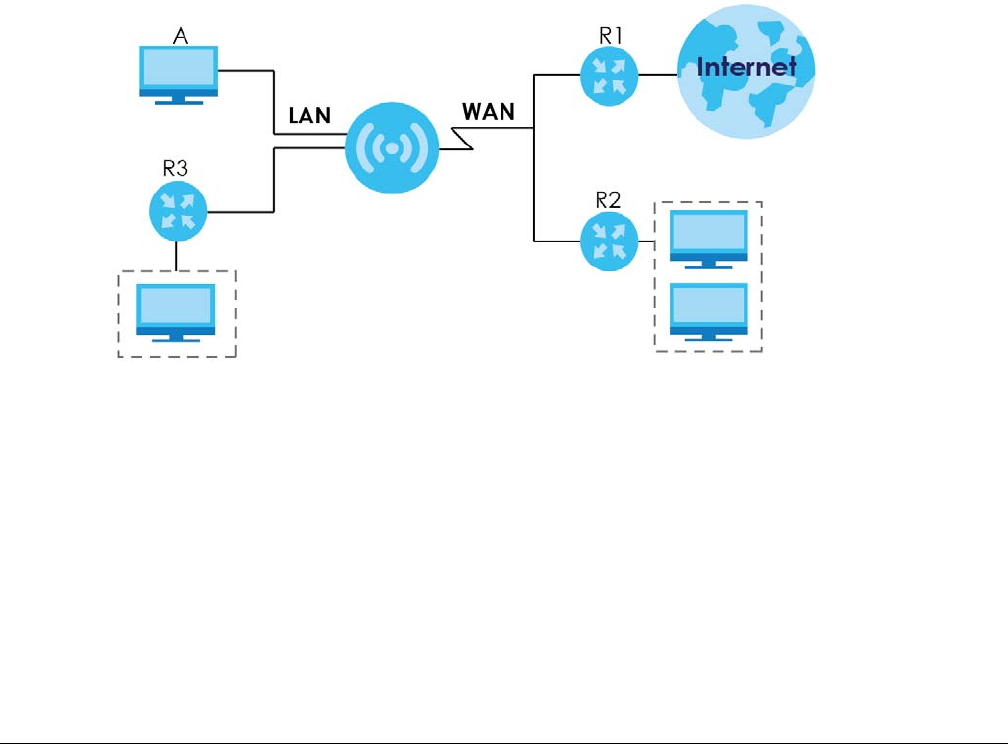
EMG6765-Q10A User’s Guide
121
CHAPTER 15
Static Route
15.1 Overview
This chapter shows you how to configure static routes for your EMG6765-Q10A.
The EMG6765-Q10A usually uses the default gateway to route outbound traffic from computers on the
LAN to the Internet. To have the EMG6765-Q10A send data to devices not reachable through the
default gateway, use static routes.
For example, the next figure shows a computer (A) connected to the EMG6765-Q10A’s LAN interface.
The EMG6765-Q10A routes most traffic from A to the Internet through the EMG6765-Q10A’s default
gateway (R1). You create one static route to connect to services offered by your ISP behind router R2.
You create another static route to communicate with a separate network behind a router R3
connected to the LAN.
Figure 67 Example of Static Routing Topology
15.2 IP Static Route Screen
Click Network > Static Route to open the Static Route screen.
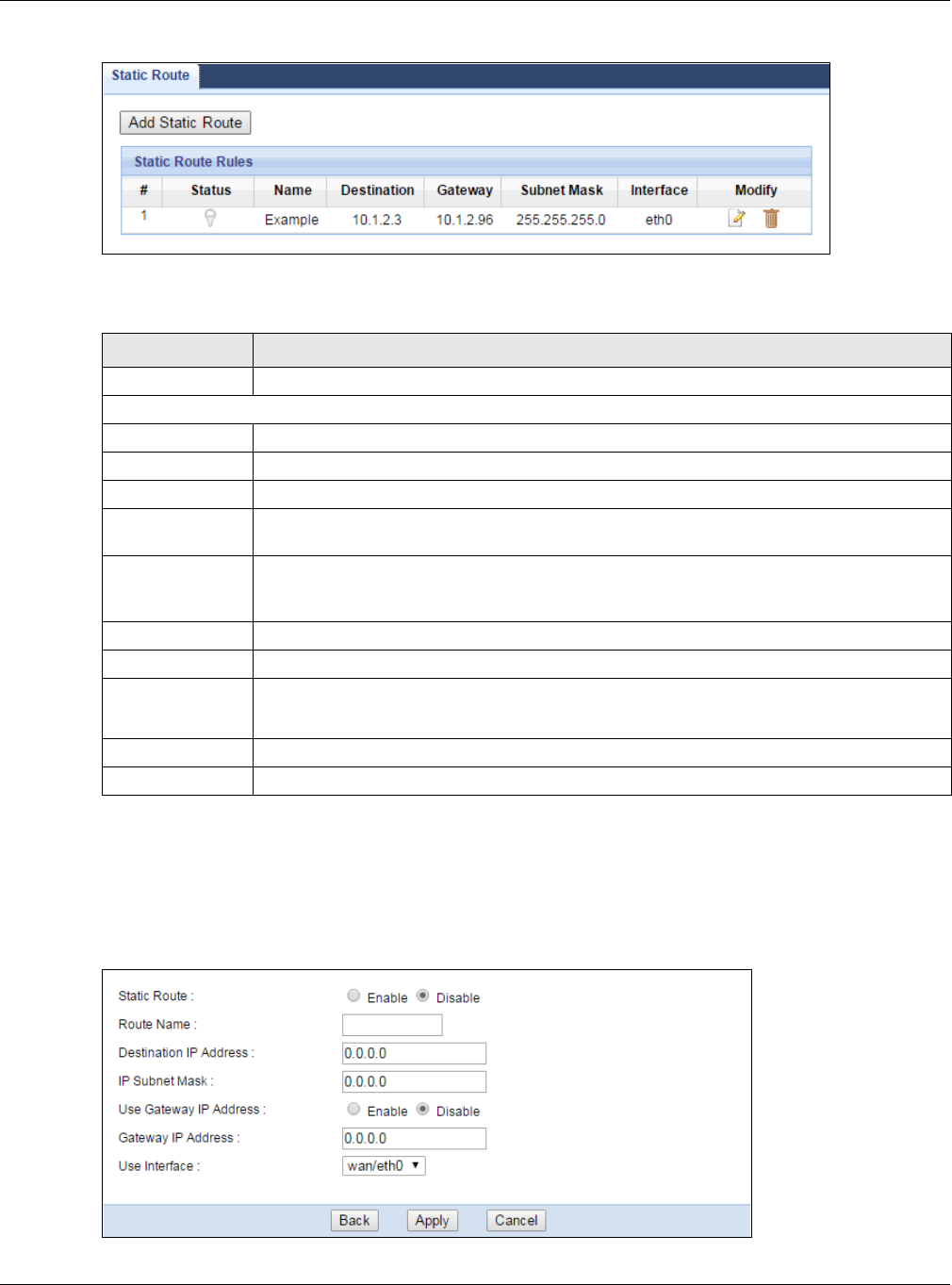
Chapter 15 Static Route
EMG6765-Q10A User’s Guide
122
Figure 68 Network > Static Route
The following table describes the labels in this screen.
15.2.1 Add/Edit Static Route
Click the Add Static Route button or a rule’s Edit icon in the Static Route screen. Use this screen to
configure the required information for a static route.
Figure 69 Network > Static Route: Add/Edit
Table 50 Network > Static Route
LABEL DESCRIPTION
Add Static Route Click this to create a new rule.
Static Route Rules
#This is the number of an individual static route.
Status This field indicates whether the rule is active (yellow bulb) or not (gray bulb).
Name This field displays a name to identify this rule.
Destination This parameter specifies the IP network address of the final destination. Routing is always
based on network number.
Gateway This is the IP address of the gateway. The gateway is a router or switch on the same network
segment as the device's LAN or WAN port. The gateway helps forward packets to their
destinations.
Subnet Mask This parameter specifies the IP network subnet mask of the final destination.
Interface This is the WAN interface through which the traffic is routed.
Modify Click the Edit icon to open a screen where you can modify an existing rule.
Click the Delete icon to remove a rule from the EMG6765-Q10A.
Apply Click Apply to save your changes back to the EMG6765-Q10A.
Cancel Click Cancel to begin configuring this screen afresh.

Chapter 15 Static Route
EMG6765-Q10A User’s Guide
123
The following table describes the labels in this screen.
Table 51 Network > Static Route: Add/Edit
LABEL DESCRIPTION
Static Route Select to enable or disable this rule.
Route Name Type a name to identify this rule. You can use up to 31 printable English keyboard characters,
including spaces.
Destination IP
Address
This parameter specifies the IP network address of the final destination. Routing is always
based on network number. If you need to specify a route to a single host, use a subnet mask
of 255.255.255.255 in the subnet mask field to force the network number to be identical to the
host ID.
IP Subnet Mask Enter the IP subnet mask here.
Use Gateway IP
Address
Select to enable or disable this rule.
Gateway IP
Address
Enter the IP address of the next-hop gateway. The gateway is a router or switch on the same
segment as your EMG6765-Q10A's interface(s). The gateway helps forward packets to their
destinations.
Use Interface Select a WAN interface through which the traffic is sent. You must have the WAN interface(s)
already configured in the WAN screens.
Back Click Back to return to the previous screen without saving.
Apply Click Apply to save your changes back to the EMG6765-Q10A.
Cancel Click Cancel to set every field in this screen to its last-saved value.
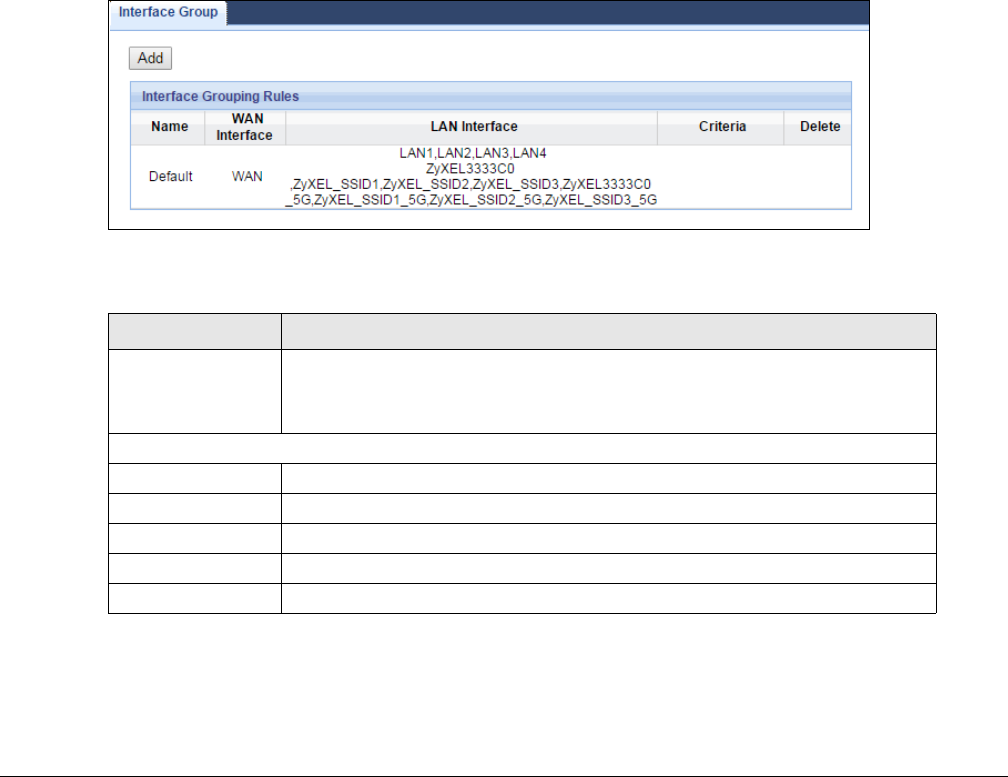
EMG6765-Q10A User’s Guide
124
CHAPTER 16
Interface Group
16.1 Overview
By default, all LAN and WAN interfaces on the EMG6765-Q10A are in the same group and can
communicate with each other. Each group acts as an independent network on the EMG6765-Q10A.
16.2 The Interface Group Screen
You can manually add a LAN and/or WLAN interface to a new group. Click Network > Interface Group
to open the following screen.
Figure 70 Network > Interface Group
The following table describes the fields in this screen.
16.2.1 Add Interface Group
Click the Add button in the Interface Group screen to open the following screen. Use this screen to
create a new interface group.
Table 52 Network > Interface Group
LABEL DESCRIPTION
Add Click this to add a new interface grouping rule.
You must configure a WAN connection before you can add a new interface
grouping rule. See Chapter 8 on page 60 for more information.
Interface Grouping Rules
Name This shows the descriptive name of the group.
WAN Interface This shows the WAN interfaces in the group.
LAN Interfaces This shows the LAN and/or WLAN interfaces in the group.
Criteria This shows the filtering criteria for the group.
Delete Click the Delete icon to remove the group.
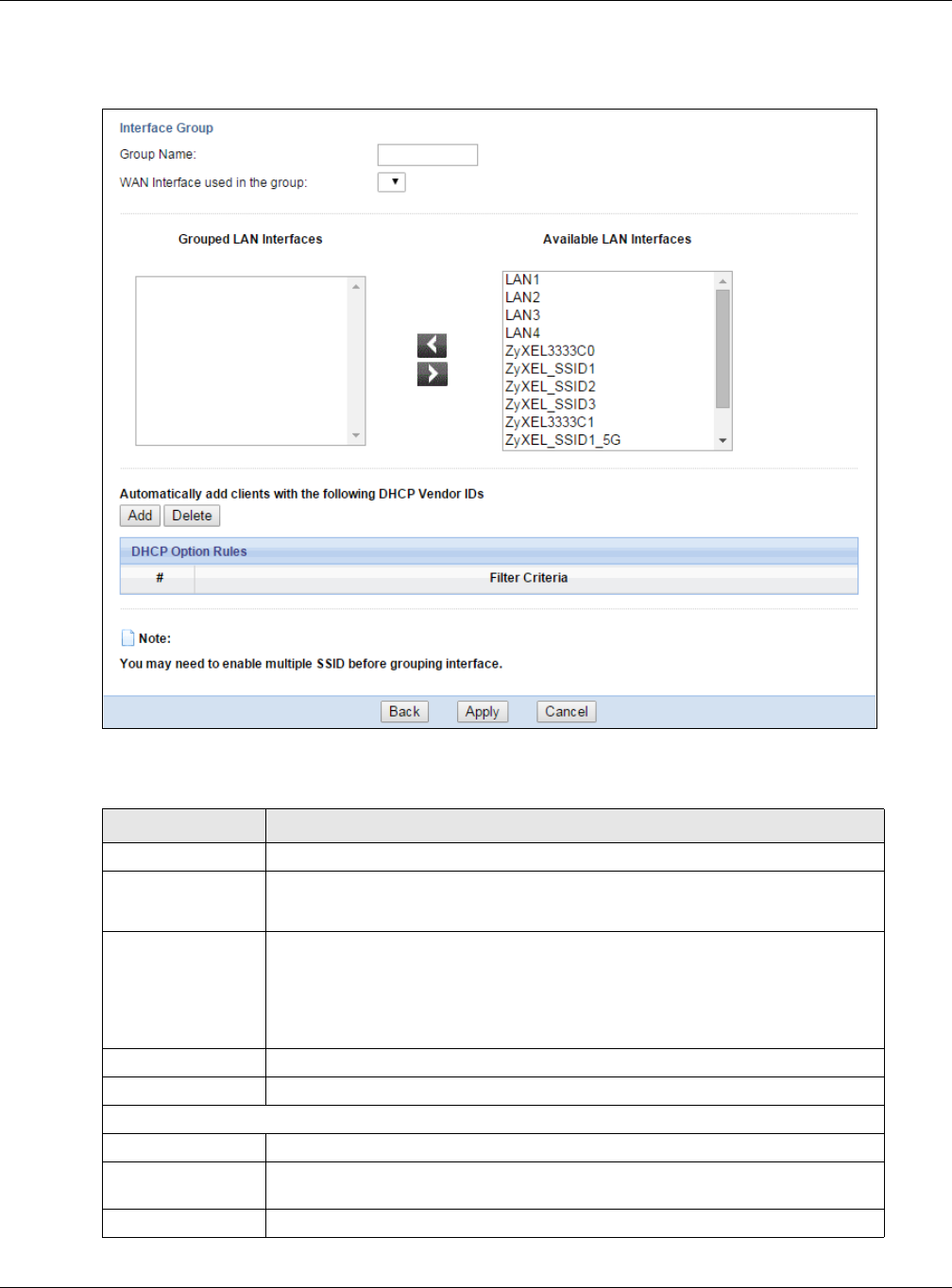
Chapter 16 Interface Group
EMG6765-Q10A User’s Guide
125
Note: An interface can belong to a group only.
Figure 71 Interface Group > Add New Group
The following table describes the fields in this screen.
Table 53 Interface Group > Add New Group
LABEL DESCRIPTION
Group Name Enter a name to identify this group.
WAN Interfaces
used in the group
Select a WAN interface to be used in this group.
Select None to not add a WAN interface to this group.
Grouped LAN
Interfaces
Available LAN
Interfaces
Select a LAN or wireless LAN interface in the Available LAN Interfaces and use the
left-facing arrow to move it to the Grouped LAN Interfaces to add the interface to
this group.
To remove a LAN or wireless LAN interface from the Grouped LAN Interfaces, use
the right-facing arrow.
Add Click this button to create a new rule.
Delete Click the Delete icon to remove this rule from the EMG6765-Q10A.
DHCP Option Rules
#This shows the index number of the rule.
Filter Criteria This shows the filtering criteria. The LAN interface on which the matched traffic is
received will belong to this group automatically.
Back Click this button to return to the previous screen without saving any changes.
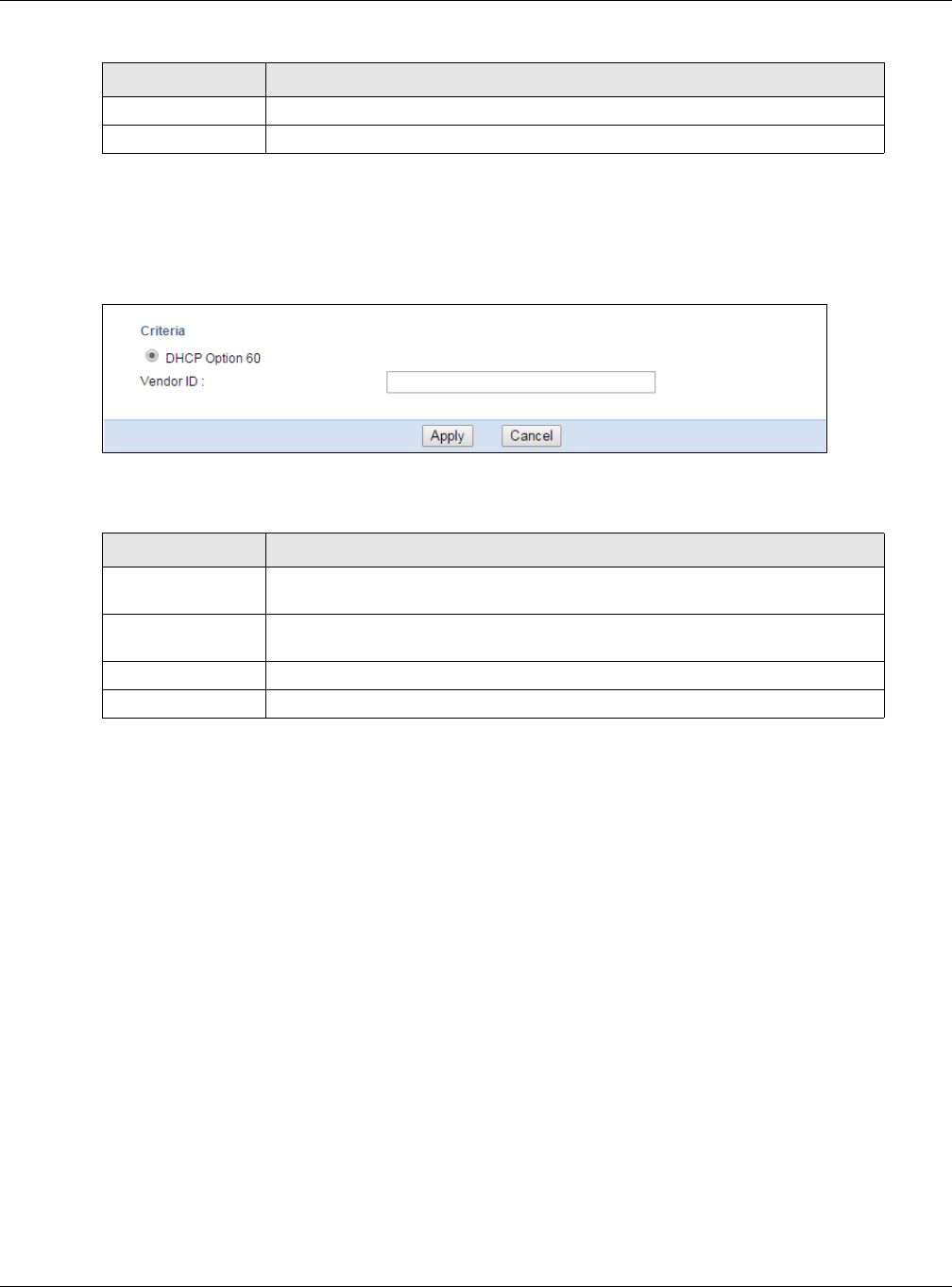
Chapter 16 Interface Group
EMG6765-Q10A User’s Guide
126
16.2.2 Add Interface Group Criteria
Click the Add button in the Interface Group screen to open the following screen.
Figure 72 Interface Group > Add New Group > Add Interface Group Criteria
The following table describes the fields in this screen.
Apply Click this button to save your settings back to the EMG6765-Q10A.
Cancel Click Cancel to begin configuring this screen afresh.
Table 53 Interface Group > Add New Group
LABEL DESCRIPTION
Table 54 Interface Group > Add New Group > Add Interface Group Criteria
LABEL DESCRIPTION
DHCP Option 60 Select this option and enter the Vendor Class Identifier (Option 60) of the matched
traffic, such as the type of the hardware or firmware.
Vendor ID Enter the identification number assigned to the company by the IANA (Internet
Assigned Numbers Authority).
Apply Click this button to save your settings back to the EMG6765-Q10A.
Cancel Click Cancel to begin configuring this screen afresh.
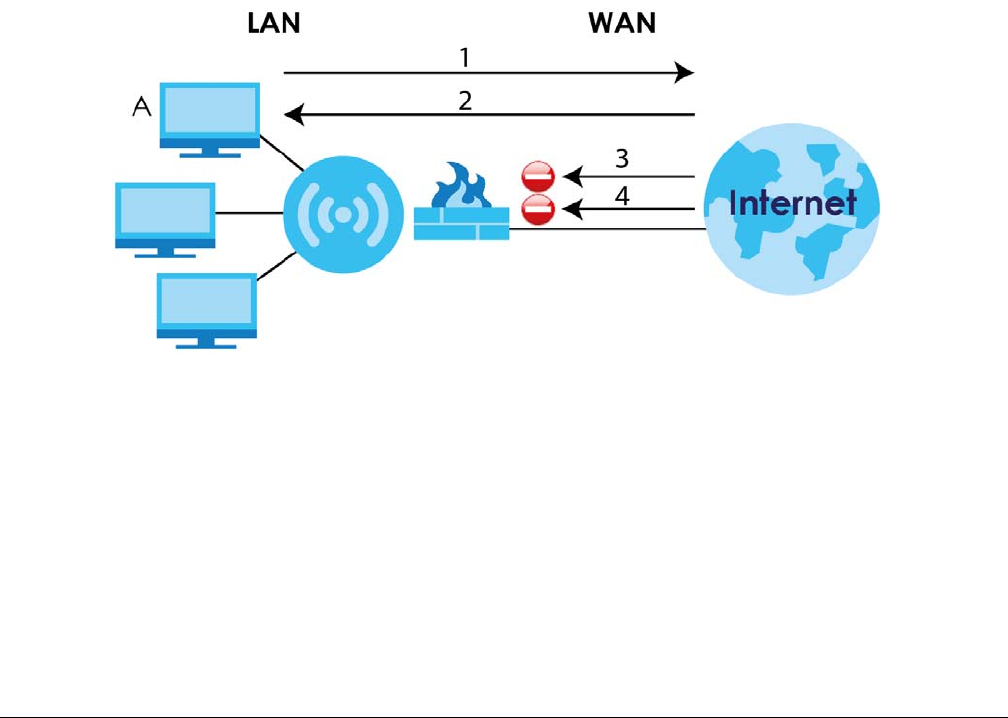
EMG6765-Q10A User’s Guide
127
CHAPTER 17
Firewall
17.1 Overview
Use these screens to enable and configure the firewall that protects your EMG6765-Q10A and your LAN
from unwanted or malicious traffic.
Enable the firewall to protect your LAN computers from attacks by hackers on the Internet and control
access between the LAN and WAN. By default the firewall:
• allows traffic that originates from your LAN computers to go to all of the networks.
• blocks traffic that originates on the other networks from going to the LAN.
The following figure illustrates the default firewall action. User A can initiate an IM (Instant Messaging)
session from the LAN to the WAN (1). Return traffic for this session is also allowed (2). However other traffic
initiated from the WAN is blocked (3 and 4).
Figure 73 Default Firewall Action
17.1.1 What You Can Do
• Use the General screen to enable or disable the EMG6765-Q10A’s firewall (Section 17.2 on page 129).
• Use the Services screen enable service blocking, enter/delete/modify the services you want to block
and the date/time you want to block them (Section 17.3 on page 129).
17.1.2 What You Need To Know
The following terms and concepts may help as you read through this chapter.

Chapter 17 Firewall
EMG6765-Q10A User’s Guide
128
What is a Firewall?
Originally, the term “firewall” referred to a construction technique designed to prevent the spread of fire
from one room to another. The networking term "firewall" is a system or group of systems that enforces an
access-control policy between two networks. It may also be defined as a mechanism used to protect a
trusted network from a network that is not trusted. Of course, firewalls cannot solve every security
problem. A firewall is one of the mechanisms used to establish a network security perimeter in support of
a network security policy. It should never be the only mechanism or method employed. For a firewall to
guard effectively, you must design and deploy it appropriately. This requires integrating the firewall into
a broad information-security policy. In addition, specific policies must be implemented within the firewall
itself.
Stateful Inspection Firewall
Stateful inspection firewalls restrict access by screening data packets against defined access rules. They
make access control decisions based on IP address and protocol. They also "inspect" the session data to
assure the integrity of the connection and to adapt to dynamic protocols. These firewalls generally
provide the best speed and transparency; however, they may lack the granular application level
access control or caching that some proxies support. Firewalls, of one type or another, have become
an integral part of standard security solutions for enterprises.
About the EMG6765-Q10A Firewall
The EMG6765-Q10A’s firewall feature physically separates the LAN and the WAN and acts as a secure
gateway for all data passing between the networks.
It is a stateful inspection firewall and is designed to protect against Denial of Service attacks when
activated (click the General tab under Firewall and then click the Enable Firewall check box). The
EMG6765-Q10A's purpose is to allow a private Local Area Network (LAN) to be securely connected to
the Internet. The EMG6765-Q10A can be used to prevent theft, destruction and modification of data, as
well as log events, which may be important to the security of your network.
The EMG6765-Q10A is installed between the LAN and a broadband modem connecting to the Internet.
This allows it to act as a secure gateway for all data passing between the Internet and the LAN.
The EMG6765-Q10A has one Ethernet WAN port and four Ethernet LAN ports, which are used to
physically separate the network into two areas.The WAN (Wide Area Network) port attaches to the
broadband (cable or DSL) modem to the Internet.
The LAN (Local Area Network) port attaches to a network of computers, which needs security from the
outside world. These computers will have access to Internet services such as e-mail, FTP and the World
Wide Web. However, "inbound access" is not allowed (by default) unless the remote host is authorized to
use a specific service.
Guidelines For Enhancing Security With Your Firewall
1Change the default password via Web Configurator.
2Think about access control before you connect to the network in any way, including attaching a
modem to the port.
3Limit who can access your router.
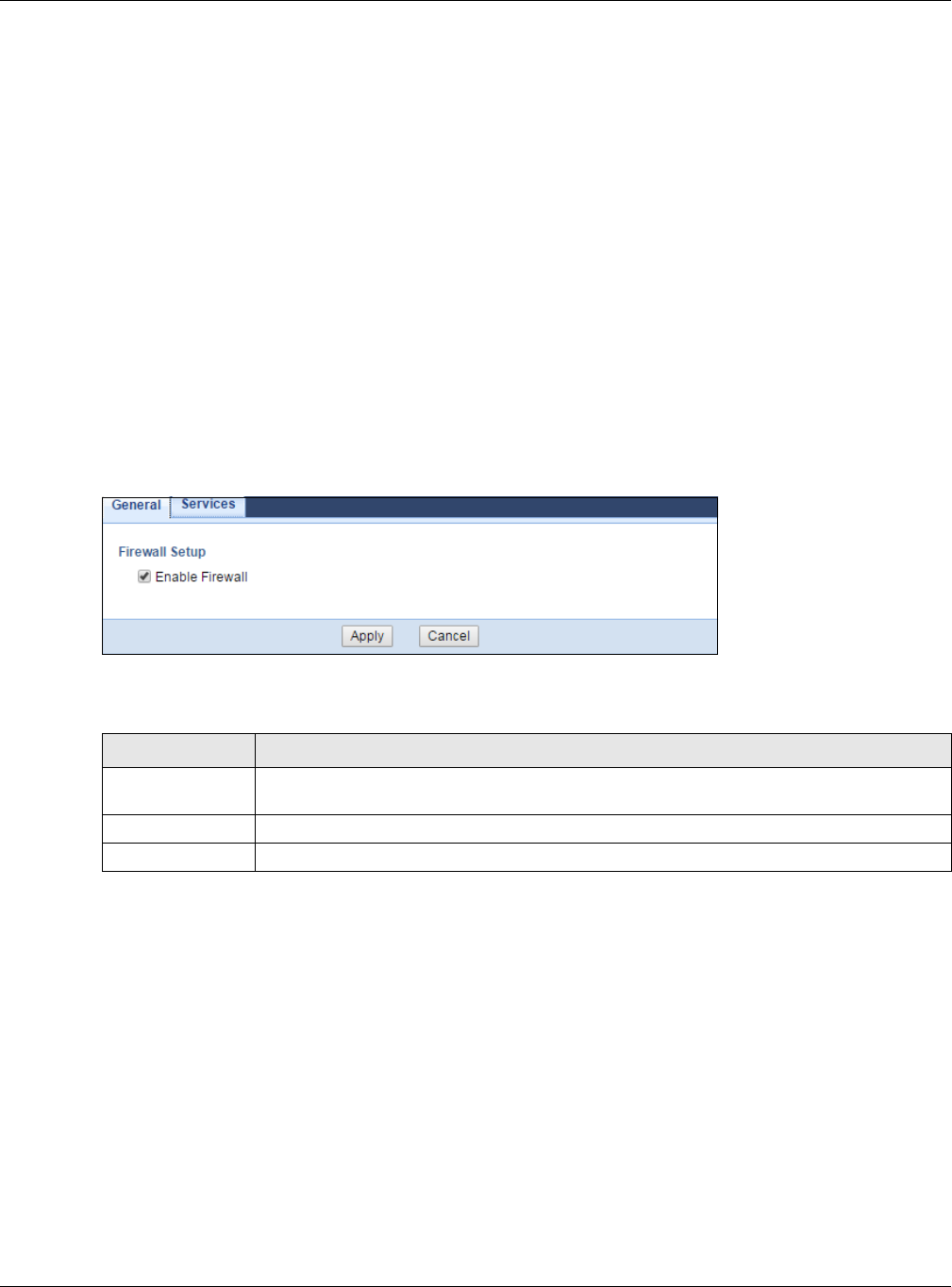
Chapter 17 Firewall
EMG6765-Q10A User’s Guide
129
4Don't enable any local service (such as NTP) that you don't use. Any enabled service could present a
potential security risk. A determined hacker might be able to find creative ways to misuse the enabled
services to access the firewall or the network.
5For local services that are enabled, protect against misuse. Protect by configuring the services to
communicate only with specific peers, and protect by configuring rules to block packets for the services
at specific interfaces.
6Protect against IP spoofing by making sure the firewall is active.
7Keep the firewall in a secured (locked) room.
17.2 General Screen
Use this screen to enable or disable the EMG6765-Q10A’s firewall, and set up firewall logs. Click Security
> Firewall to open the General screen.
Figure 74 Security > Firewall > General l
The following table describes the labels in this screen.
17.3 Services Screen
If an outside user attempts to probe an unsupported port on your EMG6765-Q10A, an ICMP response
packet is automatically returned. This allows the outside user to know the EMG6765-Q10A exists. Use this
screen to prevent the ICMP response packet from being sent. This keeps outsiders from discovering your
EMG6765-Q10A when unsupported ports are probed.
You can also use this screen to enable service blocking, enter/delete/modify the services you want to
block and the date/time you want to block them.
Click Security > Firewall > Services. The screen appears as shown next.
Table 55 Security > Firewall > General
LABEL DESCRIPTION
Enable Firewall Select this check box to activate the firewall. The EMG6765-Q10A performs access control
and protects against Denial of Service (DoS) attacks when the firewall is activated.
Apply Click Apply to save the settings.
Cancel Click Cancel to start configuring this screen again.
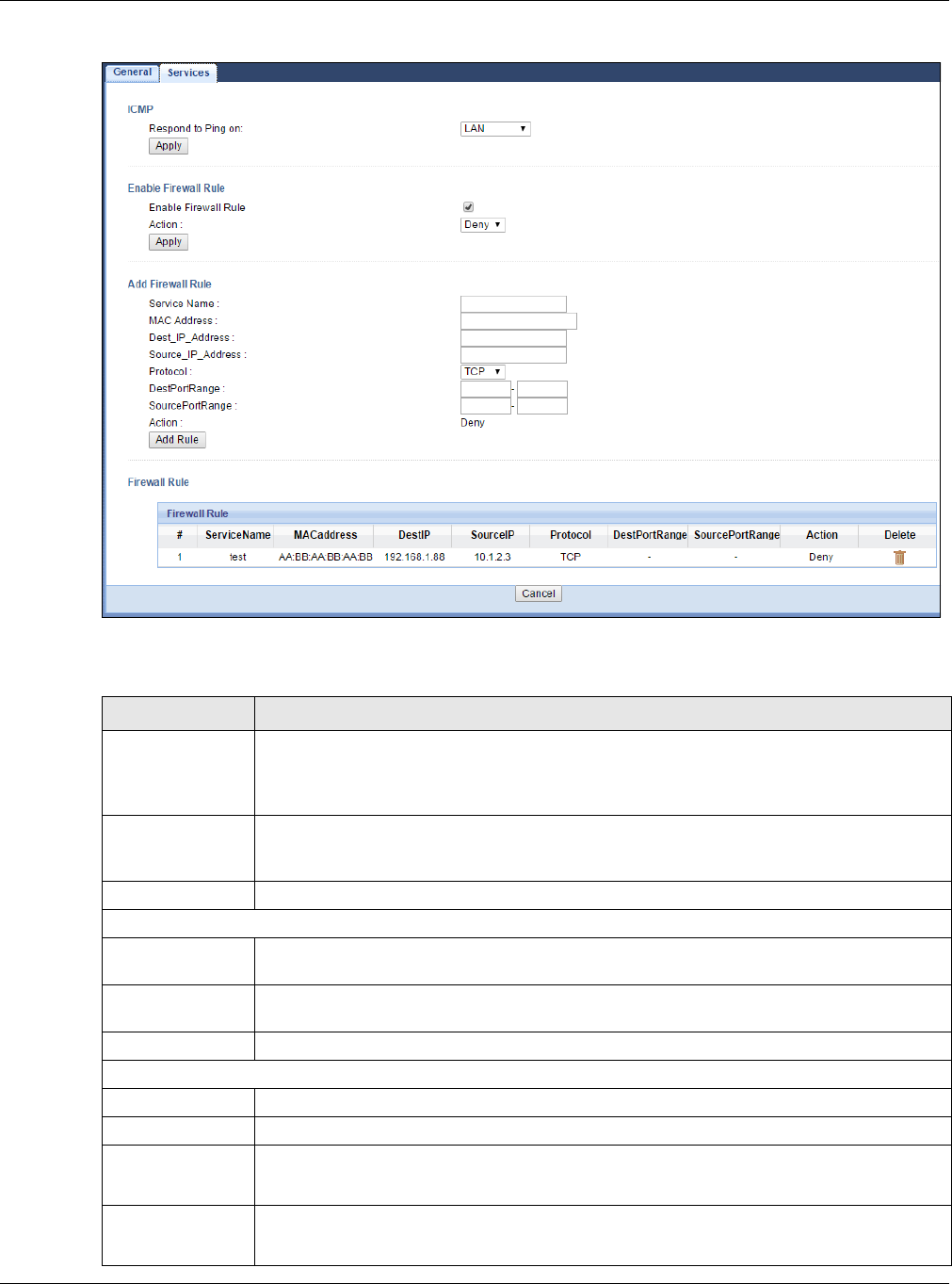
Chapter 17 Firewall
EMG6765-Q10A User’s Guide
130
Figure 75 Security > Firewall > Services l
The following table describes the labels in this screen.
Table 56 Security > Firewall > Services
LABEL DESCRIPTION
ICMP Internet Control Message Protocol is a message control and error-reporting protocol between
a host server and a gateway to the Internet. ICMP uses Internet Protocol (IP) datagrams, but
the messages are processed by the TCP/IP software and directly apparent to the application
user.
Respond to Ping
on
The EMG6765-Q10A will not respond to any incoming Ping requests when Disable is selected.
Select LAN to reply to incoming LAN Ping requests. Select WAN to reply to incoming WAN Ping
requests. Otherwise select LAN&WAN to reply to all incoming LAN and WAN Ping requests.
Apply Click Apply to save the settings.
Enable Firewall Rule
Enable Firewall
Rule
Select this check box to activate the firewall rules that you define (see Add Firewall Rule
below).
Action Select which action the firewall rule applies to the packets, select Deny to drop the packets
and Allow to accept the packets.
Apply Click Apply to save the settings.
Add Firewall Rule
Service Name Enter a name that identifies or describes the firewall rule.
MAC Address Enter the MAC address of the computer for which the firewall rule applies.
Dest IP Address Enter the IP address of the computer to which traffic for the application or service is entering.
The EMG6765-Q10A applies the firewall rule to traffic initiating from this computer.
Source IP Address Enter the IP address of the computer that initializes traffic for the application or service.
The EMG6765-Q10A applies the firewall rule to traffic initiating from this computer.

Chapter 17 Firewall
EMG6765-Q10A User’s Guide
131
See Appendix B on page 200 for commonly used services and port numbers.
Protocol Select the protocol (TCP, UDP or ICMP) used to transport the packets for which you want to
apply the firewall rule.
Dest Port Range Enter the port number/range of the destination that define the traffic type, for example TCP
port 80 defines web traffic.
Source Port Range Enter the port number/range of the source that define the traffic type, for example TCP port
80 defines web traffic.
Action This field displays whether the firewall silently discards packets (Deny), or permits the passage
of packets (Allow).
Add Rule Click Add to save the firewall rule.
Firewall Rule
#This is your firewall rule number. The ordering of your rules is important as rules are applied in
turn.
Service Name This is a name that identifies or describes the firewall rule.
MAC address This is the MAC address of the computer for which the firewall rule applies.
Dest IP This is the IP address of the computer to which traffic for the application or service is entering.
Source IP This is the IP address of the computer from which traffic for the application or service is
initialized.
Protocol This is the protocol (TCP, UDP or ICMP) used to transport the packets for which you want to
apply the firewall rule.
Dest Port Range This is the port number/range of the destination that define the traffic type, for example TCP
port 80 defines web traffic.
Source Port Range This is the port number/range of the source that define the traffic type, for example TCP port
80 defines web traffic.
Action Deny - Traffic matching the conditions of the firewall rule are stopped.
Delete Click Delete to remove the firewall rule.
Cancel Click Cancel to start configuring this screen again.
Table 56 Security > Firewall > Services (continued)
LABEL DESCRIPTION
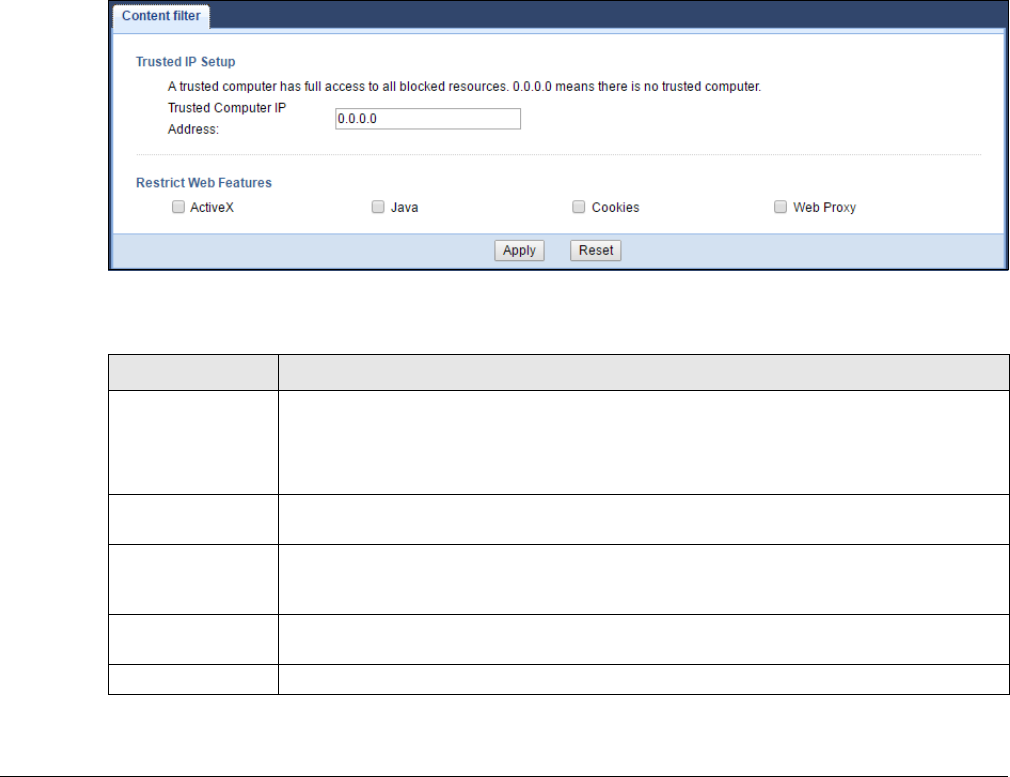
EMG6765-Q10A User’s Guide
132
CHAPTER 18
Content Filtering
18.1 Overview
This chapter shows you how to configure content filtering. Content filtering is the ability to block certain
web features.
18.2 Content Filter
Use this screen to restrict web features, and designate a trusted computer. Click Security > Content Filter
to open the Content Filter screen.
Figure 76 Security > Content Filter
The following table describes the labels in this screen.
Table 57 Security > Content Filter
LABEL DESCRIPTION
Trusted IP Setup To enable this feature, type an IP address of any one of the computers in your network that
you want to have as a trusted computer. This allows the trusted computer to have full access
to all features that are configured to be blocked by content filtering.
Leave this field blank to have no trusted computers.
Restrict Web
Features
Select the box(es) to restrict a feature. When you download a page containing a restricted
feature, that part of the web page will appear blank or grayed out.
ActiveX A tool for building dynamic and active Web pages and distributed object applications.
When you visit an ActiveX Web site, ActiveX controls are downloaded to your browser, where
they remain in case you visit the site again.
Java A programming language and development environment for building downloadable Web
components or Internet and intranet business applications of all kinds.
Cookies Used by Web servers to track usage and provide service based on ID.

Chapter 18 Content Filtering
EMG6765-Q10A User’s Guide
133
Web Proxy A server that acts as an intermediary between a user and the Internet to provide security,
administrative control, and caching service. When a proxy server is located on the WAN it is
possible for LAN users to circumvent content filtering by pointing to this proxy server.
Apply Click Apply to save your changes.
Cancel Click Cancel to begin configuring this screen afresh
Table 57 Security > Content Filter (continued)
LABEL DESCRIPTION
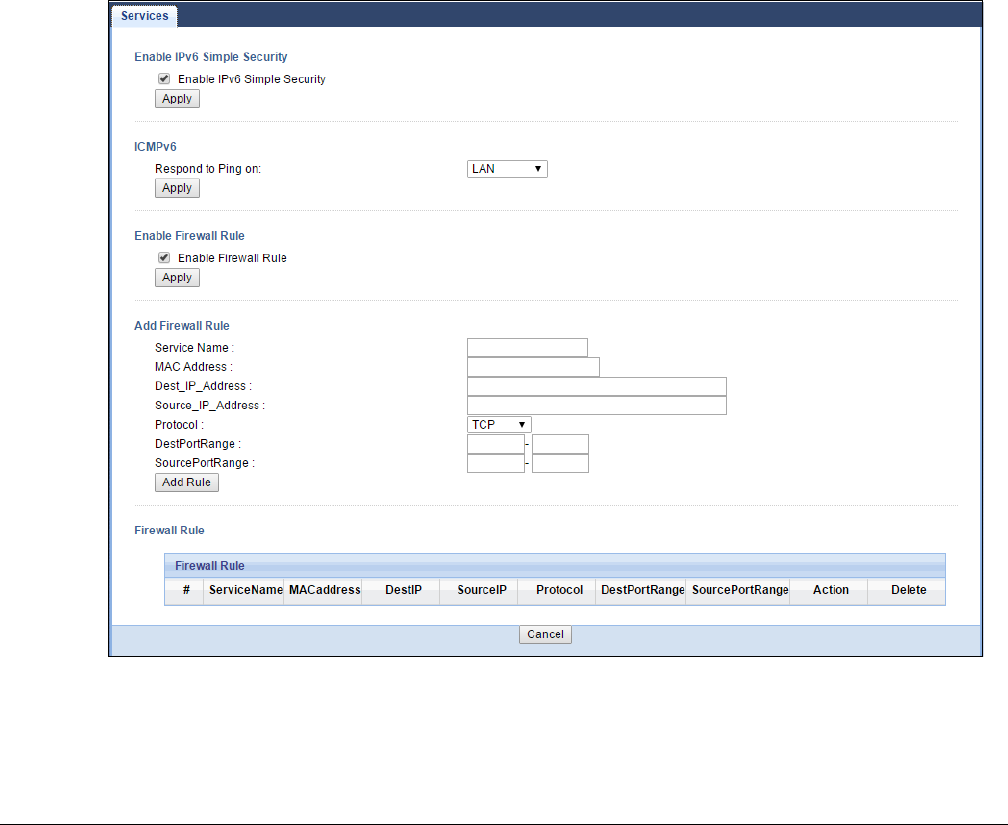
EMG6765-Q10A User’s Guide
134
CHAPTER 19
IPv6 Firewall
19.1 Overview
This chapter shows you how to enable and create IPv6 firewall rules to block unwanted IPv6 traffic.
19.2 IPv6 Firewall Screen
Click Configuration > Security > IPv6 Firewall. The Service screen appears as shown.
Figure 77 Configuration > Security > IPv6 Firewall

Chapter 19 IPv6 Firewall
EMG6765-Q10A User’s Guide
135
The following table describes the labels in this screen.
Table 58 Configuration > Security > IPv6 Firewall
LABEL DESCRIPTION
Enable IPv6 Simple
Security
Select this to enable IPv6 Simple Security. IPv6 Simple Security is defined in RFC 6092. This
security discards certain packets (such as packets with multicast source and/or destination
address) to secure local networks and Internet.
Apply Click Apply to save the settings.
ICMPv6 Internet Control Message Protocol for IPv6 (ICMPv6 or ICMP for IPv6) is defined in RFC 4443.
ICMPv6 has a preceding Next Header value of 58, which is different from the value used to
identify ICMP for IPv4. ICMPv6 is an integral part of IPv6. IPv6 nodes use ICMPv6 to report
errors encountered in packet processing and perform other diagnostic functions, such as
"ping".
Respond to Ping on The EMG6765-Q10A will not respond to any incoming Ping requests when Disable is
selected. Select LAN to reply to incoming LAN Ping requests. Select WAN to reply to
incoming WAN Ping requests. Otherwise select LAN&WAN to reply to all incoming LAN and
WAN Ping requests.
Apply Click Apply to save the settings.
Enable Firewall Rule
Enable Firewall Rule Select this check box to activate the firewall rules that you define (see Add Firewall Rule
below).
Apply Click Apply to save the settings.
Add Firewall Rule
Service Name Enter a name that identifies or describes the firewall rule.
MAC Address Enter the MAC address of the computer for which the firewall rule applies.
Dest_IP_Address Enter the IPv6 address of the computer to which traffic for the application or service is
entering.
The EMG6765-Q10A applies the firewall rule to traffic destined for this computer.
Source_IP_Address Enter the IPv6 address of the computer that initializes traffic for the application or service.
The EMG6765-Q10A applies the firewall rule to traffic initiating from this computer.
Protocol Select the protocol (TCP, UDP or ICMP) used to transport the packets for which you want to
apply the firewall rule.
Dest Port Range Enter the port number/range of the destination that defines the traffic type, for example
TCP port 80 defines web traffic.
Source Port Range Enter the port number/range of the source that defines the traffic type, for example TCP
port 80 defines web traffic.
Add Rule Click Add Rule to save the firewall rule.
Firewall Rule
#This is your firewall rule number. The ordering of your rules is important as rules are applied in
turn.
ServiceName This is a name that identifies or describes the firewall rule.
MACaddress This is the MAC address of the computer for which the firewall rule applies.
DestIP This is the IP address of the computer to which traffic for the application or service is
entering.
SourceIP This is the IP address of the computer to which traffic for the application or service is
initialized.
Protocol This is the protocol (TCP, UDP or ICMP) used to transport the packets for which you want to
apply the firewall rule.
DestPortRange This is the port number/range of the destination that defines the traffic type, for example
TCP port 80 defines web traffic.

Chapter 19 IPv6 Firewall
EMG6765-Q10A User’s Guide
136
SourcePortRange This is the port number/range of the source that defines the traffic type, for example TCP
port 80 defines web traffic.
Action DROP - Traffic matching the conditions of the firewall rule is stopped.
Delete Click Delete to remove the firewall rule.
Cancel Click Cancel to restore your previously saved settings.
Table 58 Configuration > Security > IPv6 Firewall (continued)
LABEL DESCRIPTION

EMG6765-Q10A User’s Guide
137
CHAPTER 20
Parental Control
20.1 Overview
Parental controls allow you to block specific URLs. You can also define time periods and days during
which the EMG6765-Q10A performs parental control on a specific user.
20.1.1 What You Need To Know
The following terms and concepts may help as you read through this chapter.
Keyword Blocking URL Checking
The EMG6765-Q10A checks the URL’s domain name (or IP address) and file path separately when
performing keyword blocking.
The URL’s domain name or IP address is the characters that come before the first slash in the URL. For
example, with the URL www.zyxel.com.tw/news/pressroom.php, the domain name is
www.zyxel.com.tw.
The file path is the characters that come after the first slash in the URL. For example, with the URL
www.zyxel.com.tw/news/pressroom.php, the file path is news/pressroom.php.
Since the EMG6765-Q10A checks the URL’s domain name (or IP address) and file path separately, it will
not find items that go across the two. For example, with the URL www.zyxel.com.tw/news/
pressroom.php, the EMG6765-Q10A would find “tw” in the domain name (www.zyxel.com.tw). It would
also find “news” in the file path (news/pressroom.php) but it would not find “tw/news”.
20.2 Parental Control Screen
Use this screen to enable parental control, view the parental control rules and schedules.
Click Configuration > Security > Parental Control to open the following screen.
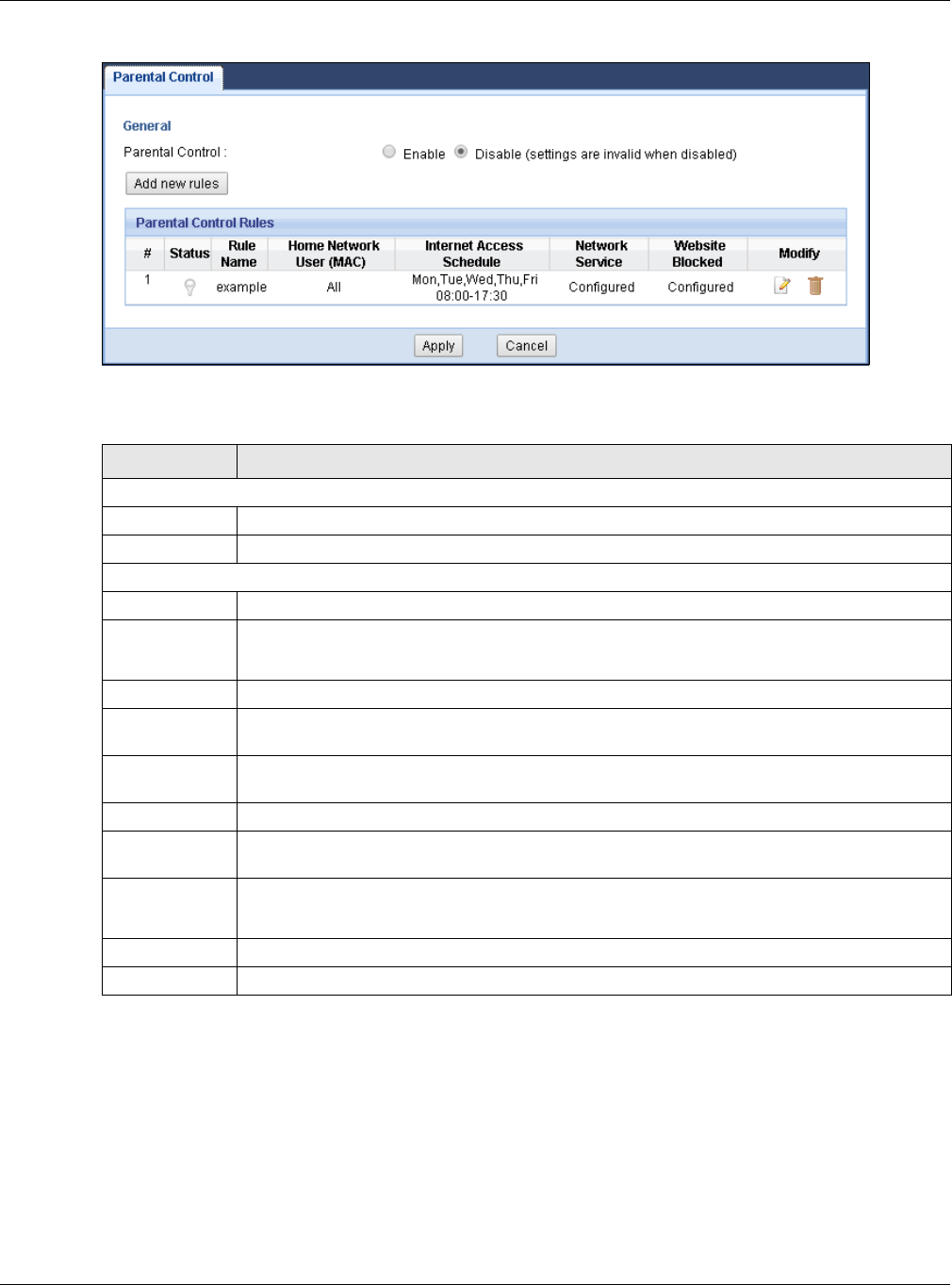
Chapter 20 Parental Control
EMG6765-Q10A User’s Guide
138
Figure 78 Security > Parental Control
The following table describes the fields in this screen.
20.2.1 Add/Edit a Parental Control Rule
Click Add new rules in the Parental Control screen to add a new rule or click the Edit icon next to an
existing rule to edit it. Use this screen to configure a restricted access schedule and/or URL filtering
settings to block the users on your network from accessing certain web sites.
Table 59 Security > Parental Control
LABEL DESCRIPTION
General
Parental Control Select Enable to activate parental control.
Add new rules Click this if you want to configure a new parental control rule.
Parental Control Rules
#This shows the index number of the rule.
Status This indicates whether the rule is active or not.
A yellow bulb signifies that this rule is active. A gray bulb signifies that this rule is not active.
Rule Name This shows the name of the rule.
Home Network
User (MAC)
This shows the MAC address of the LAN user’s computer to which this rule applies.
Internet Access
Schedule
This shows the day(s) and time on which parental control is enabled.
Network Service This shows whether the network service is configured. If not, None will be shown.
Website
Blocked
This shows whether the website block is configured. If not, None will be shown.
Modify Click the Edit icon to go to the screen where you can edit the rule.
Click the Delete icon to delete an existing rule.
Apply Click Apply to save your changes.
Cancel Click Cancel to restore your previously saved settings.
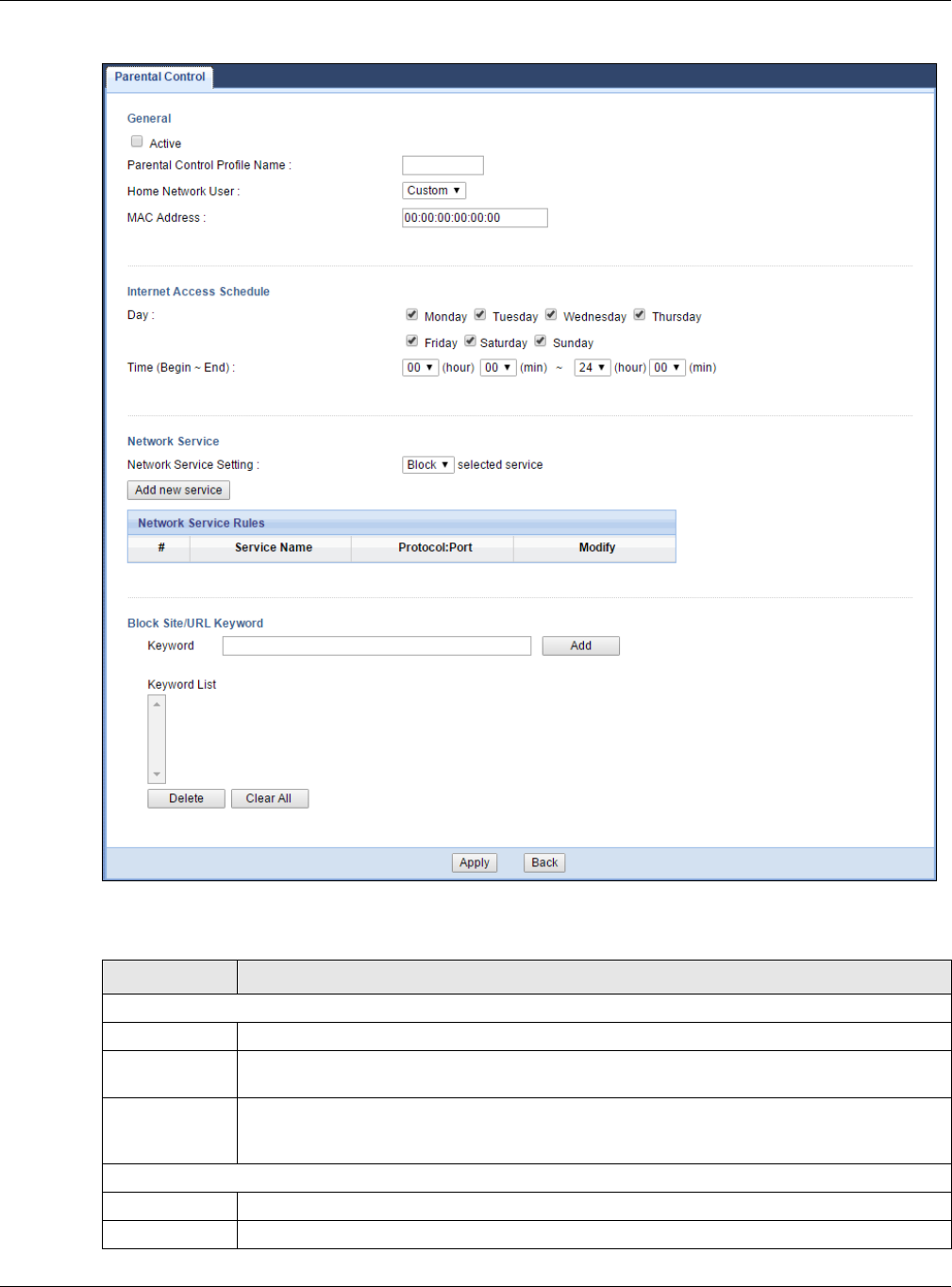
Chapter 20 Parental Control
EMG6765-Q10A User’s Guide
139
Figure 79 Security > Parental Control: Add/Edit new rules
The following table describes the fields in this screen.
Table 60 Security > Parental Control: Add/Edit new rules
LABEL DESCRIPTION
General
Active Select the check box to activate this parental control rule.
Parental Control
Profile Name
Enter a descriptive name for the rule.
Home Network
User
Select the LAN user that you want to apply this rule to from the drop-down list box. If you select
Custom, enter the LAN user’s MAC address in the MAC Address field. If you select All, the rule
applies to all LAN users.
Internet Access Schedule
Day Select check boxes for the days that you want the EMG6765-Q10A to perform parental control.
Time Drag the time bar to define the time that the LAN user is allowed access.
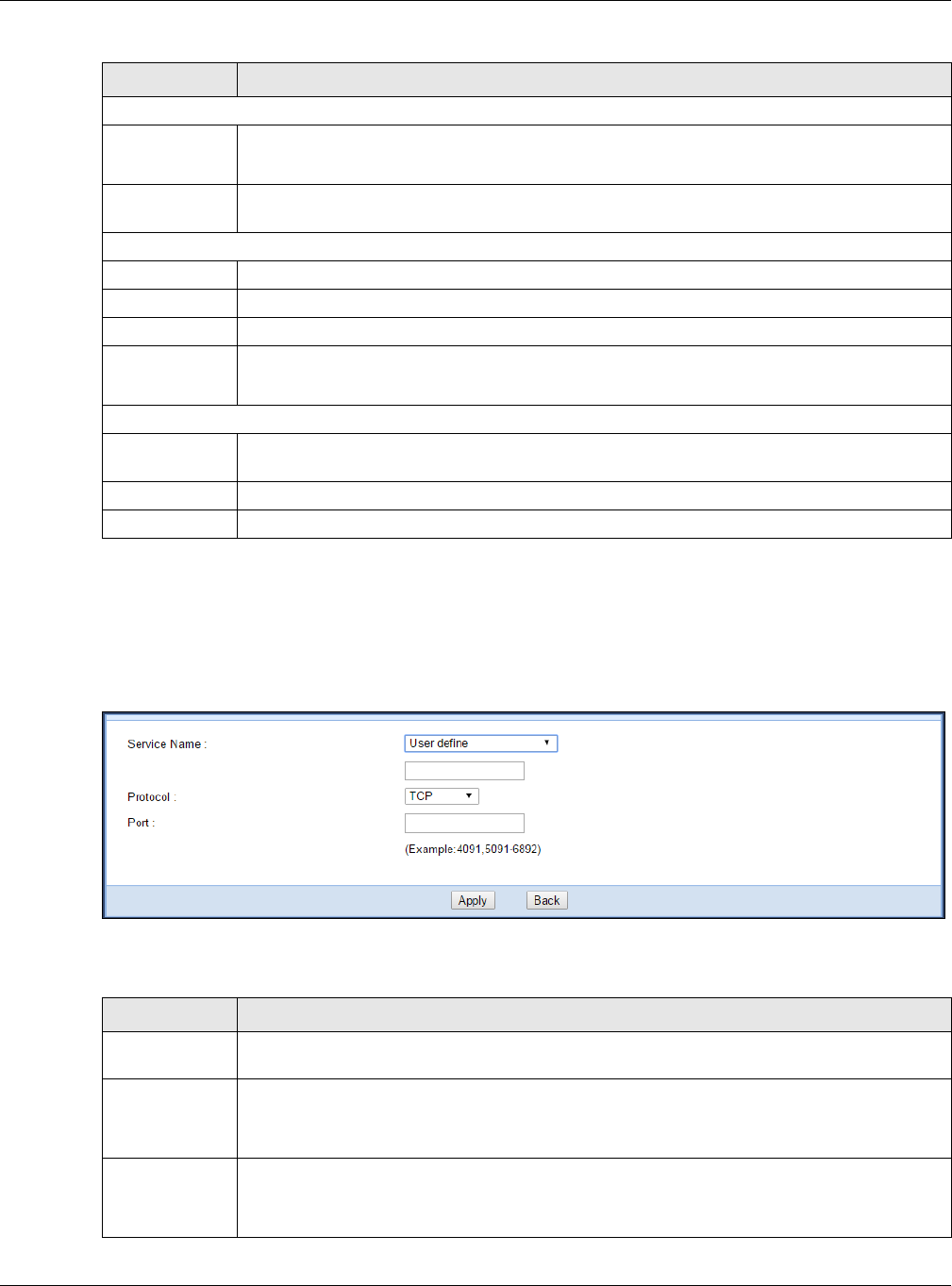
Chapter 20 Parental Control
EMG6765-Q10A User’s Guide
140
20.2.2 Add/Edit a Service
Click Add new service in the Parental Control > Add/Edit new rules screen to add a new entry or click
the Edit icon next to an existing entry to edit it. Use this screen to configure a service rule.
Figure 80 Security > Parental Control > Add/Edit new rules > Add/Edit new service
The following table describes the fields in this screen.
Network Service
Network Service
Setting
If you select Block, the EMG6765-Q10A prohibits the users from using the services listed below.
If you select Allow, the EMG6765-Q10A blocks all services except ones listed below.
Add new
service
Click this to show a screen in which you can add a new service rule. You can configure the
Service Name, Protocol, and Port of the new rule.
Network Service Rules
#This shows the index number of the rule. Select the check box next to the rule to activate it.
Service Name This shows the name of the service.
Protocol:Port This shows the protocol and the port of the service.
Modify Click the Edit icon to go to the screen where you can edit the rule.
Click the Delete icon to delete an existing rule.
Blocked Site/URL Keyword
Keyword Use this field to enter the website URL or URL keyword to which the EMG6765-Q10A blocks access
and click Add. Click Delete to remove it. Click Clear All to remove all keywords entered.
Apply Click Apply to save your settings back to the EMG6765-Q10A.
Back Click Back to return to the previous screen.
Table 60 Security > Parental Control: Add/Edit new rules (continued)
LABEL DESCRIPTION
Table 61 Security > Parental Control > Add/Edit new rules > Add/Edit new service
LABEL DESCRIPTION
Service Name Select the name of the service. Otherwise, select User define and manually specify the name,
protocol and the port of the service.
Protocol Select the transport layer protocol used for the service. Choices are TCP, UDP, or TCP/UDP.
If you have chosen a pre-defined service in the Service Name field, this field will not be
configurable.
Port Enter the port of the service.
If you have chosen a pre-defined service in the Service Name field, this field will not be
configurable.

Chapter 20 Parental Control
EMG6765-Q10A User’s Guide
141
20.3 Technical Reference
The following section contains additional technical information about the EMG6765-Q10A features
described in this chapter.
20.3.1 Customizing Keyword Blocking URL Checking
You can use commands to set how much of a website’s URL the content filter is to check for keyword
blocking. See the appendices for information on how to access and use the command interpreter.
Domain Name or IP Address URL Checking
By default, the EMG6765-Q10A checks the URL’s domain name or IP address when performing keyword
blocking.
This means that the EMG6765-Q10A checks the characters that come before the first slash in the URL.
For example, with the URL www.zyxel.com.tw/news/pressroom.php, content filtering only searches for
keywords within www.zyxel.com.tw.
Full Path URL Checking
Full path URL checking has the EMG6765-Q10A check the characters that come before the last slash in
the URL.
For example, with the URL www.zyxel.com.tw/news/pressroom.php, full path URL checking searches for
keywords within www.zyxel.com.tw/news/.
Use the ip urlfilter customize actionFlags 6 [disable | enable] command to extend (or
not extend) the keyword blocking search to include the URL's full path.
File Name URL Checking
Filename URL checking has the EMG6765-Q10A check all of the characters in the URL.
For example, filename URL checking searches for keywords within the URL www.zyxel.com.tw/news/
pressroom.php.
Use the ip urlfilter customize actionFlags 8 [disable | enable] command to extend (or
not extend) the keyword blocking search to include the URL's complete filename.
Apply Click Apply to save your settings with the EMG6765-Q10A.
Back Click Back to return to the previous screen.
Table 61 Security > Parental Control > Add/Edit new rules > Add/Edit new service (continued)
LABEL DESCRIPTION

EMG6765-Q10A User’s Guide
142
CHAPTER 21
Bandwidth Management
21.1 Overview
Quality of Service (QoS) refers to both a network’s ability to deliver data with minimum delay, and the
networking methods used to control the use of bandwidth. Without QoS, all traffic data is equally likely
to be dropped when the network is congested. This can cause a reduction in network performance and
make the network inadequate for time-critical application such as video-on-demand.
Configure QoS on the EMG6765-Q10A to group and prioritize application traffic and fine-tune network
performance. Setting up QoS involves these steps:
1Configure classifiers to sort traffic into different flows.
2Assign priority and define actions to be performed for a classified traffic flow.
The EMG6765-Q10A assigns each packet a priority and then queues the packet accordingly. Packets
assigned a high priority are processed more quickly than those with low priority if there is congestion,
allowing time-sensitive applications to flow more smoothly. Time-sensitive applications include both
those that require a low level of latency (delay) and a low level of jitter (variations in delay) such as
Voice over IP (VoIP) or Internet gaming, and those for which jitter alone is a problem such as Internet
radio or streaming video.
This chapter contains information about configuring QoS and editing classifiers.
21.1.1 What You Can Do in this Chapter
• The General screen lets you enable or disable QoS and set the upstream bandwidth (Section 21.3 on
page 144).
• The Queue Setup screen lets you configure QoS queue assignment (Section 21.4 on page 145).
• The Class Setup screen lets you add, edit or delete QoS classifiers (Section 21.5 on page 147).
21.2 What You Need to Know
The following terms and concepts may help as you read through this chapter.
QoS versus CoS
QoS is used to prioritize source-to-destination traffic flows. All packets in the same flow are given the
same priority. CoS (class of service) is a way of managing traffic in a network by grouping similar types of
traffic together and treating each type as a class. You can use CoS to give different priorities to different
packet types.
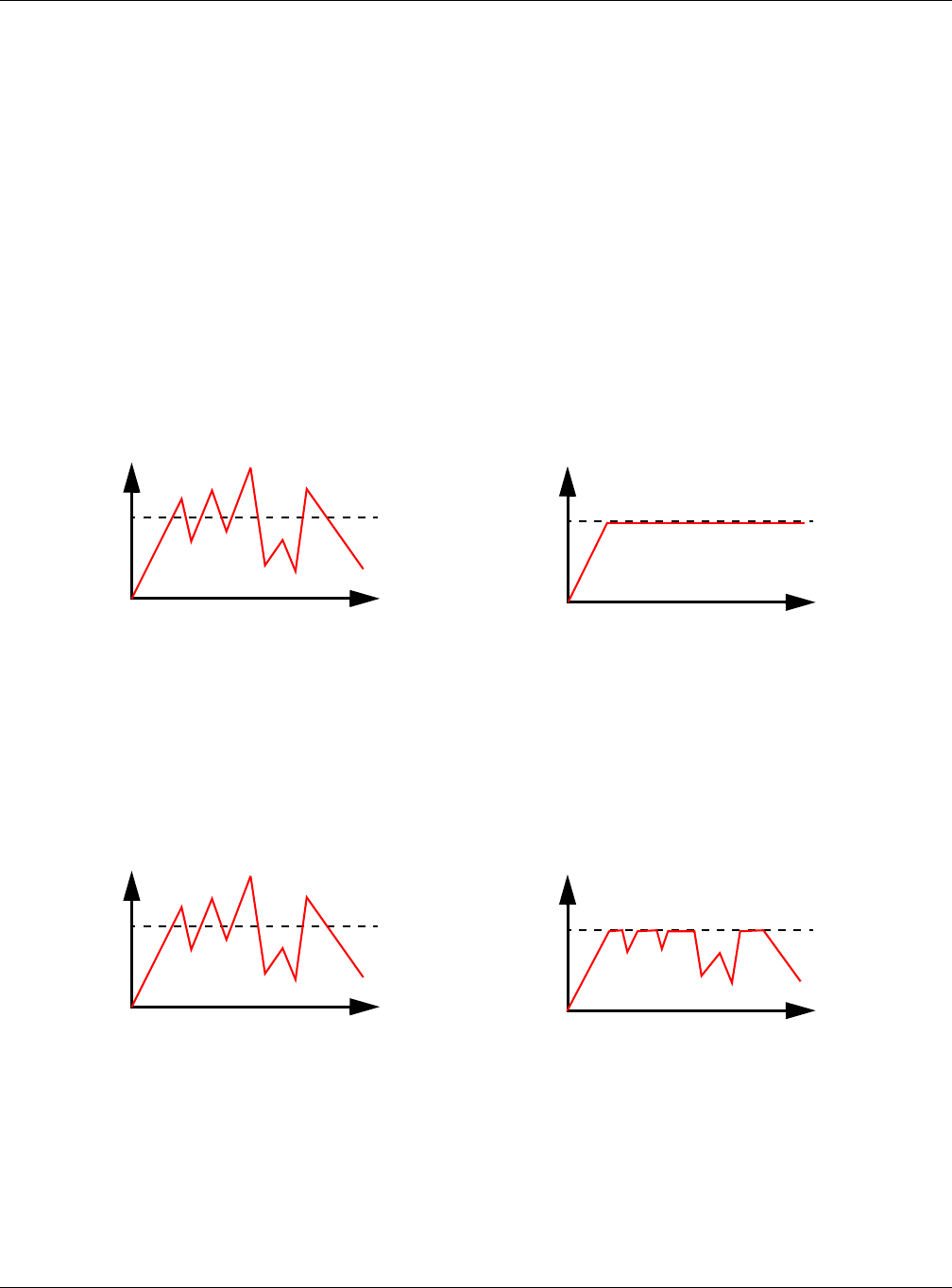
Chapter 21 Bandwidth Management
EMG6765-Q10A User’s Guide
143
CoS technologies include IEEE 802.1p layer 2 tagging and DiffServ (Differentiated Services or DS). IEEE
802.1p tagging makes use of three bits in the packet header, while DiffServ is a new protocol and
defines a new DS field, which replaces the eight-bit ToS (Type of Service) field in the IP header.
Tagging and Marking
In a QoS class, you can configure whether to add or change the DSCP (DiffServ Code Point) value, IEEE
802.1p priority level and VLAN ID number in a matched packet. When the packet passes through a
compatible network, the networking device, such as a backbone switch, can provide specific
treatment or service based on the tag or marker.
Traffic Shaping
Bursty traffic may cause network congestion. Traffic shaping regulates packets to be transmitted with a
pre-configured data transmission rate using buffers (or queues). Your EMG6765-Q10A uses the Token
Bucket algorithm to allow a certain amount of large bursts while keeping a limit at the average rate.
Traffic Policing
Traffic policing is the limiting of the input or output transmission rate of a class of traffic on the basis of
user-defined criteria. Traffic policing methods measure traffic flows against user-defined criteria and
identify it as either conforming, exceeding or violating the criteria.
The EMG6765-Q10A supports three incoming traffic metering algorithms: Token Bucket Filter (TBF), Single
Rate Two Color Maker (srTCM), and Two Rate Two Color Marker (trTCM). You can specify actions which
are performed on the colored packets. See Section 21.6 on page 150 for more information on each
metering algorithm.
Traffic
Time
Traffic Rate
Traffic
Time
Traffic Rate
(Before Traffic Shaping) (After Traffic Shaping)
Traffic
Time
Traffic Rate
Traffic
Time
Traffic Rate
(Before Traffic Policing) (After Traffic Policing)
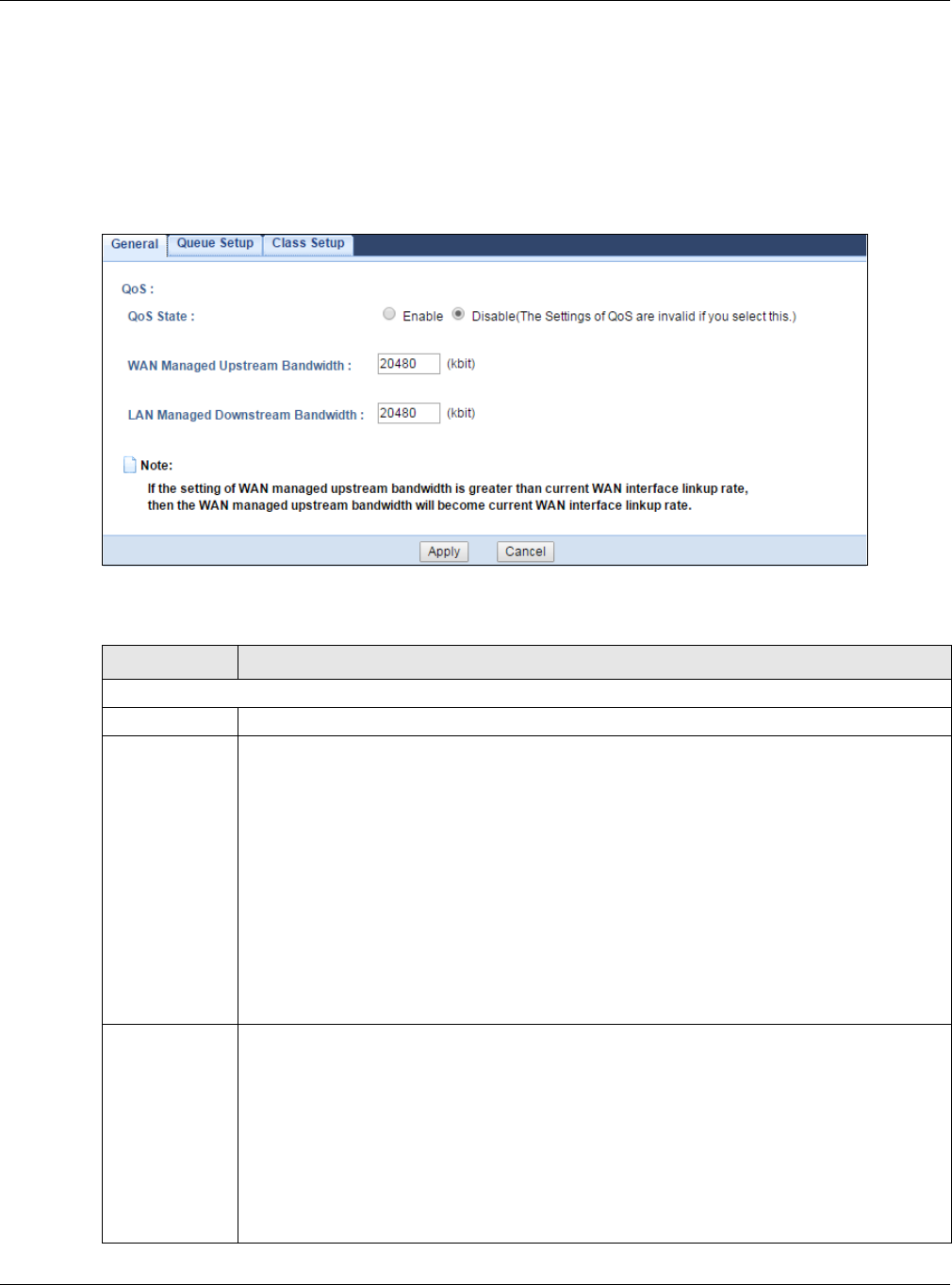
Chapter 21 Bandwidth Management
EMG6765-Q10A User’s Guide
144
21.3 Bandwidth MGMT General Screen
Click Management > Bandwidth MGMT > General to open the screen as shown next.
Use this screen to enable or disable QoS and set the upstream bandwidth. See Section 21.1 on page 142
for more information.
Figure 81 Management > Bandwidth MGMT > General
The following table describes the labels in this screen.
Table 62 Management > Bandwidth MGMT > General
LABEL DESCRIPTION
QoS
QoS State Select the Enable check box to turn on QoS to improve your network performance.
WAN Managed
Upstream
Bandwidth
Enter the amount of upstream bandwidth for the WAN interfaces that you want to allocate using
QoS.
The recommendation is to set this speed to match the interfaces’ actual transmission speed. For
example, set the WAN interfaces’ speed to 100000 kbps if your Internet connection has an
upstream transmission speed of 100 Mbps.
You can set this number higher than the interfaces’ actual transmission speed. The EMG6765-
Q10A uses up to 95% of the DSL port’s actual upstream transmission speed even if you set this
number higher than the DSL port’s actual transmission speed.
You can also set this number lower than the interfaces’ actual transmission speed. This will cause
the EMG6765-Q10A to not use some of the interfaces’ available bandwidth.
If you leave this field blank, the EMG6765-Q10A automatically sets this number to be 95% of the
WAN interfaces’ actual upstream transmission speed.
LAN Managed
Downstream
Bandwidth
Enter the amount of downstream bandwidth for the LAN interfaces (including WLAN) that you
want to allocate using QoS.
The recommendation is to set this speed to match the WAN interfaces’ actual transmission
speed. For example, set the LAN managed downstream bandwidth to 100000 kbps if you use a
100 Mbps wired Ethernet WAN connection.
You can also set this number lower than the WAN interfaces’ actual transmission speed. This will
cause the EMG6765-Q10A to not use some of the interfaces’ available bandwidth.
If you leave this field blank, the EMG6765-Q10A automatically sets this to the LAN interfaces’
maximum supported connection speed.
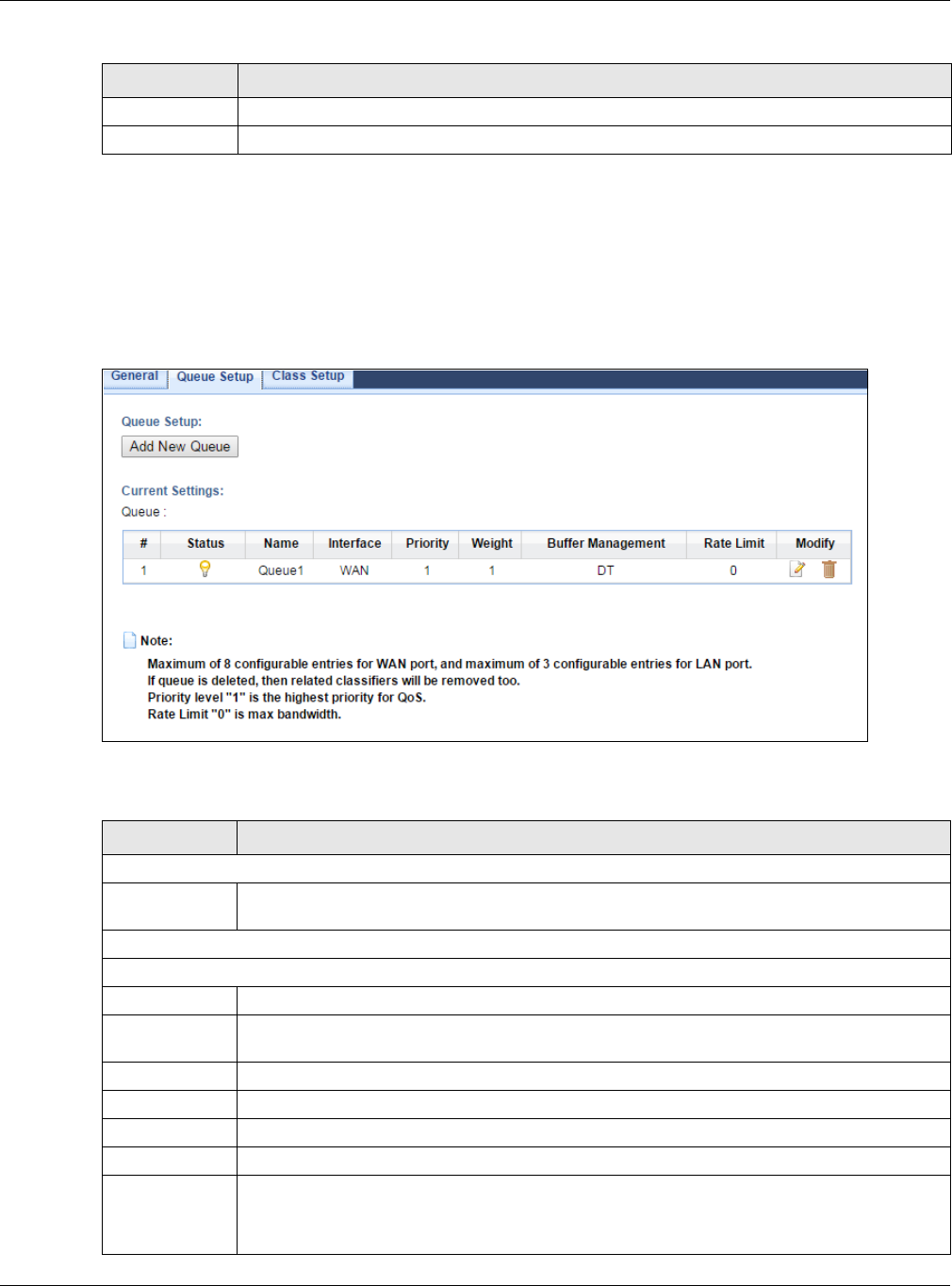
Chapter 21 Bandwidth Management
EMG6765-Q10A User’s Guide
145
21.4 The Queue Setup Screen
Use this screen to configure QoS queue assignment. Click Management > Bandwidth MGMT > Queue
Setup to open the screen as shown next.
Figure 82 Management > Bandwidth MGMT > Queue Setup
The following table describes the labels in this screen.
Apply Click Apply to save your changes.
Cancel Click Cancel to restore your previously saved settings.
Table 62 Management > Bandwidth MGMT > General (continued) (continued)
LABEL DESCRIPTION
Table 63 Management > Bandwidth MGMT > Queue Setup
LABEL DESCRIPTION
Queue Setup
Add new
Queue
Click this button to create a new queue entry.
Current Settings
Queue
#This is the index number of the entry.
Status This field displays whether the queue is active or not. A yellow bulb signifies that this queue is
active. A gray bulb signifies that this queue is not active.
Name This shows the descriptive name of this queue.
Interface This shows the name of the EMG6765-Q10A’s interface through which traffic in this queue passes.
Priority This shows the priority of this queue.
Weight This shows the weight of this queue.
Buffer
Management
This shows the queue management algorithm used for this queue.
Queue management algorithms determine how the EMG6765-Q10A should handle packets
when it receives too many (network congestion).
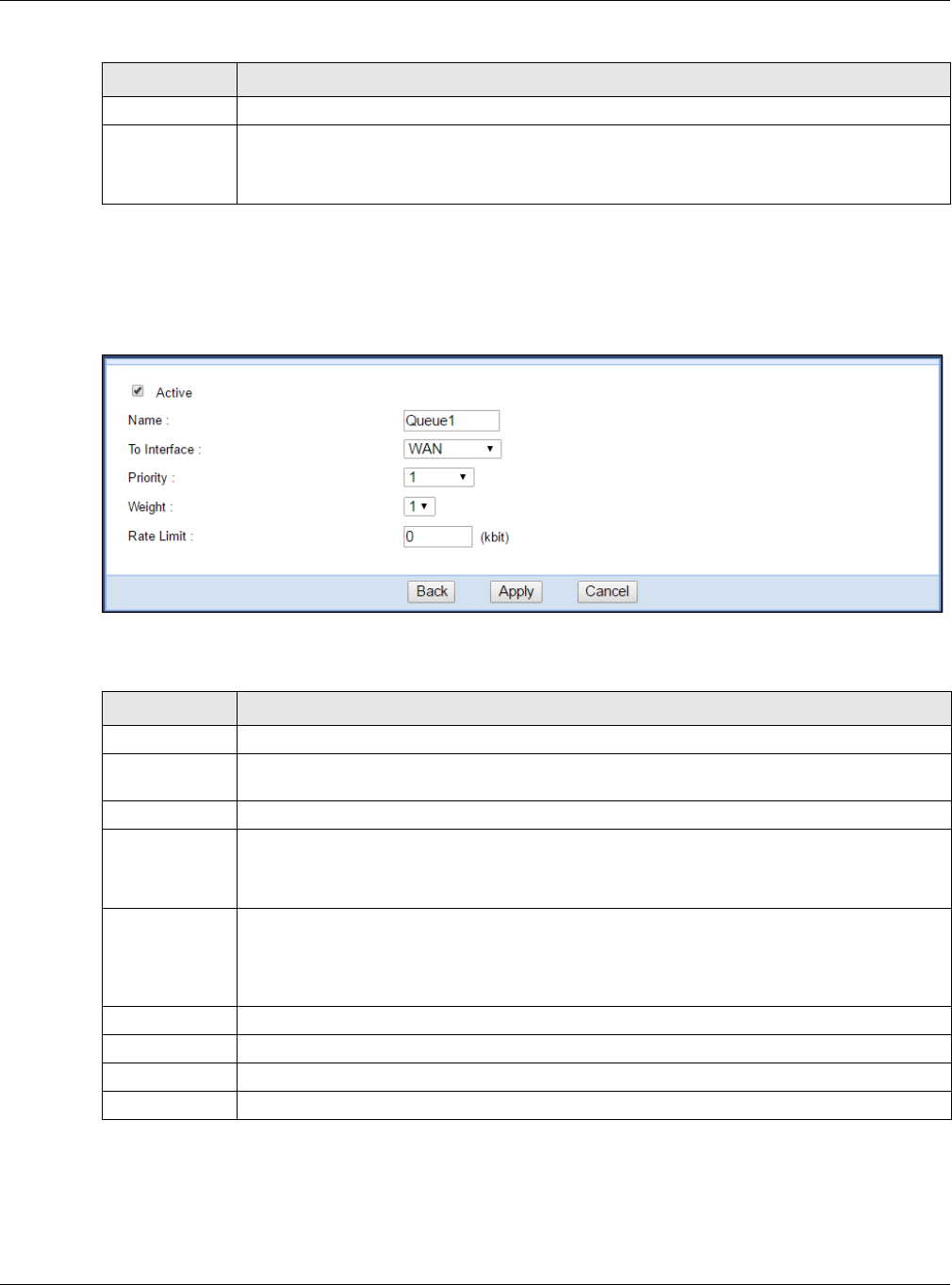
Chapter 21 Bandwidth Management
EMG6765-Q10A User’s Guide
146
21.4.1 Add/Edit a Queue
Click Add New Queue or the Edit icon in the Queue Setup screen to configure a queue.
Figure 83 Management > Bandwidth MGMT > Queue Setup: Add/Edit new queue
The following table describes the labels in this screen.
Rate Limit This shows the maximum transmission rate allowed for traffic on this queue.
Modify Click the Edit icon to edit the queue.
Click the Delete icon to delete an existing queue. Note that subsequent rules move up by one
when you take this action.
Table 63 Management > Bandwidth MGMT > Queue Setup (continued)
LABEL DESCRIPTION
Table 64 Management > Bandwidth MGMT > Queue Setup: Add/Edit new queue
LABEL DESCRIPTION
Active Select to enable or disable this queue.
Name Enter the descriptive name of this queue. Note that \"<>%\\^[]`\+\$\,='#&@.:() are not
allowed.
To Interface Select the interface to which this queue is applied.
Priority Select the priority level (from 1 to 7) of this queue.
The smaller the number, the higher the priority level. Traffic assigned to higher priority queues
gets through faster while traffic in lower priority queues is dropped if the network is congested.
Weight Select the weight (from 1 to 8) of this queue.
If two queues have the same priority level, the EMG6765-Q10A divides the bandwidth across the
queues according to their weights. Queues with larger weights get more bandwidth than
queues with smaller weights.
Rate Limit Specify the maximum transmission rate (in Kbps) allowed for traffic on this queue.
Back Click this to return to the previous screen.
Apply Click this to save your changes.
Cancel Click this to exit this screen without saving.
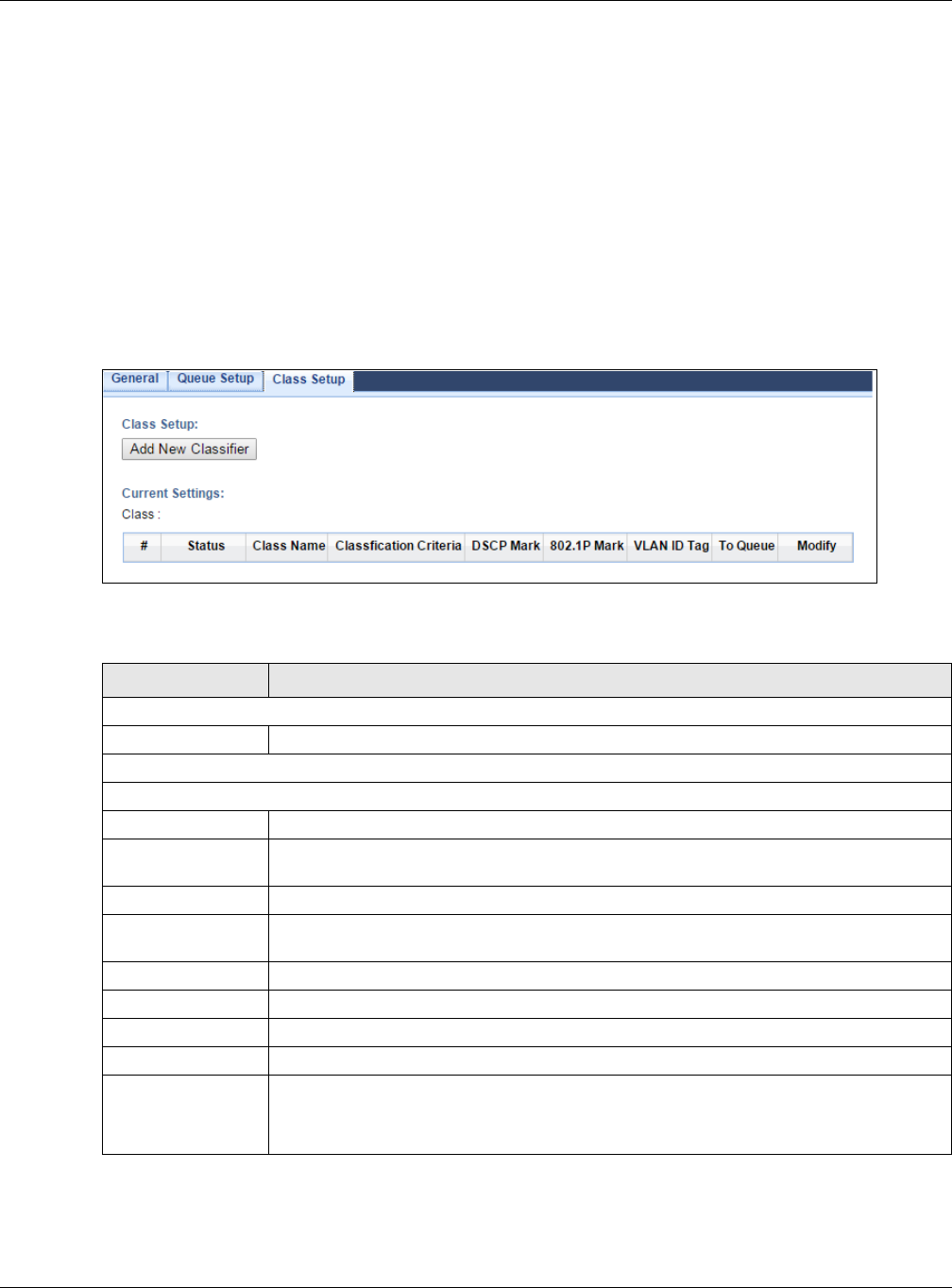
Chapter 21 Bandwidth Management
EMG6765-Q10A User’s Guide
147
21.5 The Class Setup Screen
Use this screen to add, edit or delete QoS classifiers. A classifier groups traffic into data flows according
to specific criteria such as the source address, destination address, source port number, destination port
number or incoming interface. For example, you can configure a classifier to select traffic from the
same protocol port (such as Telnet) to form a flow.
You can give different priorities to traffic that the EMG6765-Q10A forwards out through the WAN
interface. Give high priority to voice and video to make them run more smoothly. Similarly, give low
priority to many large file downloads so that they do not reduce the quality of other applications.
Click Management > Bandwidth MGMT > Class Setup to open the following screen.
Figure 84 Management > Bandwidth MGMT > Class Setup
The following table describes the labels in this screen.
Table 65 Management > Bandwidth MGMT > Class Setup
LABEL DESCRIPTION
Class Setup
Add new Classifier Click this to create a new classifier.
Current Settings
Class
#This is the index number of the entry.
Status This field displays whether the classifier is active or not. A yellow bulb signifies that this
classifier is active. A gray bulb signifies that this classifier is not active.
Class Name This is the name of the classifier.
Classification
Criteria
This shows criteria specified in this classifier, for example the interface from which traffic of
this class should come and the source MAC address of traffic that matches this classifier.
DSCP Mark This is the DSCP number added to traffic of this classifier.
802.1P Mark This is the IEEE 802.1p priority level assigned to traffic of this classifier.
VLAN ID Tag This is the VLAN ID number assigned to traffic of this classifier.
To Queue This is the name of the queue in which traffic of this classifier is put.
Modify Click the Edit icon to edit the classifier.
Click the Delete icon to delete an existing classifier. Note that subsequent rules move up by
one when you take this action.
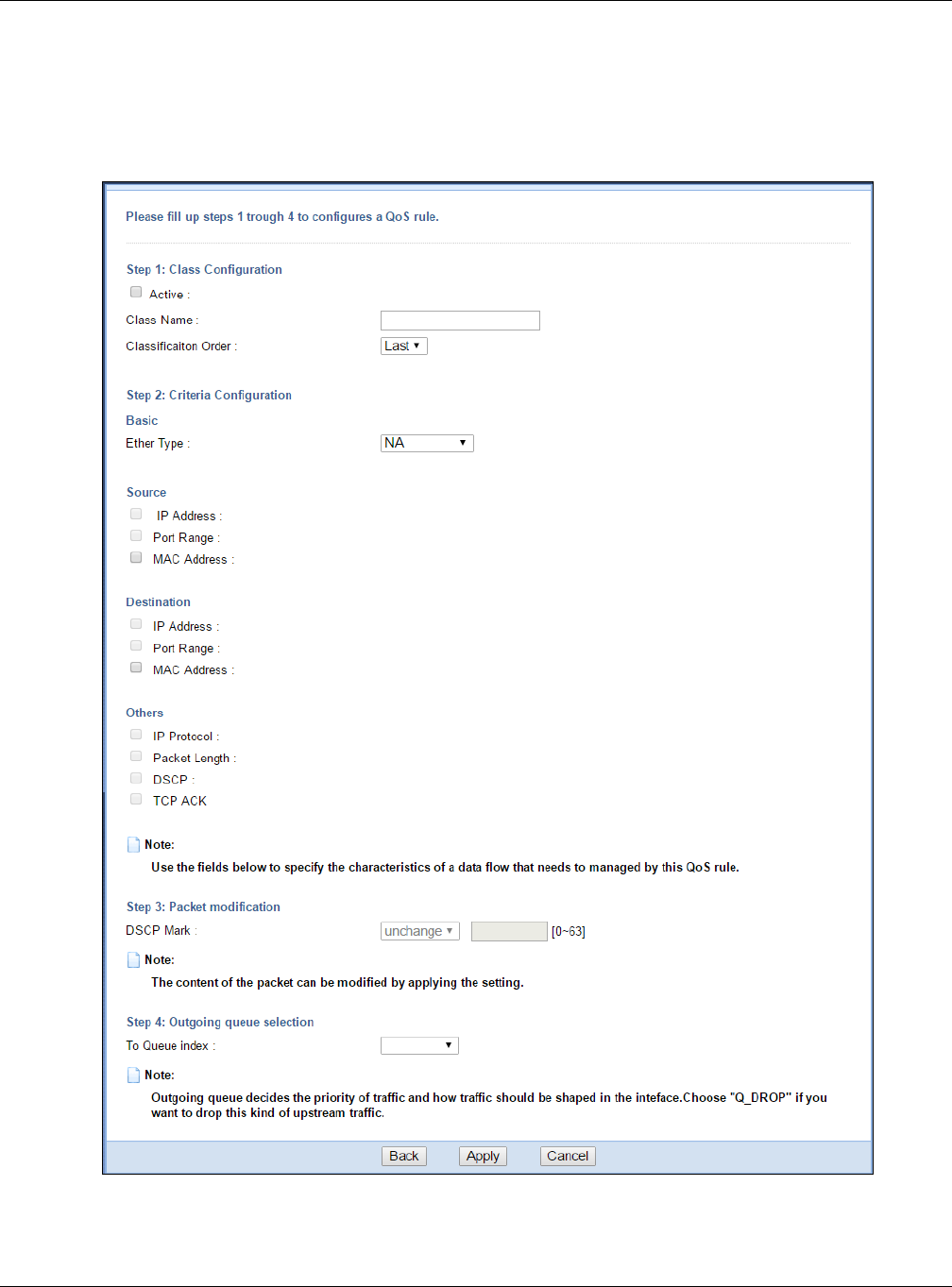
Chapter 21 Bandwidth Management
EMG6765-Q10A User’s Guide
148
21.5.1 Add/Edit a Classifier
Click Add New Classifier in the Class Setup screen or the Edit icon next to a classifier to open the
following screen.
Figure 85 Management > Bandwidth MGMT > Class Setup: Add/Edit new class

Chapter 21 Bandwidth Management
EMG6765-Q10A User’s Guide
149
The following table describes the labels in this screen.
Table 66 Management > Bandwidth MGMT > Class Setup: Add/Edit new class
LABEL DESCRIPTION
Step 1: Class Configuration
Active Select this to enable this classifier.
Class Name Enter a descriptive name of up to 15 printable English keyboard characters, not including
spaces.
Classification
Order
Select an existing number for where you want to put this classifier to move the classifier to the
number you selected after clicking Apply.
Select Last to put this rule in the back of the classifier list.
Step 2: Criteria Configuration
Basic
Ether Type Select a predefined application to configure a class for the matched traffic.
If you select IP, you also need to configure source or destination MAC address, IP address, DHCP
options, DSCP value or the protocol type.
If you select ARP, you also need to configure source or destination MAC address.
If you select 802.1Q, you can configure an 802.1p priority level.
Source
IP Address Select the check box and enter the source IP address in dotted decimal notation. A blank
source IP address means any source IP address.
Subnet
Netmask Enter the source subnet mask.
Port Range If you select TCP or UDP in the IP Protocol field, select the check box and enter the port
number(s) of the source.
MAC
Address Select the check box and enter the source MAC address of the packet.
MAC Mask Type the mask for the specified MAC address to determine which bits a packet’s MAC address
should match.
Enter “f” for each bit of the specified source MAC address that the traffic’s MAC address should
match. Enter “0” for the bit(s) of the matched traffic’s MAC address, which can be of any
hexadecimal character(s). For example, if you set the MAC address to 00:13:49:00:00:00 and the
mask to ff:ff:ff:00:00:00, a packet with a MAC address of 00:13:49:12:34:56 matches this criteria.
Exclude Select this option to exclude the packets that match the specified criteria from this classifier.
Destination
IP Address Select the check box and enter the source IP address in dotted decimal notation. A blank
source IP address means any source IP address.
Subnet
Netmask Enter the source subnet mask.
Port Range If you select TCP or UDP in the IP Protocol field, select the check box and enter the port
number(s) of the source.
MAC
Address Select the check box and enter the source MAC address of the packet.
MAC Mask Type the mask for the specified MAC address to determine which bits a packet’s MAC address
should match.
Enter “f” for each bit of the specified source MAC address that the traffic’s MAC address should
match. Enter “0” for the bit(s) of the matched traffic’s MAC address, which can be of any
hexadecimal character(s). For example, if you set the MAC address to 00:13:49:00:00:00 and the
mask to ff:ff:ff:00:00:00, a packet with a MAC address of 00:13:49:12:34:56 matches this criteria.
Exclude Select this option to exclude the packets that match the specified criteria from this classifier.

Chapter 21 Bandwidth Management
EMG6765-Q10A User’s Guide
150
21.6 Technical Reference
The following section contains additional technical information about the EMG6765-Q10A features
described in this chapter.
IEEE 802.1Q Tag
The IEEE 802.1Q standard defines an explicit VLAN tag in the MAC header to identify the VLAN
membership of a frame across bridges. A VLAN tag includes the 12-bit VLAN ID and 3-bit user priority.
The VLAN ID associates a frame with a specific VLAN and provides the information that devices need to
process the frame across the network.
Others
IP Protocol This field is available only when you select IP in the Ether Type field.
Select this option and select the protocol (service type) from TCP, UDP, ICMP or IGMP. If you
select User defined, enter the protocol (service type) number.
Packet
Length This field is available only when you select IP in the Ether Type field.
Select this option and enter the minimum and maximum packet length (from 46 to 1500) in the
fields provided.
DSCP This field is available only when you select IP in the Ether Type field.
Select this option and specify a DSCP (DiffServ Code Point) number between 0 and 63 in the
field provided.
TCP ACK This field is available only when you select IP in the Ether Type field.
If you select this option, the matched TCP packets must contain the ACK (Acknowledge) flag.
Exclude Select this option to exclude the packets that match the specified criteria from this classifier.
Step 3: Packet modification
DSCP Mark This field is available only when you select IP in the Ether Type field.
If you select Mark, enter a DSCP value with which the EMG6765-Q10A replaces the DSCP field in
the packets.
If you select Unchange, the EMG6765-Q10A keep the DSCP field in the packets.
Step 4: Outgoing queue selection
To Queue Index Select a queue that applies to this class.
You should have configured a queue in the Queue Setup screen already.
Back Click this to return to the previous screen.
Apply Click this to save your changes.
Cancel Click this to exit this screen without saving.
Table 66 Management > Bandwidth MGMT > Class Setup: Add/Edit new class
LABEL DESCRIPTION

Chapter 21 Bandwidth Management
EMG6765-Q10A User’s Guide
151
IEEE 802.1p specifies the user priority field and defines up to eight separate traffic types. The following
table describes the traffic types defined in the IEEE 802.1d standard (which incorporates the 802.1p).
DiffServ
QoS is used to prioritize source-to-destination traffic flows. All packets in the flow are given the same
priority. You can use CoS (class of service) to give different priorities to different packet types.
DiffServ (Differentiated Services) is a class of service (CoS) model that marks packets so that they
receive specific per-hop treatment at DiffServ-compliant network devices along the route based on the
application types and traffic flow. Packets are marked with DiffServ Code Points (DSCPs) indicating the
level of service desired. This allows the intermediary DiffServ-compliant network devices to handle the
packets differently depending on the code points without the need to negotiate paths or remember
state information for every flow. In addition, applications do not have to request a particular service or
give advanced notice of where the traffic is going.
DSCP and Per-Hop Behavior
DiffServ defines a new Differentiated Services (DS) field to replace the Type of Service (TOS) field in the IP
header. The DS field contains a 2-bit unused field and a 6-bit DSCP field which can define up to 64
service levels. The following figure illustrates the DS field.
DSCP is backward compatible with the three precedence bits in the ToS octet so that non-DiffServ
compliant, ToS-enabled network device will not conflict with the DSCP mapping.
The DSCP value determines the forwarding behavior, the PHB (Per-Hop Behavior), that each packet
gets across the DiffServ network. Based on the marking rule, different kinds of traffic can be marked for
different kinds of forwarding. Resources can then be allocated according to the DSCP values and the
configured policies.
IP Precedence
Similar to IEEE 802.1p prioritization at layer-2, you can use IP precedence to prioritize packets in a layer-3
network. IP precedence uses three bits of the eight-bit ToS (Type of Service) field in the IP header. There
Table 67 IEEE 802.1p Priority Level and Traffic Type
PRIORITY
LEVEL TRAFFIC TYPE
Level 7 Typically used for network control traffic such as router configuration messages.
Level 6 Typically used for voice traffic that is especially sensitive to jitter (jitter is the variations in delay).
Level 5 Typically used for video that consumes high bandwidth and is sensitive to jitter.
Level 4 Typically used for controlled load, latency-sensitive traffic such as SNA (Systems Network
Architecture) transactions.
Level 3 Typically used for “excellent effort” or better than best effort and would include important business
traffic that can tolerate some delay.
Level 2 This is for “spare bandwidth”.
Level 1 This is typically used for non-critical “background” traffic such as bulk transfers that are allowed but
that should not affect other applications and users.
Level 0 Typically used for best-effort traffic.
DSCP (6 bits) Unused (2 bits)

Chapter 21 Bandwidth Management
EMG6765-Q10A User’s Guide
152
are eight classes of services (ranging from zero to seven) in IP precedence. Zero is the lowest priority
level and seven is the highest.
Automatic Priority Queue Assignment
If you enable QoS on the EMG6765-Q10A, the EMG6765-Q10A can automatically base on the IEEE
802.1p priority level, IP precedence and/or packet length to assign priority to traffic which does not
match a class.
The following table shows you the internal layer-2 and layer-3 QoS mapping on the EMG6765-Q10A. On
the EMG6765-Q10A, traffic assigned to higher priority queues gets through faster while traffic in lower
index queues is dropped if the network is congested.
Table 68 Internal Layer2 and Layer3 QoS Mapping
PRIORITY
QUEUE
LAYER 2 LAYER 3
IEEE 802.1P USER
PRIORITY
(ETHERNET
PRIORITY)
TOS (IP
PRECEDENCE) DSCP IP PACKET LENGTH
(BYTE)
0 1 0 000000
12
2 0 0 000000 >1100
3 3 1 001110
001100
001010
001000
250~1100
4 4 2 010110
010100
010010
010000
5 5 3 011110
011100
011010
011000
<250
6 6 4 100110
100100
100010
100000
5 101110
101000
7 7 6 110000
111000
7

Chapter 21 Bandwidth Management
EMG6765-Q10A User’s Guide
153
Token Bucket
The token bucket algorithm uses tokens in a bucket to control when traffic can be transmitted. The
bucket stores tokens, each of which represents one byte. The algorithm allows bursts of up to b bytes
which is also the bucket size, so the bucket can hold up to b tokens. Tokens are generated and added
into the bucket at a constant rate. The following shows how tokens work with packets:
• A packet can be transmitted if the number of tokens in the bucket is equal to or greater than the size
of the packet (in bytes).
• After a packet is transmitted, a number of tokens corresponding to the packet size is removed from
the bucket.
• If there are no tokens in the bucket, the EMG6765-Q10A stops transmitting until enough tokens are
generated.
• If not enough tokens are available, the EMG6765-Q10A treats the packet in either one of the
following ways:
In traffic shaping:
• Holds it in the queue until enough tokens are available in the bucket.
In traffic policing:
•Drops it.
• Transmits it but adds a DSCP mark. The EMG6765-Q10A may drop these marked packets if the
network is overloaded.
Configure the bucket size to be equal to or less than the amount of the bandwidth that the interface
can support. It does not help if you set it to a bucket size over the interface’s capability. The smaller the
bucket size, the lower the data transmission rate and that may cause outgoing packets to be dropped.
A larger transmission rate requires a big bucket size. For example, use a bucket size of 10 kbytes to get
the transmission rate up to 10 Mbps.
Single Rate Three Color Marker
The Single Rate Three Color Marker (srTCM, defined in RFC 2697) is a type of traffic policing that identifies
packets by comparing them to one user-defined rate, the Committed Information Rate (CIR), and two
burst sizes: the Committed Burst Size (CBS) and Excess Burst Size (EBS).
The srTCM evaluates incoming packets and marks them with one of three colors which refer to packet
loss priority levels. High packet loss priority level is referred to as red, medium is referred to as yellow and
low is referred to as green.
The srTCM is based on the token bucket filter and has two token buckets (CBS and EBS). Tokens are
generated and added into the bucket at a constant rate, called Committed Information Rate (CIR).
When the first bucket (CBS) is full, new tokens overflow into the second bucket (EBS).
All packets are evaluated against the CBS. If a packet does not exceed the CBS it is marked green.
Otherwise it is evaluated against the EBS. If it is below the EBS then it is marked yellow. If it exceeds the
EBS then it is marked red.
The following shows how tokens work with incoming packets in srTCM:
• A packet arrives. The packet is marked green and can be transmitted if the number of tokens in the
CBS bucket is equal to or greater than the size of the packet (in bytes).

Chapter 21 Bandwidth Management
EMG6765-Q10A User’s Guide
154
• After a packet is transmitted, a number of tokens corresponding to the packet size is removed from
the CBS bucket.
• If there are not enough tokens in the CBS bucket, the EMG6765-Q10A checks the EBS bucket. The
packet is marked yellow if there are sufficient tokens in the EBS bucket. Otherwise, the packet is
marked red. No tokens are removed if the packet is dropped.
Two Rate Three Color Marker
The Two Rate Three Color Marker (trTCM, defined in RFC 2698) is a type of traffic policing that identifies
packets by comparing them to two user-defined rates: the Committed Information Rate (CIR) and the
Peak Information Rate (PIR). The CIR specifies the average rate at which packets are admitted to the
network. The PIR is greater than or equal to the CIR. CIR and PIR values are based on the guaranteed
and maximum bandwidth respectively as negotiated between a service provider and client.
The trTCM evaluates incoming packets and marks them with one of three colors which refer to packet
loss priority levels. High packet loss priority level is referred to as red, medium is referred to as yellow and
low is referred to as green.
The trTCM is based on the token bucket filter and has two token buckets (Committed Burst Size (CBS)
and Peak Burst Size (PBS)). Tokens are generated and added into the two buckets at the CIR and PIR
respectively.
All packets are evaluated against the PIR. If a packet exceeds the PIR it is marked red. Otherwise it is
evaluated against the CIR. If it exceeds the CIR then it is marked yellow. Finally, if it is below the CIR then
it is marked green.
The following shows how tokens work with incoming packets in trTCM:
• A packet arrives. If the number of tokens in the PBS bucket is less than the size of the packet (in bytes),
the packet is marked red and may be dropped regardless of the CBS bucket. No tokens are removed
if the packet is dropped.
• If the PBS bucket has enough tokens, the EMG6765-Q10A checks the CBS bucket. The packet is
marked green and can be transmitted if the number of tokens in the CBS bucket is equal to or greater
than the size of the packet (in bytes). Otherwise, the packet is marked yellow.

EMG6765-Q10A User’s Guide
155
CHAPTER 22
Universal Plug-and-Play
(UPnP)
22.1 Overview
This chapter introduces the UPnP feature in the web configurator.
Universal Plug and Play (UPnP) is a distributed, open networking standard that uses TCP/IP for simple
peer-to-peer network connectivity between devices. A UPnP device can dynamically join a network,
obtain an IP address, convey its capabilities and learn about other devices on the network. In turn, a
device can leave a network smoothly and automatically when it is no longer in use.
22.2 What You Need to Know
UPnP hardware is identified as an icon in the Network Connections folder (Windows XP). Each UPnP
compatible device installed on your network will appear as a separate icon. Selecting the icon of a
UPnP device will allow you to access the information and properties of that device.
22.2.1 NAT Traversal
UPnP NAT traversal automates the process of allowing an application to operate through NAT. UPnP
network devices can automatically configure network addressing, announce their presence in the
network to other UPnP devices and enable exchange of simple product and service descriptions. NAT
traversal allows the following:
• Dynamic port mapping
• Learning public IP addresses
• Assigning lease times to mappings
Windows Messenger is an example of an application that supports NAT traversal and UPnP.
See the NAT chapter for more information on NAT.
22.2.2 Cautions with UPnP
The automated nature of NAT traversal applications in establishing their own services and opening
firewall ports may present network security issues. Network information and configuration may also be
obtained and modified by users in some network environments.
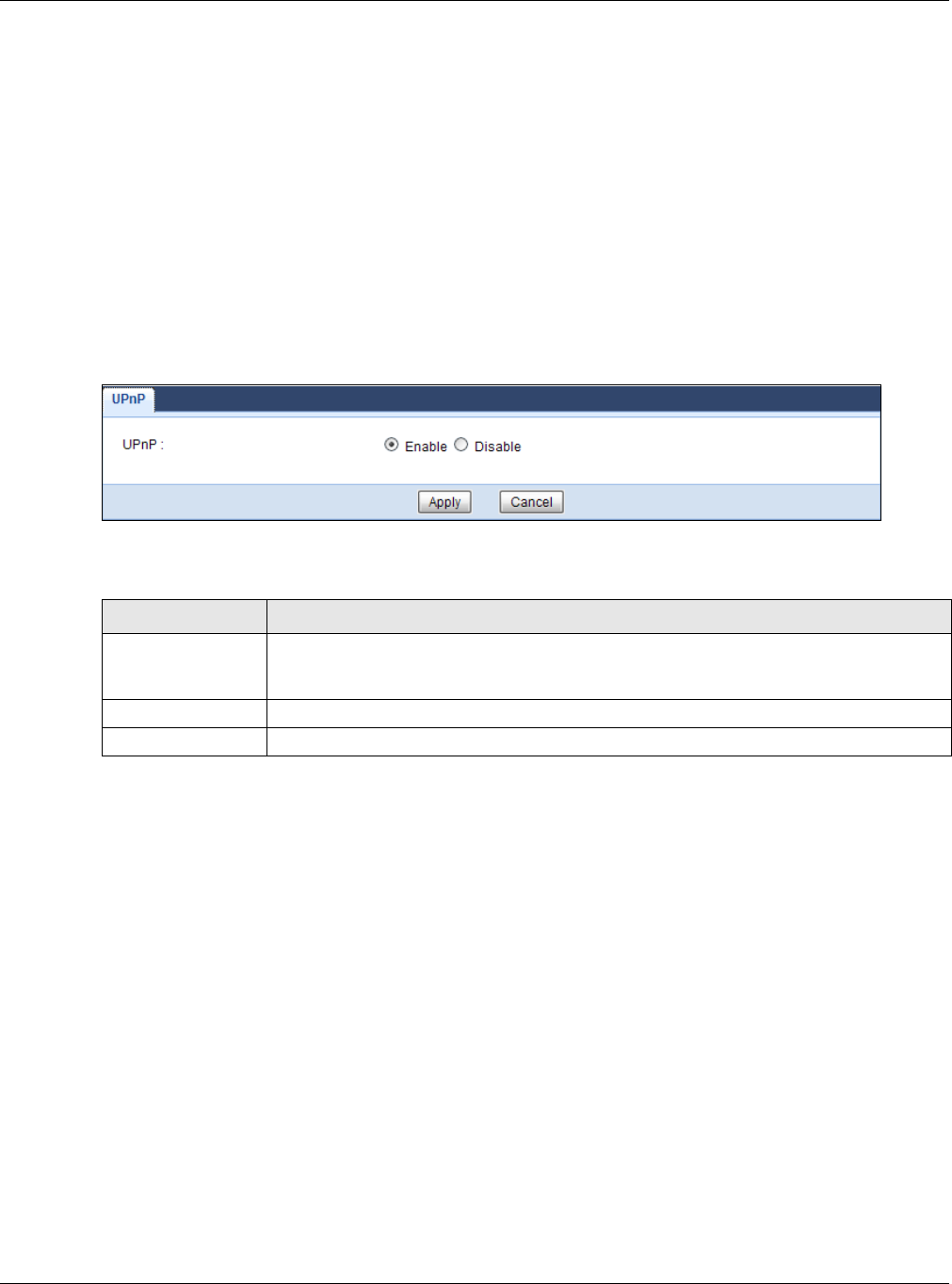
Chapter 22 Universal Plug-and-Play (UPnP)
EMG6765-Q10A User’s Guide
156
When a UPnP device joins a network, it announces its presence with a multicast message. For security
reasons, the EMG6765-Q10A allows multicast messages on the LAN only.
All UPnP-enabled devices may communicate freely with each other without additional configuration.
Disable UPnP if this is not your intention.
22.3 UPnP Screen
Use this screen to enable UPnP on your EMG6765-Q10A.
Click Management > UPnP to display the screen shown next.
Figure 86 Management > UPnP
The following table describes the fields in this screen.
22.4 Technical Reference
The sections show examples of using UPnP.
22.4.1 Using UPnP in Windows XP Example
This section shows you how to use the UPnP feature in Windows XP. You must already have UPnP installed
in Windows XP and UPnP activated on the EMG6765-Q10A.
Make sure the computer is connected to a LAN port of the EMG6765-Q10A. Turn on your computer and
the EMG6765-Q10A.
22.4.1.1 Auto-discover Your UPnP-enabled Network Device
1Click start and Control Panel. Double-click Network Connections. An icon displays under Internet
Gateway.
2Right-click the icon and select Properties.
Table 69 Management > UPnP
LABEL DESCRIPTION
UPnP Select Enable to activate UPnP. Be aware that anyone could use a UPnP application to
open the web configurator's login screen without entering the EMG6765-Q10A's IP address
(although you must still enter the password to access the web configurator).
Apply Click Apply to save the setting to the EMG6765-Q10A.
Cancel Click Cancel to return to the previously saved settings.
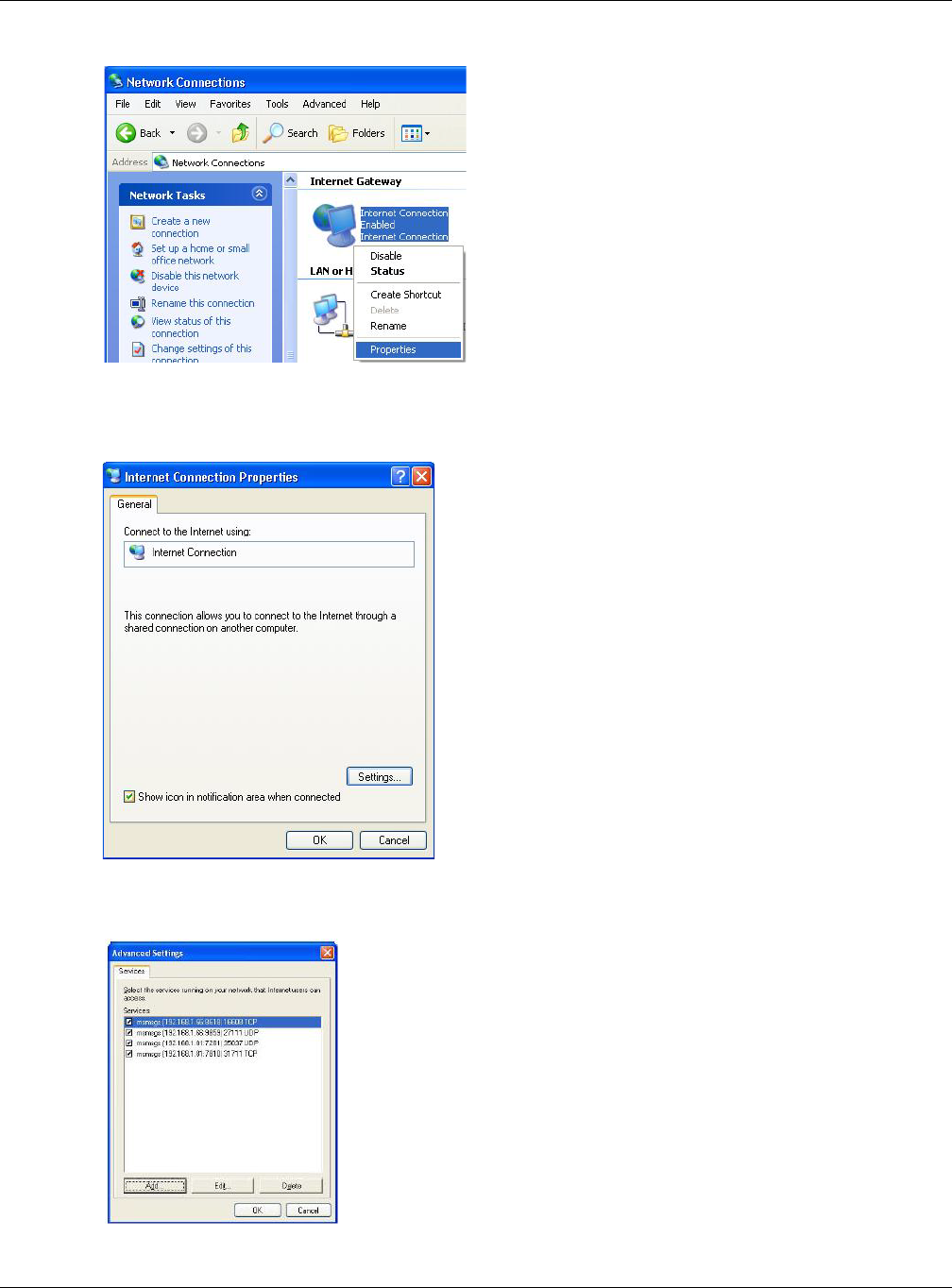
Chapter 22 Universal Plug-and-Play (UPnP)
EMG6765-Q10A User’s Guide
157
Figure 87 Network Connections
3In the Internet Connection Properties window, click Settings to see the port mappings there were
automatically created.
Figure 88 Internet Connection Properties
4You may edit or delete the port mappings or click Add to manually add port mappings.
Figure 89 Internet Connection Properties: Advanced Settings
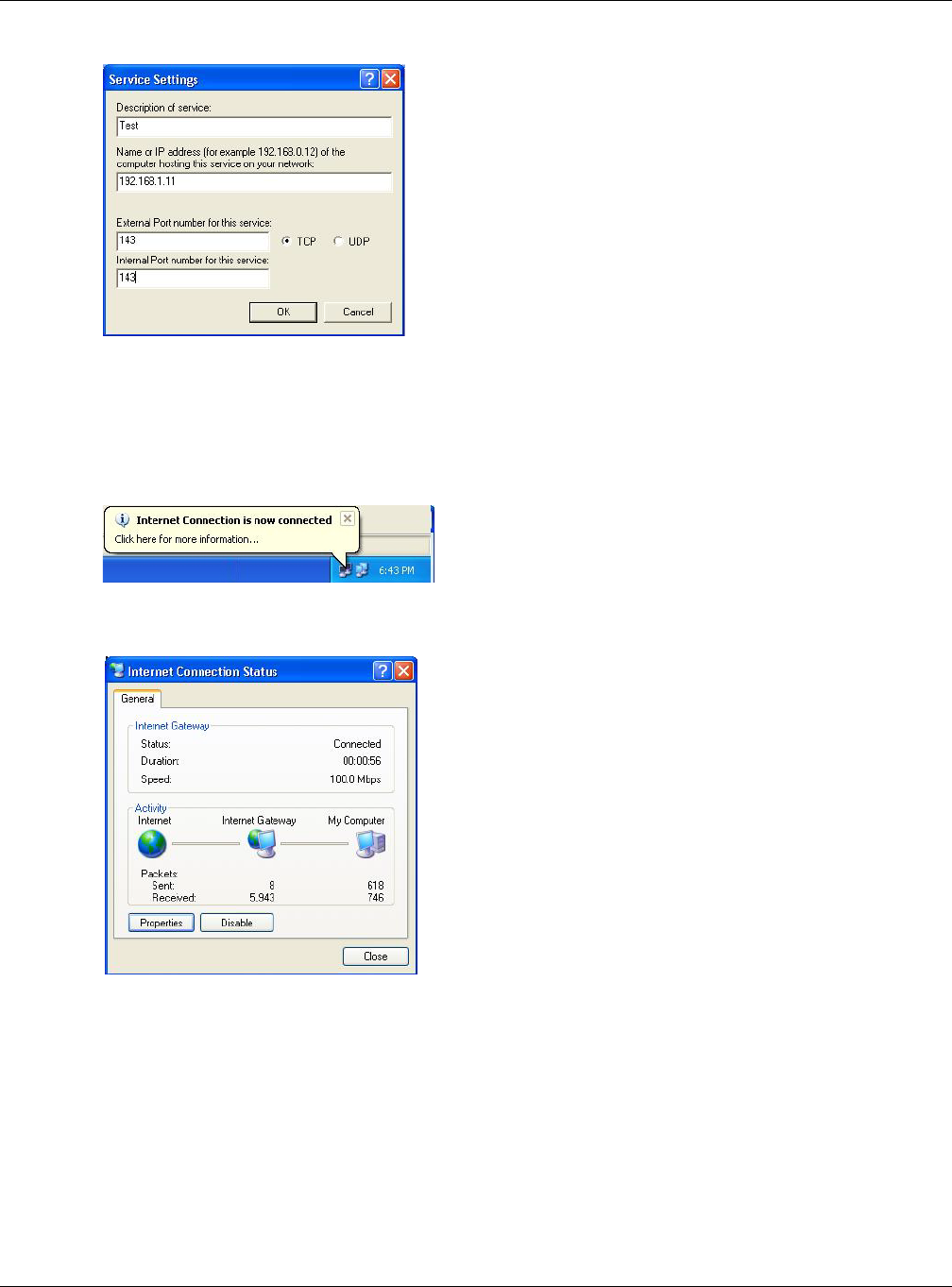
Chapter 22 Universal Plug-and-Play (UPnP)
EMG6765-Q10A User’s Guide
158
Figure 90 Internet Connection Properties: Advanced Settings: Add
Note: When the UPnP-enabled device is disconnected from your computer, all port
mappings will be deleted automatically.
5Select Show icon in notification area when connected option and click OK. An icon displays in the
system tray.
Figure 91 System Tray Icon
6Double-click on the icon to display your current Internet connection status.
Figure 92 Internet Connection Status
22.4.2 Web Configurator Easy Access
With UPnP, you can access the web-based configurator on the EMG6765-Q10A without finding out the
IP address of the EMG6765-Q10A first. This comes helpful if you do not know the IP address of the
EMG6765-Q10A.
Follow the steps below to access the web configurator.
1Click Start and then Control Panel.
2Double-click Network Connections.
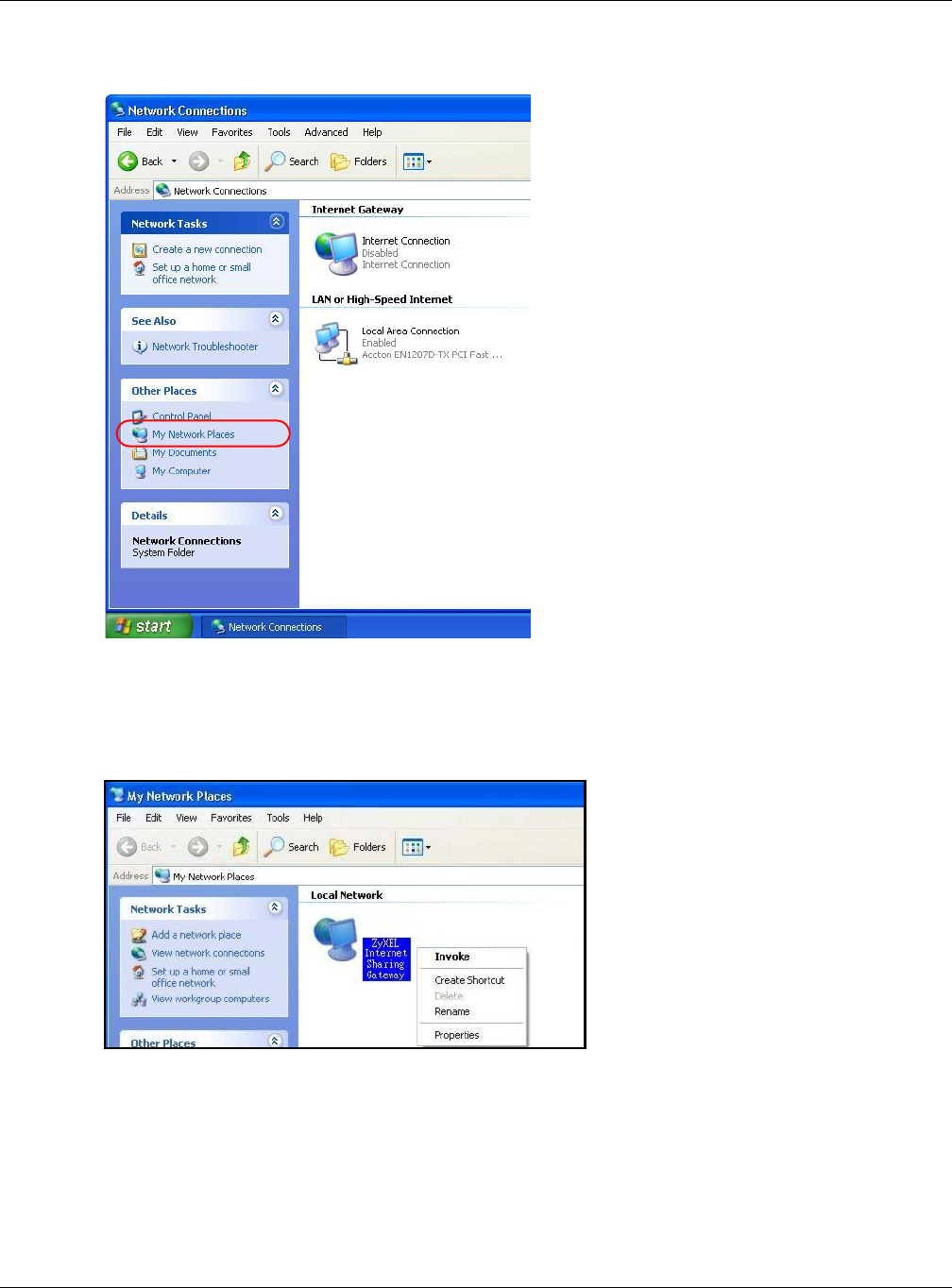
Chapter 22 Universal Plug-and-Play (UPnP)
EMG6765-Q10A User’s Guide
159
3Select My Network Places under Other Places.
Figure 93 Network Connections
4An icon with the description for each UPnP-enabled device displays under Local Network.
5Right-click on the icon for your EMG6765-Q10A and select Invoke. The web configurator login screen
displays.
Figure 94 Network Connections: My Network Places
6Right-click on the icon for your EMG6765-Q10A and select Properties. A properties window displays with
basic information about the EMG6765-Q10A.
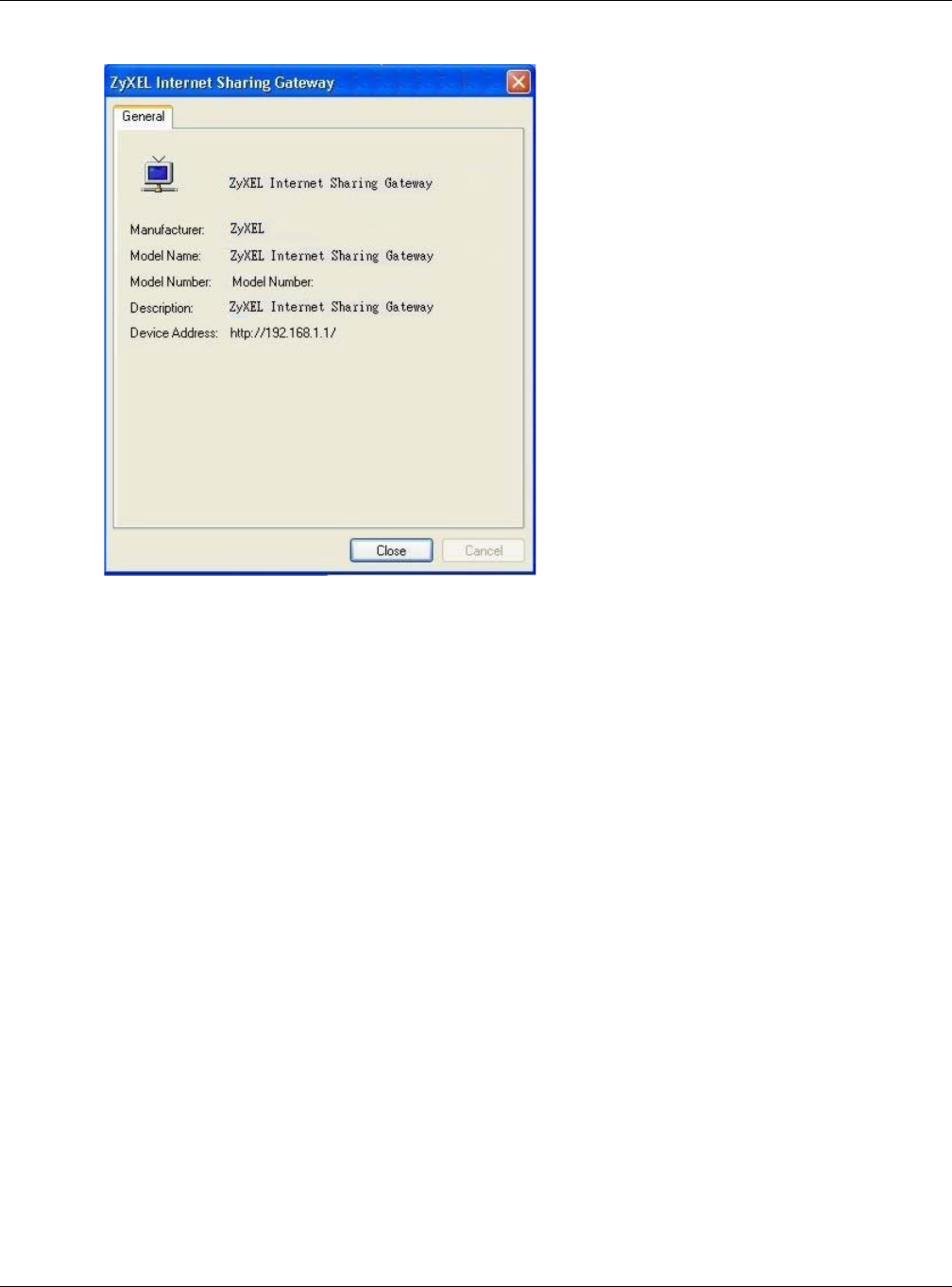
Chapter 22 Universal Plug-and-Play (UPnP)
EMG6765-Q10A User’s Guide
160
Figure 95 Network Connections: My Network Places: Properties: Example
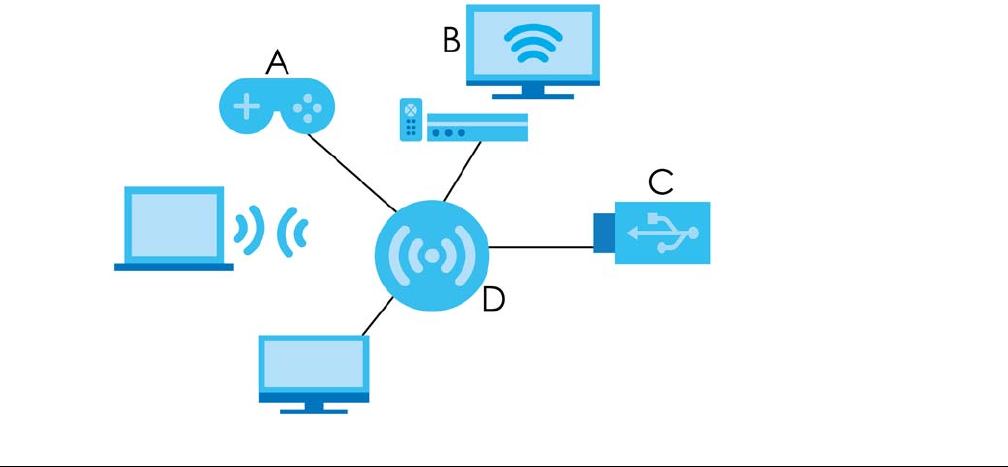
EMG6765-Q10A User’s Guide
161
CHAPTER 23
USB Media Sharing
23.1 Overview
This chapter describes how to configure the media sharing settings on the EMG6765-Q10A.
Note: The read and write performance may be affected by amount of file-sharing traffic on
your network, type of connected USB device and your USB version (1.1 or 2.0).
Media Server
You can set up your EMG6765-Q10A to act as a media server to provide media (like video) to DLNA-
compliant players, such as Windows Media Player, Zyxel DMAs (Digital Media Adapters), Xboxes or PS3s.
The media server and clients must have IP addresses in the same subnet.
The EMG6765-Q10A media server enables you to:
• Publish all folders for everyone to play media files in the USB storage device connected to the
EMG6765-Q10A.
• Use hardware-based media clients like the DMA-2500 to play the files.
Note: Anyone on your network can play the media files in the published folders. No user
name and password nor other form of security is required.
The following figure is an overview of the EMG6765-Q10A’s media server feature. DLNA devices A and B
can access and play files on a USB device (C) which is connected to the EMG6765-Q10A (D).
Figure 96 Media Server Overview
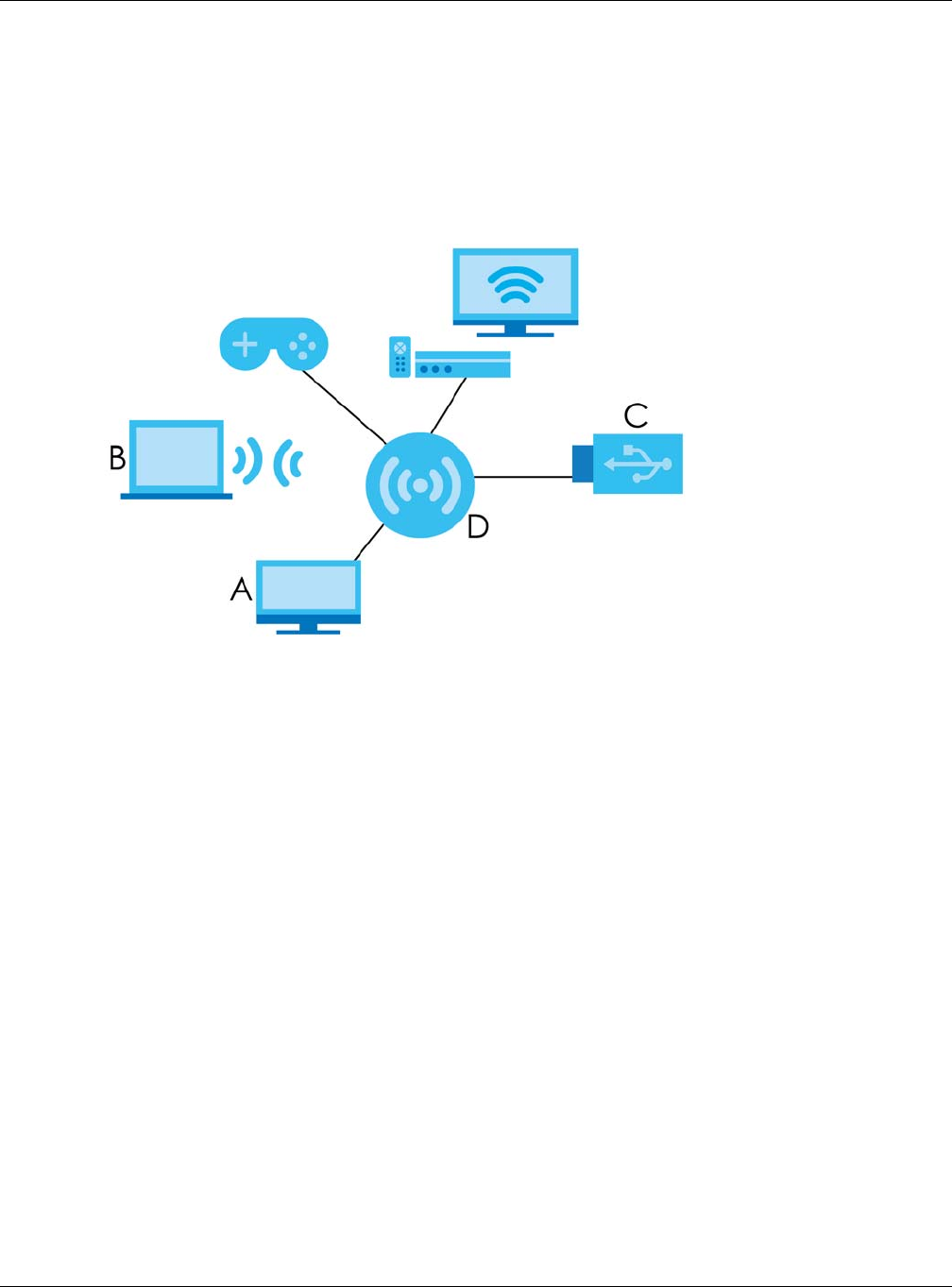
Chapter 23 USB Media Sharing
EMG6765-Q10A User’s Guide
162
File-Sharing Server
You can also share files on a USB memory stick or hard drive connected to your EMG6765-Q10A with
users on your network.
The following figure is an overview of the EMG6765-Q10A’s file-sharing server feature. Computers A and
B can access files on a USB device (C) which is connected to the EMG6765-Q10A (D).
Figure 97 File Sharing Overview
23.2 What You Can Do
• Use the DLNA screen to use the EMG6765-Q10A as a media server and allow DLNA-compliant devices
to play media files stored in the attached USB device (Section 23.5 on page 164).
• Use the SAMBA screen to enable file-sharing via the EMG6765-Q10A using Windows Explorer or the
workgroup name. This screen also allow you to configure the workgroup name and create user
accounts (Section 23.6 on page 164).
• Use the FTP screen to allow file sharing via the EMG6765-Q10A using FTP and create user accounts
(Section 23.7 on page 166).
23.3 What You Need To Know
DLNA
The Digital Living Network Alliance (DLNA) is a group of personal computer and electronics companies
that works to make products compatible in a home network. DLNA clients play files stored on DLNA
servers. The EMG6765-Q10A can function as a DLNA-compliant media server and stream files to DLNA-
compliant media clients without any configuration.

Chapter 23 USB Media Sharing
EMG6765-Q10A User’s Guide
163
Workgroup name
This is the name given to a set of computers that are connected on a network and share resources such
as a printer or files. Windows automatically assigns the workgroup name when you set up a network.
File Systems
A file system is a way of storing and organizing files on your hard drive and storage device. Often
different operating systems such as Windows or Linux have different file systems. The file-sharing feature
on your EMG6765-Q10A supports New Technology File System (NTFS), File Allocation Table (FAT) and
FAT32 file systems.
Windows/CIFS
Common Internet File System (CIFS) is a standard protocol supported by most operating systems in order
to share files across the network.
CIFS runs over TCP/IP but uses the SMB (Server Message Block) protocol found in Microsoft Windows for
file and printer access; therefore, CIFS will allow all applications, not just Web browsers, to open and
share files across the Internet.
The EMG6765-Q10A uses Common Internet File System (CIFS) protocol for its file sharing functions. CIFS
compatible computers can access the USB file storage devices connected to the EMG6765-Q10A. CIFS
protocol is supported on Microsoft Windows, Linux Samba and other operating systems (refer to your
systems specifications for CIFS compatibility).
Samba
SMB is a client-server protocol used by Microsoft Windows systems for sharing files, printers, and so on.
Samba is a free SMB server that runs on most Unix and Unix-like systems. It provides an implementation of
an SMB client and server for use with non-Microsoft operating systems.
File Transfer Protocol
This is a method of transferring data from one computer to another over a network such as the Internet.
23.4 Before You Begin
Make sure the EMG6765-Q10A is connected to your network and turned on.
1Connect the USB device to one of the EMG6765-Q10A’s USB ports.
2The EMG6765-Q10A detects the USB device and makes its contents available for browsing. If you are
connecting a USB hard drive that comes with an external power supply, make sure it is connected to an
appropriate power source that is on.
Note: If your USB device cannot be detected by the EMG6765-Q10A, see the troubleshooting
for suggestions.
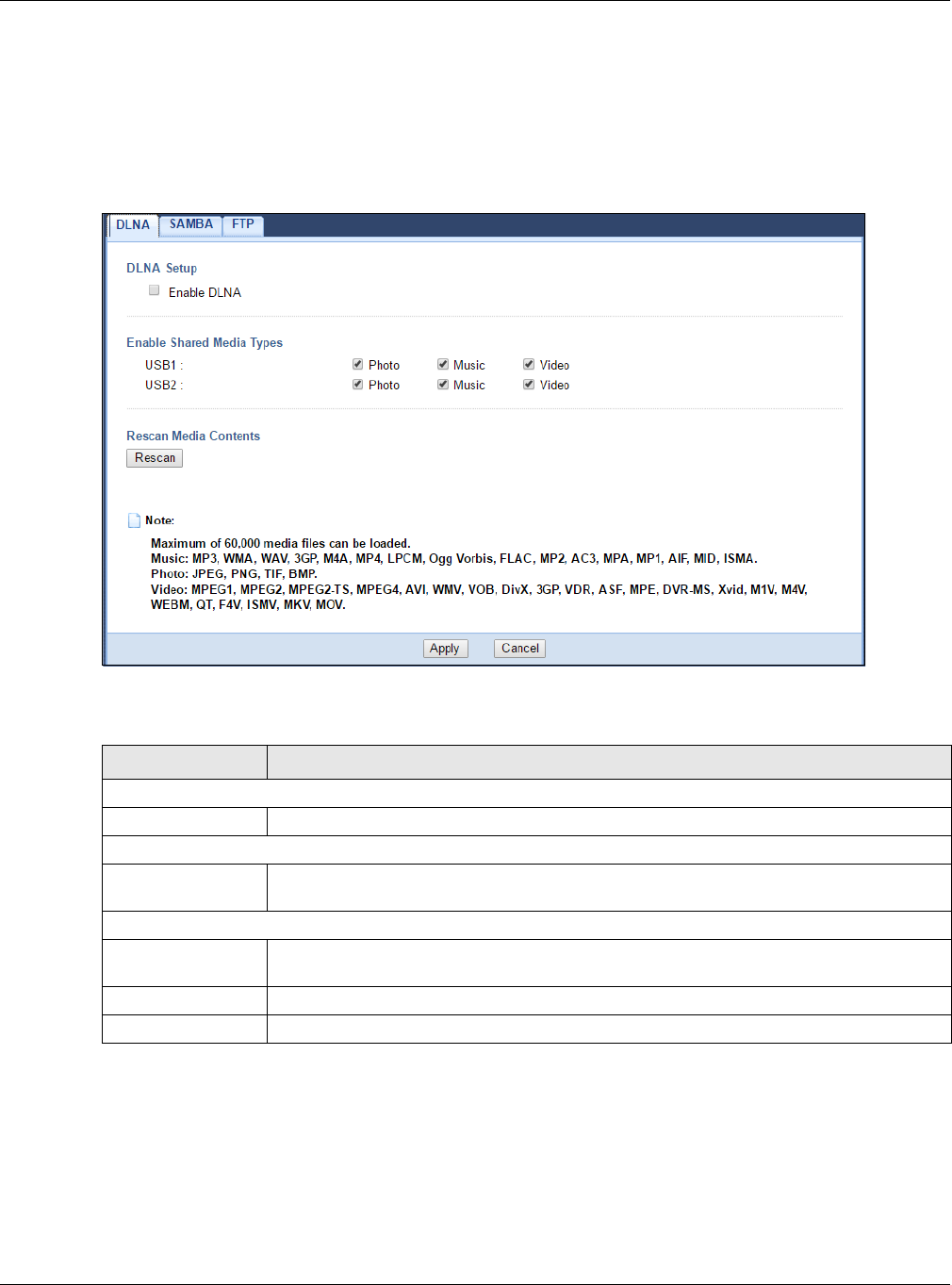
Chapter 23 USB Media Sharing
EMG6765-Q10A User’s Guide
164
23.5 DLNA Screen
Use this screen to have the EMG6765-Q10A act as a DLNA-compliant media server that lets DLNA-
compliant media clients on your network play video, music, and photos from the EMG6765-Q10A
(without having to copy them to another computer). Click Management > USB Media Sharing > DLNA.
Figure 98 Management > USB Media Sharing > DLNA
The following table describes the labels in this screen.
23.6 SAMBA Screen
Use this screen to set up file-sharing via the EMG6765-Q10A using Windows Explorer or the workgroup
name. You can also configure the work group name and create file-sharing user accounts. Click
Management > USB Media Sharing > SAMBA.
Table 70 Management > USB Media Sharing > DLNA
LABEL DESCRIPTION
DLNA Setup
Enable DLNA Select this to have the EMG6765-Q10A function as a DLNA-compliant media server.
Enable Shared Media Types
USB1/2 Select the media type that you want to share on the USB device connected to the
EMG6765-Q10A’s USB port.
Rescan Media Contents
Rescan Click this button to have the EMG6765-Q10A scan the media files on the connected USB
device and do indexing of the file list again so that DLNA clients can find the new files if any.
Apply Click Apply to save your changes back to the EMG6765-Q10A.
Cancel Click Cancel to begin configuring this screen afresh.
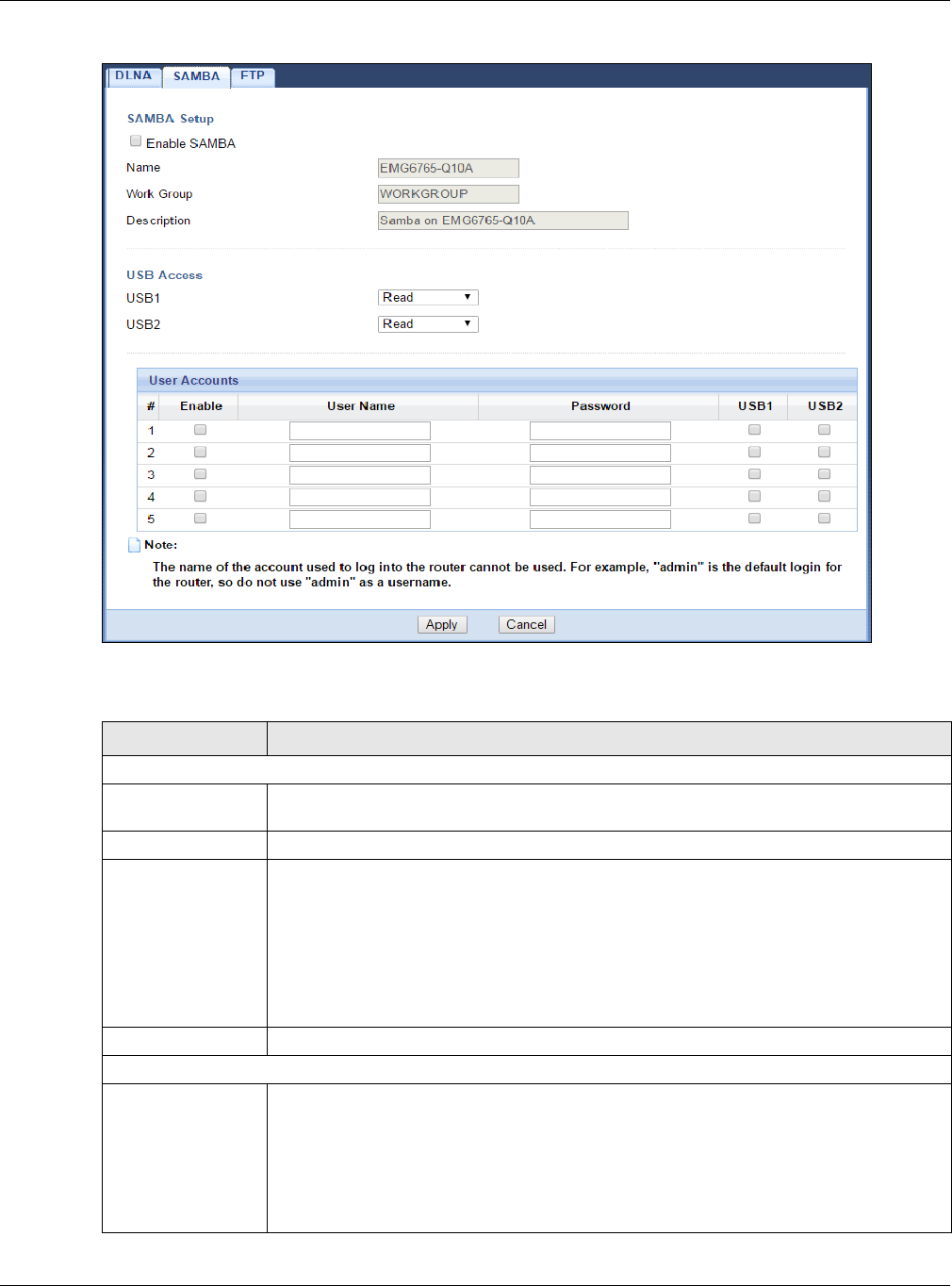
Chapter 23 USB Media Sharing
EMG6765-Q10A User’s Guide
165
Figure 99 Management > USB Media Sharing > SAMBA
The following table describes the labels in this screen.
Table 71 Management > USB Media Sharing > SAMBA
LABEL DESCRIPTION
Samba Setup
Enable SAMBA Select this to enable file sharing through the EMG6765-Q10A using Windows Explorer or by
browsing to your work group.
Name Specify the name to identify the EMG6765-Q10A in a work group.
Work Group You can add the EMG6765-Q10A to an existing or a new workgroup on your network. Enter
the name of the workgroup which your EMG6765-Q10A automatically joins. You can set the
EMG6765-Q10A’s workgroup name to be exactly the same as the workgroup name to
which your computer belongs to.
Note: The EMG6765-Q10A will not be able to join the workgroup if your local area
network has restrictions set up that do not allow devices to join a
workgroup. In this case, contact your network administrator.
Description Enter the description of the EMG6765-Q10A in a work group.
USB Access
USB1/2 Specify the user’s access rights to the USB storage device which is connected to the
EMG6765-Q10A’s USB port.
Read & Write - The user has read and write rights, meaning that the user can create and edit
the files on the connected USB device.
Read - The user has read rights only and can not create or edit the files on the connected
USB device.
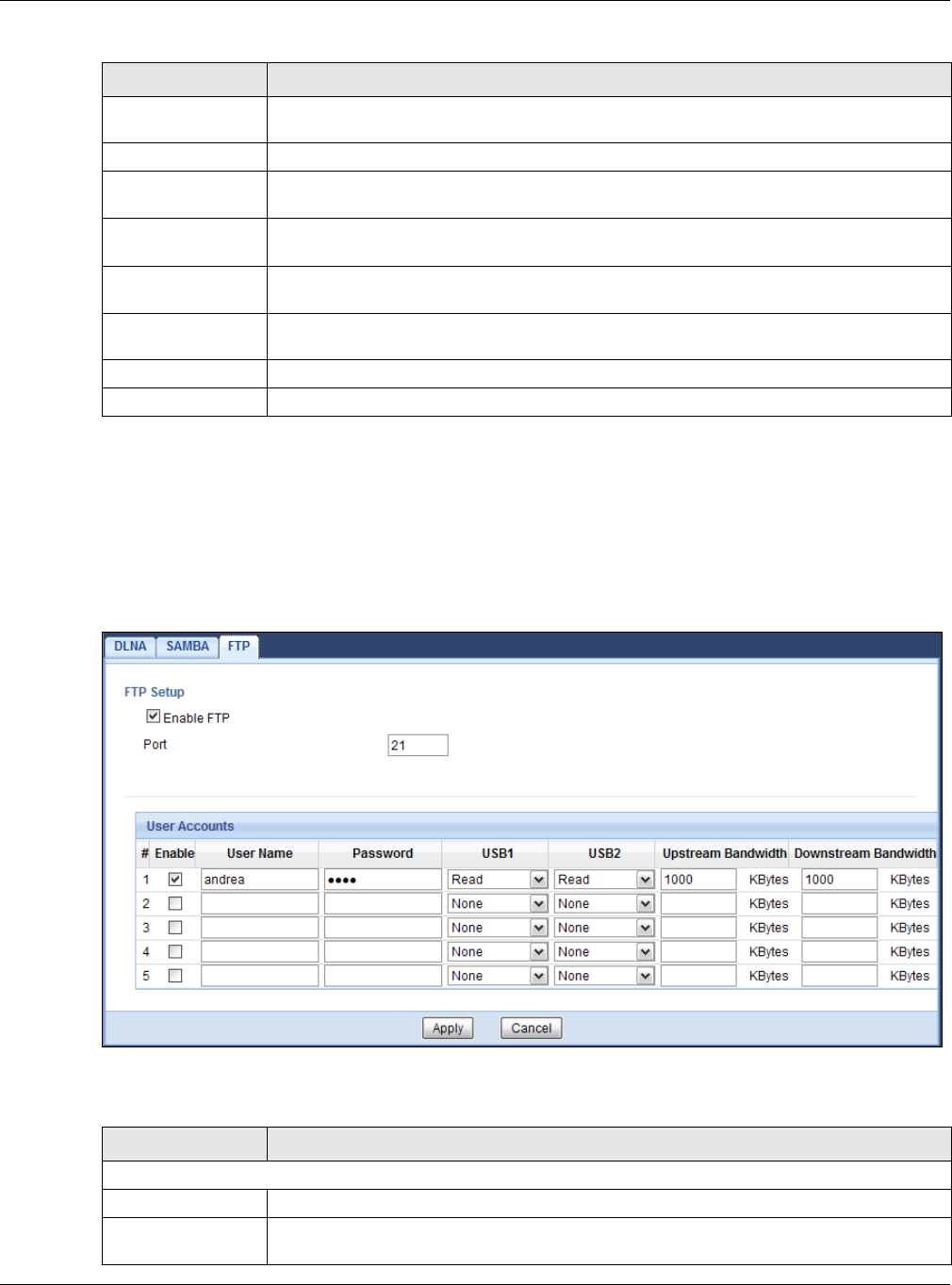
Chapter 23 USB Media Sharing
EMG6765-Q10A User’s Guide
166
23.7 FTP Screen
Use this screen to set up file sharing via the EMG6765-Q10A using FTP and create user accounts. Click
Management > USB Media Sharing > FTP.
Figure 100 Management > USB Media Sharing > FTP
The following table describes the labels in this screen.
User Accounts Before you can share files you need a user account. Configure the following fields to set up
a file-sharing account.
#This is the index number of the user account.
Enable This field displays whether a user account is activated or not. Select the check box to
enable the account. Clear the check box to disable the account.
User Name Enter a user name that will be allowed to access the shared files. You can enter up to 20
characters. Only letters and numbers allowed.
Password Enter the password used to access the shared files. You can enter up to 20 characters. Only
letters and numbers are allowed. The password is case sensitive.
USB1/2 Select the USB port(s) of the EMG6765-Q10A. The configured user can access the files on the
USB device(s) connected to the selected USB port(s) only.
Apply Click Apply to save your changes back to the EMG6765-Q10A.
Cancel Click Cancel to begin configuring this screen afresh.
Table 71 Management > USB Media Sharing > SAMBA (continued)
LABEL DESCRIPTION
Table 72 Management > USB Media Sharing > FTP
LABEL DESCRIPTION
FTP Setup
Enable FTP Select this to enable the FTP server on the EMG6765-Q10A for file sharing using FTP.
Port You may change the server port number for FTP if needed, however you must use the same
port number in order to use that service for file sharing.

Chapter 23 USB Media Sharing
EMG6765-Q10A User’s Guide
167
23.8 Example of Accessing Your Shared Files From a
Computer
You can use Windows Explorer or FTP to access the USB storage devices connected to the EMG6765-
Q10A.
This example shows you how to use Microsoft’s Windows XP to browse your shared files. Refer to your
operating system’s documentation for how to browse your file structure.
23.8.1 Use Windows Explorer to Share Files
You should have enabled file sharing and create a user account (Bob/1234 for example) with read and
write access to USB 1 in the USB Media Sharing > SAMBA screen.
Open Windows Explorer to access the connected USB device using either Windows Explorer browser or
by browsing to your workgroup.
User Accounts Before you can share files you need a user account. Configure the following fields to set up
a file-sharing account.
#This is the index number of the user account.
Enable This field displays whether a user account is activated or not. Select the check box to
enable the account. Clear the check box to disable the account.
User Name Enter a user name that will be allowed to access the shared files. You can enter up to 20
characters. Only letters and numbers allowed.
Password Enter the password used to access the shared files. You can enter up to 20 characters. Only
letters and numbers are allowed. The password is case sensitive.
USB1/2 Specify the user’s access rights to the USB storage device which is connected to the
EMG6765-Q10A’s USB port.
Read & Write - The user has read and write rights, meaning that the user can create and edit
the files on the connected USB device.
Read - The user has read rights only and can not create or edit the files on the connected
USB device.
None - The user cannot access the files on the USB device(s) connected to the USB port.
Upstream
Bandwidth
Enter the maximum bandwidth (in Kbps) allowed for incoming FTP traffic.
Downstream
Bandwidth
Enter the maximum bandwidth (in Kbps) allowed for outgoing FTP traffic.
Apply Click Apply to save your changes back to the EMG6765-Q10A.
Cancel Click Cancel to begin configuring this screen afresh.
Table 72 Management > USB Media Sharing > FTP (continued)
LABEL DESCRIPTION
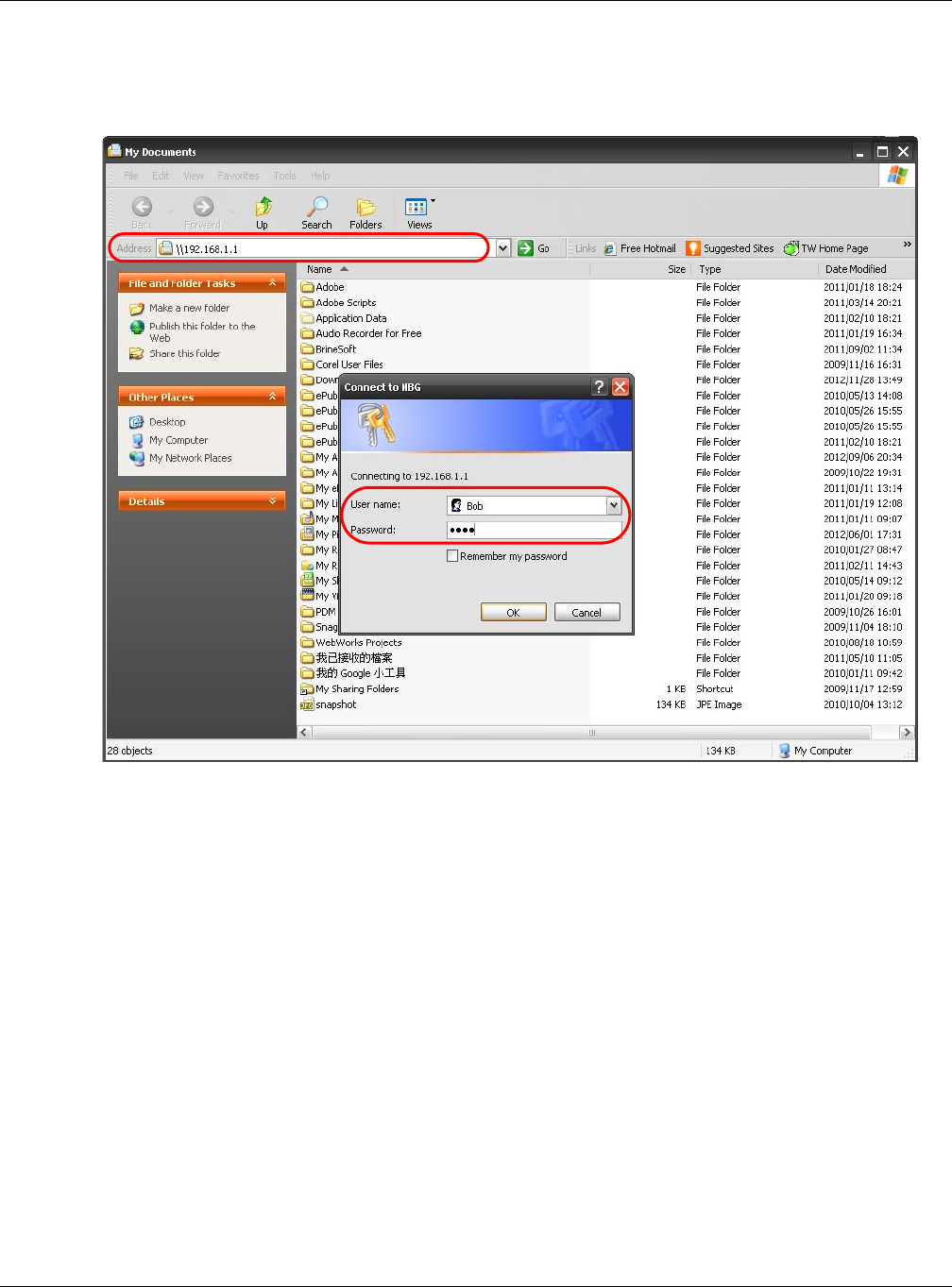
Chapter 23 USB Media Sharing
EMG6765-Q10A User’s Guide
168
1In Windows Explorer’s Address bar type a double backslash “\\” followed by the IP address of the
EMG6765-Q10A (the default IP address of the EMG6765-Q10A in router mode is 192.168.1.1) and press
[ENTER]. A screen asking for password authentication appears. Type the user name and password (Bob
and 1234 in this example) and click OK.
Note: Once you log into the shared folder via your EMG6765-Q10A, you do not have to
relogin unless you restart your computer.
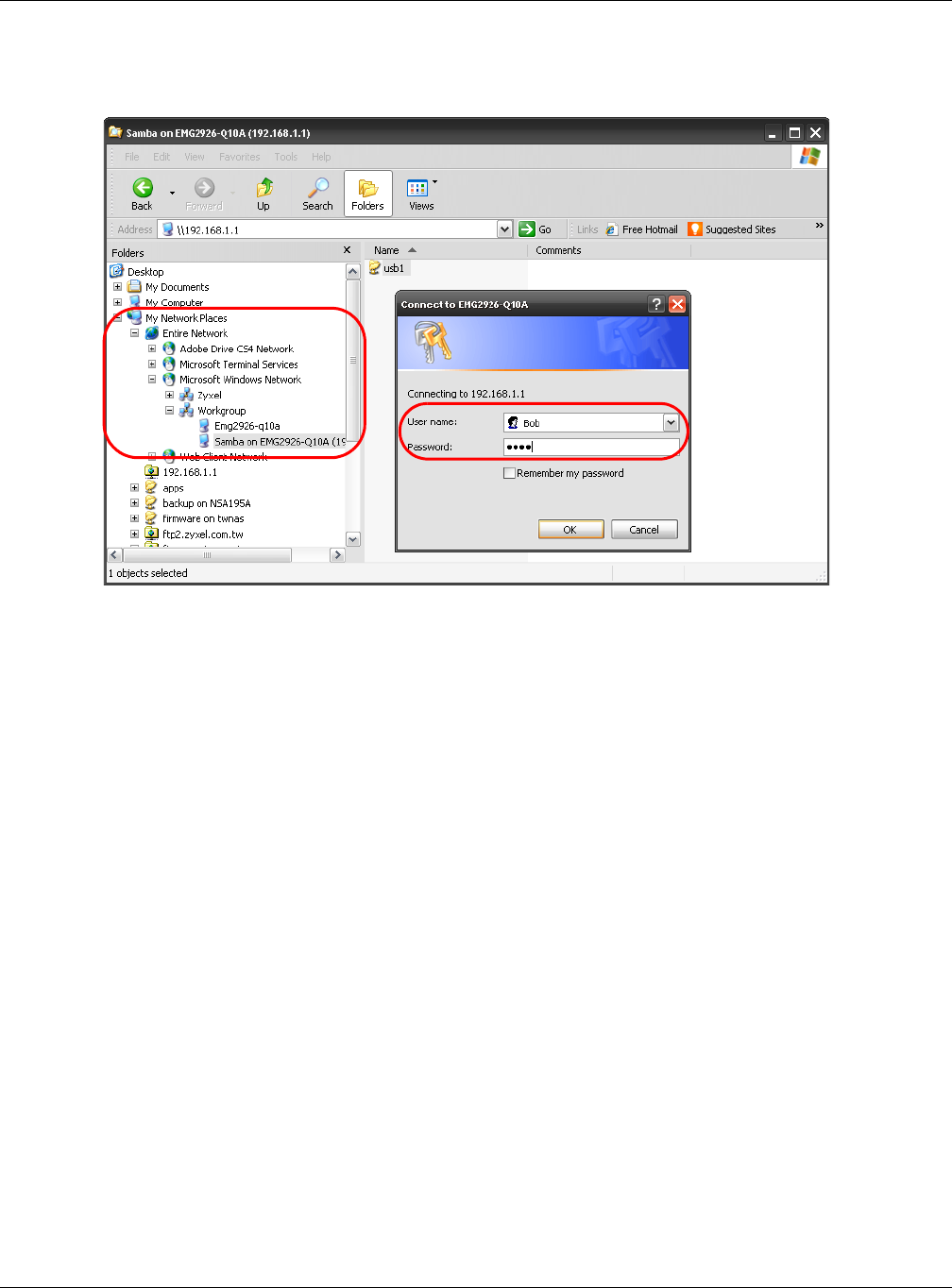
Chapter 23 USB Media Sharing
EMG6765-Q10A User’s Guide
169
2You can also use the workgroup name to access files by browsing to the workgroup folder using the
folder tree on the left side of the screen. It is located under My Network Places. In this example the
workgroup name is the default “Workgroup”.
23.8.2 Use FTP to Share Files
You can use FTP to access the USB storage devices connected to the EMG6765-Q10A. In this example,
we use the web browser to share files via FTP from the LAN. The way or screen you log into the FTP server
(on the EMG6765-Q10A) varies depending on your FTP client. See your FTP client documentation for
more information.
You should have enabled file sharing and create a user account (Bob/1234 for example) with read and
write access to USB 1 in the USB Media Sharing > FTP screen.
1In your web browser’s address or URL bar type “ftp://” followed by the IP address of the EMG6765-Q10A
(the default LAN IP address of the EMG6765-Q10A in router mode is 192.168.1.1) and click Go or press
[ENTER].
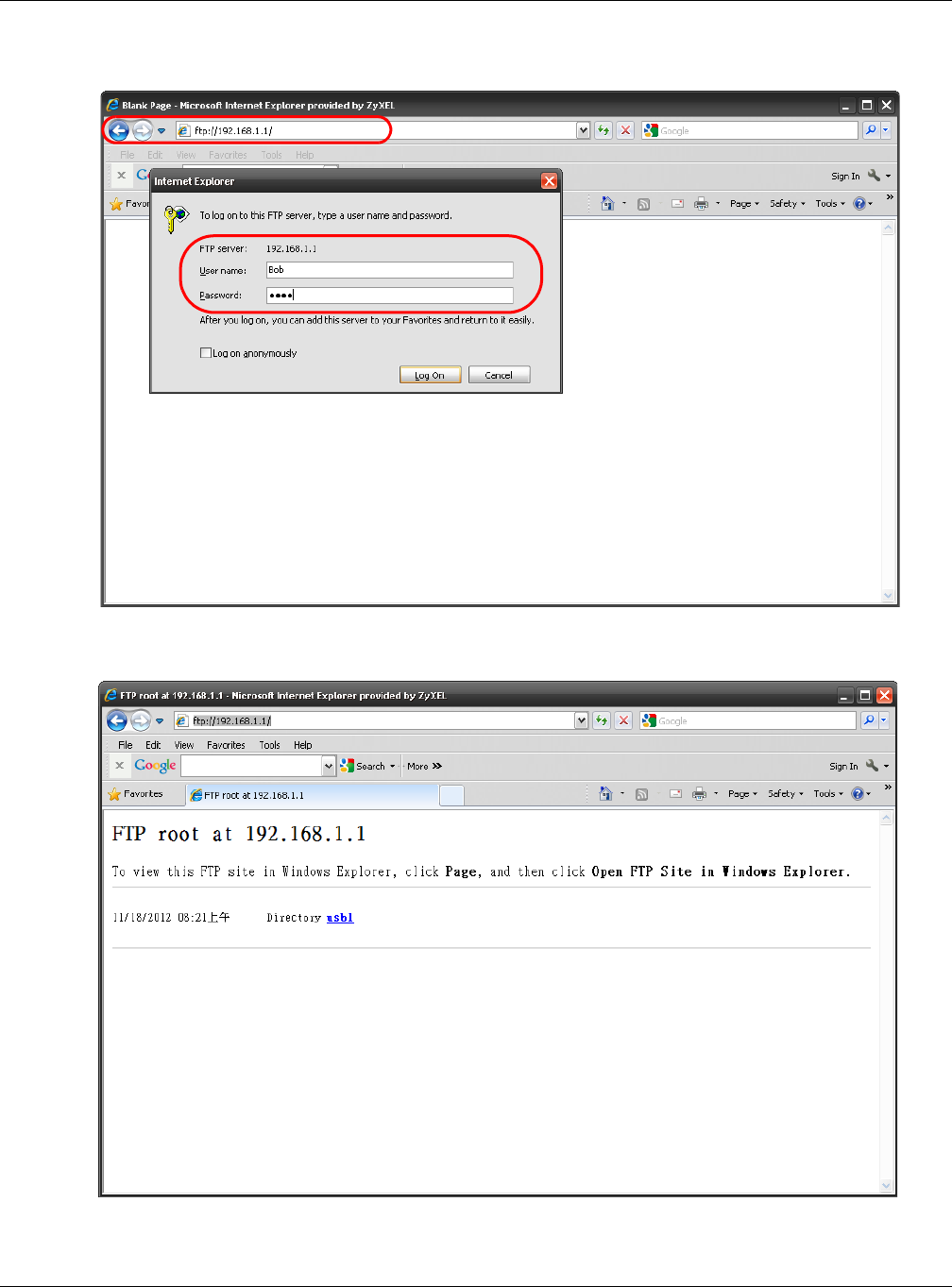
Chapter 23 USB Media Sharing
EMG6765-Q10A User’s Guide
170
2A screen asking for password authentication appears. Enter the user name and password (you
configured in the USB Media Sharing > FTP screen) and click Log On.
3The screen changes and shows you the folder for the USB storage device connected to your EMG6765-
Q10A. Double-click the folder to display the contents in it.
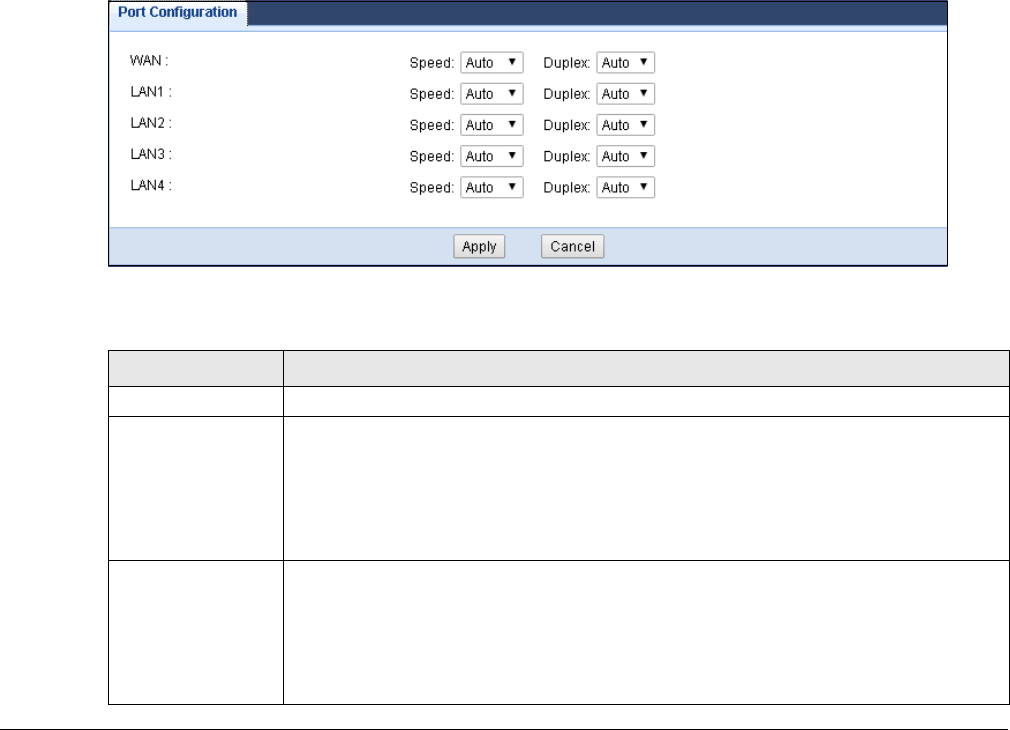
EMG6765-Q10A User’s Guide
171
CHAPTER 24
Port Configuration
24.1 Overview
The EMG6765-Q10A has 1000Base-T auto-negotiating Ethernet ports. In 10/100/1000 Mbps Gigabit
Ethernet, the speed can be 10 Mbps, 100 Mbps or 1000 Mbps. The duplex mode can be both half or full
duplex. An auto-negotiating port can detect and adjust to the optimum Ethernet speed (10/100/1000
Mbps) and duplex mode (full duplex or half duplex) of the connected device.
24.2 Port Configuration Screen
Use this screen to configure the EMG6765-Q10A port speed and duplex settings. Click Configuration >
Management > Port Configuration.
Figure 101 Management > Port Configuration
The following table describes the labels on this screen.
Table 73 Management > Port Configuration
LABEL DESCRIPTION
WAN/LAN1~4 This field displays the Ethernet port of the EMG6765-Q10A.
Speed Select the speed of the Ethernet connection on this port. The choices are Auto, 1000, 100
and 10.
Selecting Auto (auto-negotiation) allows one port to negotiate with a peer port
automatically to obtain the connection speed that both ends support. If the peer port does
not support auto-negotiation or turns off this feature, the EMG6765-Q10A determines the
connection speed by detecting the signal on the cable and using half duplex mode.
Duplex Select the duplex mode of the Ethernet connection on this port. The choices are Auto, Full
and Half.
Selecting Auto (auto-negotiation) allows one port to negotiate with a peer port
automatically to obtain the duplex mode that both ends support. If the peer port does not
support auto-negotiation or turns off this feature, the EMG6765-Q10A determines the
connection speed by detecting the signal on the cable and using half duplex mode.

Chapter 24 Port Configuration
EMG6765-Q10A User’s Guide
172
Apply Click Apply to save your changes with the EMG6765-Q10A.
Cancel Click Cancel to begin configuring this screen afresh.
Table 73 Management > Port Configuration (continued)
LABEL DESCRIPTION

EMG6765-Q10A User’s Guide
173
CHAPTER 25
Maintenance
25.1 Overview
This chapter provides information on the Maintenance screens.
25.2 What You Can Do
• Use the General screen to set the system name, the domain name and the timeout period of the
management session (Section 25.3 on page 173).
• Use the Account screen to change your EMG6765-Q10A’s system password (Section 25.4 on page
174).
• Use the Time screen to change your EMG6765-Q10A’s time and date (Section 25.5 on page 175).
• Use the Firmware Upgrade screen to upload firmware to your EMG6765-Q10A (Section 25.6 on page
177).
• Use the Backup/Restore screen to view information related to factory defaults, backup configuration,
and restoring configuration (Section 25.8 on page 180).
• Use the Restart screen to reboot the EMG6765-Q10A without turning the power off (Section 25.8 on
page 180).
• Use the Language screen to change the language for the Web Configurator (Section 25.9 on page
180).
• Use the Diagnostic screens to identify problems with the EMG6765-Q10A (Section 25.10 on page 180).
25.3 General Screen
Use this screen to set the system and domain names and the timeout period of the management
session. Click Maintenance > General. The following screen displays.
Figure 102 Maintenance > General
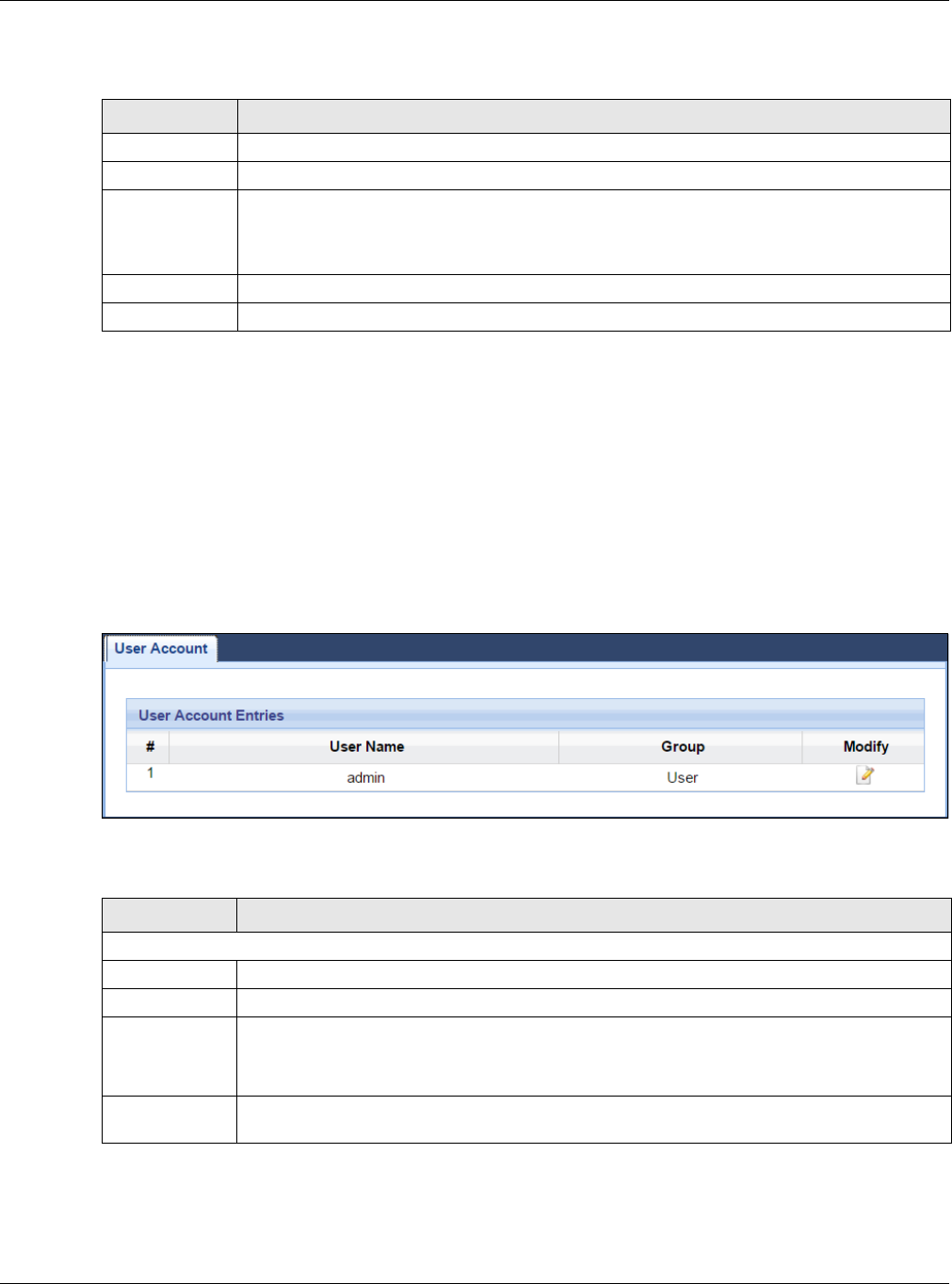
Chapter 25 Maintenance
EMG6765-Q10A User’s Guide
174
The following table describes the labels in this screen.
25.4 Account Screen
It is strongly recommended that you change the password of the user account.
If you forget your login account password (or IP address), you will need to reset the device. See Section
1.5 on page 14 and Section 25.8 on page 180 for details.
Click Maintenance > Account. The screen appears as shown.
Figure 103 Maintenance > Account
The following table describes the labels in this screen.
25.4.1 Account Setup Screen
This screen allows you to change a user account password.
Table 74 Maintenance > General
LABEL DESCRIPTION
System Name System Name is a unique name to identify the EMG6765-Q10A in an Ethernet network.
Domain Name Enter the domain name you want to give to the EMG6765-Q10A.
Administrator
Inactivity Timer
Type how many minutes a management session can be left idle before the session times out. The
default is 5 minutes. After it times out you have to log in with your password again. Very long idle
timeouts may have security risks. A value of "0" means a management session never times out,
no matter how long it has been left idle (not recommended).
Apply Click Apply to save your changes back to the EMG6765-Q10A.
Cancel Click Cancel to exit this screen without saving.
Table 75 Maintenance > Account
LABEL DESCRIPTION
User Account Entries
#This is the index number of a user account.
User Name The EMG6765-Q10A’s user account name.
Group The belonging of the user account.
Different login account types have different privilege levels. The web configurator screens and
privileges will vary depending on which account type you use to log in.
Modify Click the Edit icon to open the Account Setup screen. Account Setup screen allows to change
the user account password.
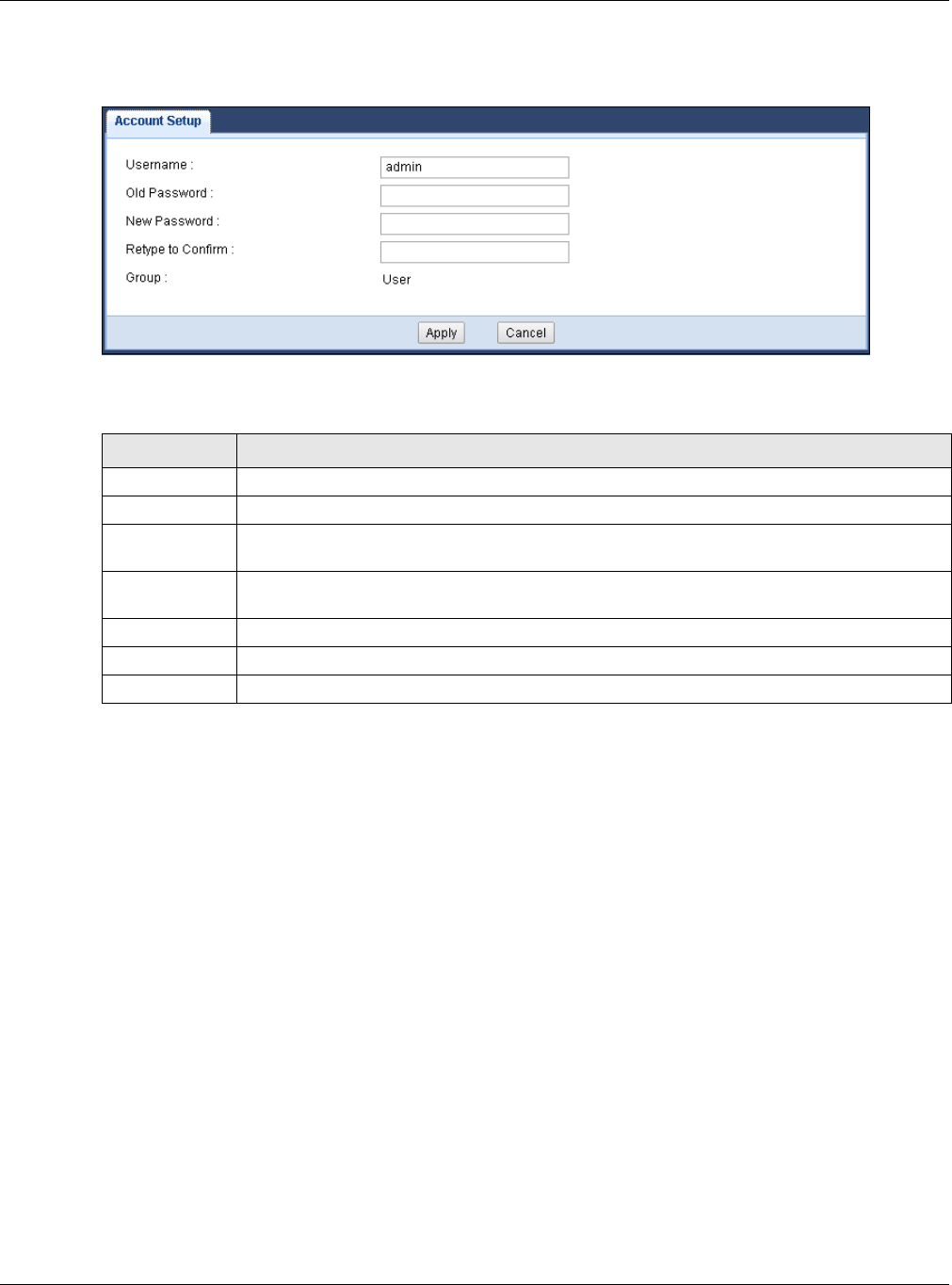
Chapter 25 Maintenance
EMG6765-Q10A User’s Guide
175
In the Maintenance > Account screen, click an Edit icon under Modify. The screen appears as shown.
Figure 104 Maintenance > Account: Edit
The following table describes the labels in this screen.
25.5 Time Setting Screen
Use this screen to configure the EMG6765-Q10A’s time based on your local time zone. To change your
EMG6765-Q10A’s time and date, click Maintenance > Time. The screen appears as shown.
Table 76 Maintenance >
LABEL DESCRIPTION
Username The user account name.
Old Password Type the default password or the existing password you use to access the system in this field.
New Password Type your new system password (up to 30 characters). Note that as you type a password, the
screen displays as asterisk (*) for each character you type.
Retype to
Confirm
Type the new password again in this field.
Group This shows the group belonging of the user account (read-only).
Apply Click Apply to save your changes back to the EMG6765-Q10A.
Cancel Click Cancel to exit this screen without saving.
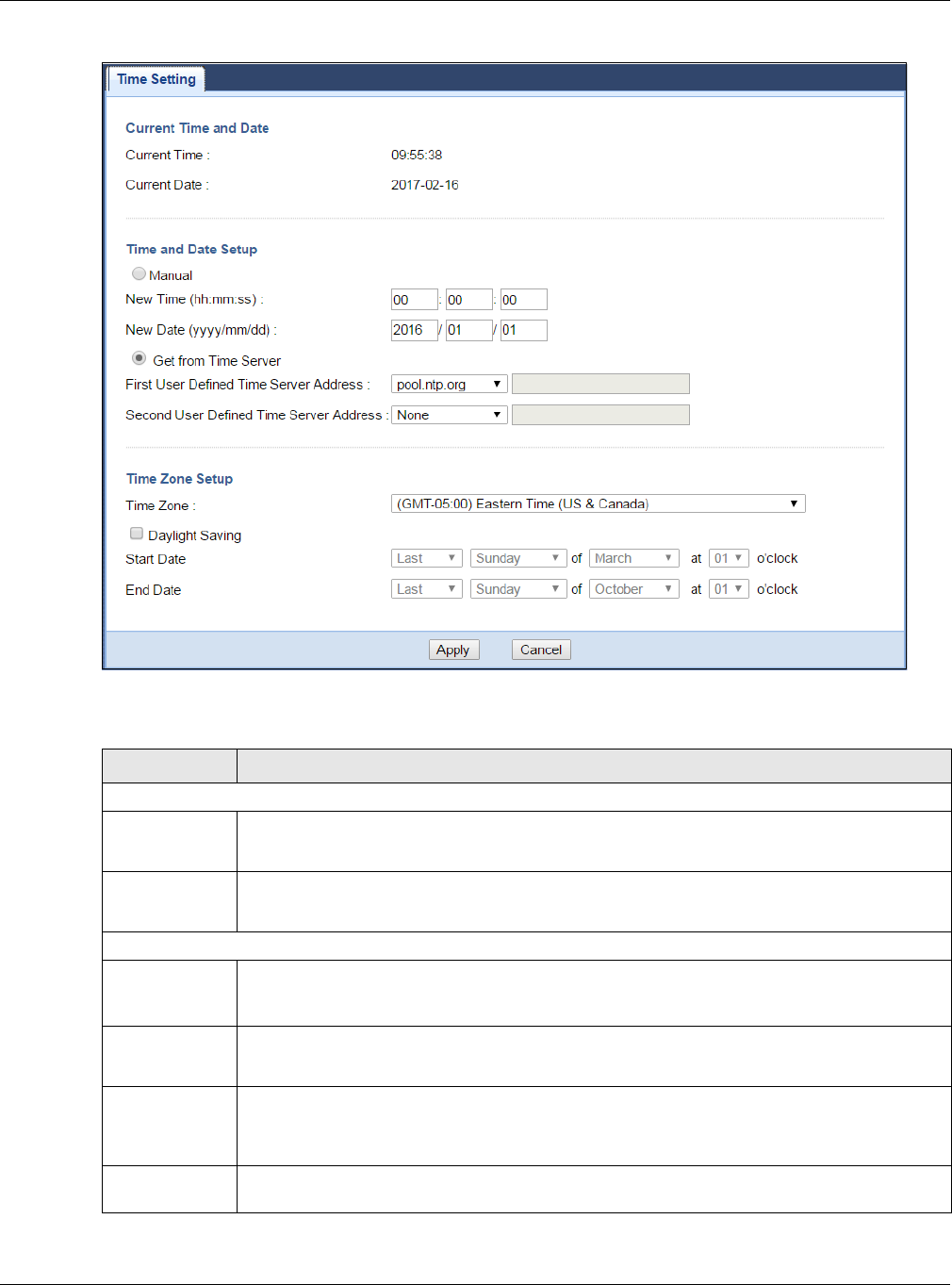
Chapter 25 Maintenance
EMG6765-Q10A User’s Guide
176
Figure 105 Maintenance > Time
The following table describes the labels in this screen.
Table 77 Maintenance > Time
LABEL DESCRIPTION
Current Time and Date
Current Time This field displays the time of your EMG6765-Q10A.
Each time you reload this page, the EMG6765-Q10A synchronizes the time with the time server.
Current Date This field displays the date of your EMG6765-Q10A.
Each time you reload this page, the EMG6765-Q10A synchronizes the date with the time server.
Time and Date Setup
Manual Select this radio button to enter the time and date manually. If you configure a new time and
date, Time Zone and Daylight Saving at the same time, the new time and date you entered has
priority and the Time Zone and Daylight Saving settings do not affect it.
New Time
(hh:mm:ss)
This field displays the last updated time from the time server or the last time configured manually.
When you select Manual, enter the new time in this field and then click Apply.
New Date
(yyyy/mm/dd)
This field displays the last updated date from the time server or the last date configured
manually.
When you select Manual, enter the new date in this field and then click Apply.
Get from Time
Server
Select this radio button to have the EMG6765-Q10A get the time and date from the time server
you specified below.

Chapter 25 Maintenance
EMG6765-Q10A User’s Guide
177
25.6 Firmware Upgrade Screen
Find firmware at www.zyxel.com in a file that (usually) uses the system model name with a “*.bin”
extension, e.g., “EMG6765-Q10A.bin”. The upload process uses HTTP (Hypertext Transfer Protocol) and
may take up to two minutes. After a successful upload, the system will reboot.
Click Maintenance > Firmware Upgrade. Follow the instructions in this screen to upload firmware to your
EMG6765-Q10A.
First / Second
User Defined
Time Server
Address
Enter the IP address or URL (up to 20 extended ASCII characters in length) of your time server.
Check with your ISP/network administrator if you are unsure of this information.
Time Zone Setup
Time Zone Choose the time zone of your location. This will set the time difference between your time zone
and Greenwich Mean Time (GMT).
Daylight Saving Daylight saving is a period from late spring to early fall when many countries set their clocks
ahead of normal local time by one hour to give more daytime light in the evening.
Select this option if you use Daylight Saving Time.
Start Date Configure the day and time when Daylight Saving Time starts if you selected Daylight Savings.
The o’clock field uses the 24 hour format. Here are a couple of examples.
Daylight Saving Time starts in most parts of the United States on the first Sunday of April. Each
time zone in the United States starts using Daylight Saving Time at 2 A.M local time. So in the
United States you would select First, Sunday, April and type 2 in the o’clock field.
Daylight Saving Time starts in the European Union on the last Sunday of March. All of the time
zones in the European Union start using Daylight Saving Time at the same moment (1 A.m. GMT
or UTC). So in the European Union you would select Last, Sunday, March. The time you type in the
o’clock field depends on your time zone. In Germany for instance, you would type 2 because
Germany’s time zone is one hour ahead of GMT or UTC (GMT+1).
End Date Configure the day and time when Daylight Saving Time ends if you selected Daylight Savings.
The o’clock field uses the 24 hour format. Here are a couple of examples.
Daylight Saving Time ends in the United States on the last Sunday of October. Each time zone in
the United States stops using Daylight Saving Time at 2 A.M. local time. So in the United States
you would select Last, Sunday, October and type 2 in the o’clock field.
Daylight Saving Time ends in the European Union on the last Sunday of October. All of the time
zones in the European Union stop using Daylight Saving Time at the same moment (1 A.M. GMT
or UTC). So in the European Union you would select Last, Sunday, October. The time you type in
the o’clock field depends on your time zone. In Germany for instance, you would type 2
because Germany’s time zone is one hour ahead of GMT or UTC (GMT + 1).
Apply Click Apply to save your changes back to the EMG6765-Q10A.
Cancel Click Cancel to exit this screen without saving.
Table 77 Maintenance > Time (continued)
LABEL DESCRIPTION
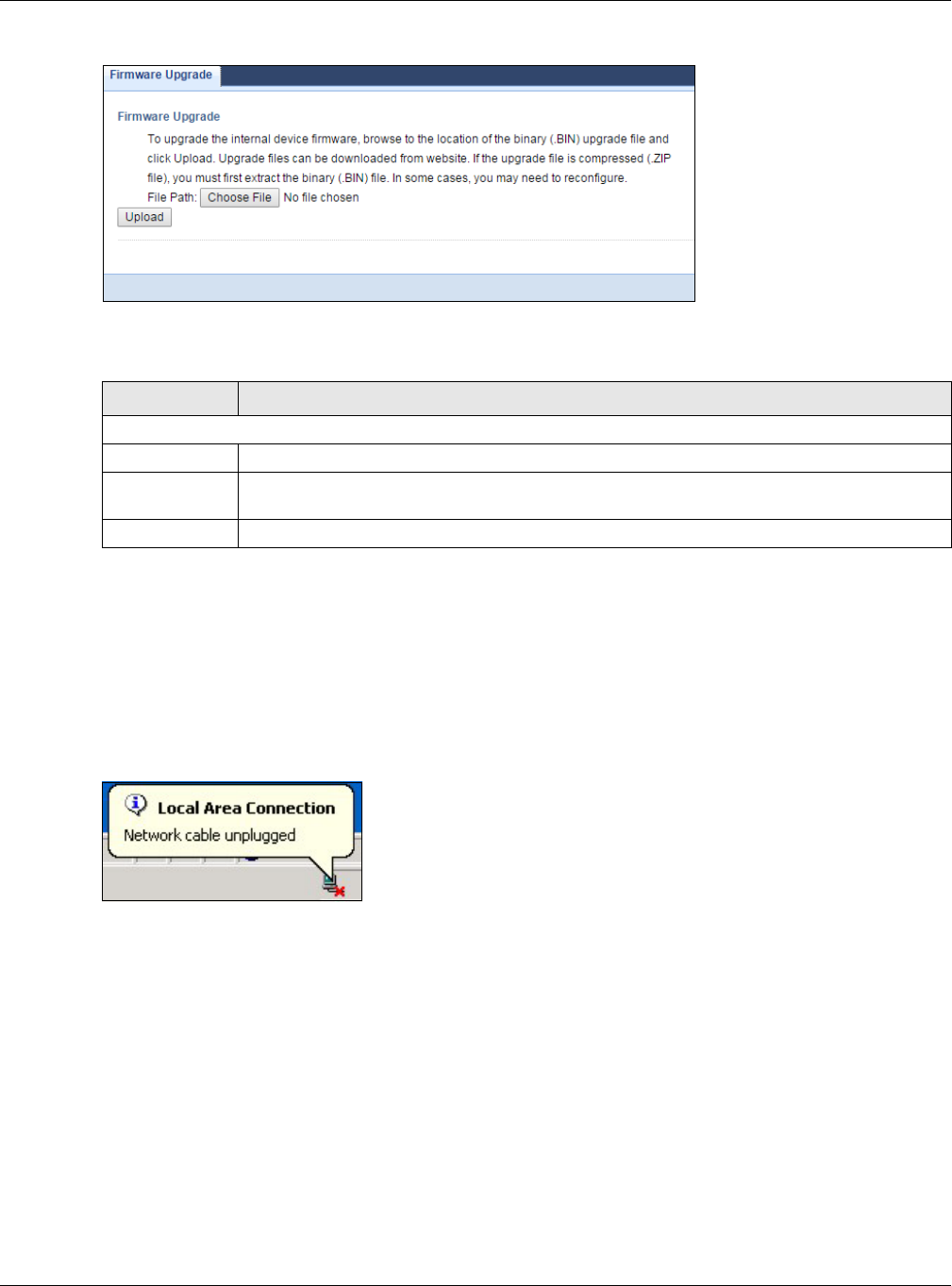
Chapter 25 Maintenance
EMG6765-Q10A User’s Guide
178
Figure 106 Maintenance > Firmware Upgrade
The following table describes the labels in this screen.
Do not turn off the EMG6765-Q10A while firmware upload is in progress!
After you see the Firmware Upload In Process screen, wait two minutes before logging into the
EMG6765-Q10A again.
The EMG6765-Q10A automatically restarts in this time causing a temporary network disconnect. In some
operating systems, you may see the following icon on your desktop.
Figure 107 Network Temporarily Disconnected
After two minutes, log in again and check your new firmware version in the Status screen.
If the upload was not successful, an error message appears.
25.7 Configuration Backup/Restore Screen
Backup configuration allows you to back up (save) the EMG6765-Q10A’s current configuration to a file
on your computer. Once your EMG6765-Q10A is configured and functioning properly, it is highly
recommended that you back up your configuration file before making configuration changes. The
backup configuration file will be useful in case you need to return to your previous settings.
Restore configuration allows you to upload a new or previously saved configuration file from your
computer to your EMG6765-Q10A.
Table 78 Maintenance > Firmware Upgrade
LABEL DESCRIPTION
Firmware Upgrade
File Path Type in the location of the file you want to upload in this field or click to find it.
Click to find the .bin file you want to upload. Remember that you must decompress compressed
(.zip) files before you can upload them.
Upload Click Upload to begin the upload process. This process may take up to two minutes.
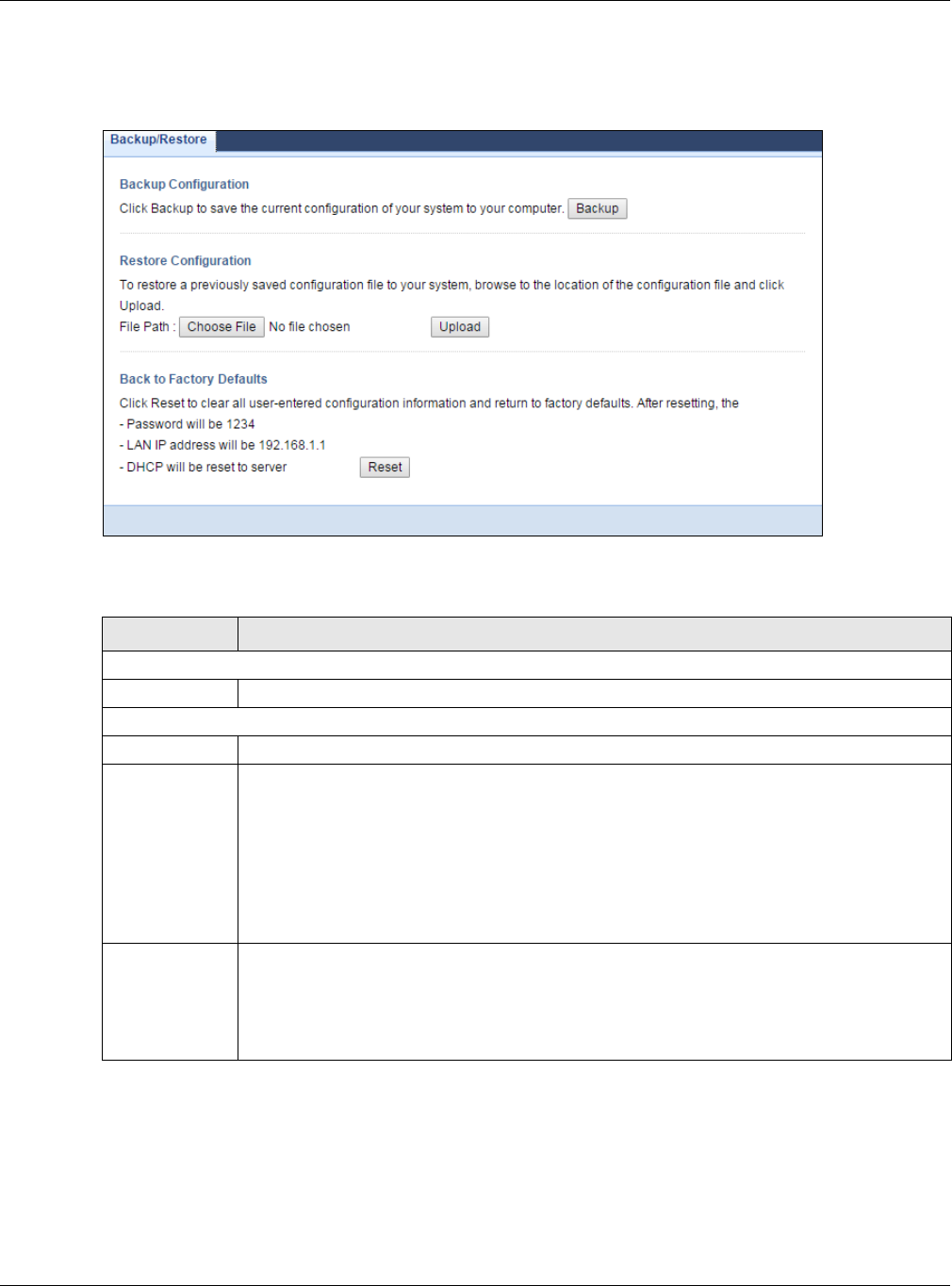
Chapter 25 Maintenance
EMG6765-Q10A User’s Guide
179
Click Maintenance > Backup/Restore. Information related to factory defaults, backup configuration,
and restoring configuration appears as shown next.
Figure 108 Maintenance > Backup/Restore
The following table describes the labels in this screen.
Note: If you uploaded the default configuration file you may need to change the IP address
of your computer to be in the same subnet as that of the default EMG6765-Q10A IP
address (192.168.1.1). See Appendix B on page 200 for details on how to set up your
computer’s IP address.
Table 79 Maintenance > Backup/Restore
LABEL DESCRIPTION
Backup Configuration
Backup Click Backup to save the EMG6765-Q10A’s current configuration to your computer.
Restore Configuration
File Path Click Choose File to browse to the location of the configuration file in your computer.
Upload Click Upload to begin the upload process.
Note: Do not turn off the EMG6765-Q10A while configuration file upload is in progress.
After you see a “configuration upload successful” screen, you must then wait one minute before
logging into the EMG6765-Q10A again. The EMG6765-Q10A automatically restarts in this time
causing a temporary network disconnect.
If you see an error screen, click Back to return to the Backup/Restore screen.
Reset Pressing the Reset button in this section clears all user-entered configuration information and
returns the EMG6765-Q10A to its factory defaults.
You can also press the RESET button on the rear panel to reset the factory defaults of your
EMG6765-Q10A. Refer to the chapter about introducing the Web Configurator for more
information on the RESET button.
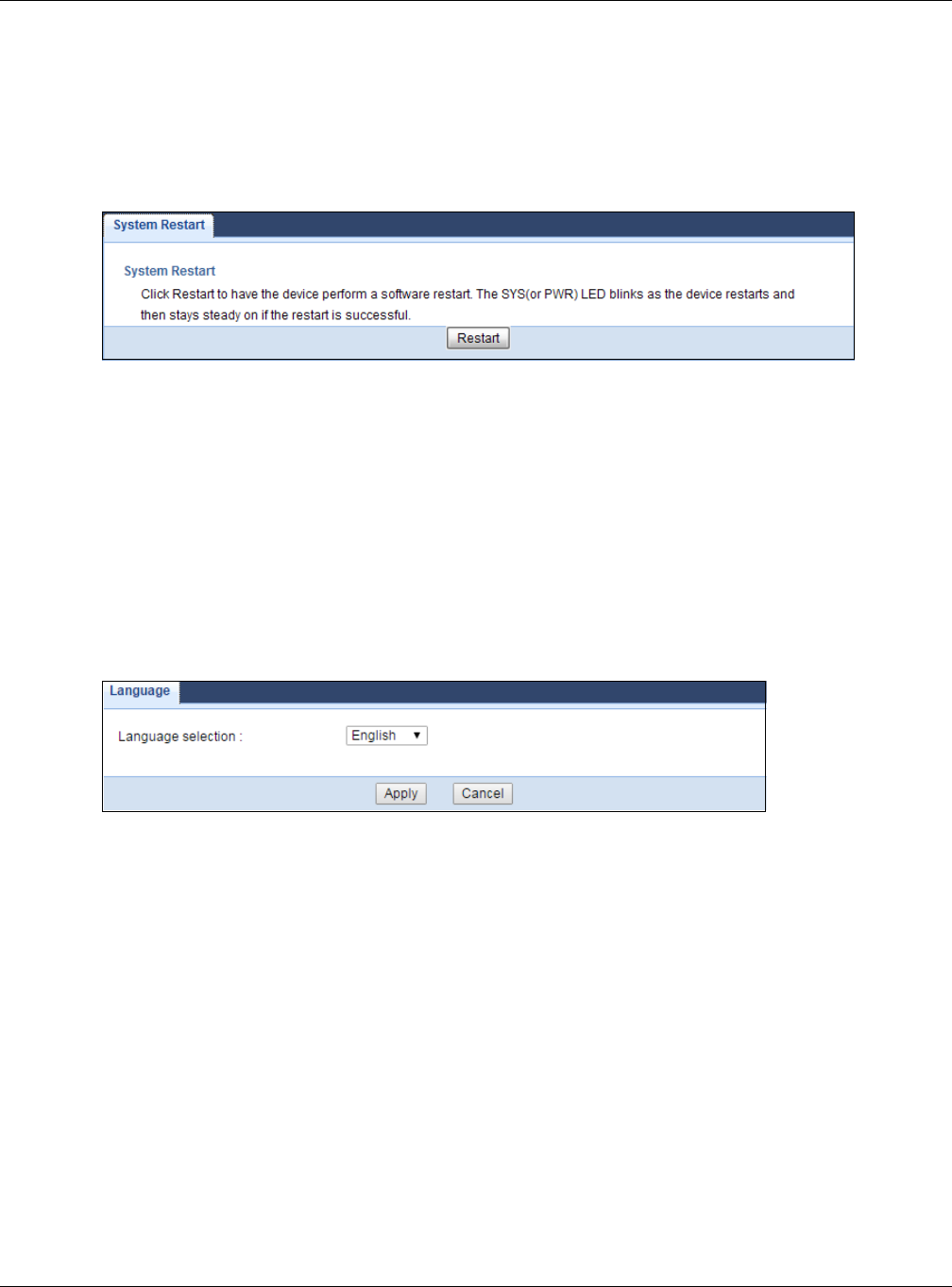
Chapter 25 Maintenance
EMG6765-Q10A User’s Guide
180
25.8 Restart Screen
System restart allows you to reboot the EMG6765-Q10A without turning the power off.
Click Maintenance > Restart to open the following screen.
Figure 109 Maintenance > Restart
Click Restart to have the EMG6765-Q10A reboot. This does not affect the EMG6765-Q10A's
configuration.
25.9 Language Screen
Use this screen to change the language for the Web Configurator.
Select the language you prefer and click Apply. The Web Configurator language changes after a while
without restarting the EMG6765-Q10A.
Figure 110 Maintenance > Language
25.10 Diagnostic Screens
The Diagnostic screens display information to help you identify problems with the EMG6765-Q10A.
25.10.1 Ping Screen
Use this screen to ping an IP address. Click Maintenance > Diagnostic > Ping to open the following
screen.
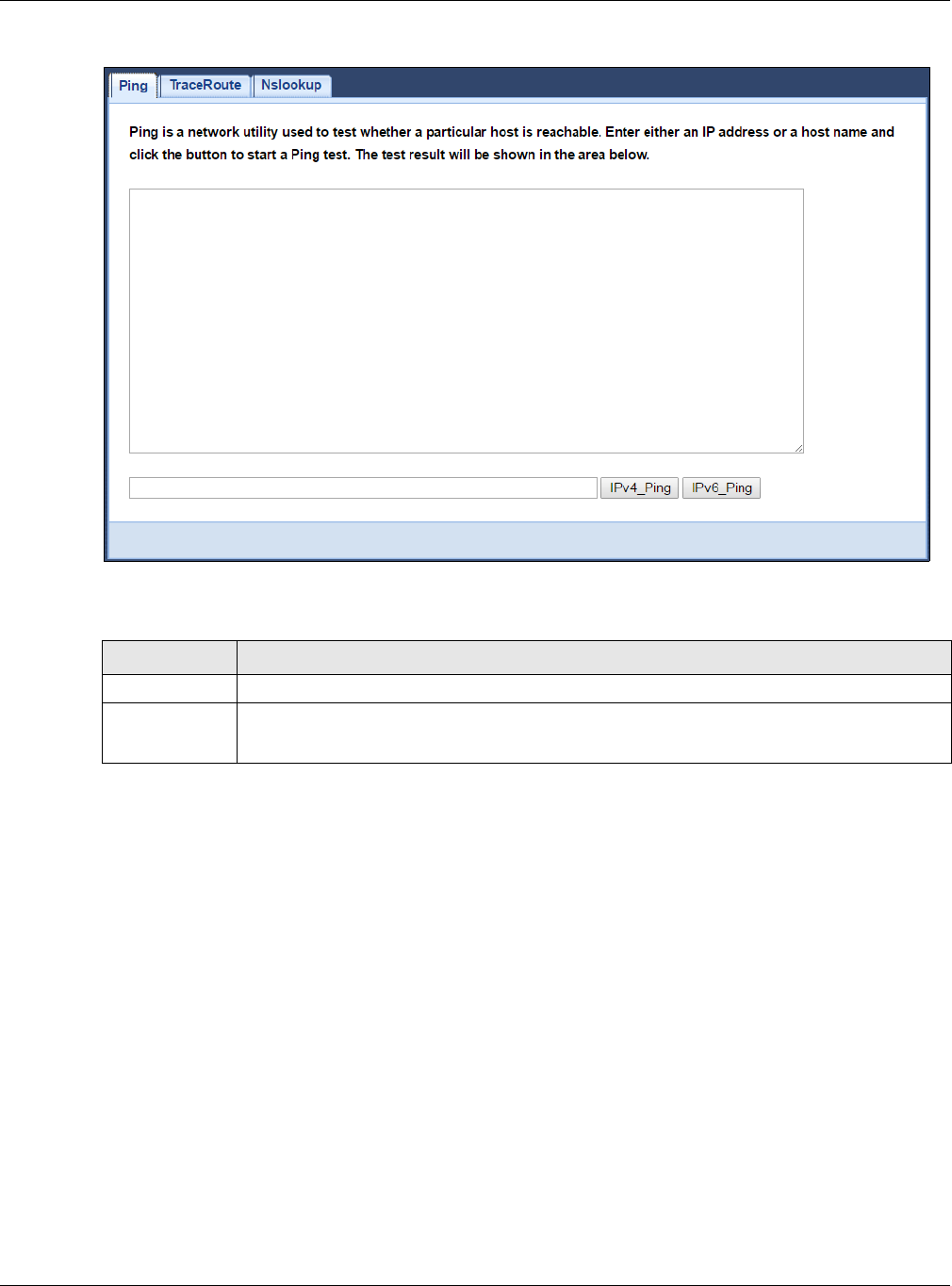
Chapter 25 Maintenance
EMG6765-Q10A User’s Guide
181
Figure 111 Maintenance > Diagnostic > Ping
The following table describes the labels in the Sys OP Mode screen.
25.10.2 Trace Route Screen
Use this screen to trace the route packets take to a host. Click Maintenance > Diagnostic > TraceRoute
to open the following screen.
Table 80 Maintenance > Sys OP Mode
LABEL DESCRIPTION
Type the IP address of a computer that you want to perform ping in order to test a connection.
IPv4_Ping
IPv6_Ping
Click this to ping the IP address that you entered.
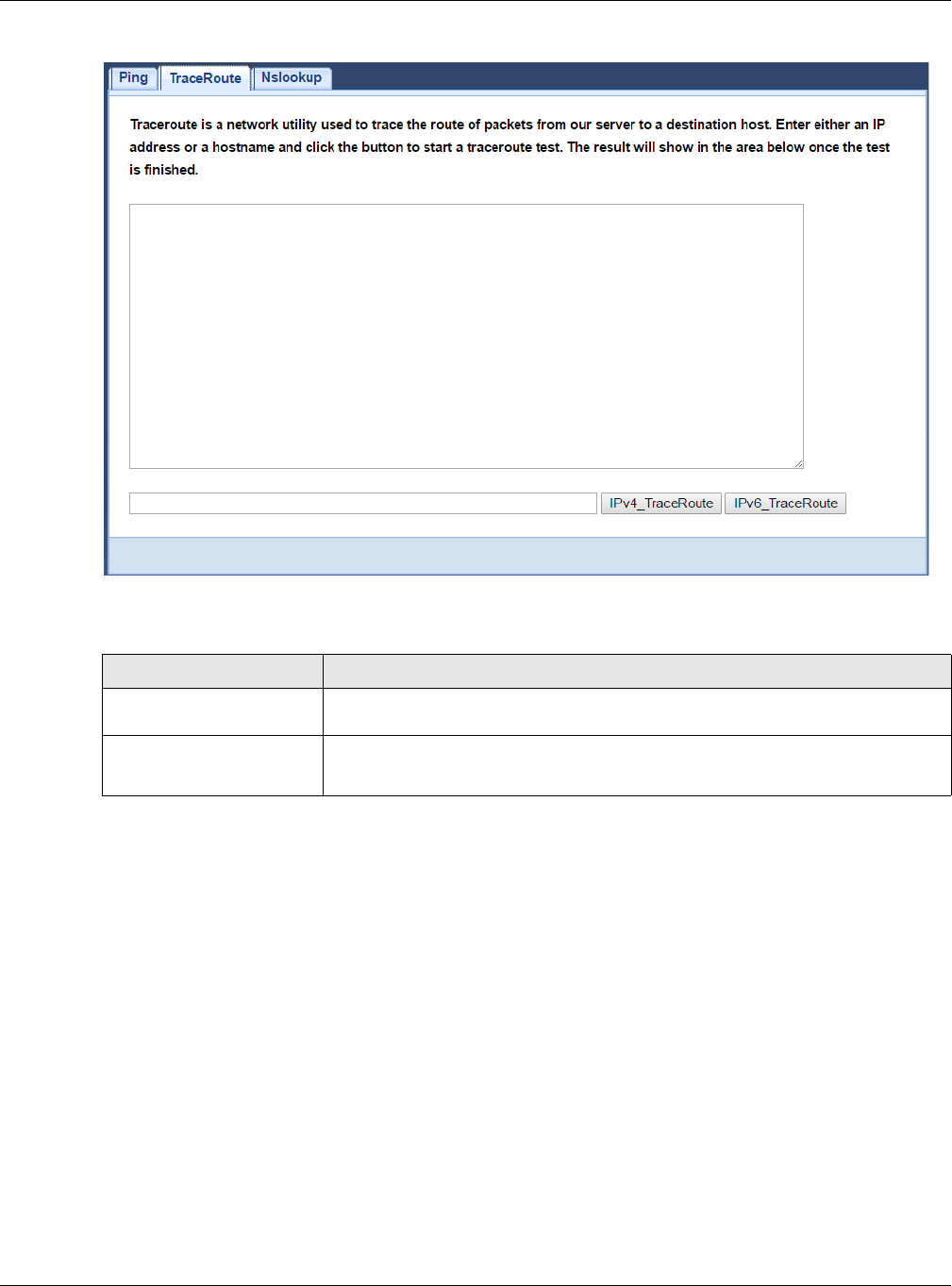
Chapter 25 Maintenance
EMG6765-Q10A User’s Guide
182
Figure 112 Maintenance > Diagnostic > TraceRoute
The following table describes the labels in this screen.
25.10.3 NsLookup Screen
Use this screen to perform an Nslookup (Name server lookup). Nslookup queries the DNS to resolve an IP
address into a host name and vice-versa. Click Maintenance > Diagnostic > Nslookup to open the
following screen.
Table 81 Maintenance > Diagnostic > TraceRoute
LABEL DESCRIPTION
Type the URL or IP address of a computer for which you want to perform traceroute
in order to test a connection.
IPv4 TraceRoute
IPv6 TraceRoute
Click this button to perform the traceroute function. This determines the path a
packet takes to the specified computer
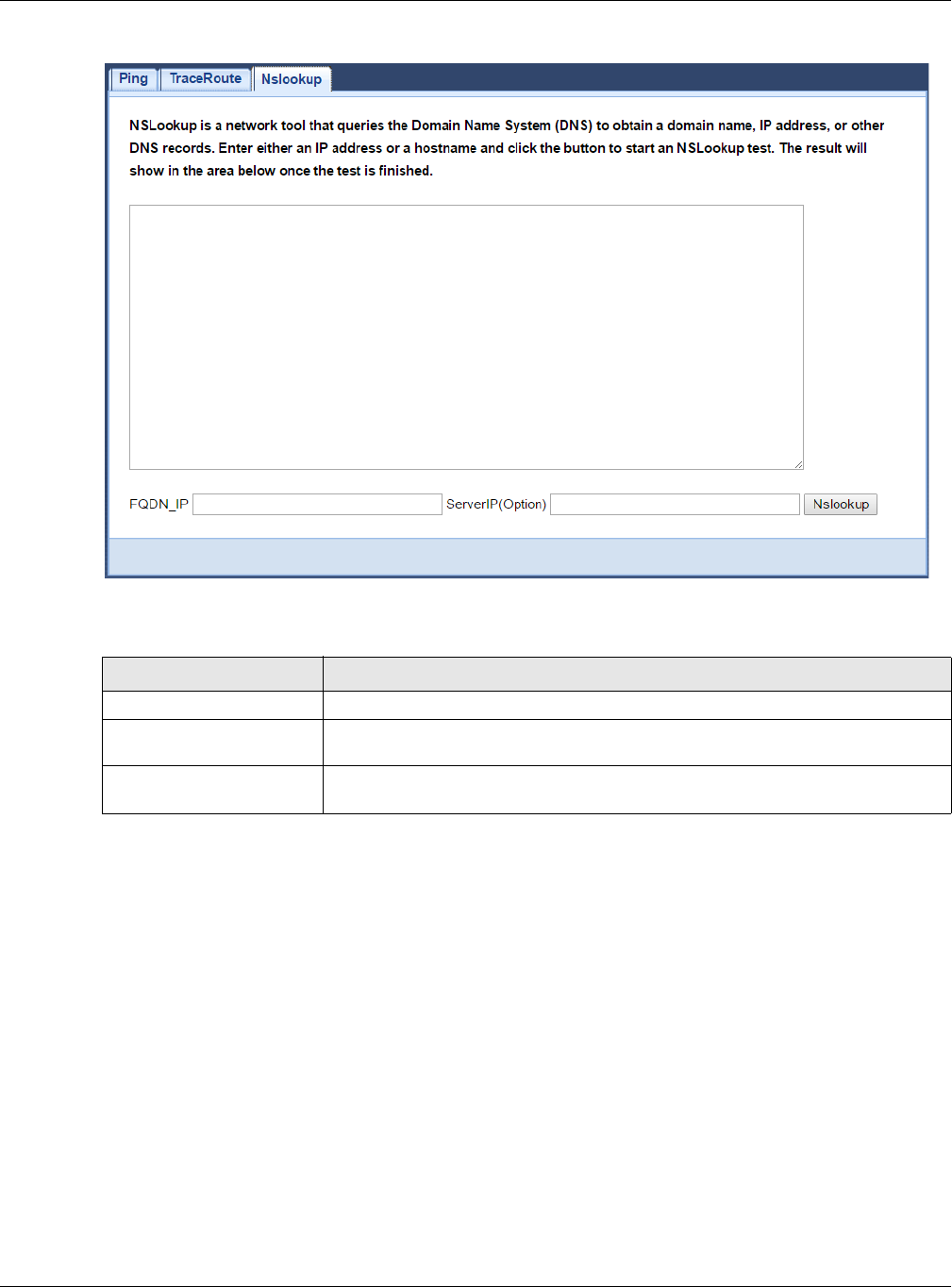
Chapter 25 Maintenance
EMG6765-Q10A User’s Guide
183
Figure 113 Maintenance > Diagnostic > Nslookup
The following table describes the labels in this screen.
Table 82 Maintenance > Diagnostic > Nslookup
LABEL DESCRIPTION
FQDN_IP Type a domain name or IP address in this field for the name server lookup.
ServerIP(Option) Enter the IP address of the server the EMG6765-Q10A uses to translate the specified
domain name or IP address.
Nslookup Click this button to perform a DNS lookup on the IP address or domain name you
entered.

EMG6765-Q10A User’s Guide
184
CHAPTER 26
Troubleshooting
26.1 Overview
This chapter offers some suggestions to solve problems you might encounter. The potential problems are
divided into the following categories.
•Power, Hardware Connections, and LEDs
•EMG6765-Q10A Access and Login
•Internet Access
•Resetting the EMG6765-Q10A to Its Factory Defaults
•Wireless Connections
•USB Device Problems
•MoCA Network
26.2 Power, Hardware Connections, and LEDs
The EMG6765-Q10A does not turn on. None of the LEDs turn on.
1Make sure you are using the power adaptor or cord included with the EMG6765-Q10A.
2Make sure the power adaptor or cord is connected to the EMG6765-Q10A and plugged in to an
appropriate power source. Make sure the power source is turned on.
3Disconnect and re-connect the power adaptor or cord to the EMG6765-Q10A.
4If the problem continues, contact the vendor.
One of the LEDs does not behave as expected.
1Make sure you understand the normal behavior of the LED. See Section 1.6 on page 15.
2Check the hardware connections. See the Quick Start Guide.
3Inspect your cables for damage. Contact the vendor to replace any damaged cables.

Chapter 26 Troubleshooting
EMG6765-Q10A User’s Guide
185
4Disconnect and re-connect the power adaptor to the EMG6765-Q10A.
5If the problem continues, contact the vendor.
26.3 EMG6765-Q10A Access and Login
I don’t know the IP address of my EMG6765-Q10A.
1The default IP address of the EMG6765-Q10A in Router Mode is 192.168.1.1. The default IP address of the
EMG6765-Q10A in Access Point Mode is 192.168.1.2.
2If you changed the IP address and have forgotten it, you might get the IP address of the EMG6765-Q10A
in Router Mode by looking up the IP address of the default gateway for your computer. To do this in most
Windows computers, click Start > Run, enter cmd, and then enter ipconfig. The IP address of the Default
Gateway might be the IP address of the EMG6765-Q10A (it depends on the network), so enter this IP
address in your Internet browser.
3If your EMG6765-Q10A in Access Point Mode is a DHCP client, you can find your IP address from the
DHCP server. This information is only available from the DHCP server which allocates IP addresses on your
network. Find this information directly from the DHCP server or contact your system administrator for
more information.
4Reset your EMG6765-Q10A to change all settings back to their default. This means your current settings
are lost. See Section 26.5 on page 188 in the Troubleshooting for information on resetting your EMG6765-
Q10A.
I forgot the password.
1The default password is in the back label of your EMG6765-Q10A.
2If this does not work, you have to reset the device to its factory defaults. See Section 26.5 on page 188.
I cannot see or access the Login screen in the Web Configurator.
1Make sure you are using the correct IP address.
• The default IP address of the EMG6765-Q10A in Router Mode is 192.168.1.1. The default IP address of
the EMG6765-Q10A in Access Point Mode is 192.168.1.2.
• If you changed the IP address (Section 10.4 on page 96), use the new IP address.
• If you changed the IP address and have forgotten it, see the troubleshooting suggestions for I don’t
know the IP address of my EMG6765-Q10A.

Chapter 26 Troubleshooting
EMG6765-Q10A User’s Guide
186
2Check the hardware connections, and make sure the LEDs are behaving as expected. See the Quick
Start Guide.
3Make sure your Internet browser does not block pop-up windows and has JavaScript and Java
enabled. See Appendix A on page 191.
4Make sure your computer is in the same subnet as the EMG6765-Q10A. (If you know that there are
routers between your computer and the EMG6765-Q10A, skip this step.)
• If there is a DHCP server on your network, make sure your computer is using a dynamic IP address.
See Section 10.4 on page 96.
• If there is no DHCP server on your network, make sure your computer’s IP address is in the same
subnet as the EMG6765-Q10A. See Section 10.4 on page 96.
5Reset the device to its factory defaults, and try to access the EMG6765-Q10A with the default IP
address. See Section 1.5 on page 14.
6If the problem continues, contact the network administrator or vendor, or try one of the advanced
suggestions.
Advanced Suggestions
• Try to access the EMG6765-Q10A using another service, such as Telnet. If you can access the
EMG6765-Q10A, check the remote management settings and firewall rules to find out why the
EMG6765-Q10A does not respond to HTTP.
• If your computer is connected to the WAN port or is connected wirelessly, use a computer that is
connected to a LAN/ETHERNET port.
I can see the Login screen, but I cannot log in to the EMG6765-Q10A.
1Make sure you have entered the password correctly. The default password is in the back label of your
EMG6765-Q10A. This field is case-sensitive, so make sure [Caps Lock] is not on.
2This can happen when you fail to log out properly from your last session. Try logging in again after 5
minutes.
3Disconnect and re-connect the power adaptor or cord to the EMG6765-Q10A.
4If this does not work, you have to reset the device to its factory defaults. See Section 26.5 on page 188.
26.4 Internet Access
I cannot access the Internet.
1Check the hardware connections, and make sure the LEDs are behaving as expected. See the Quick
Start Guide.

Chapter 26 Troubleshooting
EMG6765-Q10A User’s Guide
187
2Go to Maintenance > Sys OP Mode. Check your System Operation Mode setting.
• If the EMG6765-Q10A is in Router Mode, make sure the WAN port is connected to a broadband
modem or router with Internet access. Your computer and the EMG6765-Q10A should be in the
same subnet.
• If the EMG6765-Q10A is in Access Point Mode, make sure the WAN port is connected to a
broadband modem or router with Internet access and your computer is set to obtain an dynamic
IP address.
3If the EMG6765-Q10A is in Router Mode, make sure you entered your ISP account information correctly in
the wizard or the WAN screen. These fields are case-sensitive, so make sure [Caps Lock] is not on.
4If you are trying to access the Internet wirelessly, make sure the wireless settings in the wireless client are
the same as the settings in the AP.
5Disconnect all the cables from your device, and follow the directions in the Quick Start Guide again.
6If the problem continues, contact your ISP.
I cannot access the Internet anymore. I had access to the Internet (with the EMG6765-Q10A), but
my Internet connection is not available anymore.
1Check the hardware connections, and make sure the LEDs are behaving as expected. See the Quick
Start Guide and Section 1.6 on page 15.
2Reboot the EMG6765-Q10A.
3If the problem continues, contact your ISP.
The Internet connection is slow or intermittent.
1There might be a lot of traffic on the network. Look at the LEDs, and check Section 1.6 on page 15. If the
EMG6765-Q10A is sending or receiving a lot of information, try closing some programs that use the
Internet, especially peer-to-peer applications.
2Check the signal strength. If the signal strength is low, try moving the EMG6765-Q10A closer to the AP if
possible, and look around to see if there are any devices that might be interfering with the wireless
network (for example, microwaves, other wireless networks, and so on).
3Reboot the EMG6765-Q10A.
4If the problem continues, contact the network administrator or vendor, or try one of the advanced
suggestions.
Advanced Suggestion
• Check the settings for QoS. If it is disabled, you might consider activating it.

Chapter 26 Troubleshooting
EMG6765-Q10A User’s Guide
188
26.5 Resetting the EMG6765-Q10A to Its Factory Defaults
If you reset the EMG6765-Q10A, you lose all of the changes you have made. The EMG6765-Q10A re-
loads its default settings, and the password resets to the back-label default key. You have to make all of
your changes again.
You will lose all of your changes when you push the RESET button.
To reset the EMG6765-Q10A:
1Make sure the power LED is on.
2Press the RESET button for one to four seconds to restart/reboot the EMG6765-Q10A.
3Press the RESET button for more than five seconds to set the EMG6765-Q10A back to its factory-default
configurations.
If the EMG6765-Q10A restarts automatically, wait for the EMG6765-Q10A to finish restarting, and log in to
the Web Configurator. The password is in the back label of your EMG6765-Q10A.
If the EMG6765-Q10A does not restart automatically, disconnect and reconnect the EMG6765-Q10A’s
power. Then, follow the directions above again.
26.6 Wireless Connections
I cannot access the EMG6765-Q10A or ping any computer from the WLAN.
1Make sure the wireless LAN is enabled on the EMG6765-Q10A.
2Make sure the wireless adapter on your computer is working properly.
3Make sure the wireless adapter installed on your computer is IEEE 802.11 compatible and supports the
same wireless standard as the EMG6765-Q10A.
4Make sure your computer (with a wireless adapter installed) is within the transmission range of the
EMG6765-Q10A.
5Check that both the EMG6765-Q10A and the wireless adapter on your computer are using the same
wireless and wireless security settings.
6Make sure traffic between the WLAN and the LAN is not blocked by the firewall on the EMG6765-Q10A.
7Make sure you allow the EMG6765-Q10A to be remotely accessed through the WLAN interface. Check
your remote management settings.

Chapter 26 Troubleshooting
EMG6765-Q10A User’s Guide
189
•See the chapter on Wireless LAN in the User’s Guide for more information.
I set up URL keyword blocking, but I can still access a website that should be blocked.
Make sure that you enable parental control in the Parental Control screen, set up rules and turn on the
rules. Make sure that the keywords that you type are listed in the rule’s Keyword List.
If a keyword that is listed in the Keyword List is not blocked when it is found in a URL, customize the
keyword blocking using commands. See the Customizing Keyword Blocking URL Checking section in the
IPv6 Firewall chapter.
I cannot access the Web Configurator after I switched to AP mode.
When you change from router mode to AP mode, your computer must have an IP address in the range
between “192.168.1.3” and “192.168.1.254”.
Refer to Appendix B on page 200 for instructions on how to change your computer’s IP address.
What factors may cause intermittent or unstabled wireless connection? How can I solve this
problem?
The following factors may cause interference:
• Obstacles: walls, ceilings, furniture, and so on.
• Building Materials: metal doors, aluminum studs.
• Electrical devices: microwaves, monitors, electric motors, cordless phones, and other wireless devices.
To optimize the speed and quality of your wireless connection, you can:
• Move your wireless device closer to the AP if the signal strength is low.
• Reduce wireless interference that may be caused by other wireless networks or surrounding wireless
electronics such as cordless phones.
• Place the AP where there are minimum obstacles (such as walls and ceilings) between the AP and
the wireless client.
• Reduce the number of wireless clients connecting to the same AP simultaneously, or add additional
APs if necessary.
• Try closing some programs that use the Internet, especially peer-to-peer applications. If the wireless
client is sending or receiving a lot of information, it may have too many programs open that use the
Internet.
• Position the antennas for best reception. If the AP is placed on a table or floor, point the antennas
upwards. If the AP is placed at a high position, point the antennas downwards. Try pointing the
antennas in different directions and check which provides the strongest signal to the wireless clients.

Chapter 26 Troubleshooting
EMG6765-Q10A User’s Guide
190
26.7 USB Device Problems
I cannot access or see a USB device that is connected to the EMG6765-Q10A.
1Disconnect the problematic USB device, then reconnect it to the EMG6765-Q10A.
2Ensure that the USB device has power.
3Check your cable connections.
4Restart the EMG6765-Q10A by disconnecting the power and then reconnecting it.
5If the USB device requires a special driver, install the driver from the installation disc that came with the
device. After driver installation, reconnect the USB device to the EMG6765-Q10A and try to connect to it
again with your computer.
6If the problem persists, contact your vendor.
What kind of USB devices do the EMG6765-Q10A support?
1It is strongly recommended to use version 2.0 or lower USB storage devices (such as memory sticks, USB
hard drives) and/or USB devices. Other USB products are not guaranteed to function properly with the
EMG6765-Q10A.
26.8 MoCA Network
The EMG6765-Q10A cannot set up a MoCA network with other MoCA devices.
1Make sure all the MoCA devices are turned on and connected using the same coaxial wiring.
2Make sure all the MoCA devices are operating at the same channel frequency.
3If you enable MoCA network security on the EMG6765-Q10A, make sure other MoCA devices also use
the same password.
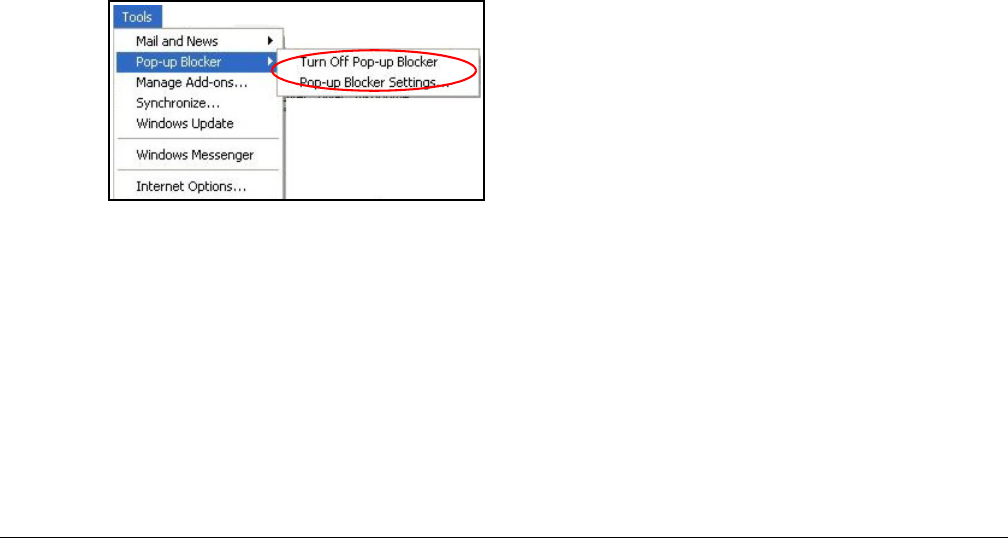
EMG6765-Q10A User’s Guide
191
APPENDIX A
Pop-up Windows, JavaScript and
Java Permissions
In order to use the web configurator you need to allow:
• Web browser pop-up windows from your device.
• JavaScript (enabled by default).
• Java permissions (enabled by default).
Note: The screens used below belong to Internet Explorer version 6, 7 and 8. Screens for other
Internet Explorer versions may vary.
Internet Explorer Pop-up Blockers
You may have to disable pop-up blocking to log into your device.
Either disable pop-up blocking (enabled by default in Windows XP SP (Service Pack) 2) or allow pop-up
blocking and create an exception for your device’s IP address.
Disable Pop-up Blockers
1In Internet Explorer, select Tools, Pop-up Blocker and then select Turn Off Pop-up Blocker.
Figure 114 Pop-up Blocker
You can also check if pop-up blocking is disabled in the Pop-up Blocker section in the Privacy tab.
1In Internet Explorer, select Tools, Internet Options, Privacy.
2Clear the Block pop-ups check box in the Pop-up Blocker section of the screen. This disables any web
pop-up blockers you may have enabled.
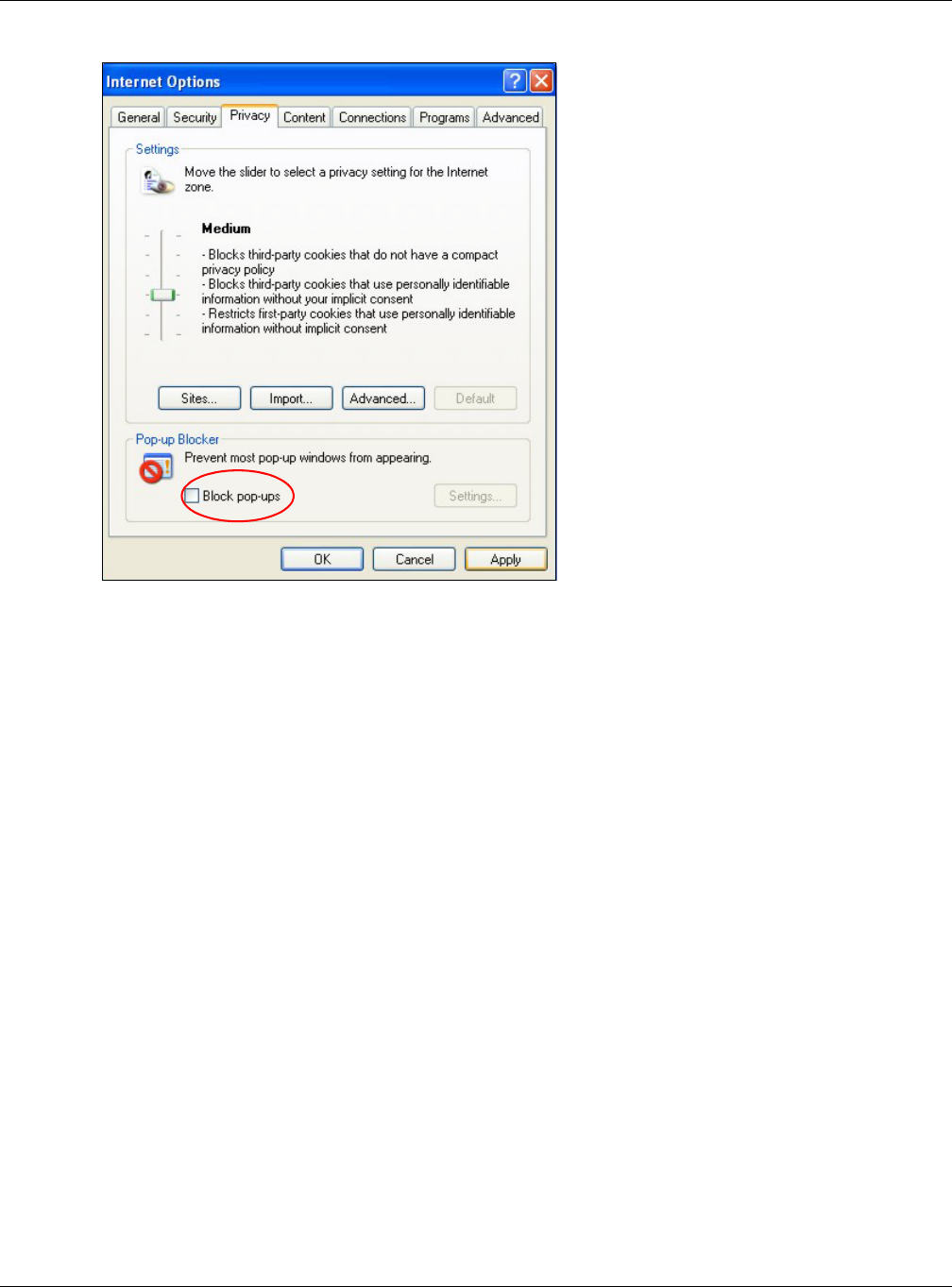
Appendix A Pop-up Windows, JavaScript and Java Permissions
EMG6765-Q10A User’s Guide
192
Figure 115 Internet Options: Privacy
3Click Apply to save this setting.
Enable Pop-up Blockers with Exceptions
Alternatively, if you only want to allow pop-up windows from your device, see the following steps.
1In Internet Explorer, select Tools, Internet Options and then the Privacy tab.
2Select Settings…to open the Pop-up Blocker Settings screen.
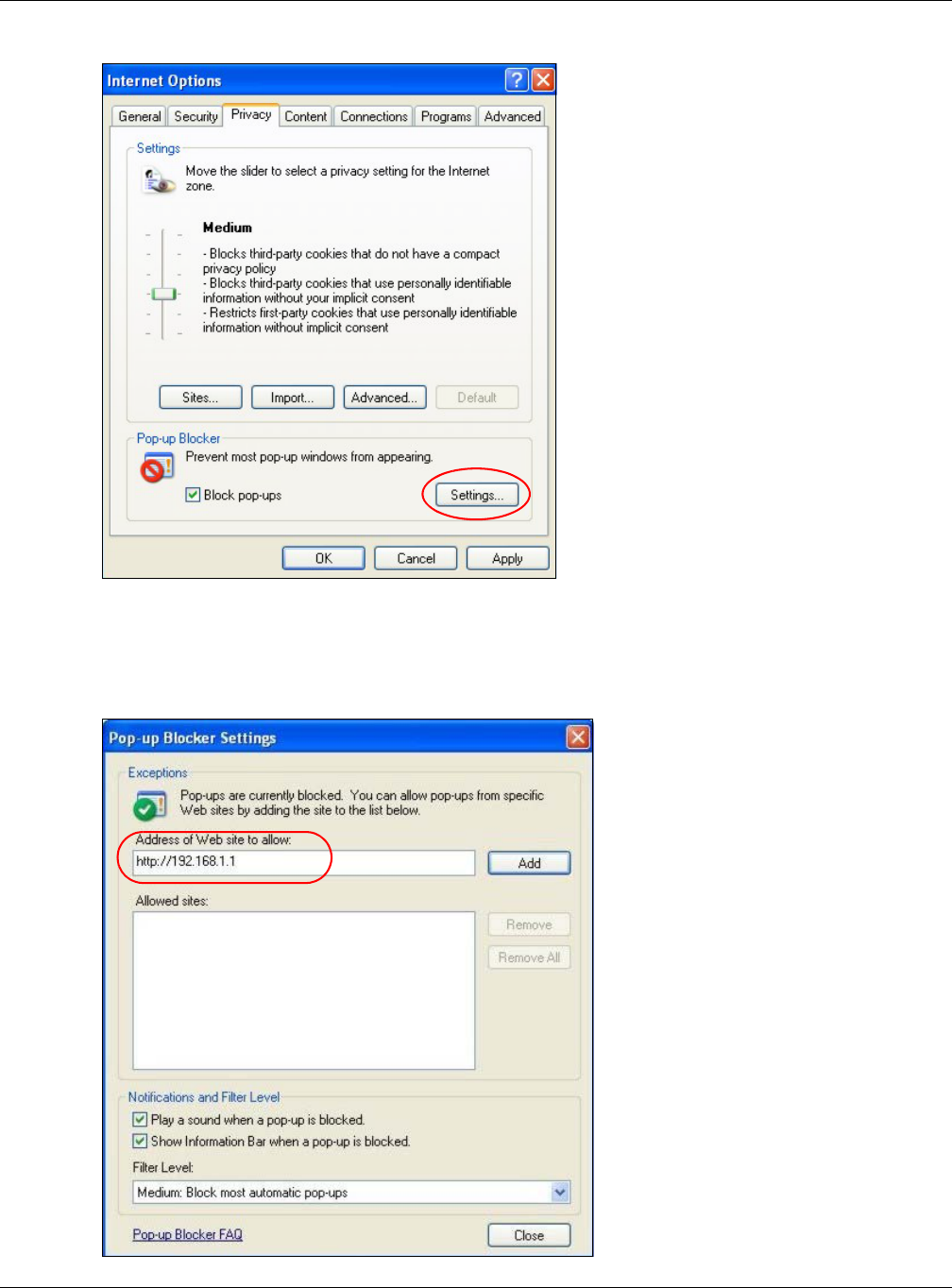
Appendix A Pop-up Windows, JavaScript and Java Permissions
EMG6765-Q10A User’s Guide
193
Figure 116 Internet Options: Privacy
3Type the IP address of your device (the web page that you do not want to have blocked) with the prefix
“http://”. For example, http://192.168.167.1.
4Click Add to move the IP address to the list of Allowed sites.
Figure 117 Pop-up Blocker Settings
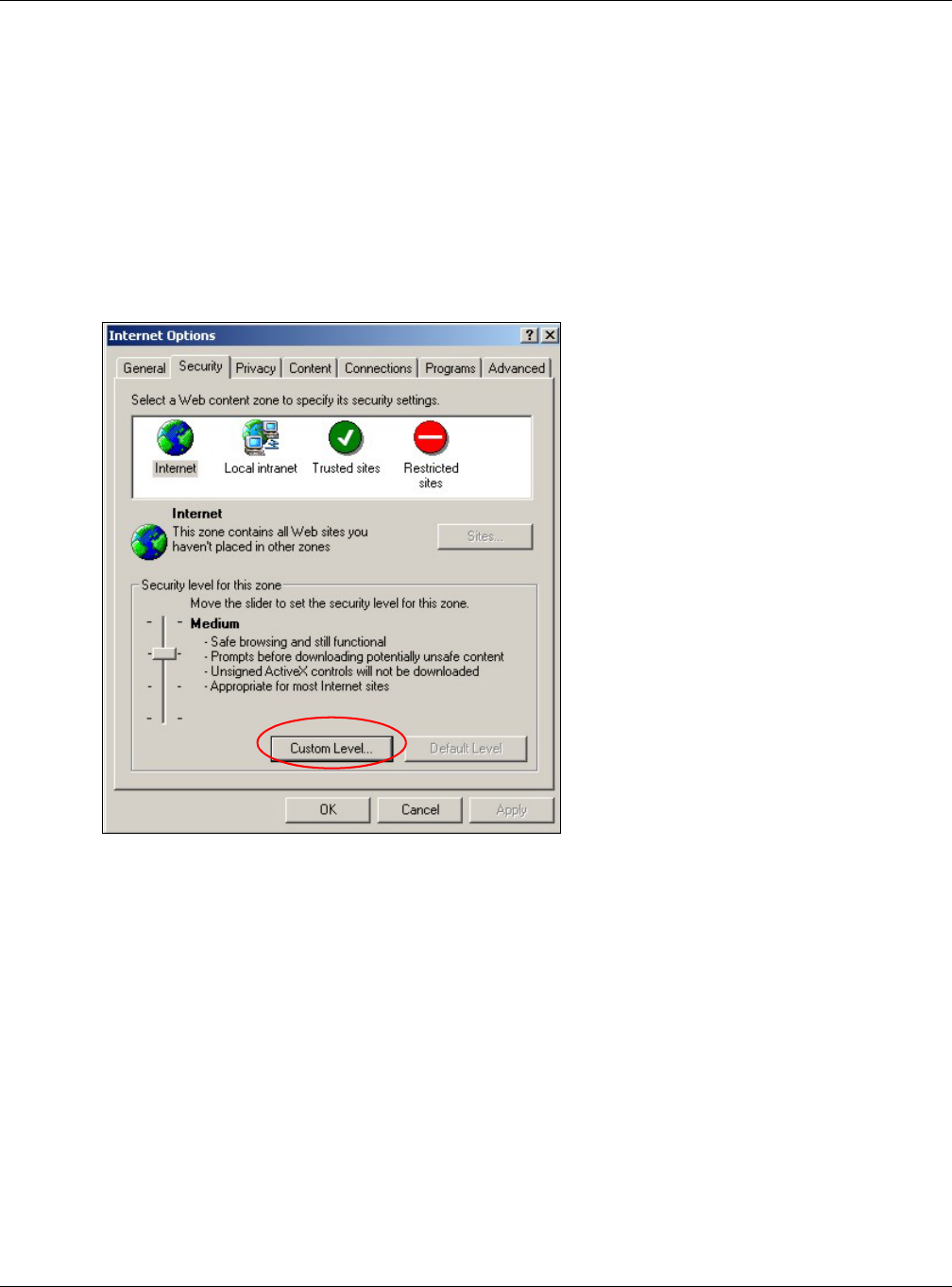
Appendix A Pop-up Windows, JavaScript and Java Permissions
EMG6765-Q10A User’s Guide
194
5Click Close to return to the Privacy screen.
6Click Apply to save this setting.
JavaScript
If pages of the web configurator do not display properly in Internet Explorer, check that JavaScript are
allowed.
1In Internet Explorer, click Tools, Internet Options and then the Security tab.
Figure 118 Internet Options: Security
2Click the Custom Level... button.
3Scroll down to Scripting.
4Under Active scripting make sure that Enable is selected (the default).
5Under Scripting of Java applets make sure that Enable is selected (the default).
6Click OK to close the window.
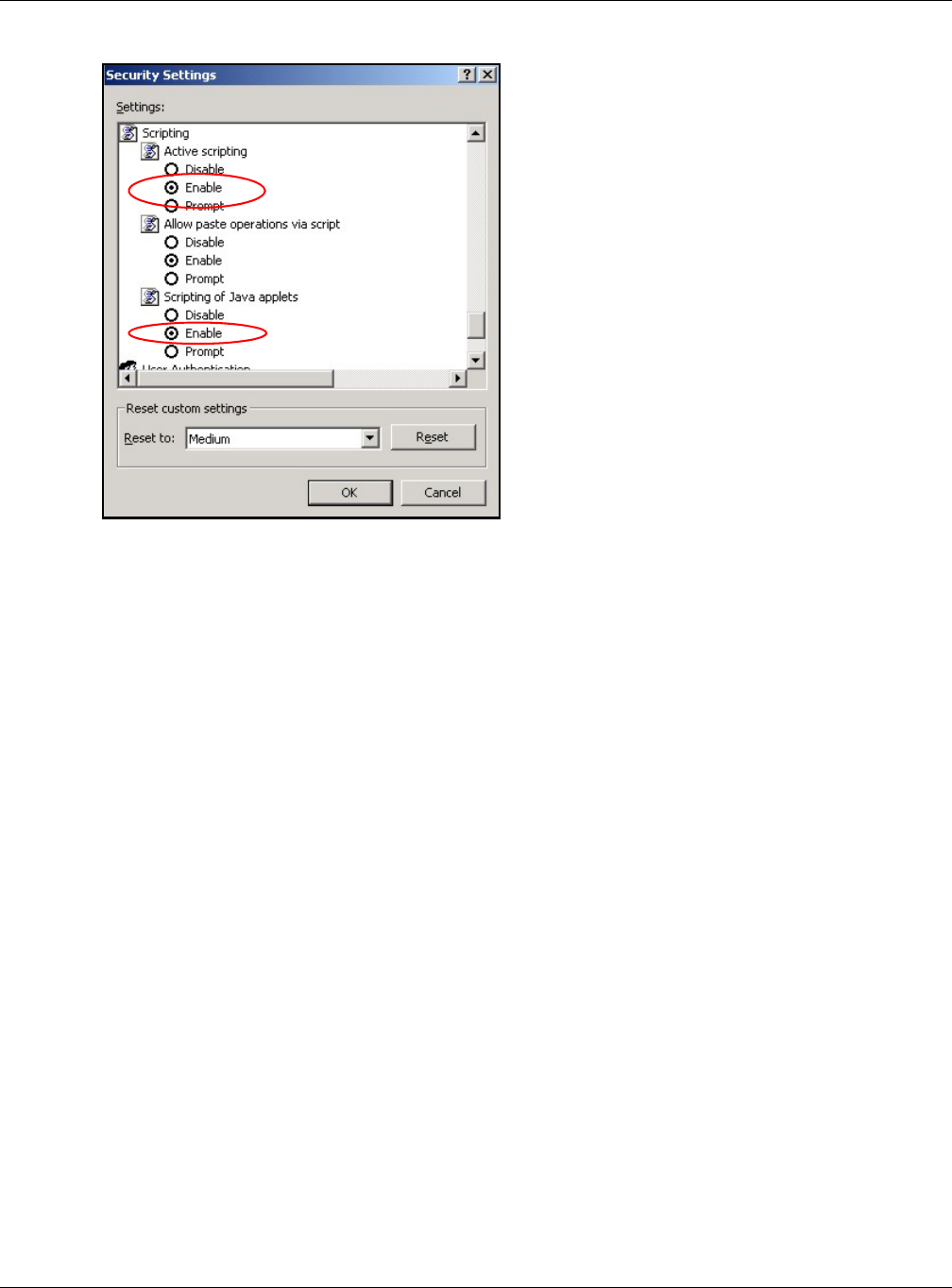
Appendix A Pop-up Windows, JavaScript and Java Permissions
EMG6765-Q10A User’s Guide
195
Figure 119 Security Settings - Java Scripting
Java Permissions
1From Internet Explorer, click Tools, Internet Options and then the Security tab.
2Click the Custom Level... button.
3Scroll down to Microsoft VM.
4Under Java permissions make sure that a safety level is selected.
5Click OK to close the window.
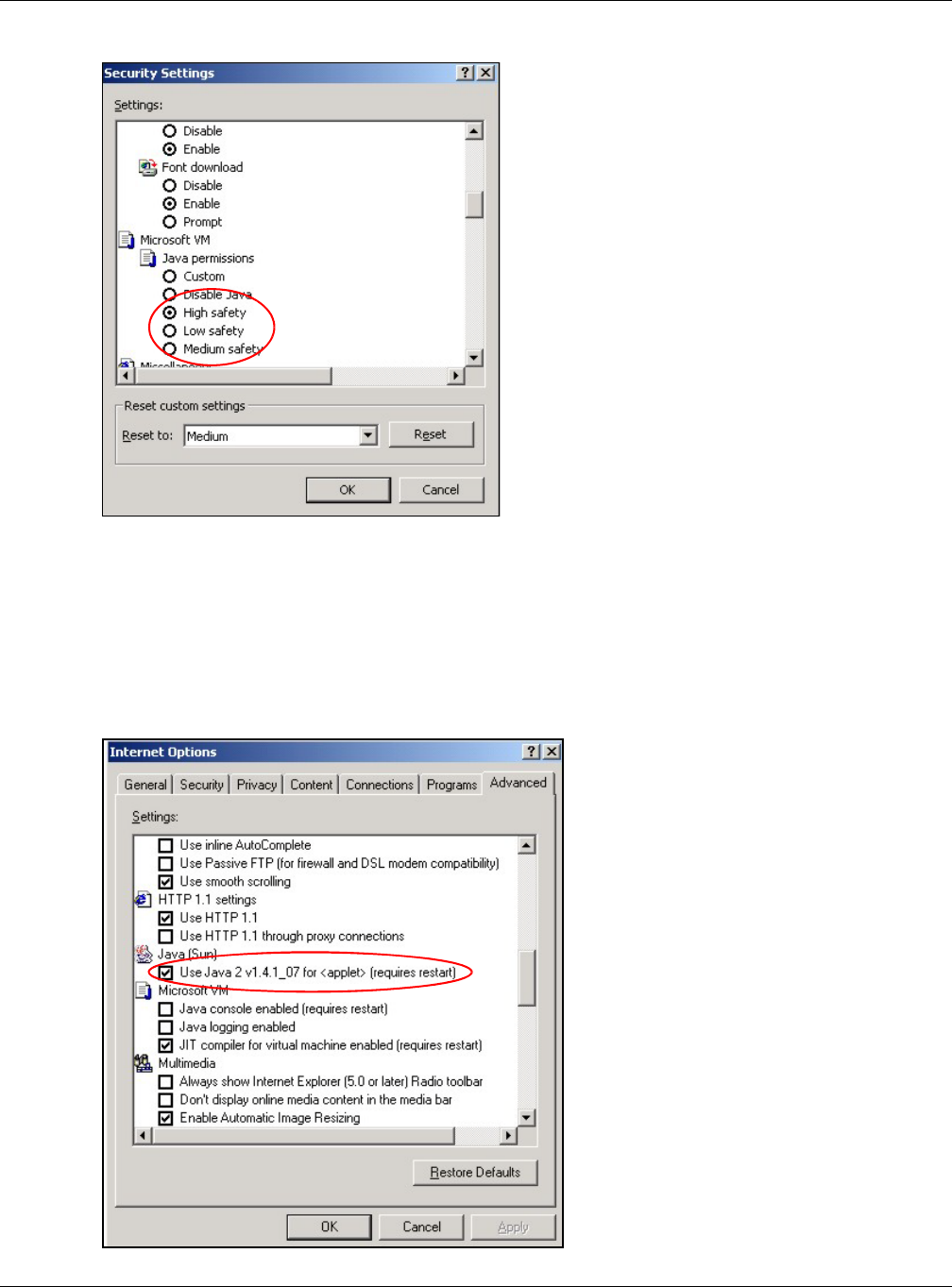
Appendix A Pop-up Windows, JavaScript and Java Permissions
EMG6765-Q10A User’s Guide
196
Figure 120 Security Settings - Java
JAVA (Sun)
1From Internet Explorer, click Tools, Internet Options and then the Advanced tab.
2Make sure that Use Java 2 for <applet> under Java (Sun) is selected.
3Click OK to close the window.
Figure 121 Java (Sun)
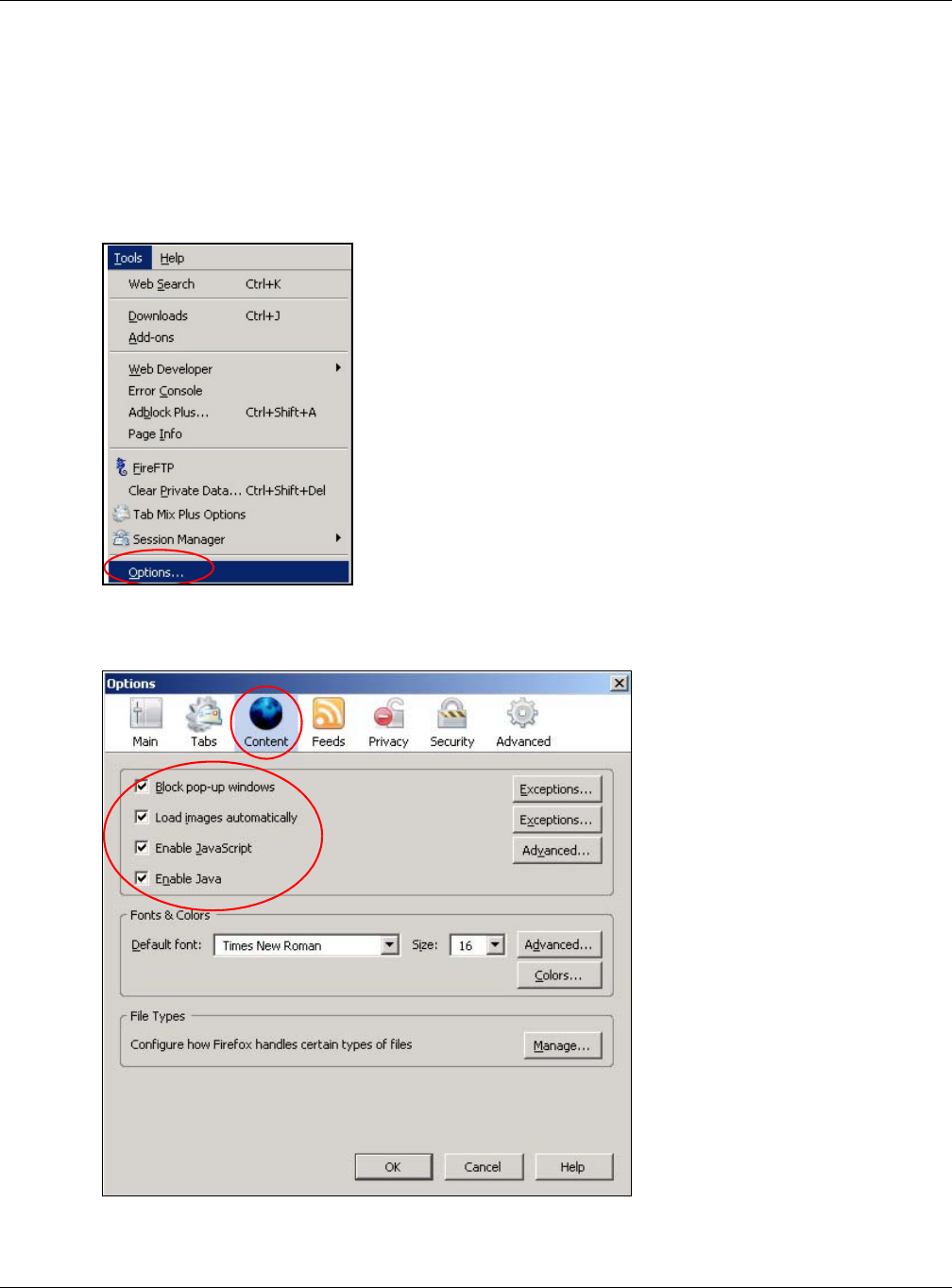
Appendix A Pop-up Windows, JavaScript and Java Permissions
EMG6765-Q10A User’s Guide
197
Mozilla Firefox
Mozilla Firefox 2.0 screens are used here. Screens for other versions may vary slightly. The steps below
apply to Mozilla Firefox 3.0 as well.
You can enable Java, Javascript and pop-ups in one screen. Click Tools, then click Options in the
screen that appears.
Figure 122 Mozilla Firefox: TOOLS > Options
Click Content to show the screen below. Select the check boxes as shown in the following screen.
Figure 123 Mozilla Firefox Content Security
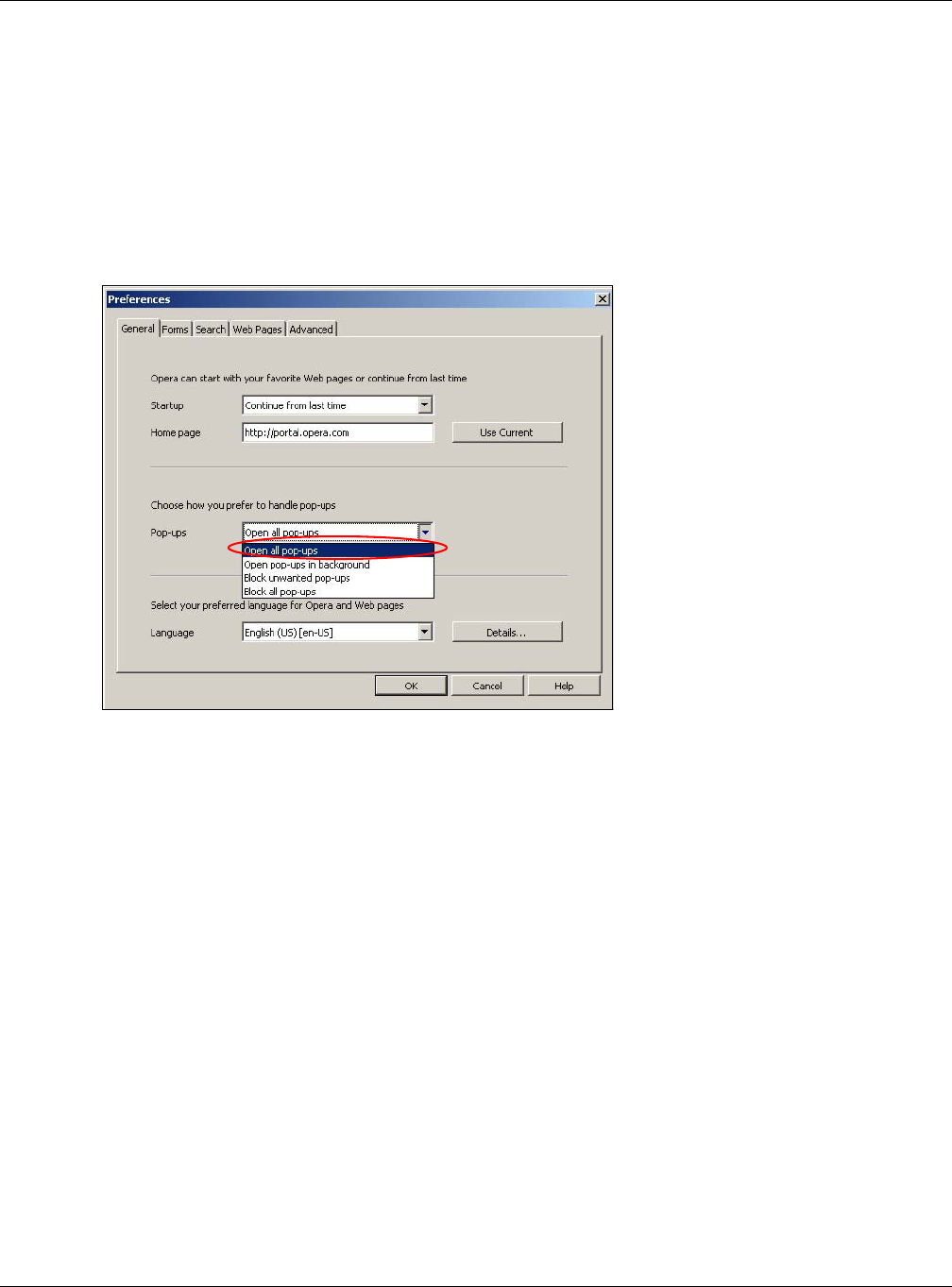
Appendix A Pop-up Windows, JavaScript and Java Permissions
EMG6765-Q10A User’s Guide
198
Opera
Opera 10 screens are used here. Screens for other versions may vary slightly.
Allowing Pop-Ups
From Opera, click Tools, then Preferences. In the General tab, go to Choose how you prefer to handle
pop-ups and select Open all pop-ups.
Figure 124 Opera: Allowing Pop-Ups
Enabling Java
From Opera, click Tools, then Preferences. In the Advanced tab, select Content from the left-side menu.
Select the check boxes as shown in the following screen.
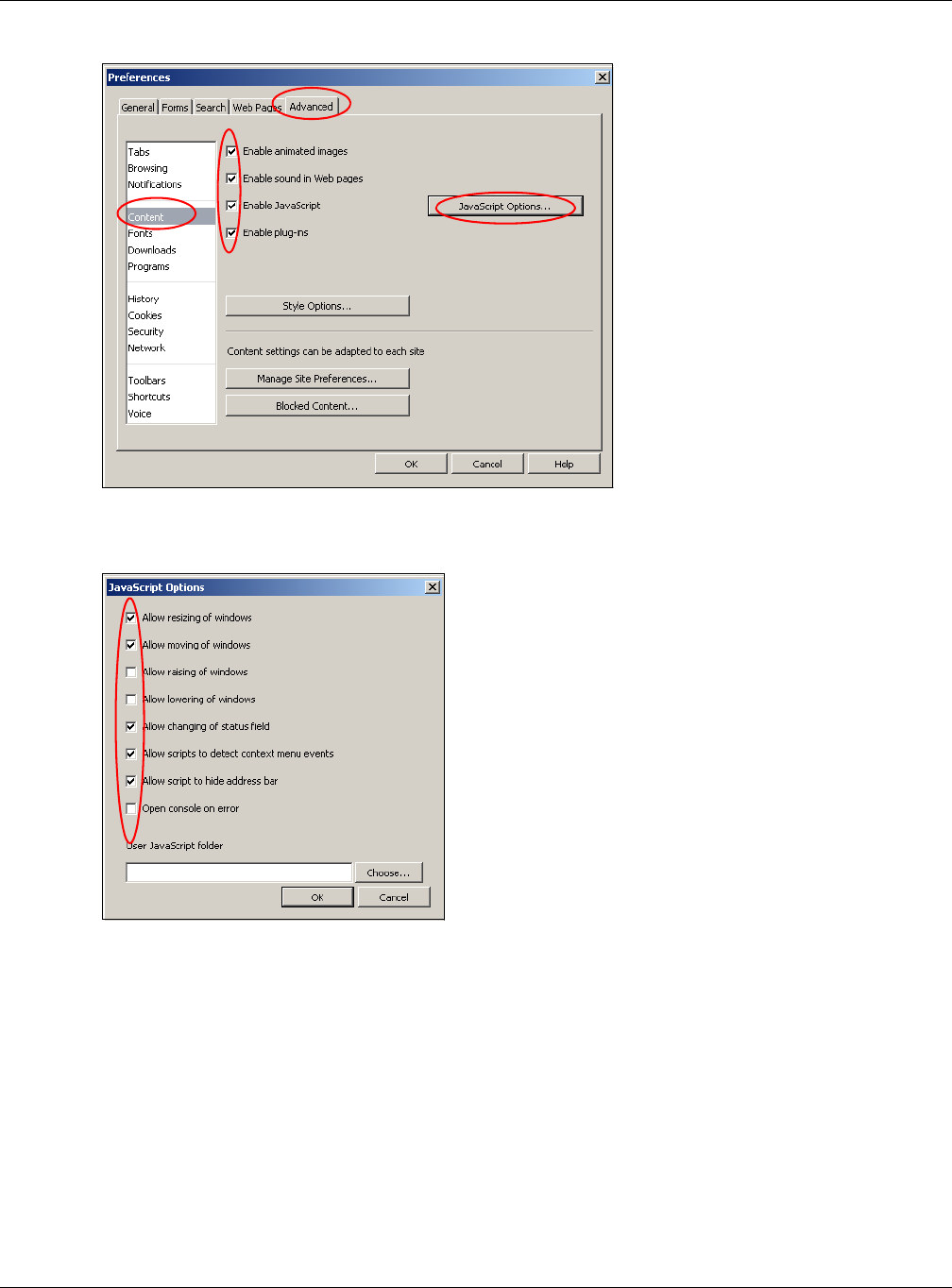
Appendix A Pop-up Windows, JavaScript and Java Permissions
EMG6765-Q10A User’s Guide
199
Figure 125 Opera: Enabling Java
To customize JavaScript behavior in the Opera browser, click JavaScript Options.
Figure 126 Opera: JavaScript Options
Select the items you want Opera’s JavaScript to apply.

EMG6765-Q10A User’s Guide
200
APPENDIX B
Common Services
The following table lists some commonly-used services and their associated protocols and port numbers.
For a comprehensive list of port numbers, ICMP type/code numbers and services, visit the IANA (Internet
Assigned Number Authority) web site.
•Name: This is a short, descriptive name for the service. You can use this one or create a different one,
if you like.
•Protocol: This is the type of IP protocol used by the service. If this is TCP/UDP, then the service uses the
same port number with TCP and UDP. If this is USER-DEFINED, the Port(s) is the IP protocol number, not
the port number.
•Port(s): This value depends on the Protocol. Please refer to RFC 1700 for further information about port
numbers.
•If the Protocol is TCP, UDP, or TCP/UDP, this is the IP port number.
•If the Protocol is USER, this is the IP protocol number.
•Description: This is a brief explanation of the applications that use this service or the situations in which
this service is used.
Table 83 Commonly Used Services
NAME PROTOCOL PORT(S) DESCRIPTION
AH (IPSEC_TUNNEL) User-Defined 51 The IPSEC AH (Authentication Header) tunneling
protocol uses this service.
AIM/New-ICQ TCP 5190 AOL’s Internet Messenger service. It is also used as a
listening port by ICQ.
AUTH TCP 113 Authentication protocol used by some servers.
BGP TCP 179 Border Gateway Protocol.
BOOTP_CLIENT UDP 68 DHCP Client.
BOOTP_SERVER UDP 67 DHCP Server.
CU-SEEME TCP
UDP
7648
24032
A popular videoconferencing solution from White
Pines Software.
DNS TCP/UDP 53 Domain Name Server, a service that matches web
names (for example www.zyxel.com) to IP numbers.
ESP (IPSEC_TUNNEL) User-Defined 50 The IPSEC ESP (Encapsulation Security Protocol)
tunneling protocol uses this service.
FINGER TCP 79 Finger is a UNIX or Internet related command that can
be used to find out if a user is logged on.
FTP TCP
TCP
20
21
File Transfer Program, a program to enable fast
transfer of files, including large files that may not be
possible by e-mail.
H.323 TCP 1720 NetMeeting uses this protocol.
HTTP TCP 80 Hyper Text Transfer Protocol - a client/server protocol
for the world wide web.
HTTPS TCP 443 HTTPS is a secured http session often used in e-
commerce.

Appendix B Common Services
EMG6765-Q10A User’s Guide
201
ICMP User-Defined 1Internet Control Message Protocol is often used for
diagnostic or routing purposes.
ICQ UDP 4000 This is a popular Internet chat program.
IGMP (MULTICAST) User-Defined 2Internet Group Management Protocol is used when
sending packets to a specific group of hosts.
IKE UDP 500 The Internet Key Exchange algorithm is used for key
distribution and management.
IRC TCP/UDP 6667 This is another popular Internet chat program.
MSN Messenger TCP 1863 Microsoft Networks’ messenger service uses this
protocol.
NEW-ICQ TCP 5190 An Internet chat program.
NEWS TCP 144 A protocol for news groups.
NFS UDP 2049 Network File System - NFS is a client/server distributed
file service that provides transparent file sharing for
network environments.
NNTP TCP 119 Network News Transport Protocol is the delivery
mechanism for the USENET newsgroup service.
PING User-Defined 1Packet INternet Groper is a protocol that sends out
ICMP echo requests to test whether or not a remote
host is reachable.
POP3 TCP 110 Post Office Protocol version 3 lets a client computer
get e-mail from a POP3 server through a temporary
connection (TCP/IP or other).
PPTP TCP 1723 Point-to-Point Tunneling Protocol enables secure
transfer of data over public networks. This is the
control channel.
PPTP_TUNNEL (GRE) User-Defined 47 PPTP (Point-to-Point Tunneling Protocol) enables
secure transfer of data over public networks. This is the
data channel.
RCMD TCP 512 Remote Command Service.
REAL_AUDIO TCP 7070 A streaming audio service that enables real time
sound over the web.
REXEC TCP 514 Remote Execution Daemon.
RLOGIN TCP 513 Remote Login.
RTELNET TCP 107 Remote Telnet.
RTSP TCP/UDP 554 The Real Time Streaming (media control) Protocol
(RTSP) is a remote control for multimedia on the
Internet.
SFTP TCP 115 Simple File Transfer Protocol.
SMTP TCP 25 Simple Mail Transfer Protocol is the message-
exchange standard for the Internet. SMTP enables
you to move messages from one e-mail server to
another.
SNMP TCP/UDP 161 Simple Network Management Program.
SNMP-TRAPS TCP/UDP 162 Traps for use with the SNMP (RFC:1215).
SQL-NET TCP 1521 Structured Query Language is an interface to access
data on many different types of database systems,
including mainframes, midrange systems, UNIX
systems and network servers.
Table 83 Commonly Used Services (continued)
NAME PROTOCOL PORT(S) DESCRIPTION

Appendix B Common Services
EMG6765-Q10A User’s Guide
202
SSH TCP/UDP 22 Secure Shell Remote Login Program.
STRM WORKS UDP 1558 Stream Works Protocol.
SYSLOG UDP 514 Syslog allows you to send system logs to a UNIX server.
TACACS UDP 49 Login Host Protocol used for (Terminal Access
Controller Access Control System).
TELNET TCP 23 Telnet is the login and terminal emulation protocol
common on the Internet and in UNIX environments. It
operates over TCP/IP networks. Its primary function is
to allow users to log into remote host systems.
TFTP UDP 69 Trivial File Transfer Protocol is an Internet file transfer
protocol similar to FTP, but uses the UDP (User
Datagram Protocol) rather than TCP (Transmission
Control Protocol).
VDOLIVE TCP 7000 Another videoconferencing solution.
Table 83 Commonly Used Services (continued)
NAME PROTOCOL PORT(S) DESCRIPTION

EMG6765-Q10A User’s Guide
203
APPENDIX C
Customer Support
In the event of problems that cannot be solved by using this manual, you should contact your vendor. If
you cannot contact your vendor, then contact a Zyxel office for the region in which you bought the
device.
See http://www.zyxel.com/homepage.shtml and also
http://www.zyxel.com/about_zyxel/zyxel_worldwide.shtml for the latest information.
Please have the following information ready when you contact an office.
Required Information
• Product model and serial number.
• Warranty Information.
• Date that you received your device.
• Brief description of the problem and the steps you took to solve it.
Corporate Headquarters (Worldwide)
Taiwan
• Zyxel Communications Corporation
• http://www.zyxel.com
Asia
China
• Zyxel Communications (Shanghai) Corp.
Zyxel Communications (Beijing) Corp.
Zyxel Communications (Tianjin) Corp.
• http://www.zyxel.cn
India
•Zyxel Technology India Pvt Ltd
• http://www.zyxel.in
Kazakhstan
•Zyxel Kazakhstan
• http://www.zyxel.kz

Appendix C Customer Support
EMG6765-Q10A User’s Guide
204
Korea
• Zyxel Korea Corp.
• http://www.zyxel.kr
Malaysia
• Zyxel Malaysia Sdn Bhd.
• http://www.zyxel.com.my
Pakistan
• Zyxel Pakistan (Pvt.) Ltd.
• http://www.zyxel.com.pk
Philippines
• Zyxel Philippines
• http://www.zyxel.com.ph
Singapore
• Zyxel Singapore Pte Ltd.
• http://www.zyxel.com.sg
Taiwan
• Zyxel Communications Corporation
• http://www.zyxel.com/tw/zh/
Thailand
• Zyxel Thailand Co., Ltd
• http://www.zyxel.co.th
Vietnam
• Zyxel Communications Corporation-Vietnam Office
• http://www.zyxel.com/vn/vi
Europe
Austria
•Zyxel Deutschland GmbH
• http://www.zyxel.de
Belarus
•Zyxel BY
• http://www.zyxel.by

Appendix C Customer Support
EMG6765-Q10A User’s Guide
205
Belgium
• Zyxel Communications B.V.
• http://www.zyxel.com/be/nl/
• http://www.zyxel.com/be/fr/
Bulgaria
•Zyxel България
• http://www.zyxel.com/bg/bg/
Czech Republic
• Zyxel Communications Czech s.r.o
• http://www.zyxel.cz
Denmark
• Zyxel Communications A/S
• http://www.zyxel.dk
Estonia
• Zyxel Estonia
• http://www.zyxel.com/ee/et/
Finland
• Zyxel Communications
• http://www.zyxel.fi
France
•Zyxel France
• http://www.zyxel.fr
Germany
•Zyxel Deutschland GmbH
• http://www.zyxel.de
Hungary
• Zyxel Hungary & SEE
• http://www.zyxel.hu
Italy
• Zyxel Communications Italy
• http://www.zyxel.it/

Appendix C Customer Support
EMG6765-Q10A User’s Guide
206
Latvia
•Zyxel Latvia
• http://www.zyxel.com/lv/lv/homepage.shtml
Lithuania
•Zyxel Lithuania
• http://www.zyxel.com/lt/lt/homepage.shtml
Netherlands
• Zyxel Benelux
• http://www.zyxel.nl
Norway
• Zyxel Communications
• http://www.zyxel.no
Poland
• Zyxel Communications Poland
• http://www.zyxel.pl
Romania
• Zyxel Romania
• http://www.zyxel.com/ro/ro
Russia
• Zyxel Russia
• http://www.zyxel.ru
Slovakia
• Zyxel Communications Czech s.r.o. organizacna zlozka
• http://www.zyxel.sk
Spain
• Zyxel Communications ES Ltd
• http://www.zyxel.es
Sweden
• Zyxel Communications
• http://www.zyxel.se
Switzerland
•Studerus AG

Appendix C Customer Support
EMG6765-Q10A User’s Guide
207
• http://www.zyxel.ch/
Turkey
• Zyxel Turkey A.S.
• http://www.zyxel.com.tr
UK
• Zyxel Communications UK Ltd.
• http://www.zyxel.co.uk
Ukraine
•Zyxel Ukraine
• http://www.ua.zyxel.com
Latin America
Argentina
• Zyxel Communication Corporation
• http://www.zyxel.com/ec/es/
Brazil
• Zyxel Communications Brasil Ltda.
• https://www.zyxel.com/br/pt/
Ecuador
• Zyxel Communication Corporation
• http://www.zyxel.com/ec/es/
Middle East
Israel
• Zyxel Communication Corporation
• http://il.zyxel.com/homepage.shtml
Middle East
• Zyxel Communication Corporation
• http://www.zyxel.com/me/en/

Appendix C Customer Support
EMG6765-Q10A User’s Guide
208
North America
USA
• Zyxel Communications, Inc. - North America Headquarters
• http://www.zyxel.com/us/en/
Oceania
Australia
• Zyxel Communications Corporation
• http://www.zyxel.com/au/en/
Africa
South Africa
• Nology (Pty) Ltd.
• http://www.zyxel.co.za

EMG6765-Q10A User’s Guide
226
APPENDIX D
Legal Information
Copyright
Copyright © 2017 by Zyxel Communications Corporation.
The contents of this publication may not be reproduced in any part or as a whole, transcribed, stored in a retrieval system, translated into any
language, or transmitted in any form or by any means, electronic, mechanical, magnetic, optical, chemical, photocopying, manual, or
otherwise, without the prior written permission of Zyxel Communications Corporation.
Published by Zyxel Communications Corporation. All rights reserved.
Disclaimer
Zyxel does not assume any liability arising out of the application or use of any products, or software described herein. Neither does it convey any
license under its patent rights nor the patent rights of others. Zyxel further reserves the right to make changes in any products described herein
without notice. This publication is subject to change without notice.
Regulatory Notice and Statement
UNITED STATES of AMERICA
The following information applies if you use the product within USA area.
FCC EMC Statement
• The device complies with Part 15 of FCC rules. Operation is subject to the following two conditions:
(1) This device may not cause harmful interference, and
(2) This device must accept any interference received, including interference that may cause undesired operation.
• Changes or modifications not expressly approved by the party responsible for compliance could void the user’s authority to operate the
device.
• This product has been tested and complies with the specifications for a Class B digital device, pursuant to Part 15 of the FCC Rules. These
limits are designed to provide reasonable protection against harmful interference in a residential installation. This device generates, uses, and
can radiate radio frequency energy and, if not installed and used according to the instructions, may cause harmful interference to radio
communications. However, there is no guarantee that interference will not occur in a particular installation.
• If this device does cause harmful interference to radio or television reception, which is found by turning the device off and on, the user is
encouraged to try to correct the interference by one or more of the following measures:
• Reorient or relocate the receiving antenna
• Increase the separation between the devices
• Connect the equipment to an outlet other than the receiver’s
• Consult a dealer or an experienced radio/TV technician for assistance
The following information applies if you use the product with RF function within USA area.
FCC Radiation Exposure Statement
• This device complies with FCC RF radiation exposure limits set forth for an uncontrolled environment.
• This transmitter must be at least 28 cm from the user and must not be co-located or operating in conjunction with any other antenna or
transmitter.
CANADA
The following information applies if you use the product within Canada area.
Industry Canada ICES Statement
CAN ICES-3 (B)/NMB-3(B)
Industry Canada RSS-GEN & RSS-247 statement
• This device complies with Industry Canada license-exempt RSS standard(s). Operation is subject to the following two conditions: (1) this
device may not cause interference, and (2) this device must accept any interference, including interference that may cause undesired
operation of the device.

Appendix D Legal Information
EMG6765-Q10A User’s Guide
227
• This radio transmitter (2468C-EMG6765Q10A)has been approved by Industry Canada to operate with the antenna types listed below with the
maximum permissible gain and required antenna impedance for each antenna type indicated. Antenna types not included in this list,
having a gain greater than the maximum gain indicated for that type, are strictly prohibited for use with this device.
Antenna Information
If the product with 5G wireless function operating in 5150-5250 MHz and 5725-5850 MHz , the following attention must be paid,
• The device for operation in the band 5150-5250 MHz is only for indoor use to reduce the potential for harmful interference to co-channel
mobile satellite systems.
• For devices with detachable antenna(s), the maximum antenna gain permitted for devices in the band 5725-5850 MHz shall be such that the
equipment still complies with the e.i.r.p. limits specified for point-to-point and non-point-to-point operation as appropriate; and
• The worst-case tilt angle(s) necessary to remain compliant with the e.i.r.p. elevation mask requirement set forth in Section 6.2.2(3) of RSS 247
shall be clearly indicated.
If the product with 5G wireless function operating in 5250-5350 MHz and 5470-5725 MHz , the following attention must be paid.
• For devices with detachable antenna(s), the maximum antenna gain permitted for devices in the bands 5250-5350 MHz and 5470-5725 MHz
shall be such that the equipment still complies with the e.i.r.p. limit.
• Le présent appareil est conforme aux CNR d’Industrie Canada applicables aux appareils radio exempts de licence. L’exploitation est
autorisée aux deux conditions suivantes : (1) l’appareil ne doit pas produire de brouillage, et (2) l’utilisateur de l’appareil doit accepter tout
brouillage radioélectrique subi, même si le brouillage est susceptible d’en compromettre le fonctionnement.
• Le présent émetteur radio (2468C-EMG6765Q10A) de modèle s'il fait partie du matériel de catégorieI) a été approuvé par Industrie Canada
pour fonctionner avec les types d'antenne énumérés ci-dessous et ayant un gain admissible maximal et l'impédance requise pour chaque
type d'antenne. Les types d'antenne non inclus dans cette liste, ou dont le gain est supérieur au gain maximal indiqué, sont strictement
interdits pour l'exploitation de l'émetteur.
Informations Antenne
Lorsque la fonction sans fil 5G fonctionnant en 5150-5250 MHz and 5725-5850 MHz est activée pour ce produit , il est nécessaire de porter une
attention particulière aux choses suivantes
• Les dispositifs fonctionnant dans la bande 5150-5250 MHz sont réservés uniquement pour une utilisation à l’intérieur afin de réduire les risques
de brouillage préjudiciable aux systèmes de satellites mobiles utilisant les mêmes canaux;
• Pour les dispositifs munis d’antennes amovibles, le gain maximal d'antenne permis (pour les dispositifs utilisant la bande de 5 725 à 5 850 MHz)
doit être conforme à la limite de la p.i.r.e. spécifiée pour l'exploitation point à point et l’exploitation non point à point, selon le cas;
• Les pires angles d’inclinaison nécessaires pour rester conforme à l’exigence de la p.i.r.e. applicable au masque d’élévation, et énoncée à la
section 6.2.2 3) du CNR-247, doivent être clairement indiqués.
Lorsque la fonction sans fil 5G fonctionnant en 5250-5350 MHz et 5470-5725 MHz est activée pour ce produit , il est nécessaire de porter une
attention particulière aux choses suivantes.
• Pour les dispositifs munis d’antennes amovibles, le gain maximal d'antenne permis pour les dispositifs utilisant les bandes de 5 250 à 5 350 MHz
et de 5 470 à 5 725 MHz doit être conforme à la limite de la p.i.r.e.
Industry Canada radiation exposure statement
This device complies with IC radiation exposure limits set forth for an uncontrolled environment. This device should be installed and operated
with a minimum distance of 34 cm between the radiator and your body.
Déclaration d’exposition aux radiations:
Cet équipement est conforme aux limites d’exposition aux rayonnements IC établies pour un environnement non contrôlé. Cet équipement doit
être installé et utilisé avec un minimum de 34 cm de distance entre la source de rayonnement et votre corps.
EUROPEAN UNION
TYPE MANUFACTURER GAIN CONNECTOR
Dipole Antenna 2.4G*1 HONGBO < 3.5dBi @ 2.4-GHz I-PEX
Dipole Antenna 5G*4 HONGBO < 5.1 dBi @ 5-GHz I-PEX
Couple Antenna 2.4G*2 PEGATRON < 3.5 dBI @ 2.4-GHz I-PEX
TYPE FABRICANT GAIN CONNECTEUR
Dipole Antenna 2.4G*1 HONGBO < 3.5dBi @ 2.4-GHz I-PEX
Dipole Antenna 5G*4 HONGBO < 5.1 dBi @ 5-GHz I-PEX
Couple Antenna 2.4G*2 PEGATRON < 3.5 dBI @ 2.4-GHz I-PEX

Appendix D Legal Information
EMG6765-Q10A User’s Guide
228
The following information applies if you use the product within the European Union.
Declaration of Conformity with Regard to EU Directive 2014/53/EU (Radio Equipment Directive, RED)
• Compliance information for 2.4GHz and/or 5GHz wireless products relevant to the EU and other Countries following the EU Directive 2014/53/
EU (RED). And this product may be used in all EU countries (and other countries following the EU Directive 2014/53/EU) without any limitation
except for the countries mentioned below table:
• In the majority of the EU and other European countries, the 5GHz bands have been made available for the use of wireless local area
networks (LANs). Later in this document you will find an overview of countries in which additional restrictions or requirements or both are
applicable. The requirements for any country may evolve. Zyxel recommends that you check with the local authorities for the latest status of
their national regulations for the 5GHz wireless LANs.
• If this device for operation in the band 5150-5350 MHz, it is for indoor use only.
Български
(Bulgarian)
С настоящото Zyxel декларира, че това оборудване е в съответствие със съществените изисквания и другите
приложими разпоредбите на Директива 2014/53/ЕC.
National Restrictions
• The Belgian Institute for Postal Services and Telecommunications (BIPT) must be notified of any outdoor wireless link
having a range exceeding 300 meters. Please check http://www.bipt.be for more details.
• Draadloze verbindingen voor buitengebruik en met een reikwijdte van meer dan 300 meter dienen aangemeld te
worden bij het Belgisch Instituut voor postdiensten en telecommunicatie (BIPT). Zie http://www.bipt.be voor meer
gegevens.
• Les liaisons sans fil pour une utilisation en extérieur d’une distance supérieure à 300 mètres doivent être notifiées à
l’Institut Belge des services Postaux et des Télécommunications (IBPT). Visitez http://www.ibpt.be pour de plus amples
détails.
Español
(Spanish)
Por medio de la presente Zyxel declara que el equipo cumple con los requisitos esenciales y cualesquiera otras
disposiciones aplicables o exigibles de la Directiva 2014/53/UE.
Čeština
(Czech)
Zyxel tímto prohlašuje, že tento zařízení je ve shodě se základními požadavky a dalšími příslušnými ustanoveními směrnice
2014/53/EU.
Dansk (Danish) Undertegnede Zyxel erklærer herved, at følgende udstyr udstyr overholder de væsentlige krav og øvrige relevante krav i
direktiv 2014/53/EU.
National Restrictions
• In Denmark, the band 5150 - 5350 MHz is also allowed for outdoor usage.
• I Danmark må frekvensbåndet 5150 - 5350 også anvendes udendørs.
Deutsch
(German)
Hiermit erklärt Zyxel, dass sich das Gerät Ausstattung in Übereinstimmung mit den grundlegenden Anforderungen und den
übrigen einschlägigen Bestimmungen der Richtlinie 2014/53/EU befindet.
Eesti keel
(Estonian)
Käesolevaga kinnitab Zyxel seadme seadmed vastavust direktiivi 2014/53/EÜ põhinõuetele ja nimetatud direktiivist
tulenevatele teistele asjakohastele sätetele.
Ελληνικά
(Greek)
ΜΕ ΤΗΝ ΠΑΡΟΥΣΑ Zyxel ∆ΗΛΩΝΕΙ ΟΤΙ εξοπλισμός ΣΥΜΜΟΡΦΩΝΕΤΑΙ ΠΡΟΣ ΤΙΣ ΟΥΣΙΩ∆ΕΙΣ ΑΠΑΙΤΗΣΕΙΣ ΚΑΙ ΤΙΣ ΛΟΙΠΕΣ ΣΧΕΤΙΚΕΣ
∆ΙΑΤΑΞΕΙΣ ΤΗΣ Ο∆ΗΓΙΑΣ 2014/53/EU.
English Hereby, Zyxel declares that this device is in compliance with the essential requirements and other relevant provisions of
Directive 2014/53/EU.
Français
(French)
Par la présente Zyxel déclare que l'appareil équipements est conforme aux exigences essentielles et aux autres dispositions
pertinentes de la directive 2014/53/EU.
Hrvatski
(Croatian)
Zyxel ovime izjavljuje da je radijska oprema tipa u skladu s Direktivom 2014/53/EU.
Íslenska
(Icelandic)
Hér með lýsir, Zyxel því yfir að þessi búnaður er í samræmi við grunnkröfur og önnur viðeigandi ákvæði tilskipunar 2014/53/
EU.
Italiano (Italian) Con la presente Zyxel dichiara che questo attrezzatura è conforme ai requisiti essenziali ed alle altre disposizioni pertinenti
stabilite dalla direttiva 2014/53/EU.
National Restrictions
• This product meets the National Radio Interface and the requirements specified in the National Frequency Allocation
Table for Italy. Unless this wireless LAN product is operating within the boundaries of the owner's property, its use requires
a “general authorization.” Please check http://www.sviluppoeconomico.gov.it/ for more details.
• Questo prodotto è conforme alla specifiche di Interfaccia Radio Nazionali e rispetta il Piano Nazionale di ripartizione
delle frequenze in Italia. Se non viene installato all 'interno del proprio fondo, l'utilizzo di prodotti Wireless LAN richiede
una “Autorizzazione Generale”. Consultare http://www.sviluppoeconomico.gov.it/ per maggiori dettagli.
Latviešu valoda
(Latvian)
Ar šo Zyxel deklarē, ka iekārtas atbilst Direktīvas 2014/53/EU būtiskajām prasībām un citiem ar to saistītajiem noteikumiem.
National Restrictions
• The outdoor usage of the 2.4 GHz band requires an authorization from the Electronic Communications Office. Please
check http://www.esd.lv for more details.
2.4 GHz frekvenèu joslas izmantoðanai ârpus telpâm nepiecieðama atïauja no Elektronisko sakaru direkcijas. Vairâk
informâcijas: http://www.esd.lv.
Lietuvių kalba
(Lithuanian)
Šiuo Zyxel deklaruoja, kad šis įranga atitinka esminius reikalavimus ir kitas 2014/53/EU Direktyvos nuostatas.
Magyar
(Hungarian)
Alulírott, Zyxel nyilatkozom, hogy a berendezés megfelel a vonatkozó alapvetõ követelményeknek és az 2014/53/EU
irányelv egyéb elõírásainak.

Appendix D Legal Information
EMG6765-Q10A User’s Guide
229
Notes:
1. Although Norway, Switzerland and Liechtenstein are not EU member states, the EU Directive 1999/5/EC has also been implemented in
those countries.
2. The regulatory limits for maximum output power are specified in EIRP. The EIRP level (in dBm) of a device can be calculated by adding the
gain of the antenna used (specified in dBi) to the output power available at the connector (specified in dBm).
List of national codes
Safety Warnings
• Do not use this product near water, for example, in a wet basement or near a swimming pool.
• Do not expose your device to dampness, dust or corrosive liquids.
• Do not store things on the device.
• Do not obstruct the device ventilation slots as insufficient airflow may harm your device. For example, do not place the device in an
enclosed space such as a box or on a very soft surface such as a bed or sofa.
• Do not install, use, or service this device during a thunderstorm. There is a remote risk of electric shock from lightning.
• Connect ONLY suitable accessories to the device.
• Do not open the device or unit. Opening or removing covers can expose you to dangerous high voltage points or other risks.
• Only qualified service personnel should service or disassemble this device. Please contact your vendor for further information.
• Make sure to connect the cables to the correct ports.
Malti (Maltese) Hawnhekk, Zyxel, jiddikjara li dan tagħmir jikkonforma mal-ħtiġijiet essenzjali u ma provvedimenti oħrajn relevanti li hemm
fid-Dirrettiva 2014/53/EU.
Nederlands
(Dutch)
Hierbij verklaart Zyxel dat het toestel uitrusting in overeenstemming is met de essentiële eisen en de andere relevante
bepalingen van richtlijn 2014/53/EU.
Polski (Polish) Niniejszym Zyxel oświadcza, że sprzęt jest zgodny z zasadniczymi wymogami oraz pozostałymi stosownymi postanowieniami
Dyrektywy 2014/53/EU.
Português
(Portuguese)
Zyxel declara que este equipamento está conforme com os requisitos essenciais e outras disposições da Directiva 2014/53/
EU.
Română
(Romanian)
Prin prezenta, Zyxel declară că acest echipament este în conformitate cu cerinţele esenţiale şi alte prevederi relevante ale
Directivei 2014/53/EU.
Slovenčina
(Slovak)
Zyxel týmto vyhlasuje, že zariadenia spĺňa základné požiadavky a všetky príslušné ustanovenia Smernice 2014/53/EU.
Slovenščina
(Slovene)
Zyxel izjavlja, da je ta oprema v skladu z bistvenimi zahtevami in ostalimi relevantnimi določili direktive 2014/53/EU.
Suomi (Finnish) Zyxel vakuuttaa täten että laitteet tyyppinen laite on direktiivin 2014/53/EU oleellisten vaatimusten ja sitä koskevien
direktiivin muiden ehtojen mukainen.
Svenska
(Swedish)
Härmed intygar Zyxel att denna utrustning står I överensstämmelse med de väsentliga egenskapskrav och övriga relevanta
bestämmelser som framgår av direktiv 2014/53/EU.
Norsk
(Norwegian)
Erklærer herved Zyxel at dette utstyret er I samsvar med de grunnleggende kravene og andre relevante bestemmelser I
direktiv 2014/53/EU.
COUNTRY ISO 3166 2 LETTER CODE COUNTRY ISO 3166 2 LETTER CODE
Austria AT Liechtenstein LI
Belgium BE Lithuania LT
Bulgaria BG Luxembourg LU
Croatia HR Malta MT
Cyprus CY Netherlands NL
Czech Republic CZ Norway NO
Denmark DK Poland PL
Estonia EE Portugal PT
Finland FI Romania RO
France FR Serbia RS
Germany DE Slovakia SK
Greece GR Slovenia SI
Hungary HU Spain ES
Iceland IS Switzerland CH
Ireland IE Sweden SE
Italy IT Turkey TR
Latvia LV United Kingdom GB

Appendix D Legal Information
EMG6765-Q10A User’s Guide
230
• Place connecting cables carefully so that no one will step on them or stumble over them.
• Always disconnect all cables from this device before servicing or disassembling.
• Do not remove the plug and connect it to a power outlet by itself; always attach the plug to the power adaptor first before connecting it to
a power outlet.
• Do not allow anything to rest on the power adaptor or cord and do NOT place the product where anyone can walk on the power adaptor
or cord.
• Please use the provided or designated connection cables/power cables/ adaptors. Connect it to the right supply voltage (for example,
110V AC in North America or 230V AC in Europe). If the power adaptor or cord is damaged, it might cause electrocution. Remove it from the
device and the power source, repairing the power adapter or cord is prohibited. Contact your local vendor to order a new one.
• Do not use the device outside, and make sure all the connections are indoors. There is a remote risk of electric shock from lightning.
• CAUTION: Risk of explosion if battery is replaced by an incorrect type, dispose of used batteries according to the instruction. Dispose them at
the applicable collection point for the recycling of electrical and electronic devices. For detailed information about recycling of this
product, please contact your local city office, your household waste disposal service or the store where you purchased the product.
• The following warning statements apply, where the disconnect device is not incorporated in the device or where the plug on the power
supply cord is intended to serve as the disconnect device,
- For permanently connected devices, a readily accessible disconnect device shall be incorporated external to the device;
- For pluggable devices, the socket-outlet shall be installed near the device and shall be easily accessible.
Environment Statement
ErP (Energy-related Products)
Zyxel products put on the EU market in compliance with the requirement of the European Parliament and the Council published Directive 2009/
125/EC establishing a framework for the setting of ecodesign requirements for energy-related products (recast), so called as "ErP Directive
(Energy-related Products directive) as well as ecodesign requirement laid down in applicable implementing measures, power consumption has
satisfied regulation requirements which are:
• Network standby power consumption < 8W, and/or
• Off mode power consumption < 0.5W, and/or
• Standby mode power consumption < 0.5W.
(Wireless setting, please refer to "Wireless" chapter for more detail.)
European Union - Disposal and Recycling Information
The symbol below means that according to local regulations your product and/or its battery shall be disposed of separately from domestic
waste. If this product is end of life, take it to a recycling station designated by local authorities. At the time of disposal, the separate collection of
your product and/or its battery will help save natural resources and ensure that the environment is sustainable development.
Die folgende Symbol bedeutet, dass Ihr Produkt und/oder seine Batterie gemäß den örtlichen Bestimmungen getrennt vom Hausmüll entsorgt
werden muss. Wenden Sie sich an eine Recyclingstation, wenn dieses Produkt das Ende seiner Lebensdauer erreicht hat. Zum Zeitpunkt der
Entsorgung wird die getrennte Sammlung von Produkt und/oder seiner Batterie dazu beitragen, natürliche Ressourcen zu sparen und die Umwelt
und die menschliche Gesundheit zu schützen.
El símbolo de abajo indica que según las regulaciones locales, su producto y/o su batería deberán depositarse como basura separada de la
doméstica. Cuando este producto alcance el final de su vida útil, llévelo a un punto limpio. Cuando llegue el momento de desechar el
producto, la recogida por separado éste y/o su batería ayudará a salvar los recursos naturales y a proteger la salud humana y
medioambiental.
Le symbole ci-dessous signifie que selon les réglementations locales votre produit et/ou sa batterie doivent être éliminés séparément des ordures
ménagères. Lorsque ce produit atteint sa fin de vie, amenez-le à un centre de recyclage. Au moment de la mise au rebut, la collecte séparée
de votre produit et/ou de sa batterie aidera à économiser les ressources naturelles et protéger l'environnement et la santé humaine.
Il simbolo sotto significa che secondo i regolamenti locali il vostro prodotto e/o batteria deve essere smaltito separatamente dai rifiuti domestici.
Quando questo prodotto raggiunge la fine della vita di servizio portarlo a una stazione di riciclaggio. Al momento dello smaltimento, la raccolta
separata del vostro prodotto e/o della sua batteria aiuta a risparmiare risorse naturali e a proteggere l'ambiente e la salute umana.
Symbolen innebär att enligt lokal lagstiftning ska produkten och/eller dess batteri kastas separat från hushållsavfallet. När den här produkten når
slutet av sin livslängd ska du ta den till en återvinningsstation. Vid tiden för kasseringen bidrar du till en bättre miljö och mänsklig hälsa genom att
göra dig av med den på ett återvinningsställe.

Appendix D Legal Information
EMG6765-Q10A User’s Guide
231
台灣
以下訊息僅適用於產品具有無線功能且銷售至台灣地區
• 第十二條 經型式認證合格之低功率射頻電機,非經許可,公司,商號或使用者均不得擅自變更頻率、加大功率或變更原設計之特性及功能。
• 第十四條 低功率射頻電機之使用不得影響飛航安全及干擾合法通信;經發現有干擾現象時,應立即停用,並改善至無干擾時方得繼續使用。
前項合法通信,指依電信法規定作業之無線電通信。 低功率射頻電機須忍受合法通信或工業、科學及醫療用電波輻射性電機設備之干擾。
• 無線資訊傳輸設備忍受合法通信之干擾且不得干擾合法通信;如造成干擾,應立即停用, 俟無干擾之虞,始得繼續使用。
• 無線資訊傳設備的製造廠商應確保頻率穩定性,如依製造廠商使用手冊上所述正常操作, 發射的信號應維持於操作頻帶中
以下訊息僅適用於產品操作於 5.25-5.35 秭赫頻帶內並銷售至台灣地區
• 在 5.25-5.35 秭赫頻帶內操作之無線資訊傳輸設備,限於室內使用。
以下訊息僅適用於產品屬於專業安裝並銷售至台灣地區
• 本器材須經專業工程人員安裝及設定,始得設置使用,且不得直接販售給一般消費者。
安全警告 - 為了您的安全,請先閱讀以下警告及指示 :
• 請勿將此產品接近水、火焰或放置在高溫的環境。
• 避免設備接觸 :
- 任何液體 - 切勿讓設備接觸水、雨水、高濕度、污水腐蝕性的液體或其他水份。
- 灰塵及污物 - 切勿接觸灰塵、污物、沙土、食物或其他不合適的材料。
• 雷雨天氣時,不要安裝,使用或維修此設備。有遭受電擊的風險。
• 切勿重摔或撞擊設備,並勿使用不正確的電源變壓器。
• 若接上不正確的電源變壓器會有爆炸的風險。
• 請勿隨意更換產品內的電池。
• 如果更換不正確之電池型式,會有爆炸的風險,請依製造商說明書處理使用過之電池。
• 請將廢電池丟棄在適當的電器或電子設備回收處。
• 請勿將設備解體。
• 請勿阻礙設備的散熱孔,空氣對流不足將會造成設備損害。
• 請插在正確的電壓供給插座 ( 如 : 北美 / 台灣電壓 110V AC,歐洲是 230V AC)。
• 假若電源變壓器或電源變壓器的纜線損壞,請從插座拔除,若您還繼續插電使用,會有觸電死亡的風險。
• 請勿試圖修理電源變壓器或電源變壓器的纜線,若有毀損,請直接聯絡您購買的店家,購買一個新的電源變壓器。
• 請勿將此設備安裝於室外,此設備僅適合放置於室內。
• 請勿隨一般垃圾丟棄。
• 請參閱產品背貼上的設備額定功率。
• 請參考產品型錄或是彩盒上的作業溫度。
• 產品沒有斷電裝置或者採用電源線的插頭視為斷電裝置的一部分,以下警語將適用 :
- 對永久連接之設備, 在設備外部須安裝可觸及之斷電裝置;
- 對插接式之設備, 插座必須接近安裝之地點而且是易於觸及的。
About the Symbols
Various symbols are used in this product to ensure correct usage, to prevent danger to the user and others, and to prevent property damage.
The meaning of these symbols are described below. It is important that you read these descriptions thoroughly and fully understand the
contents.
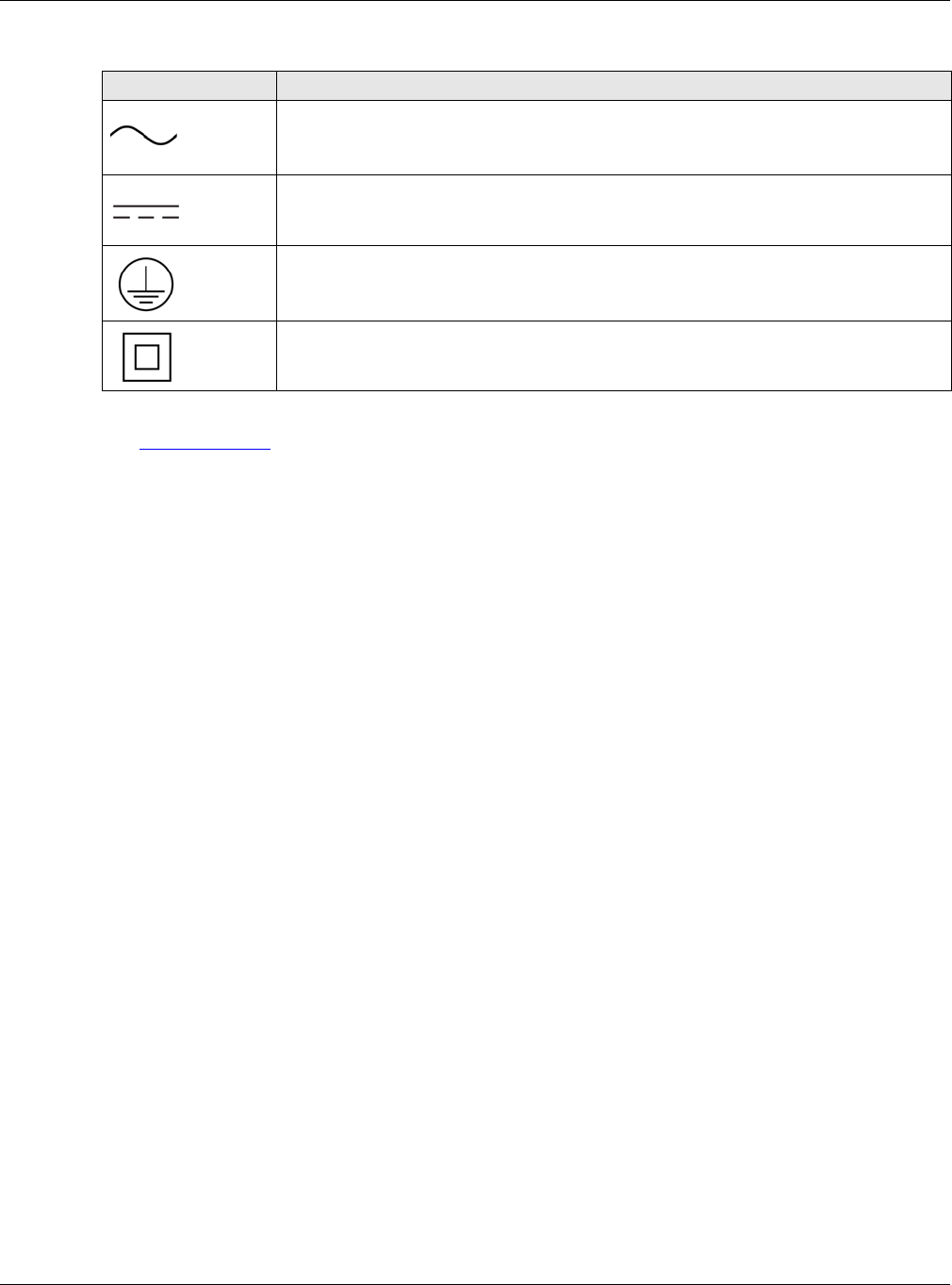
Appendix D Legal Information
EMG6765-Q10A User’s Guide
232
Explanation of the Symbols
Viewing Certifications
Go to http://www.zyxel.com to view this product’s documentation and certifications.
Zyxel Limited Warranty
Zyxel warrants to the original end user (purchaser) that this product is free from any defects in material or workmanship for a specific period (the
Warranty Period) from the date of purchase. The Warranty Period varies by region. Check with your vendor and/or the authorized Zyxel local
distributor for details about the Warranty Period of this product. During the warranty period, and upon proof of purchase, should the product
have indications of failure due to faulty workmanship and/or materials, Zyxel will, at its discretion, repair or replace the defective products or
components without charge for either parts or labor, and to whatever extent it shall deem necessary to restore the product or components to
proper operating condition. Any replacement will consist of a new or re-manufactured functionally equivalent product of equal or higher value,
and will be solely at the discretion of Zyxel. This warranty shall not apply if the product has been modified, misused, tampered with, damaged by
an act of God, or subjected to abnormal working conditions.
Note
Repair or replacement, as provided under this warranty, is the exclusive remedy of the purchaser. This warranty is in lieu of all other warranties,
express or implied, including any implied warranty of merchantability or fitness for a particular use or purpose. Zyxel shall in no event be held
liable for indirect or consequential damages of any kind to the purchaser.
To obtain the services of this warranty, contact your vendor. You may also refer to the warranty policy for the region in which you bought the
device at http://www.zyxel.com/web/support_warranty_info.php.
Registration
Register your product online to receive e-mail notices of firmware upgrades and information at www.zyxel.com for global products, or at
www.us.zyxel.com for North American products.
Open Source Licenses
This product contains in part some free software distributed under GPL license terms and/or GPL like licenses. Open source licenses are provided
with the firmware package. You can download the latest firmware at www.zyxel.com. To obtain the source code covered under those Licenses,
please contact support@zyxel.com.tw to get it.
SYMBOL EXPLANATION
Alternating current (AC):
AC is an electric current in which the flow of electric charge periodically reverses direction.
Direct current (DC):
DC if the unidirectional flow or movement of electric charge carriers.
Earth; ground:
A wiring terminal intended for connection of a Protective Earthing Conductor.
Class II equipment:
The method of protection against electric shock in the case of class II equipment is either double insulation or
reinforced insulation.

Index
EMG6765-Q10A User’s Guide
216
Index
A
ActiveX 132
Address Assignment 61
AP 12
AP Mode
menu 33
status screen 31
AP+Bridge 12
B
Bridge/Repeater 12
C
certifications 212
viewing 215
Channel 24, 32
channel 73
CIFS 163
Common Internet File System, see CIFS
Configuration
restore 179
contact information 203
content filtering
by keyword (in URL) 137
Cookies 132
copyright 209
CoS 151
CoS technologies 143
CPU usage 25, 32
customer support 203
D
DDNS 119
see also Dynamic DNS
service providers 119, 134
DHCP 56, 104
DHCP server
see also Dynamic Host Configuration Protocol
DHCP server 95, 104
Differentiated Services, see DiffServ 151
DiffServ 151
marking rule 151
Digital Living Network Alliance 162
disclaimer 209
DLNA 161, 162
indexing 164
overview 161
rescan 164
DLNA-compliant client 162
DNS 106
DNS Server 61
DNS server 106
Domain Name System 106
Domain Name System. See DNS.
DS field 151
DS, dee differentiated services
DSCP 151
duplex setting 25, 33
Dynamic DNS 119
Dynamic Host Configuration Protocol 104
DynDNS 119, 134
DynDNS see also DDNS 119, 134
E
ESSID 188

Index
EMG6765-Q10A User’s Guide
217
F
file sharing 162
access right 165, 167
bandwidth 167
example 167
FTP 166
overview 162
Samba 164
user account 166, 167
Windows Explorer 164
work group 164
Firewall 128
Firewall overview
guidelines 128
ICMP packets 129
network security
Stateful inspection 128
firewall
stateful inspection 127
Firmware upload 177
file extension
using HTTP
firmware version 24, 32
G
General wireless LAN screen 76
Guest WLAN 74
Guest WLAN Bandwidth 75
I
IGMP 62
see also Internet Group Multicast Protocol
version
IGMP version 62
Internet Group Multicast Protocol 62
IP Address 96, 97, 112
IP alias 95
IP Pool 105
J
Java 132
L
LAN 94
IP pool setup 95
LAN overview 94
LAN setup 94
LAN TCP/IP 95
Language 180
Link type 25, 33
local (user) database 74
Local Area Network 94
M
MAC 84
MAC address 61, 74
cloning 61
MAC address filter 74
MAC address filtering 84
MAC filter 84
managing the device
good habits 14
using the web configurator. See web configurator.
using the WPS. See WPS.
MBSSID 12
Media access control 84
media client 161
media file 161, 164
type 164
media server 161
overview 161
meida file play 161
Memory usage 25, 33
MoCA
packet error rate 102
PER mode 102
mode 12
Multicast 62

Index
EMG6765-Q10A User’s Guide
218
IGMP 62
N
NAT 109, 112
global 110
how it works 111
inside 110
local 110
outside 110
overview 109
port forwarding 116
see also Network Address Translation
server 110
server sets 116
NAT Traversal 155
Navigation Panel 25, 33
navigation panel 25, 33
Network Address Translation 109, 112
O
operating mode 12
P
Packet Error Rate 102
PER mode
NPER 102
VLPER 102
Per-Hop Behavior, see PHB 151
PHB 151
Point-to-Point Protocol over Ethernet 63
Pool Size 105
Port forwarding 112, 116
default server 112, 116
example 116
local server 112
port numbers
services
port speed 25, 33
PPPoE 63
dial-up connection
Q
QoS 142, 151
marking 143
setup 142
tagging 143
versus CoS 142
Quality of Service (QoS) 87
Quality of Service, see QoS
R
RADIUS server 74
Reset button 14
Reset the device 14
Restore configuration 179
Roaming 86
Router Mode
status screen 22
RTS/CTS Threshold 73, 86
S
Samba 163
Scheduling 89
Server Message Block, see SMB
Service and port numbers 131
Service Set 76, 83
Service Set IDentification 76, 83
Service Set IDentity. See SSID.
Single Rate Three Color Marker, see srTCM
SMB 163
srTCM 153
SSID 24, 32, 73, 76, 83
stateful inspection firewall 127
Static DHCP 105
Static Route 121
Status 22
Subnet Mask 96, 97

Index
EMG6765-Q10A User’s Guide
219
Summary
DHCP table 56
Packet statistics 56
Wireless station status 57
System General Setup 173
System restart 180
T
TCP/IP configuration 104
Time setting 175
trigger port 117
Trigger port forwarding 117
example 117
process 117
trTCM 154
Two Rate Three Color Marker, see trTCM
U
Universal Plug and Play 155
Application 155
Security issues 155
UPnP 155
USB media sharing 161
user authentication 74
local (user) database 74
RADIUS server 74
User Name 120
W
WAN (Wide Area Network) 60
WAN MAC address 61
warranty 215
note 215
Web Configurator
how to access 18
Overview 18
web configurator 13
Web Proxy 133
WEP Encryption 79
windows media player 161
Wireless association list 57
wireless channel 188
wireless LAN 188
wireless LAN scheduling 89
Wireless network
basic guidelines 73
channel 73
example 72
MAC address filter 74
overview 72
security 73
SSID 73
Wireless security 73
overview 73
type 73
wireless security 188
Wireless tutorial 38, 48
WLAN button 14
work group 163
name 163
Windows 163
WPS 13